

25 Best Things To Do In Montmartre Paris [Guide to Montmartre]
Planning to visit Montmartre and looking for what to do? This guide will give you the best things to do in Montmartre Paris plus practical tips to guide you!
Montmartre is one of my favorite neighborhoods in Paris and I’ve visited it more times than any other neighborhood in the city! Its artistic vibe, romantic feel, and cafe culture bring out the authentic nature of Paris.
Perfectly situated on a hill in the 18th arrondissement on the right bank of the Seine, Montmartre is one of the highest points in Paris offering stunning views of the city.
I’ve spent many evenings here watching the sunset over Paris and many leisurely afternoon strolls, and it never gets old.
Its pretty cobblestone tiny streets and small cafes make it feel like you’re walking in a romantic village yearning to be explored.
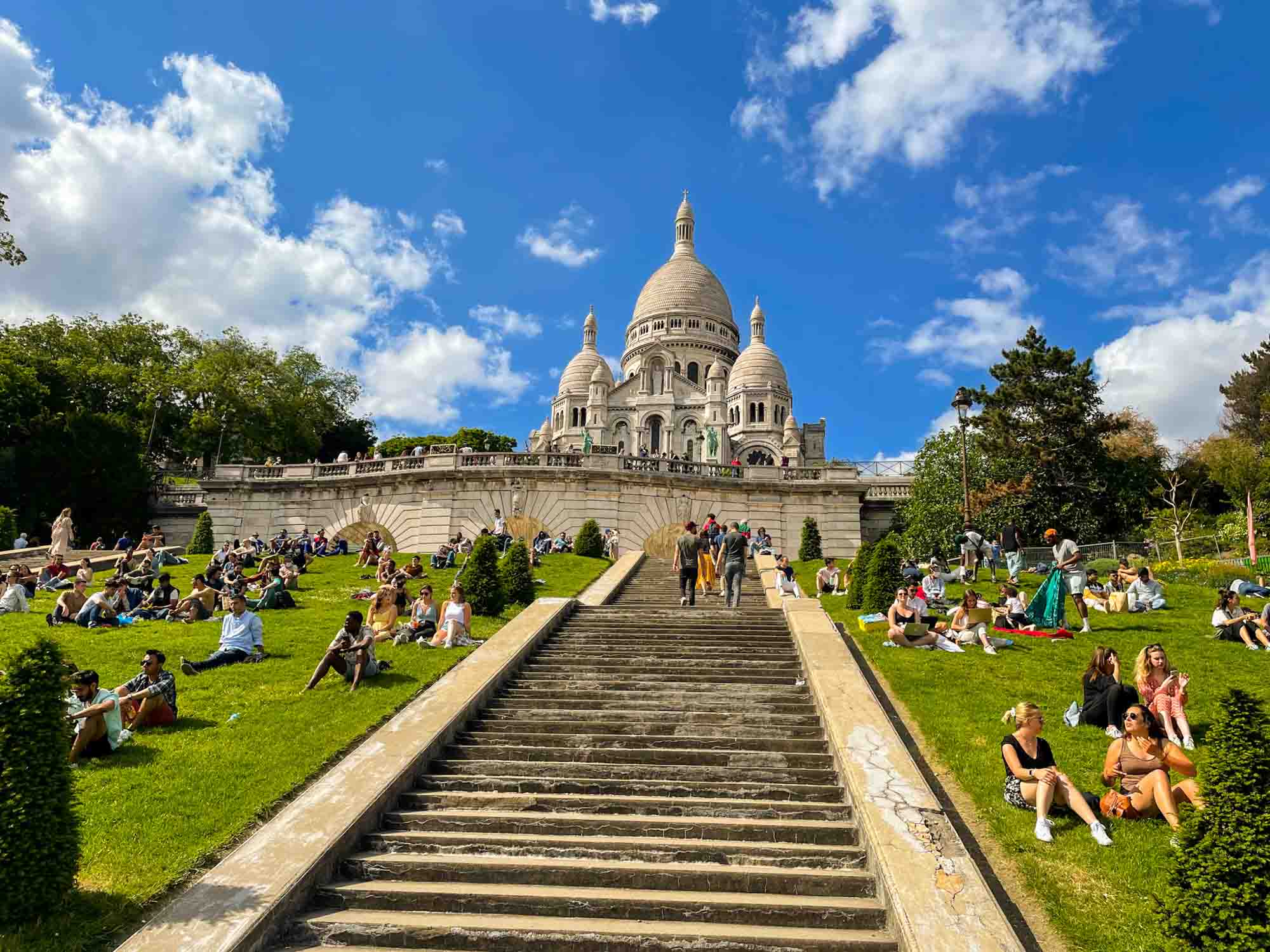
Whether you want to walk in the footsteps of famous French painters like Camille Pissarro , Auguste Renoir , and Toulouse-Lautrec or those who fell in love with it and called it home like Pablo Picasso , or Vincent van Gogh , admire the famous basilica, or get a glimpse of the only remaining vineyard in Paris, there are so many things to do in Montmartre that it would take you even more than a day to get the bearings of this lovely neighborhood.
To help you discover all the famous and hidden jewels of this lovely area, I will be sharing with you all the best places to visit in Montmartre, where to stay, and tours to take to fully enjoy your time. Basically, a complete guide to Montmartre to make sure you don’t miss anything.
And at the end of the article, I will add a map of all the best places to see in Montmartre to make sure that you don’t miss any.
But before we look at what to do in Montmartre, there are some practical guides you’ll find helpful but if you already know them, you can scroll to the next section.
Practical Tips for Visiting Montmartre

Where is Montmartre in Paris
Montmartre is located in the 18th arrondissement of Paris. It is situated in the northern part of the city and on the right side of the Seine or the right bank as commonly known.
Best Time to Visit Montmartre
The best time to visit Montmartre is any day other than the weekend; well unless you’re just visiting Paris for a weekend , then you’ll have no choice.
The streets of Montmartre are usually crowded on the weekends which can be a bit too much in my opinion. Also, if you can, visit in the morning hours as many people tend to flock here from the afternoons till the evening hours.
If you can visit in the morning hours, then you’ll be able to enjoy the streets a bit more without the crowds. Of course, this also depends on the season. Summer and Spring will always have more crowds than winter or even fall .
How to Get to Montmartre

Getting to Montmartre is pretty easy regardless of where you are in Paris. The easiest way is by taking the Metro .
You can either take line M12 or M2 but where you stop exactly depends on where you want to start your visit.
On M12, you can either stop at the “main” Montmartre metro station at Abbesses station or at Lamarck Caulaincourt station on the opposite side. If you’re visiting Montmartre for the first time, I recommend stopping at Abbesses station .
If you take M2, you can either stop at Blanche station which will put you next to Moulin Rouge, Place de Clichy , or Anvers Station . Regardless of the metro stop you take, you’ll be just a few minutes’ walk from the popular attractions of Montmartre.
Please note that the station you start your journey at may not have M12 or M2 but don’t worry about this as you can just switch lines until you land on either of them. The city mapper app will come in handy in guiding your route.
How to Get Around Montmartre
The best way to enjoy all the famous and hidden gems in Montmartre Paris is by walking.
However, for people who don’t want to walk for long or have reduced mobility, you can book the small tourist train of Montmartre to get you around. I will give more details about this tourist train later in the article.
Best Tours to Take in Montmartre
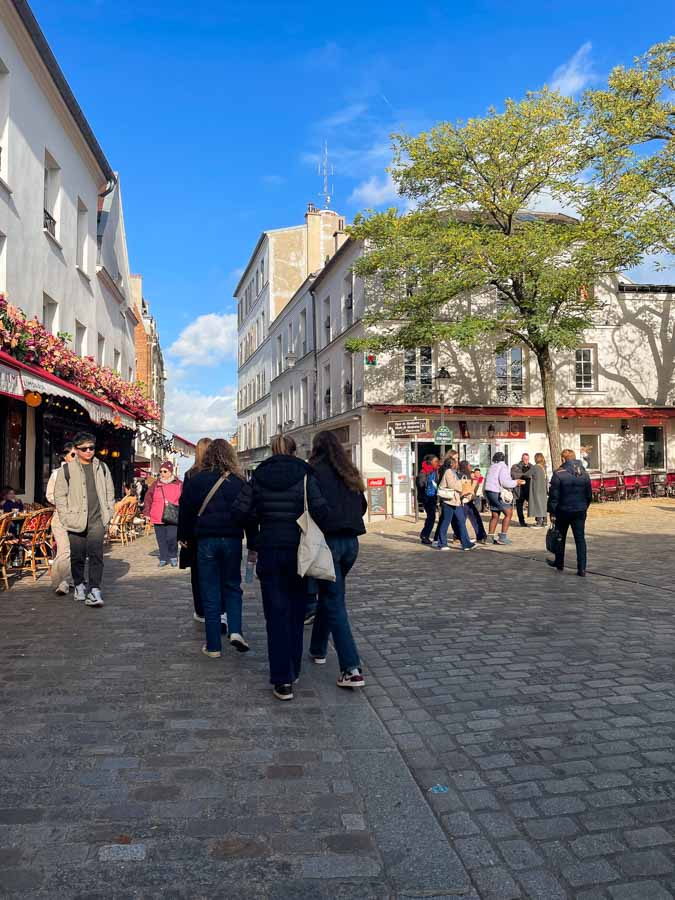
For people who don’t want to stress with planning, figuring out what to visit next, or those who want a deeper insight into the neighborhood, signing up for guided tours is the best way to see Montmartre. Below are some of the guided tours in Montmartre I highly recommend.
Montmartre Guided Walking Tour
This is probably the best tour if you want to see the major attractions of Montmartre. Starting at Moulin Rouge and going through the cute streets while taking you back in time with historical facts and history, this 2- 3 hours guided tour is the perfect tour if you don’t have a lot of time but want to see the highlights.
Cheese, Wine, and Pastry Montmartre Tour
If you’ve already visited the popular attractions and want to discover Montmartre through food, this guided tour is the perfect choice for you. This 3-hour foodie walking tour will take you on a journey to discover French pastries and taste various cheeses and wines while uncovering the history of Montmartre.
Where to Stay in Montmartre
If you’re still planning to visit Paris and have zeroed down on staying in Montmartre on your trip, here are some of the best hotels in Montmartre to consider.

Courtesy of Hotel 29 Lepic / Booking.com
Budget Hotel
Located on the famous street of Rue Lepic as given away by its name, Hotel 29 Lepic is a gold mine when it comes to budget accommodation in Montmartre. The rooms are designed in a simple yet modern way and it is just a few meters away from Moulin Rouge and Sacre Coeur. This hotel has all the basic amenities in the room, a minibar and if you’re lucky, you might get a room with a balcony to enjoy the views of Montmartre.
Mid-range Hotel
With a mid-range budget, you can’t go wrong at Hôtel des Arts Montmartre . This boutique hotel is not only classy but also decorated in bold colors to create a charming environment. Some rooms offer views of Montmartre and Paris roofs and it is less than 10 minutes away from Sacre Coeur on foot. Besides the amenities including a gym, this hotel serves a buffet breakfast every morning to start your day right.

Courtesy of Hôtel des Arts, Montmartre / Booking.com
Luxury Hotel
If luxury is the language you speak, then Maison Souquet understands your language. Housed in a Parisian townhouse, this luxury hotel features an indoor swimming pool, and a spa with a hammam, and is decorated in a unique way that screams luxury. The general ambiance of this place is cozy and romantic just like the Montmartre neighborhood it’s set in.
Apartment Rental
If you want to have that homey feel even when in Paris, then Odalys City Paris Montmartre is the perfect home away from home stay. This large studio apartment features a kitchenette if you want to make some quick meals, a dining area, and all the amenities you’ll need for a comfortable stay including an onsite spa and sauna. It’s set on a quiet street but also very close to all the action in Montmartre.
Where to Eat in Montmartre

Montmartre has a number of cafes and restaurants and it can be hard to choose one. To make your choice easier, here are some of the places to eat in Montmartre plus where to find them.
- Le Consulat: Great for lunch, dinner, or even a quick snack. Address: 18 Rue Norvins, 75018 Paris .
- Le Cabanon de la Butte: Serves French foods with a view. Address: 6 Rue Lamarck, 75018 Paris .
- La Boîte aux Lettres: Creative French meals. Address: 108 Rue Lepic, 75018 Paris .
- The Hardware Société: Great for breakfast. Address: 10 Rue Lamarck, 75018 Paris.
- Le Coq & Fils: For all your poulet (chicken) cravings. Address: 98 Rue Lepic, 75018 Paris .
- La Bossue: Great to pick up some delicious French pastries . Address: 9 Rue Joseph de Maistre, 75018 Paris.
Now that we’ve covered all the practical tips, here are the best things to do if you’re going on a Montmartre self-guided walking tour.
Best Things to Do in Montmartre Paris
Whether you’re spending a day in Montmartre or just an afternoon, here are the charming Montmartre attractions not to miss.
1. Visit Sacre Coeur

Sacre Coeur is probably the most famous attraction in Montmartre. Standing atop a hill clad in white with domes soaring through the skies, Sacre Coeur is one of the most beautiful churches in Paris .
While the exterior architecture is imposing, the interior is equally impressive. A step inside will treat you to the biggest Mosaic in France and a glimpse of one of the heaviest and largest bells in the world.
You can visit its crypt, admire its architectural details including the statues at the front, or wander around its well-maintained gardens, but the highlight of any visit is to climb up to its dome to get some of the most stunning views of Paris .
Please note that entrance is free but you’ll need to pay a few Euros to climb the dome.
You can also book this guided tour of Sacre Coeur if you prefer to go with a knowledgeable and friendly guide to learn more history about this landmark.
But before you go, be sure to check out these interesting facts about Sacre Coeur .
2. Snap a photo of the sinking house
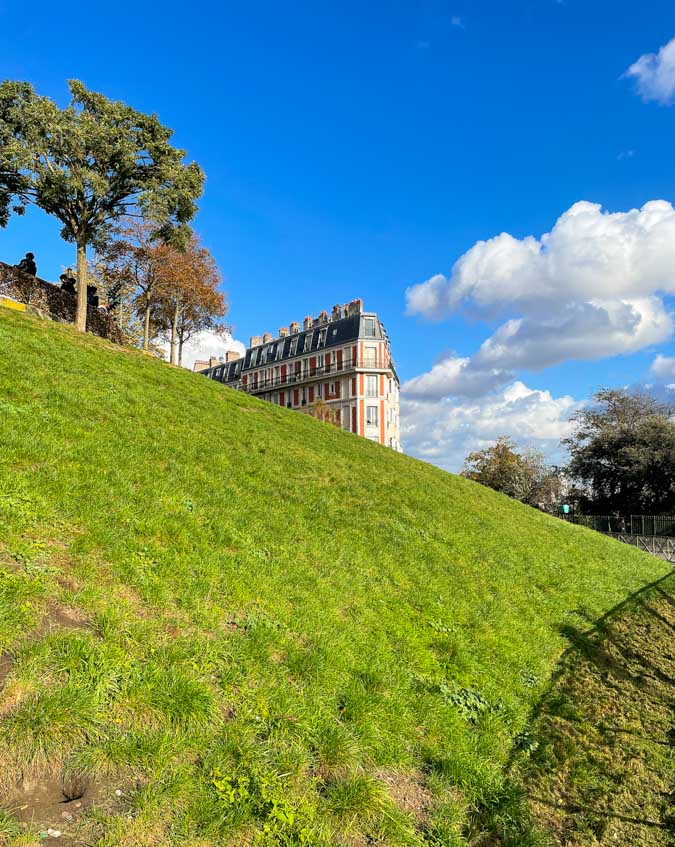
Just right next to Sacre Coeur is the sinking house or the greatest illusion in Montmartre village.
When you look at the colorful building, it gives an illusion that it’s sinking, hence the nickname but in reality, it is just a camera trick.
While some people write it off, I believe it’s one of the cool things to do near Sacre Coeur.
3. Admire The Beauty Of Square Louise-Michel
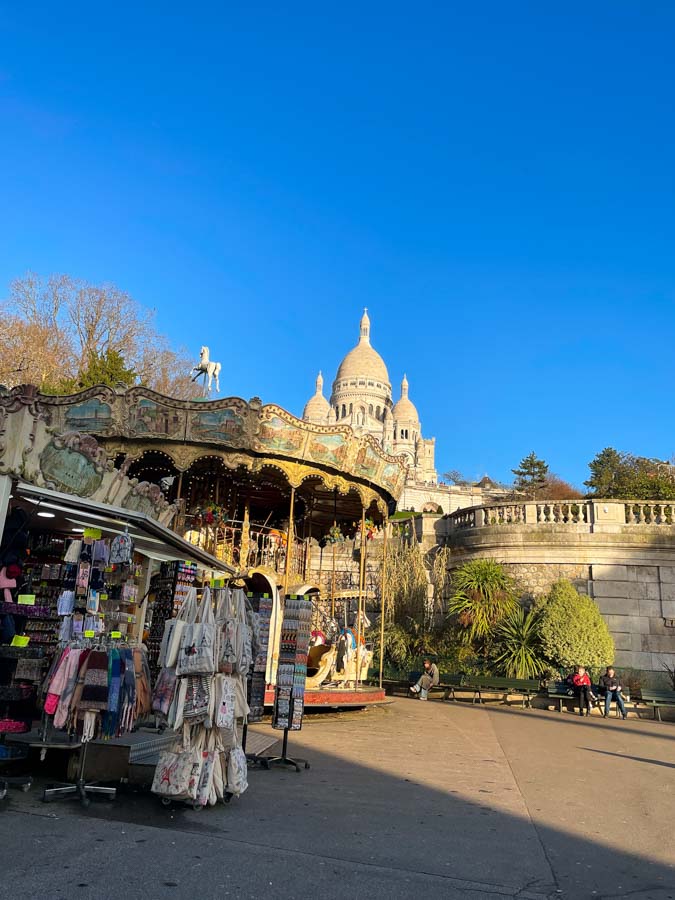
One of the cutest squares in Montmartre is Square Louise-Michel. It is the square located beneath the Sacre Coeur.
It has a carousel, beautifully paved pathways, and benches to sit on. You’ll find lots of people picnicking here, particularly in the summer months. But the highlight is to enjoy a nice view of the Sacre Coeur.
4. Get A Rare View Of The Sacre Coeur From Square Marcel Bleustein Blanchet

Right before leaving the Sacre Coeur area, there is another place you should see known as, Square marcel bleustein blanchet !
It is just behind the basilica, and while most people stick to the front, I recommend going behind to see this little square.
It offers a quiet pace and a unique view of the Sacre Couer.
5. Say I love you at The “wall of Love” (Le Mur des Je t’aime)

There is no doubt that one of the Paris nicknames is the “city of love” and the “ wall of love ” truly brings it out.
Located in Jehan Rictus Garden Square, this 40 square metres (430 sq ft) wall depicts 311 “I love yous” written in 250 languages from all across the world.
You’ll be able to recognize common languages like English and French but there are also “smaller” languages you’ve probably never even heard of before.
6. Peep at the only remaining vineyard in Paris

Being a city known for wines, Paris once had a number of vineyards but as the city grew and became urbanized, most vineyards didn’t survive, but there is one that did.
And luckily for us, we can still get a glimpse of it. Known as Clos Montmartre , this vineyard is still functioning and it produces over 1000 bottles of wine every year.
And if you visit Paris in the fall , specifically in October, you can attend the fun annual harvest party organized at this vineyard.
7. Take Some Pictures at La Maison Rose

Also known as the Pink House, La Maison Rose has become a sensation among Instagrammers!
This pretty house on Rue de l’Abreuvoir is famous for having been frequented by artists like Pablo Picasso, and Suzanne Valadon, and French writers like Albert Camus, who used to come here to share ideas and drink coffee.
Hundreds of years later, it’s still famous, though not as an artist’s hub but as one of the best Instagrammable places in Paris . It’s also a working restaurant, so you can go there to grab lunch, dinner, or even brunch.
8. Stop at Place Dalida

While still on Rue de l’Abreuvoir, make a stop at Place Dalida at the end of the street. This place is famous because of the life-size sculpture of Dalida, commonly known as Buste de Dalida or Bust of Dalida.
If you don’t who she is, Dalida was (and still is) one of the most celebrated and famous French singers .
Though she lived a successful and glamorous life as a musician, she suffered a number of misfortunes in her personal life and suffered depression until she took her own life.
As a way of paying tribute to her, Paris City decided to name this area Place Dalida, and installed this sculpture. Today, so many people come here to pay homage to her.
9. Visit Square Suzanne Buisson
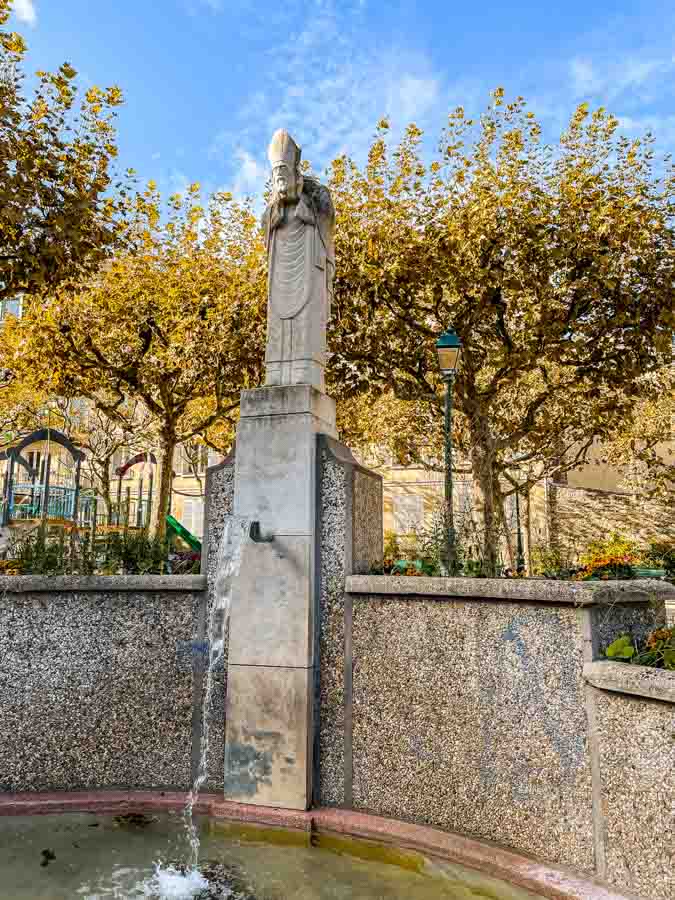
Just a few minutes walk from Place Dalida, you’ll find Square Suzanne Buisson .
Although lovely, the square is quite small, and the only reason you’re coming here is to see the statue of Saint-Denis who was the first bishop of Paris.
It looks a little bit unusual, so to fully understand why it looks the way it does, you’ll need to know a little bit of history or legend for that matter.
Back in the 250s, St. Denis was sent to the region of Gaul, and since he converted many people to Christianity, the Romans were not happy about it.
So they decided to murder him as part of the Roman campaign to persecute Christians.
But with the guidance of the angels, St. Denis didn’t die instantly when he was beheaded.
He instead carried his head in his hands to the place he wanted to be buried – which is the current Basilica of Saint-Denis in the northern suburb of Paris. Hence the shape of this statue.
There is also a fountain that is believed to be miraculous.
10. Shake hands with the man Walking Through a wall

Continuing with the theme of sculptures, one of the places to stop while exploring Montmartre is Le Passe-muraille along Rue Norvins.
The idea of a man walking through a wall was based on a character named Dutilleul (who realized that he had supernatural powers of walking through walls) from one of the novels of French novelist Marcel Aymé but it was Jean Marais who sculpted this artwork as a way of paying tribute to the novelist.
There is not much to do here other than taking a picture but knowing the history behind it before your visit will make it more interesting.
11. Explore art at the Montmartre museum

Musée de Montmartre , CC BY-SA 3.0 , via Wikimedia Commons
Commonly known as Musée de Montmartre , before it became the Montmartre Museum, it was once home to many famous artists like Pierre-Auguste Renoir, Émile Bernard, Suzanne Valadon, and many others.
In fact, this is where Pierre-Auguste Renoir painted Le Bal du Moulin de la Galette (Dance at Le Moulin de la Galette) and La Balançoire (The Swing) which went on to become some of the most famous French paintings .
The museum houses paintings, writings, and manuscripts that tell a story of Montmartre’s history.
After exploring the museum, step outside to see the beautiful garden known as Renoir’s Garden which offers views of the Montmartre vineyard, or grab a bite at the onsite cafe also known as Cafe Renoir.
With all the various things to see and artistic history in this place, visiting Musée de Montmartre is truly one of the best things to do in Montmartre.
To get access to the permanent and temporary exhibitions of the museum, the gardens, and the cafe, you’ll need to buy this Musée de Montmartre skip-the-line entry ticket .
12. Pay your respects at Montmartre cemetery
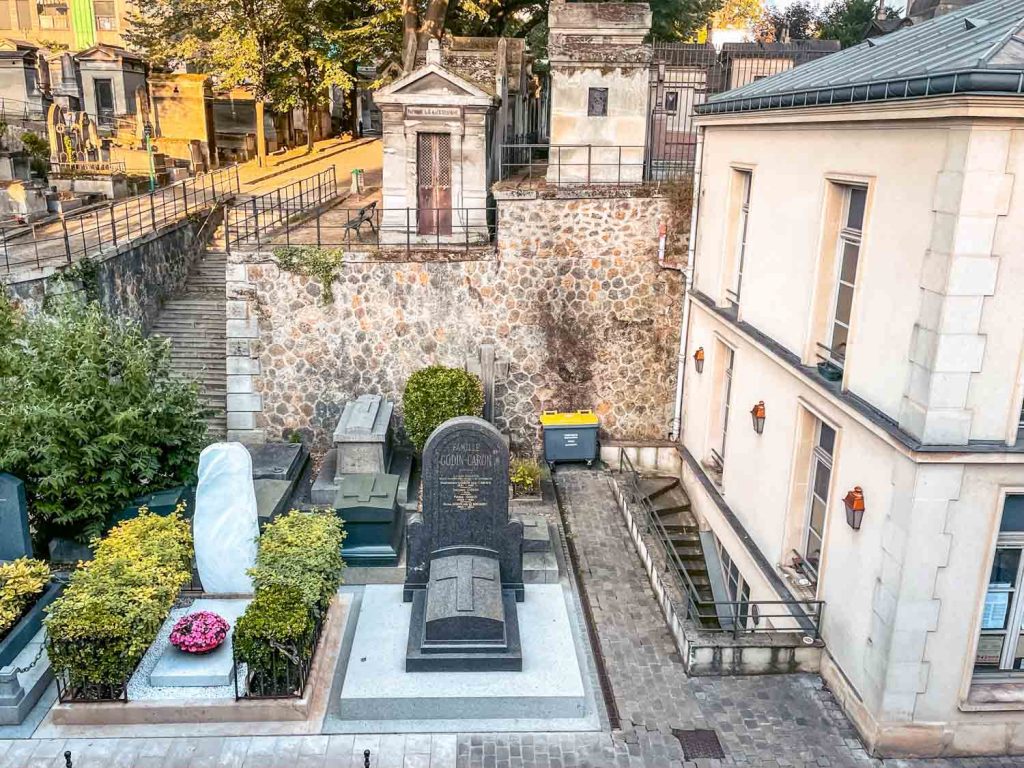
One of the rather unique quotes about Paris is that “Paris is the only city in the world where starving to death is still considered an art”.
Though dying in its own right is not art, cemeteries in Paris showcase art in the form of artistic gravestones and statues, and the Montmartre cemetery is no different.
Considered to be the third-largest cemetery in Paris after Montparnasse Cemetery and Père Lachaise Cemetery, the Montmartre cemetery is one of the unusual places to visit in Paris .
Like other big cemeteries, this one is also a final resting place for some of the famous people who lived in the neighborhood of Montmartre including Dalida , Edgar Degas , Théodore Chassériau , Alexandre Dumas fils , Émile Zola , and many others.
13. Visit Saint Vincent Cemetery

If you still want to visit another cemetery, add Saint Vincent Cemetery to your Montmartre bucket list.
It is however small and a little unknown compared to its counterpart, but worth a visit if you’re looking for hidden gems in Montmartre.
14. Dine at Le Consulat

One of the cafes in Montmartre that has become a household name is Le Consulat . It is actually regarded as one of the cutest cafes in Paris and it’s not hard to see why.
The colorful red and green colors plus its old charm make it Instagram-worthy, the history it harbors makes it intriguing, but the delicious meals it serves will make you want to pull a chair and dine.
Many famous artists like Pablo Picasso, Claude Monet, and Van Gogh often met here to wind down and catch up.
You can either take that perfect Instagram shot or make a reservation to try some of the delicious French foods like Onion soup, escargots, Duck confit, etc.
15. Watch Painters or Get Painted at Place du Tertre

Place du Tertre is one of the most famous places to visit in Montmartre in Paris. For years, this square has been a gathering place for famous artists to sell their paintings, and fast forward to today, it’s still a hub for present-day artists.
You’ll find hundreds of artists painting various sceneries of Paris or portraits of people. You can stay a bit to admire their work, buy a few of the already painted pieces and if you’re up for it, get a portrait of yourself painted.
The square is lively almost all the time with vibrant cafes, restaurants, and bakeries! If you want to fully immerse yourself in the artistic side of the neighborhood, visiting “The Artist’s Square” is one of the best things to do in Montmartre.
16. Search for the Prettiest Streets in the Neighborhood

While there are so many pretty streets in Paris worth discovering, many of them are in the Montmartre neighborhood.
As you plan your Montmartre itinerary, be sure to add pretty streets like Rue Norvins which offers stunning views of Sacre Coeur, Rue De L’Abreuvoir , Rue Lepic , Rue Saint-Vincent , a charming and calm street, Rue Saint-Rustique which is believed to be the oldest road in Montmartre, and so many others.
Since Montmartre is best discovered on foot, you’ll definitely find yourself on one of these streets without even realizing it since they harbor some of the popular Montmartre sights.
17. See the Remaining Windmills in Paris

Before Montmartre became the bustling neighborhood we see today, it used to be covered in fields, and thus the a need for windmills to help grind flour and pressing grapes.
During the 17th century, Montmartre had close to 300 windmills but today, only 2 can be found.
Though collectively known as Moulin de la Galette , there are actually 2 windmills in this spot; Moulin Radet and Moulin de Blute-Fin. Moulin de la Galette can be found on Rue Lepic on top of a fancy French restaurant.
This windmill inspired a lot of paintings including the famous Dance at Le Moulin de la Galette by Renoir.
18. Tour Montmartre on The Little Tourist Train

Guilhem Vellut from Paris, France , CC BY 2.0 , via Wikimedia Commons
Montmartre being a hilly place and full of stairs, it might not be easy for everyone to walk from one end to another, especially for people with reduced mobility.
But, this doesn’t mean that you have to miss out on the charms of Montmartre! Luckily for you, there is a small tourist train (also known as Le Petit Train de Montmartre ) that goes all around the neighborhood making stops at various points of interest.
This train ride also comes with live commentary so that you learn a bit more about the neighborhood and the places you’re visiting. You can find more about this Promotrain ride from the official website .
19. Make a Stop at Lapin Agile

Located next to the Montmartre vineyard, Lapin Agile is a colorful 19th-century building known for cabarets.
While Moulin Rouge, Lido de Paris, Paradis Latin, and Crazy Horse Paris are the most famous cabaret places in Paris, Lapin Agile is one of the lesser-known ones.
It still holds shows with a focus on old French songs and chansons of Paris where the entire audience can also join in.
However, even if you don’t want to watch any shows, I still find the building quite charming with its orange and green colors.
20. Watch a Cabaret at Moulin Rouge
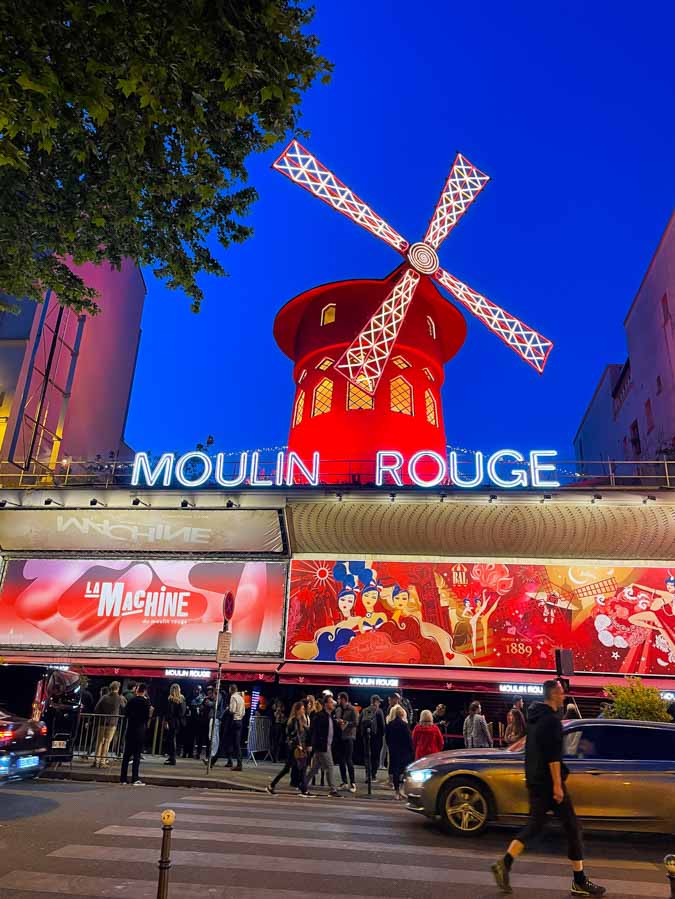
One of the top things to do in Montmartre is to watch a cabaret! You just can’t go to Paris and miss out on an evening of fun.
While there are many cabaret places like I mentioned above Moulin Rouge wins them over by miles.
With talented can-can dancers exceptionally dressed in beautiful costumes, singers, and instrumentalists, a night at Moulin Rouge will be one you’ll never forget.
Since most of the activities we looked at are daytime activities, this is one of the things to do in Montmartre at night.
There are 2 different times for the show, one starting at 9:00 PM and the other one at 11:00 PM with the latter being a bit cheaper.
Since this show is popular among tourists and locals alike, you’d need to book way in advance to be assured of a spot. You can either book this show that comes with dinner or this one with just champagne which is slightly cheaper.
21. Visit the Musée de la Vie Romantique

Though not technically in Montmartre but rather at the foot of the neighborhood in the 9th arrondissement, Musée de la Vie Romantique is one of the free museums in Paris worth visiting.
The museum is set in a lovely house and houses objects from the Romantic era including house objects, paintings, and personal items from George Sand.
Access to the permanent collection is free making it one of the best free things to do around Montmartre.
The premises also have a lovely garden with a little cafe, so you can grab a coffee after your visit.
22. Look for filming locations for Amélie
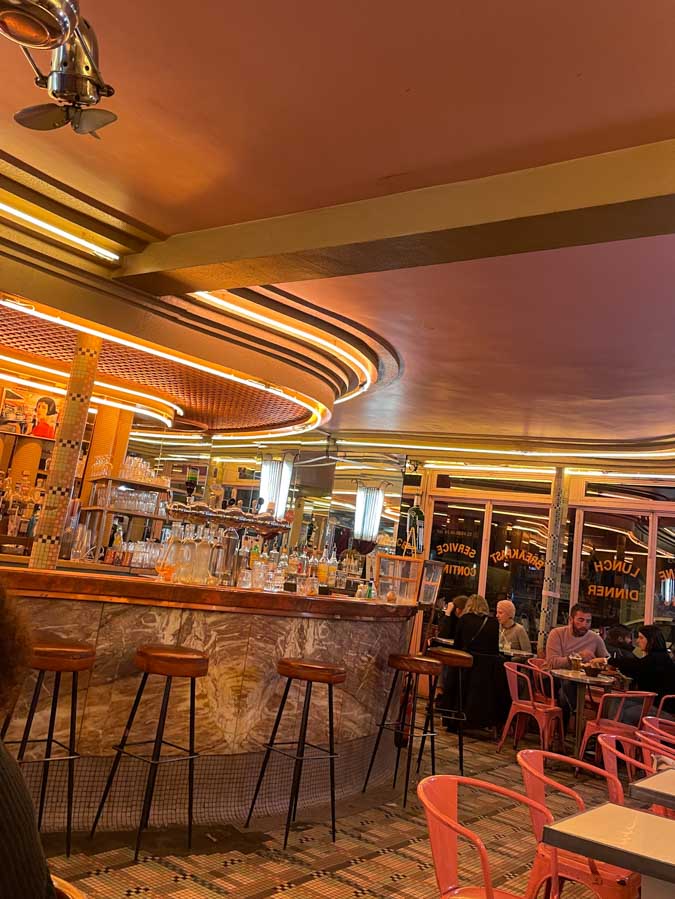
One of the best French films ever made, Amélie stole the hearts of many. This rom-com was filmed in Montmartre and on top of showing how this lovely girl juggles life and falling in love, Paris lovers couldn’t avoid but drool over all the cute places featured in the movie.
If you were one of those, searching for Amélie filming locations is one of the cool things to do in Montmartre.
Café des Deux Moulins which was Amélie’s workplace in the movie is probably the most popular. Since now it’s touristy thanks to the movie, you may want to order a meal or coffee instead of just entering to take photos.
Other places include Funiculaire de Montmartre , Canal Saint-Martin , (though not in Montmartre, walking down the canal or people-watching is one of the fun things to do near Montmartre), Sacré-Coeur and of course, Rue Lepic .
23. Admire Sculptures at Espace Dalí
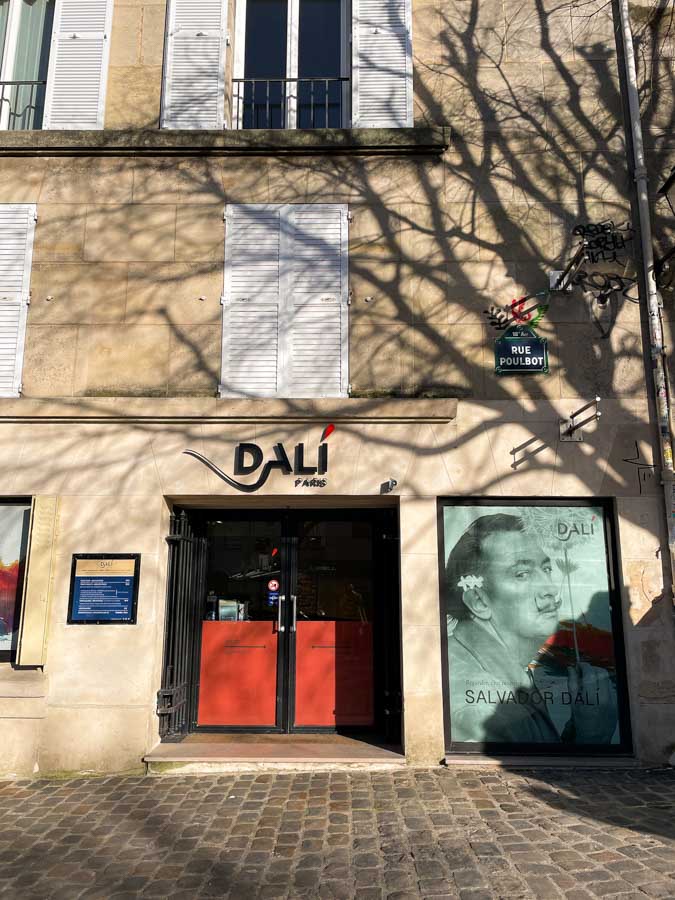
If you’re into sculptures and engravings, Espace Dalí or Dali Paris as sometimes known is one of the unique spots in Montmartre worth checking out.
The museum is dedicated to the works of Salvador Dalí, a famous Spanish surrealist artist. It consists of around 300 original sculptures and engravings by Dalí.
A visit to this place is sure to blow you away as you admire his techniques of sculpting life-size sculptures.
24. Visit Église Saint Pierre de Montmartre

Located right next to Sacre Coeur, Église Saint-Pierre de Montmartre is one of the oldest and still functioning churches in Paris.
Though most people just visit Sacre Coeur and move to other places, this is one of the non-touristy places to visit in Montmartre yet it’s still quite beautiful.
Step inside to admire its nave and detailed columns or take in its beauty on the exterior.
25. Sip on Cocktails with a View at Terrass’ Hotel
View this post on Instagram A post shared by Terrass’’ Hotel (@terrasshotel)
After a long day of exploring Montmartre, there is no better way to unwind than sipping on a cold cocktail with a view of the Eiffel Tower from the rooftop terrace of Terrass’ Hotel .
The rooftop is beautifully decorated for your comfort and is open from Tuesday to Sunday from 3:30 PM – 00:30 AM.
Whether it’s catching up with friends or watching the Eiffel Tower shimmer from a distance, you can be assured of a great evening at this place.
Related Post: Best Rooftop Bars in Paris
More Useful Tips For A Perfect Day in Montmartre

- Wear Comfortable walking shoes: Montmartre is a hilly place as you might know already, so there will be a lot of climbing especially around Sacre Coeur. Healed Boots or any kind of heels will be such a bad idea but your running shoes or sneakers will work well.
- Be aware of pickpockets or any other scams: Montmartre is very touristy, there is no going around that! And with huge crowds come canning people who prefer taking what is not theirs and Montmartre is no different. Keep your items safe at all times and wear your bag in front instead of behind.
- Don’t feel compelled to see everything: While there are so many things to do in Montmartre, sometimes it’s just impossible to see everything, especially if you’re visiting for a few hours. Prioritize and start with the must-sees (FOR YOU), and if you run out of time, it’s still ok. It’s better to actually enjoy the places you’re visiting instead of just rushing through everything with the goal of ticking them off your Paris bucket list .
Map of the Best Places to Visit in Montmartre
To make sure you locate all these places with ease, here is a map of all the things to do in Montmartre that I’ve talked about above.
How to Use this Map: Just click on the Camera icon on the map above and the location will be displayed on the left side of the screen. You can choose to either “view on google maps” and save the location for later or click on the itinerary arrow to get directions on how to get there.
Final Thoughts on the Best Things to Do in Montmartre
There is no neighborhood in Paris that is as charming as Montmartre! With hundreds of years worth of art history, every turn in Montmartre is as impressive as the previous one.
Whether you choose to follow in the footsteps of the fallen artists, immerse yourself in the cafe culture, or just wander its pretty streets, the list of things to do in Montmartre is endless but I hope that you find this article useful as you plan to visit Montmartre.
But if you’ve already been to this beautiful village, share with me in the comments how you found it and what you liked (or not liked) about it.
Check out these posts to help you plan your trip to Paris
- Fun things to do in Paris on a Rainy day
- Famous Paintings in Paris
- Where to Find the Best Macarons in Paris
- Famous Paintings at the Louvre Museum
- Best Covered Passages of Paris
- Most beautiful neighborhoods of Paris
- Fun free things to do in Paris
- Famous Churches to Visit in Paris
- Best Museums in Paris
- Tips for Visiting the Eiffel Tower
- How to spend One day In Paris
Was this post on the best things to see in Montmartre helpful? Then please consider sharing it with others.
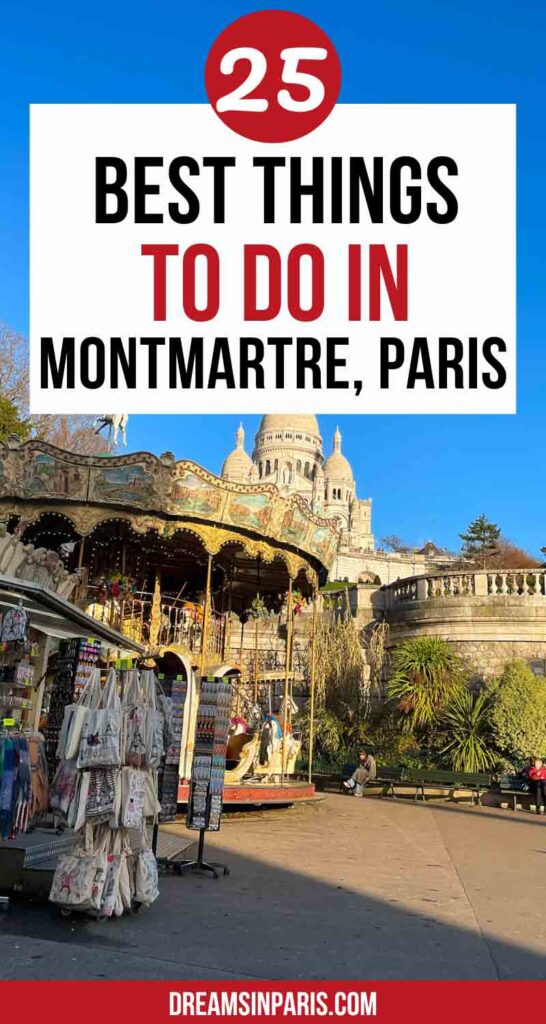
Sharing is caring!
Esther is the face and voice behind Dreams in Paris! She has always been obsessed with Paris even before she moved there. She has lived in Paris for a couple of years, and that obsession has not changed! That love for Paris, plus her passion for writing led to the birth of Dreams in Paris! She now shares all the practical tips and guides she’s picked along the way to help you plan a memorable trip to the city of love! You can learn more about her here !
Similar Posts

18 Most Famous Landmarks in Paris You Must Visit
Planning to travel to the French capital and you’re looking for the most famous landmarks in Paris to visit? From iconic structures to historical buildings, you’ll find them all here! The city of love has so many things to offer….

9 Best Things To Do in Paris in April in 2024+ The Weather, Where to Stay, & What to Pack
Planning to travel to Paris in April? This guide will show you all the unique things to do, the weather, what to pack, plus where to stay for an amazing trip! April is one of the best months to visit…

25 Most Famous Paintings In Orsay Museum You Have To See
Visiting Musée d’Orsay and wondering which artworks you shouldn’t miss? This article will show you the most famous paintings in Orsay Museum to see! Musée d’Orsay or Orsay Museum is one of the best museums in Paris! Originally a railway station that…

Paris Photo Spots: 30 Most Instagrammable Places in Paris You’ll Love
Want to take some stunning photos while in the city of love? This post will show you all the most Instagrammable places in Paris! Paris is truly one of the most beautiful cities in Europe! Every corner you turn, there…

Weekend in Paris: The Perfect 2-Day Paris Weekend Itinerary In 2024
Are you planning to spend a weekend in Paris but not sure what to do? This Paris weekend itinerary will guide you on the best places and things to do in Paris in 2 days. There is no doubt that…

18 Best Free Things To Do In Paris, France
Traveling to the French capital and want to keep your expenses at bay? Here are the most fun free things to do in Paris you’ll love. Paris is one of the most expensive cities in the world! From world-class museums and…
Leave a Reply Cancel reply
Your email address will not be published. Required fields are marked *
Save my name, email, and website in this browser for the next time I comment.
This site uses Akismet to reduce spam. Learn how your comment data is processed .
Montmartre Tours & Experiences
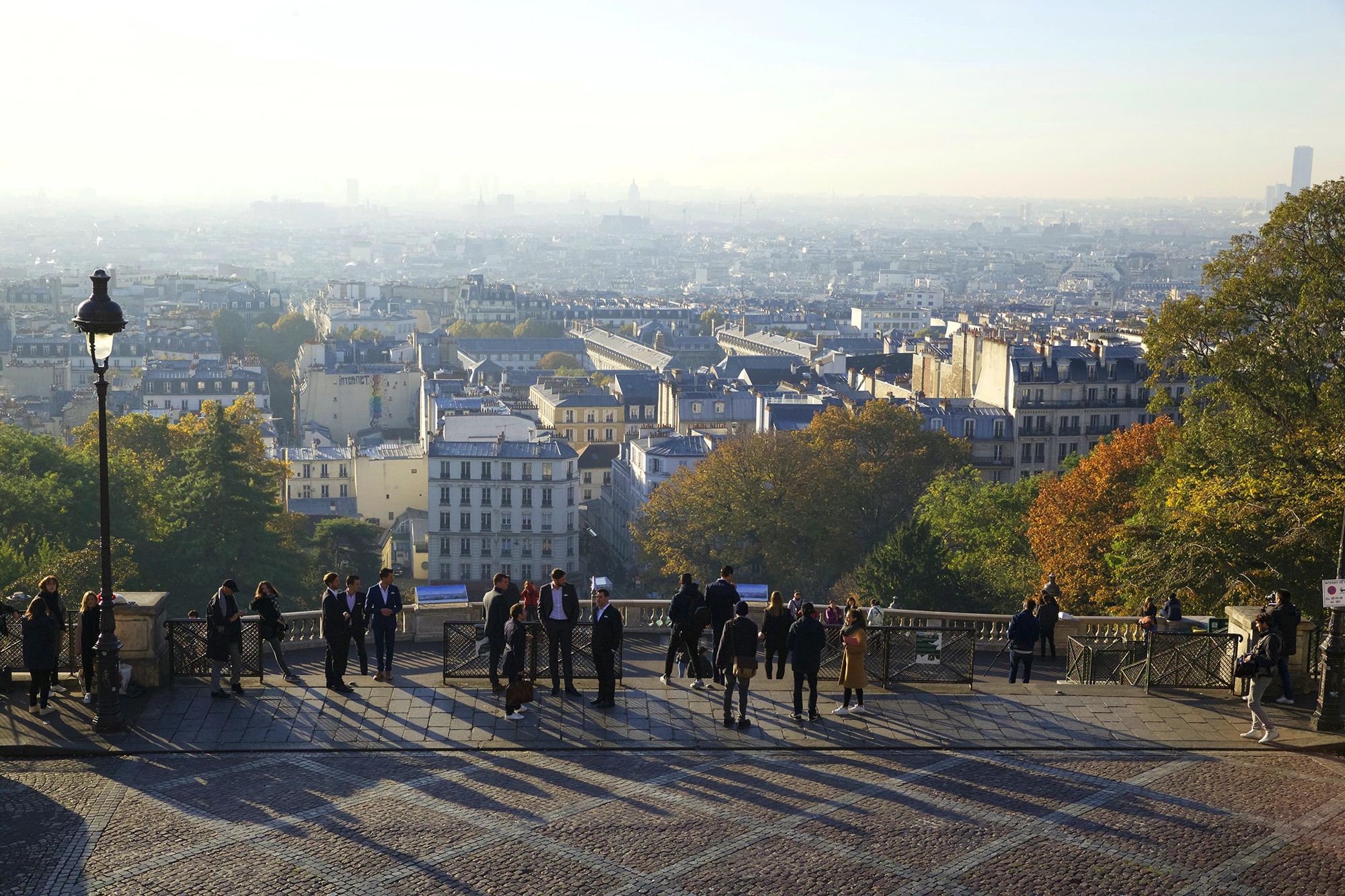
- We’re Hiring Guides - Join Us!
- Press / Media
- Terms & Conditions
- Terms Of Use
- Cancellation Policy
- Health & Safety
- Privacy Policy
- Cookie Settings
- Affiliate Program
- Travel Agents
- City Experiences
- Devour Tours
Montmartre Walking Tour
Approximately 2 hours
From €25
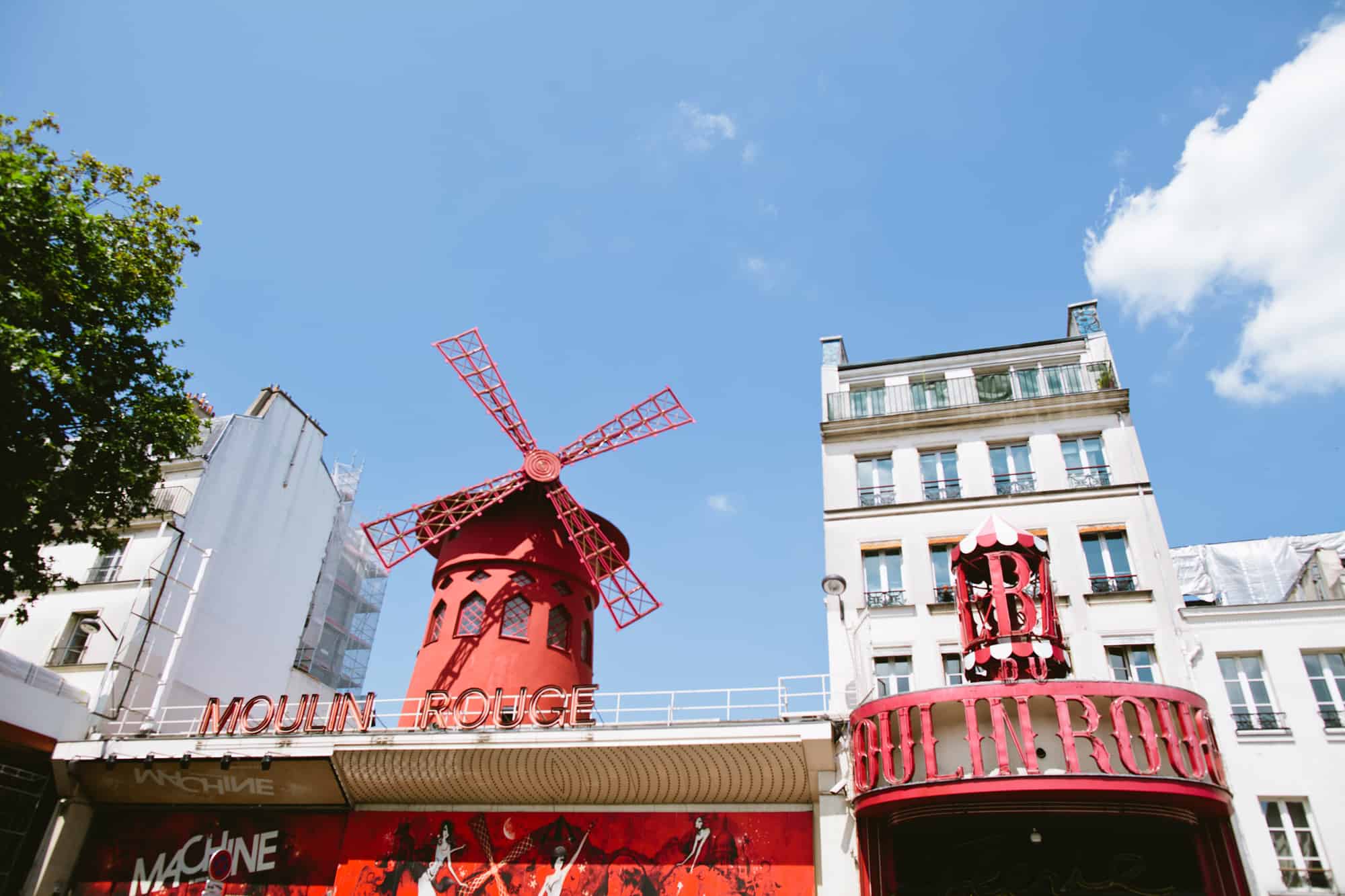
Breathtaking Montmartre Paris Walking Tour
Join us for this popular walking tour as we stroll through the quintessential Parisian quarter of Montmartre. Together with an expert guide, you will discover all that this charismatic village has to offer and learn about the history that made this elevated arrondissement what it is today. Reaching 130m above the city, you and your guide will wander through the cobblestone pathways enjoying secret viewpoints of the city along the way.
Slowly ascending from the bohemian streets you will reach the most breathtaking view at Sacré-Coeur stretching out all over Paris. Traditionally an artist community, Montmartre hasn’t lost its charm since Van Gogh, Picasso, & Renoir sat in its elegant streets for inspiration toward their greatest works. Still bustling with talented artists you will witness the famous Place du Tertre square and see artisans creating pieces right in front of your eyes.
Our Montmartre walking tour will highlight fantastic street art speckled throughout Montmartre including the popular Invader and Miss. Tic that should not be missed.
Continuing on to see the famed Moulin Rouge you will be picturing yourself in the Belle Époque where boisterous soirées, can-can dancers and lively cabarets were the norm. This unique 18th district tour will also reach Paris’ only vineyard and the cemetery of Montmartre where Dalida and Emile Zola are only a few of the famous personalities buried at this historical site.
Transferring you back in time to the home of both Van Gogh and the artistic hostel where Picasso lived is always a customers highlight . Where the rent was cheap and the artistic inspiration was following, you will take a glimpse into the lives of the artists that once called this quarter home.
With so much to do, see, and learn, a walking tour of Montmartre is the perfect way to ensure you experience all that this mini-village has to offer during your visit to Paris.
Tour Details
What’s included, good to know.
- While we maintain a leisurely pace, please note that the Montmartre neighborhood is on a hill and a portion of the tour is uphill.
- The route does take some inclined cobbled streets, so please come prepared with comfortable shoes.
- If you would like to enter Sacré-Cœur Basilica after your tour, please note that it is an active place of worship and requires guest’s shoulders to be covered inside the cathedral. We suggest wearing appropriate clothing or bringing along a scarf or cardigan to wear during your visit.
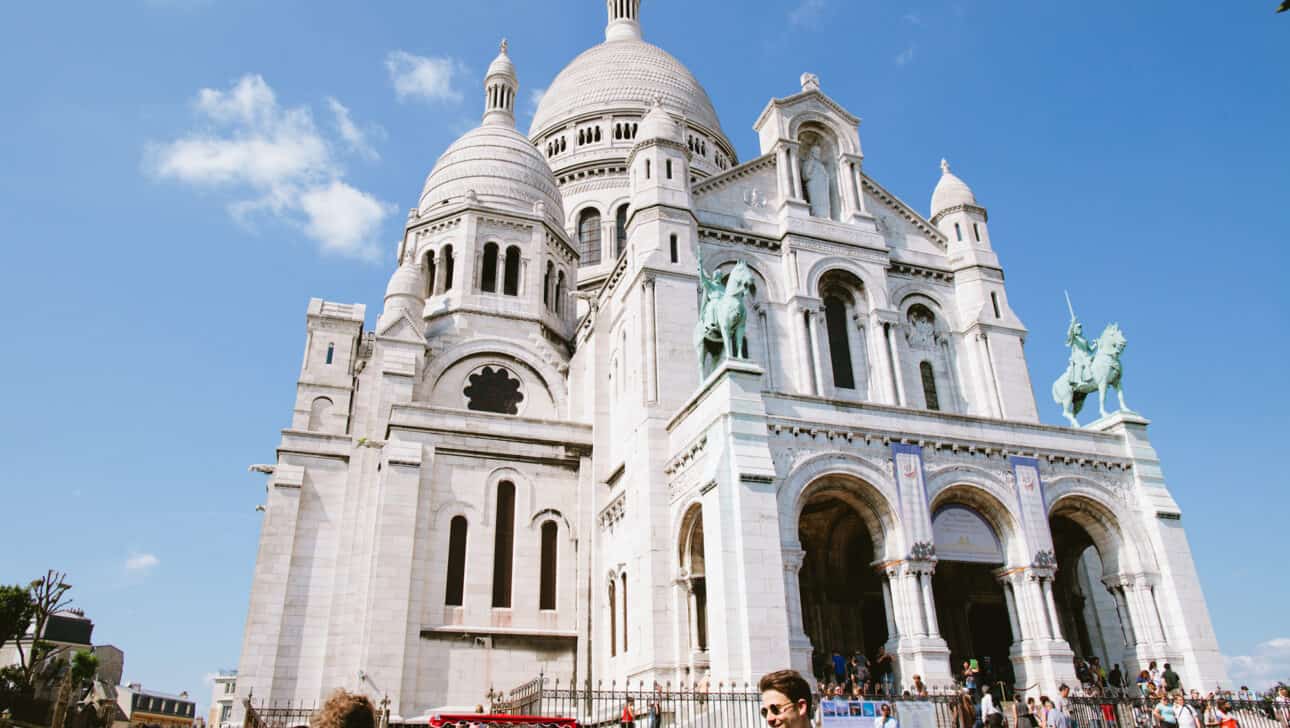
- 1 Sacré-Cœur Basilica
- 2 Moulin Rouge
- 3 Montmartre Vineyards
- 4 Van Gogh's House
- 5 Place du Tertre
- 6 The Famous Windmills
Meeting Point
We meet on street level just outside the Blanche Métro station (line 2).
Frequently Asked Questions
Questions about montmartre, can i visit sacré-cœur basilica after my tour.
Of course! Your walking tour does not include a guided tour inside the basilica, but your tour does conclude outside, so it is a wonderful opportunity to visit the interior if you wish to do so.
Entrance to the basilica is free. If you would like to enter the dome and crypt areas, the current ticket price is €8 for adults, €5 for ages 4-16, and free for infants under 4.
Please note that Sacré-Cœur Basilica is an active place of worship and requires guest’s shoulders to be covered inside the cathedral. We suggest wearing appropriate clothing or bringing along a scarf or cardigan to wear during your visit.
Is this walking tour strenuous?
While we maintain a leisurely pace, the Montmartre neighborhood is on a hill and our route does take some inclined cobbled streets.
General Tour Questions
Where is the tour meeting point, how long before my tour should i arrive.
The tour meeting time is 15 minutes prior to the start time. No refunds or re-bookings can be provided for late arrivals or no-shows after tour commencement or departure.
Are reservations required?
Yes, reservations are required for all tours.
What is your cancellation policy?
We’re happy to offer free changes and 100% refund up to 24 hours before tour* Failure to cancel a reservation at least 24 hours prior to scheduled departure may result in forfeited travel funds. Fare difference may apply.
*See restrictions here
What is the number to call if I am lost and trying to find the meeting point?
If you are having difficulty finding the meeting location for your tour, please call us at +33 1.82.88.80.94 and our staff will be happy to help you find your way.
How many people will be in my group?
For our walking tours, we limit the group size to 16 guests per tour guide.
My group size is larger than the dropdown menu allows, how can I book?
We would love to accommodate your group! Please contact our Groups team to see what options we have.
Similar Tours
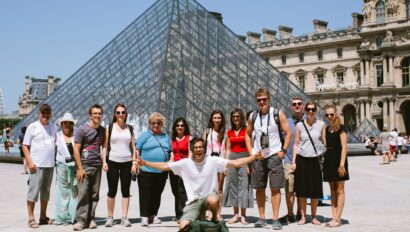
Private: The Classic Paris Walking Tour
From $26 €25 £22

Monet’s Garden Bike Tour
From $105 €99 £87

French Revolution Walking Tour
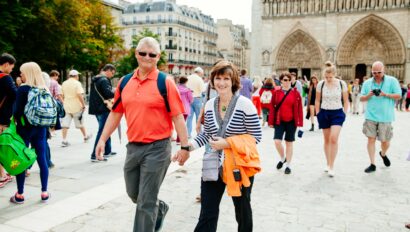
History of Paris Walking Tour with Notre Dame, Latin Quarter, and Île de la Cité
Explore our preferred partners around the world..


Montmartre tickets and tours
- Lowest price
- Highest price
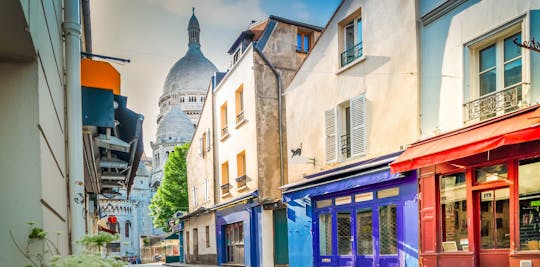
Montmartre’s little train roundtrip tour
Get the chance to tour Paris' most charming district onboard a panoramic train!
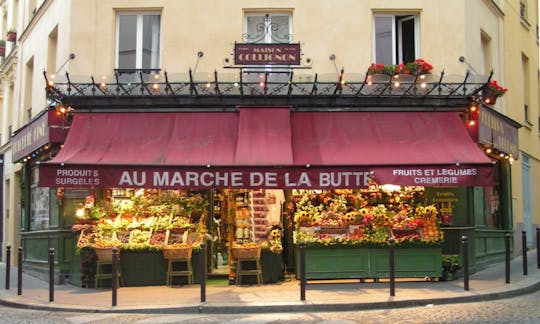
Montmartre 2-hour private walking tour
Book an art and history guided tour of Montmartre from Moulin Rouge, Van Gogh House to the Sacré Coeur Basilica and much more!
en, it, fr
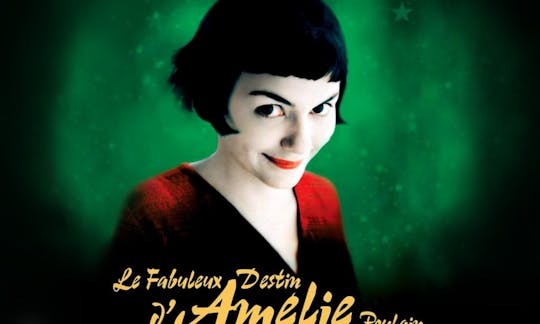
Cinema walking tour in Montmartre
Book your tickets to the Cinema tour in Montmartre and hear about the stories of the famous movies made in Paris.
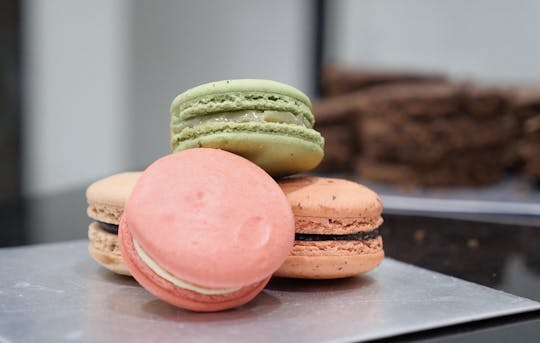
Traditional food tour in Montmartre neighborhood
Explore the neighborhood of Montmartre while tasting savory local food! Our local experts will lead you through some of the most beautiful parts of Paris and stop at different restaurants to try French specialties.
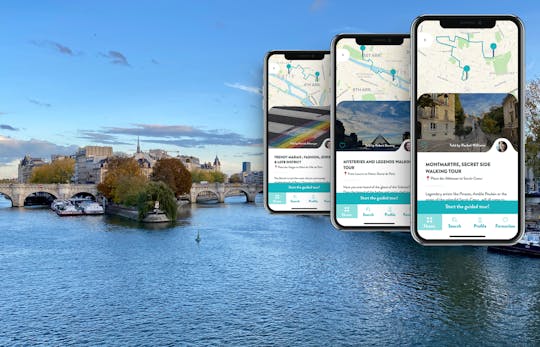
Best of Paris, 3 audioguided tours on your smartphone
Visit Montmartre, Le Marais and the Louvre neighborhood at your own pace and customize your itinerary as you wish with this audio-guided tour on your smartphone!
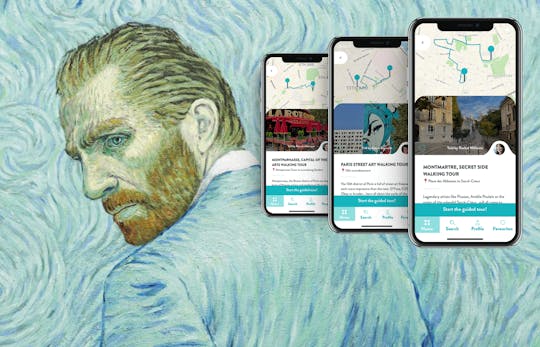
Best of Artists in Paris, 3 audioguided tours on your smartphone
Visit Montmartre, Montparnasse and the Street Art district at your own pace and customize your itinerary as you wish with this audio-guided tour on your smartphone!

Food tour in South Montmartre
Discover the most exciting neighborhood of Paris and taste traditional French food with this 3-hour food tour of South Pigalle!
en, fr, es
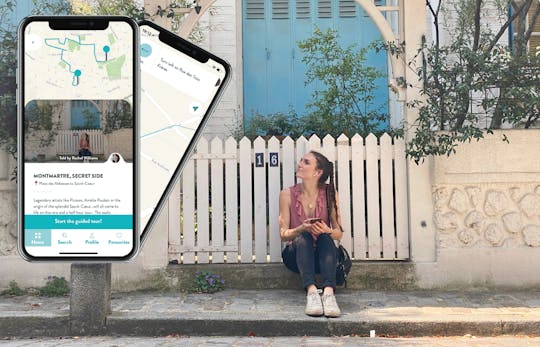
Montmartre guided tour on your smartphone
Visit Montmartre at your own pace and customize your itinerary as you wish with this audio-guided tour on your smartphone!
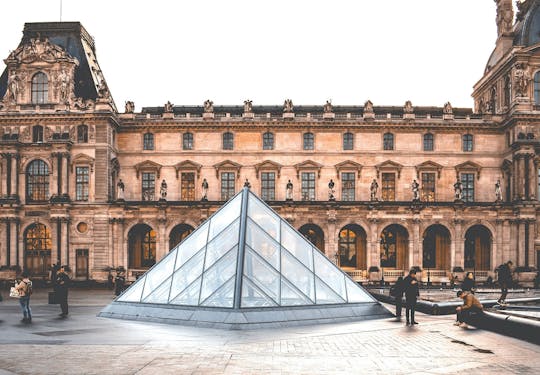
Go City | Paris All-Inclusive Pass
With the Go City® All-Inclusive Paris Pass enjoy access to many sites, art galleries and monuments, hop-on hop-off bus and sightseeing tours.
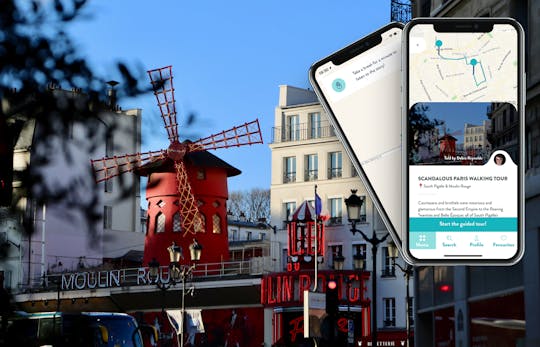
Scandalous Paris tour with guide on your smartphone
Visit Pigalle at your own pace and customize your itinerary as you wish with this audio-guided tour on your smartphone!

Best of Royal Days in Paris, 3 audioguided tours on your smartphone
Explore what life was like in Paris at the times of Kings and Queens with this combination of three walking tours with audioguide on your phone!
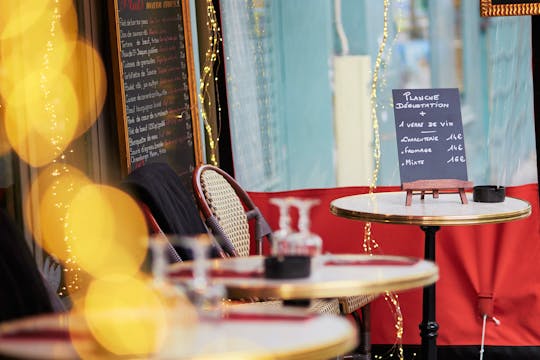
Food and wine tour in Montmartre
Taste and learn everything you've ever wanted to know about French gastronomy with this 3-hour food tour in Montmartre!
Top attractions in Paris

You might also like
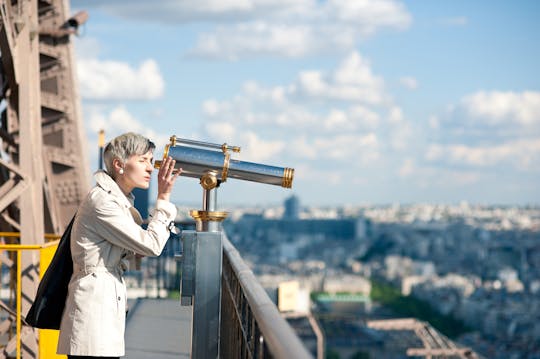
Paris city tour, Seine cruise and Eiffel Tower skip-the-line tickets
See iconic Paris with Eiffel Tower priority tickets, luxury air-conditioned coach transport, a Seine cruise and a multilingual guide. A perfect introduction!
en, it, fr, es, de, +5 pt, ru, ja, zh, ko
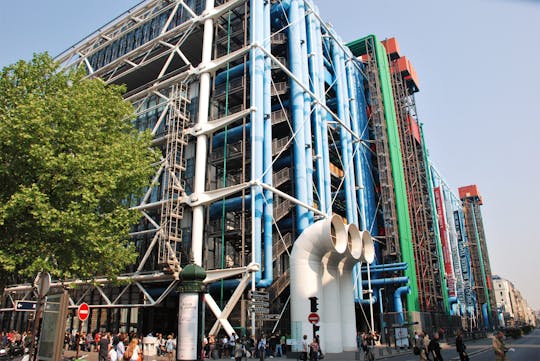
Tickets for the Centre Pompidou permanent collection
Book your entrance tickets to visit the permanent collection of Centre Pompidou!
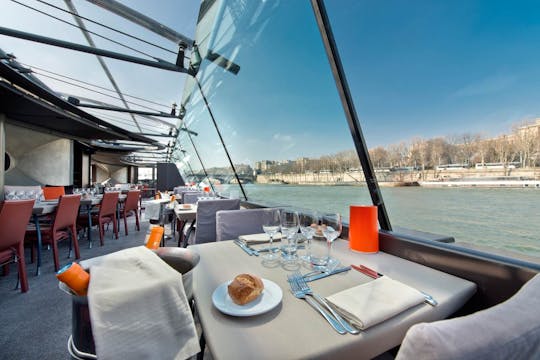
Lunch cruise on the River Seine
Board at the foot at the Eiffel Tower for a 2-hour authentic and unforgettable Lunch Cruise along the River Seine in central Paris.
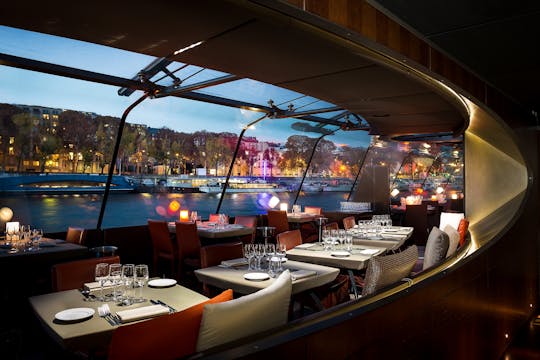
Dinner cruise on the river Seine
Sail in a glassed-over boat for a 2.5-hours à-la-carte meal dinner cruise and enjoy an unforgettable dinner while discovering the secrets of Paris and its light.
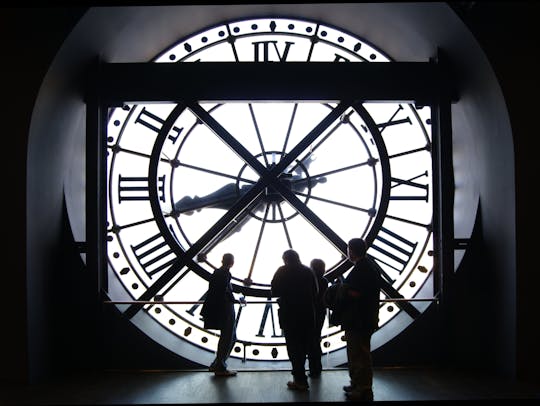
Impressionist masterpieces at Orsay Museum small group tour
Get your skip-the-line tickets and guided tour of the highlights of the Orsay Museum, and visit the world's largest collection of impressionist art.

Entrance ticket Grévin Wax Museum Paris
Buy your Grévin Museum Paris - Entrance Ticket with Musement with our price match guarantee and secure booking. Get informed, plan and book your amazing activities in Paris.
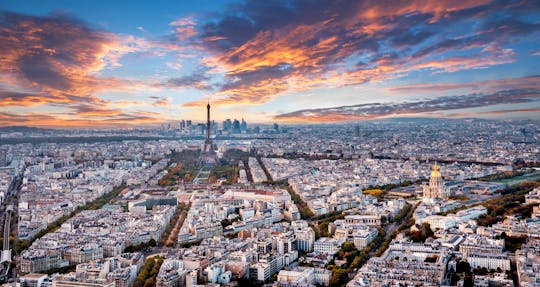
Montparnasse tower 56th floor tickets
Book your ticket for the Tour Montparnasse and go up to the 56th floor of the tower to enjoy the best panoramic view of Paris!
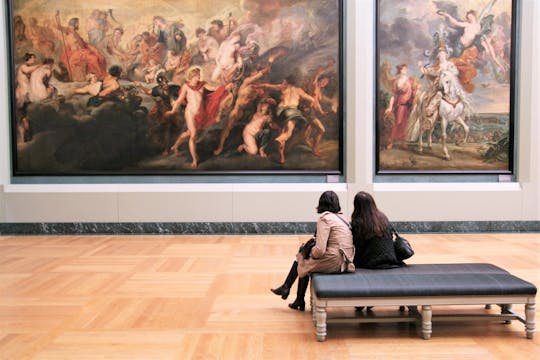
Visit of the Louvre Museum and cruise ticket
Get your ticket to the Louvre Museum and a 1-hour cruise on the Seine river.

Private guided tour Napoleon and Les Invalides
Book a private guided tour of Napoléon and Les Invalides in Paris and discover the glory and decline of Napoleon Bonaparte.

Moulin Rouge show tickets
Buy your Moulin Rouge Show tickets: Live a dream night in an iconic setting and discover a different side of Paris's famous landmarks by night.
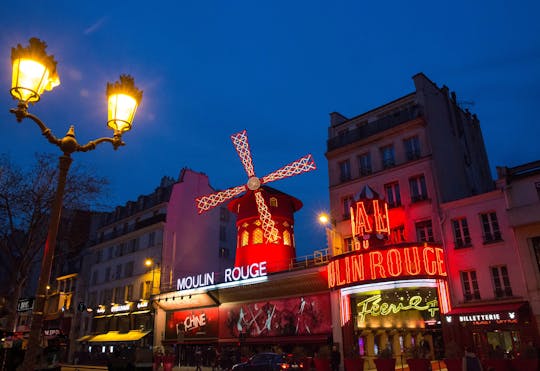
Paris City tour and Moulin Rouge show
Discover the charm of the French capital with a bus tour and admire the fun and sensual show at the Moulin Rouge.
en, it, fr, es, de, +6 pt, ru, nl, ja, zh, ko
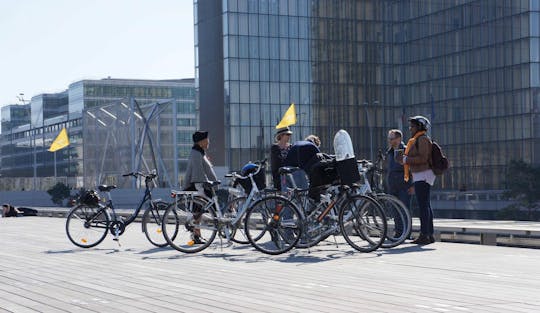
Paris: Guided Bike Tour with Food Tasting
Discover the places Parisians are used to go to and taste french food during this bike tour.
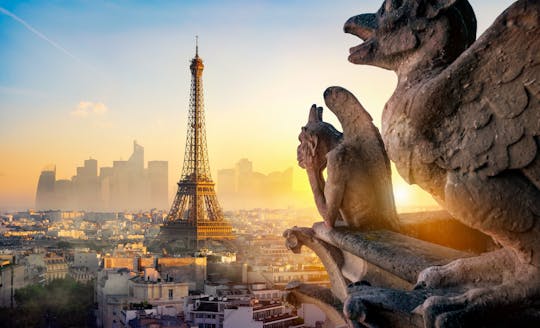
Paris city tour
Book a city tour of Paris in an open-top coach, the ideal activity for first-time visitors in Paris. Several departures a day leave from our agency located near the Louvre.
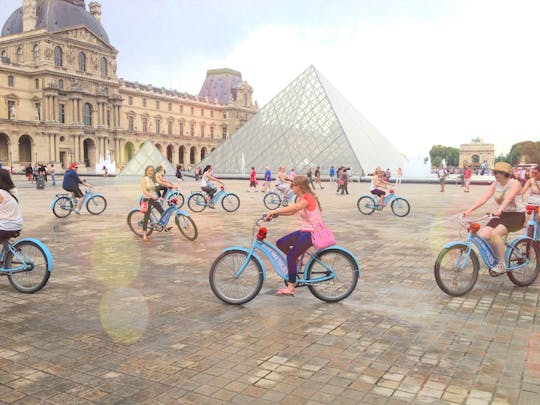
Best of Paris guided bike tour
Buy your Best of Paris guided bike tour now with a guide and whiz through the Parisian streets learning about the best monuments.
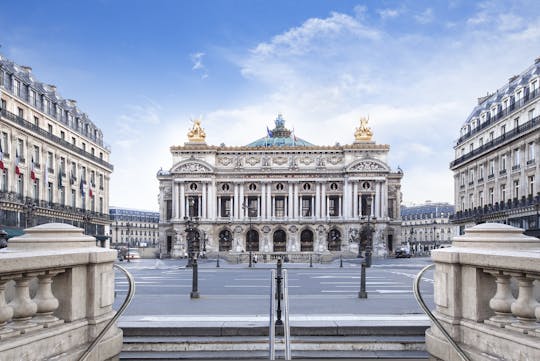
Entrance ticket to the Opéra Garnier
Buy your entrance ticket to the Palais Garnier, the famous Opéra de Paris, and visit one of the city's most significant architectural gems.
The inside story
The neighbourhood of Montmartre, towering 130 meters above Paris on the hill of the same name used to be a village north of Paris before being attached to the town in 1860 to become one of the most famous districts of the Capital. Its most important landmark is the Basilica of the Sacred Heart, built in 1873, famous for its Romano-Byzantine architectural style. From inside, the Basilica offers a spectacular view of the biggest bell in the France, the “Savoyarde” and also possesses, amongst many other works of art, the largest mosaic in the world. Back in the day, the Montmartre district was famous for its windmills. No less than a dozen in 1786, they then used to grind wheat, plaster and pebbles. The windmills represented the Parisians’ favorite attraction; they would go up to Montmartre on sunny Sundays to take a walk, drink wine right after the harvest, dine and dance. Artistic area by excellence, Montmartre has always been an inspiration for many writers, composers, writers, musicians and dancers. Among the best known were Toulouse-Lautrec, Utrillo, Picasso, Renoir, Van Gogh, Dalida, Boris Vian, Jacques Prévert, Serge Gainsbourg.

How to get there
- Top Destinations
- Mexico City, Mexico
- Tokyo, Japan
- Paris, France
- Rome, Italy
- London, United Kingdom
- All Destinations
- Upcoming Experiences
- Walking Tours
- Small-Group Tours
- Tours for Kids
- Museum Tours
- Food, Wine and Market Tours
- Newly Added Tours
- Audio Guides
- Pre-Trip Lectures
- Admin Dashboard
- My Favorites
- Client Orders
- Monthly Commissions
- My Advisor Profile
- Advisor Toolkit
- Guide Dashboard
Credit Balance
Transactions are based on current exchange rates and performed in USD. There maybe slight variations in the price estimates.
Montmartre Tour with Sacré-Coeur
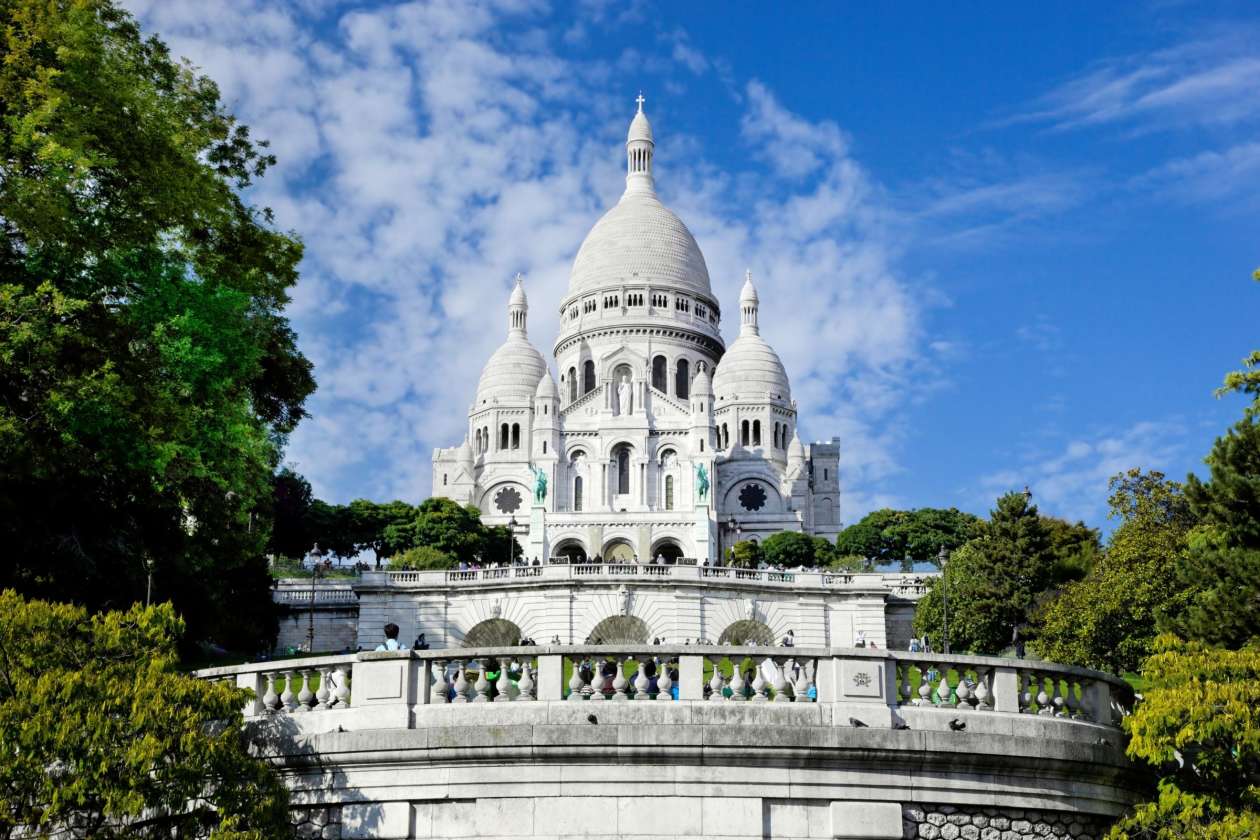
- Place du Tertre
- Bateau Lavoir
- Saint Pierre de Montmartre
- Sacré-Coeur

- Explore the urban and social context of historic Montmartre
- Led by a historian

Reviews can only be left by Context customers after they have completed a tour. For more information about our reviews, please see our FAQ .
You May Also Like
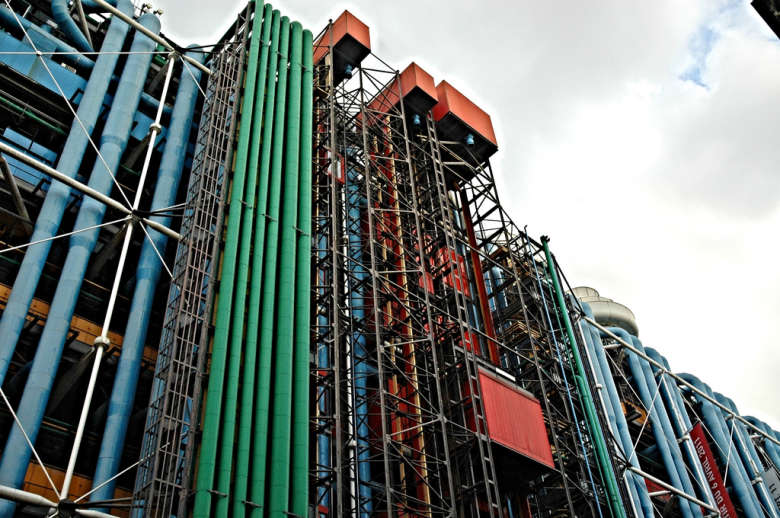
Centre Pompidou Tour: A Guided Crash Course with Skip-the-Line Tickets

Hemingway in Paris History Tour
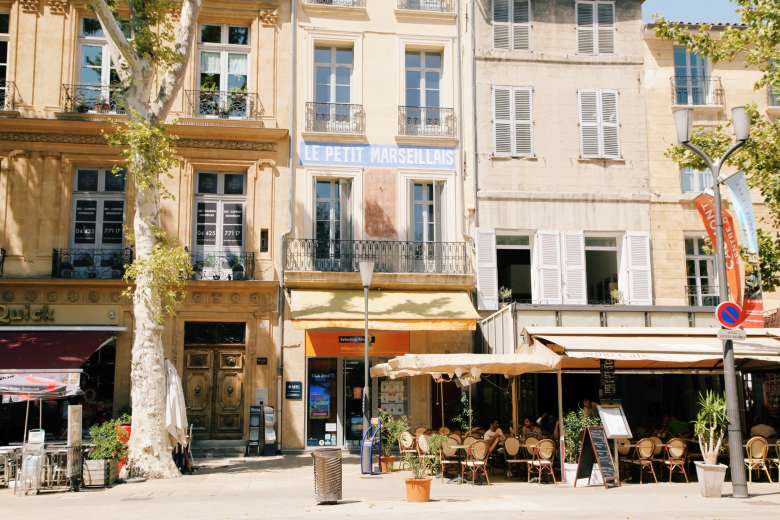
Cézanne's Aix-en-Provence Tour
Book a tour.
- Our Experts
- Working with Context
- View All Cities
- Sustainable Tourism
- Refer a Friend for $50
- Travel Updates
- Advisor Login
- Expert Portal
Subscribe to our Newsletter
- Privacy Statement & Security
- Cancellation Policy
Our website uses cookies to personalize your experience, perform analytics, and tailor ads. By clicking accept, you consent to our use of cookies. To view our data privacy policy, click here .
Our website uses cookies to personalize your experience, perform analytics, and tailor ads. By using our site, you consent to our use of cookies. To view our data privacy policy, click here .

Visiting Montmartre, Paris: Top 12 Attractions, Tours & Hotels
Written by Lisa Alexander Updated Dec 26, 2023 We may earn a commission from affiliate links ( )
Montmartre invites visitors to take a step back in time, while wandering its quaint cobblestone streets and relaxing in the leafy historic squares. This charming quarter (around Abbesses Métro station) represents the 18th arrondissement of Paris, but centuries ago, it was just a little hilltop village in the country. Today, Montmartre still feels a world apart from the rest of the city.
Thanks to its enchanting ambience, Montmartre has captivated Bohemian artists since the Belle Epoque and continues to delight tourists today. The special atmosphere and sense of joie de vivre burst from every corner of the neighborhood, from the old-fashioned merry-go-rounds and bustling sidewalk cafés to hidden pedestrian staircases and tree-shaded terraces where passersby can sometimes catch an impromptu street performance.
Tourists flock to the stunning Sacré-Coeur Basilica on the highest point of Mont Martyr, where the martyr Saint Denis was buried. The Sacré-Coeur may have a somber atmosphere inside the sanctuary, but outside, it's an exuberant celebration of life. Visitors snap photos; locals lounge on the grassy esplanade, and couples enjoy the romantic setting, as well as the splendid views.
A few steps away from the Sacré-Coeur are some of Montmartre's artistic highlights: the Place du Tertre, which is a veritable open-air gallery, and several museums displaying works by Renoir, Picasso, Dalí, and Toulouse Lautrec, who made this neighborhood an artists' colony.
It's worth taking time to wander the narrow, winding stone-paved lanes of Montmartre. A leisurely ramble might lead to discoveries of old churches, hidden squares, little bakeries, and inspirational ateliers.
This captivating neighborhood has so many tourist highlights that visitors could easily spend several days exploring the area. Learn about the best places to visit and things to do with our list of the top attractions in Montmartre.
1. Basilique du Sacré-Coeur
2. place du tertre and eglise saint-pierre de montmartre, 3. musée de montmartre, 4. place des abbesses, 5. dalí paris museum, 6. carré roland dorgelès, 7. le moulin de la galette: windmills, 8. montmartre cemetery, 9. le bateau lavoir: a famous artists' atelier, 10. musée de la vie romantique, 11. musée national gustave moreau, 12. musée d'art naïf - max fourny, tips and tours: how to make the most of your visit to montmartre, map of montmartre, paris: top attractions, tours & hotels.
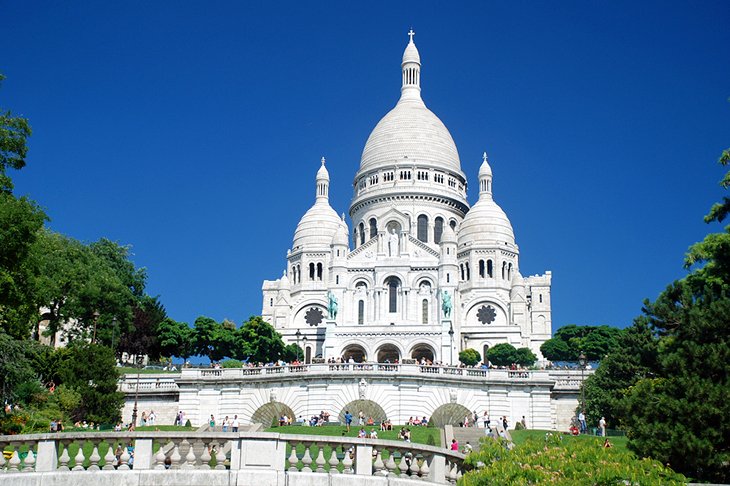
The Sacré-Coeur Basilica is an important historical landmark, towering above Paris from high on the Butte Montmartre . The church was created after the Franco-Prussian War as a symbol of hope.
This Romanesque and Byzantine-style basilica has multiple domes (resembling a decorative layer cake), earning it the nickname of the "Wedding Cake."
Inside, the enormous Christ en Gloire ( Christ in Glory ) ceiling mosaic welcomes worshippers into the sanctuary. Dating to 1923, this 475-square-meter work of art is one of the world's largest mosaics.
Visitors are also enchanted by the abundance of candles in the dimly lit interior; the flickering illumination lends an aura of spirituality.
The basilica has a Grand Organ (listed as a Historical Monument), which is played on Fridays for Mass at 3pm, as well as on Sundays for Mass (at 11am, 6pm, 10pm) and Vespers service at 4pm. On Christmas Eve, there is an organ concert at 10pm prior to the Midnight Mass. Otherwise the Basilica du Sacré-Coeur is dedicated to silent prayer.
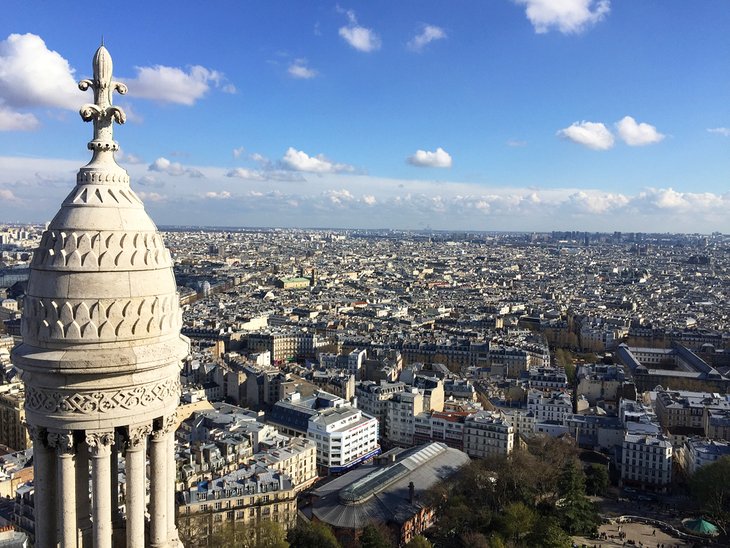
A highlight of visiting this famous attraction is the view from the Basilica's Dome , which requires an admission fee. In clear weather, it's possible to see the entire cityscape of Paris including the Notre-Dame , Centre Pompidou, and Opera House. Access to the Dome is outside the basilica on the left, up a flight of 300 steps (no elevator).
The Sacré-Coeur Esplanade (at the Parvis de la Basilique) also offers panoramic views. The esplanade is often filled with locals and tourists, and sometimes street musicians entertain the crowds.
Below the esplanade are the leafy gardens of the Place Louise-Michel , traversed by a staircase leading up to the basilica's entrance.
At the base of the Butte Montmartre (where the staircase begins) is the Place Saint-Pierre , a favorite spot for families because of its adorable old-fashioned carrousel.
To arrive at the Sacré-Coeur, tourists who don't mind an uphill climb can walk from Place du Tertre to 35 Rue du Chevalier-de-la-Barre (the entrance in the back of the Basilica).
Alternatively, from the Place Saint-Pierre, it's a scenic but steep 20-minute walk up 222 steps (through the verdant Place Louise-Michel) or a less than two-minute funicular ride that begins near the Place Suzanne Valadon, a short walk from the Place Saint-Pierre.
Address: 35 Rue du Chevalier-de-la-Barre, 75018 Paris
Official site: http://www.sacre-coeur-montmartre.com/english/
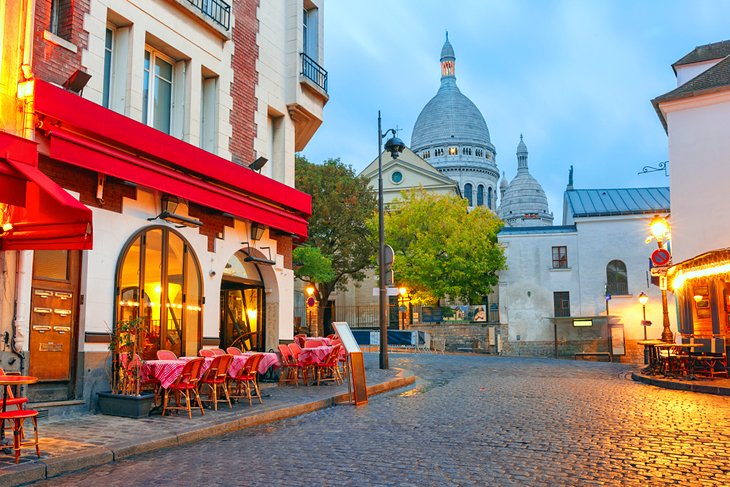
The creative spirit of Montmartre comes alive at this picturesque square in the shadow of Sacré-Coeur. On the square's cobblestone courtyard space, local artists set up easels to create artworks on the spot. Many tourists are tempted to purchase the paintings, which often depict charming scenes of the neighborhood.
Visitors will find all kinds of painters, portraitists, and caricaturists, although much of the work is designed to be tourist souvenirs. The handsome 18th- and 19th-century buildings that enclose the square now house busy restaurants and cafés. Spilling out into the cobblestone square are outdoor terraces that allow tourists to soak up the scene.
Even when packed with tourists, the Place du Tertre does not lose its charm. Standing in the shadow of the Sacré-Coeur and shaded by ancient trees, the Place du Tertre has the feel of a provincial square. It was the main square of the medieval village before Montmartre became incorporated into Paris. The house at Number 3 on the square was the " Mairie " (town hall) of the old village. The narrow lanes surrounding the Place du Tertre invite visitors to explore.
For those interested in browsing or buying original art, the Galerie Montmartre is an exceptional venue. This prestigious gallery presents a wide range of modern and contemporary artworks, including pieces by famous modern artists Salvador Dalí, Joan Miró, Henri Matisse, and Pablo Picasso. The artwork at the Galerie Montmartre is authenticated and available for purchase.
A few steps away, behind the Place du Tertre, is the Paroisse Saint-Pierre de Montmartre at 2 Rue du Mont-Cenis. This church is the relic of a 12th-century Benedictine Abbey, however the history dates back further. The Church of Saint-Pierre was built on the site of a 7th-century (Merovingian era) house of worship, which was constructed over an ancient Roman temple dedicated to Mercury.
The interior of the Paroisse Saint-Pierre de Montmartre has retained features of the original Merovingian church, including the four black marble columns in the choir and at the west end of the nave. Besides its 7th-century vestiges, the Church of Saint-Pierre exemplifies Early Gothic architecture; the choir was consecrated in 1147 in the presence of the great Catholic reformer Bernard of Clairvaux. The interior also has contemporary stained-glass windows by Max Ingrand.
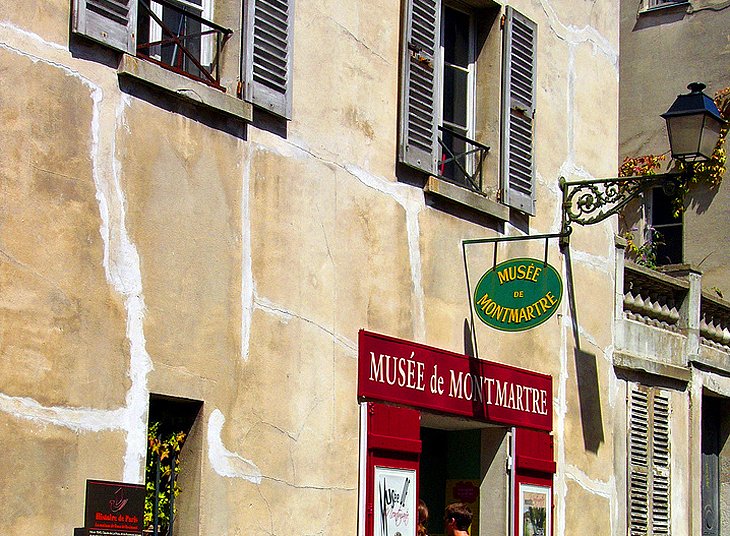
Discover the Bohemian past of Montmartre at this wonderful museum a few steps away from the Place du Tertre. Housed in a 17th-century building, the Musée du Montmartre offers a nostalgic view of earlier days in Montmartre.
The museum is the actual location of a meeting place that once attracted numerous artists. Auguste Renoir had his studio here, along with Suzanne Valadon and other artists including Émile Bernard and Raoul Dufy.
With its extensive collection of art dating back to the 1880s, the Montmartre Museum recounts the history of Montmartre and brings to life the creativity of this special quarter of Paris.
The collection of around 6,000 pieces includes the work of Montmartre's celebrated artists including Modigliani and Vuillard as well as the Nabis, Fauvist, and Symbolist painters. Among the famous works on display are the original posters for the Lapin Agile and Chat Noir cabarets. There is even a room devoted to art depicting the French Cancan dance.
The works of Toulouse-Lautrec are well-represented; his pastels truly capture the Bohemian spirit of Montmartre during the Belle Epoque. Toulouse-Lautrec would draw while attending a party or watching cancan dancers perform at the Moulin Rouge. Many of his works feature unconventional subjects such as clowns and cabaret dancers.
Surrounding the museum are the Renoir Gardens (Les Jardins Renoir), where the artist painted La Balancoire ( The Swing ) and the Jardin de la rue Cortot ( The Garden of Cortot Street ). The gardens offer sensational views of Montmartre and the rest of Paris.
In a corner of the garden, tourists will find Le Café Renoir , occupying the garden's beautiful glassed-roofed conservatory. This cheerful sun-filled space is a refreshing spot for enjoying coffee, snacks, light meals, and afternoon tea. The outdoor patio seating is especially pleasant during the spring and summertime.
Address: 12 Rue Cortot, 75018 Paris
Official site: www.museedemontmartre.fr
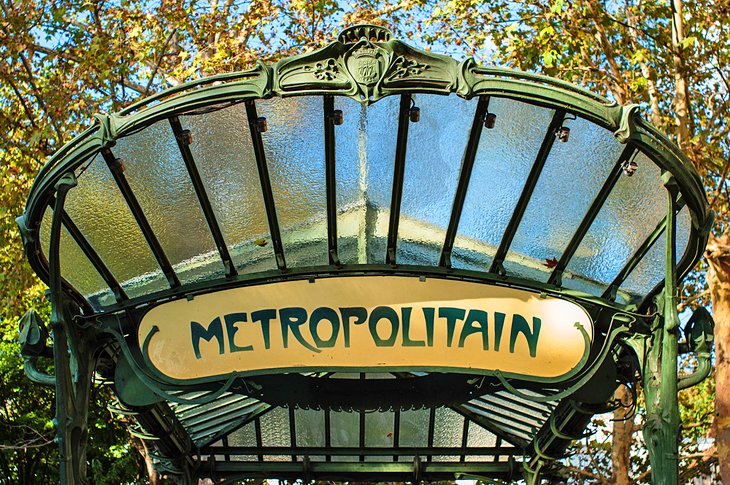
The Place des Abbesses is a tree-shaded square featuring the prettiest Métro station in Paris. Its most renowned feature, the decorative Art Nouveau entrance was designed by Hectar Guimard. This bustling square is the center of Montmartre's social and commercial activity, with many shops, restaurants, and cafés on the nearby streets. There is also a musical carousel (merry-go-round) at the Place des Abbesses that children adore.
Visitors should note that the Abbesses Métro station is 30 meters underground and requires an arduous walk up a long winding staircase. Alternatively, visitors could arrive at the Pigalle Métro station, which does not have steep steps and is just a short walk from the Place des Abbesses.
Opposite the square is the Eglise Saint-Jean-l'Evangéliste (by Anatole de Baudot, 1904), a simple brick-faced church that serves the local community. Nearby streets of Rue Yvonne le Tac and Rue des Trois Frères are lined with cute cafés, boutiques, small neighborhood bakeries, and crêperies. Many restaurants in this area feature live entertainment, sometimes a classic accordion or jazz performance.
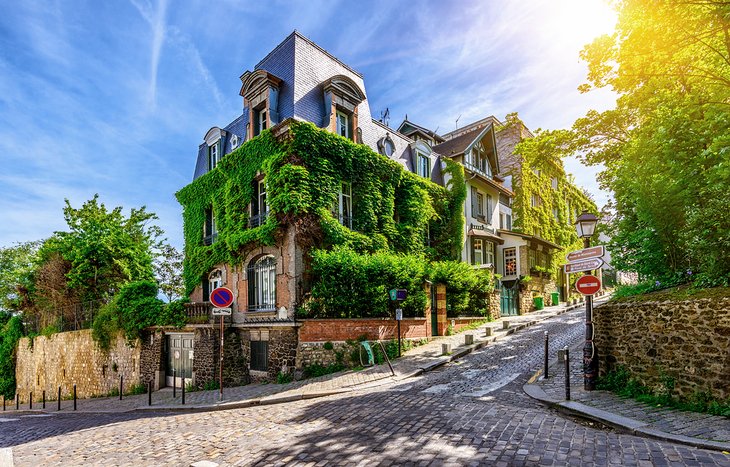
Taking a stroll through the meandering medieval streets of Montmartre is one of the most delightful things to do in Paris . For an off-the-beaten-path self-guided walking tour, tourists can begin at the Place des Abbesses and continue to the Passage des Abbesses . An arched entry provides access to a flight of steps that ascends the hill towards Rue Berthe .
Taking a right on Rue Berthe, a left on Rue Drevet, another left on Rue Gabrielle, and then a right on Rue du Calvaire leads up to the Place du Tertre . Lined with restaurants' outdoor dining terraces and filled with the easels of local artists, this lovely square is a favorite tourist spot. It's also just steps away from the Sacré-Coeur Basilica.
While walking around Montmartre, visitors will be charmed by the quiet traffic-free areas. Narrow cobblestone streets and pedestrian staircases reveal that Montmartre has roots as a small pastoral village (it was separate from Paris until 1860).
Glimpses of a bygone era are still found throughout Montmartre, seen in the clothes lines hung outside open-shuttered windows, in the tiny locally owned shops and corner boulangeries , and in the local way of life. Neighborhood residents linger at outdoor cafés, while kids play games of pick-up soccer in the squares.
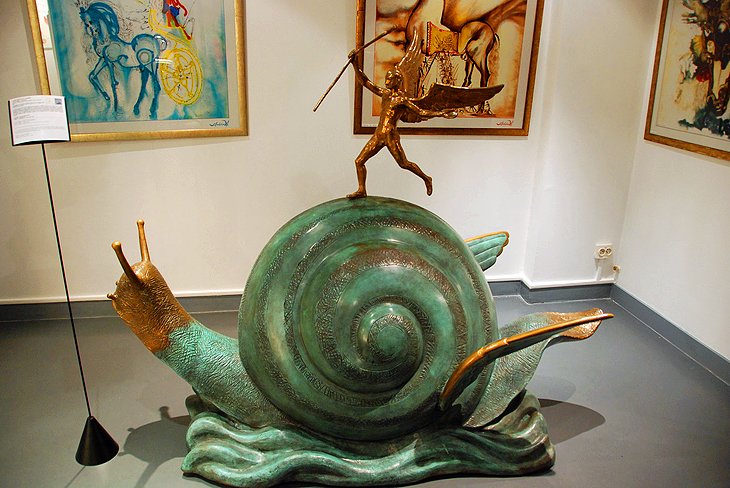
At this unique museum, visitors can delve into the curious and intriguing world of Salvador Dalí. Fittingly, the museum is located near the Place du Tertre , the center of Montmartre's art scene.
The Dalí Paris museum reveals the creative genius of the famous surrealist artist. This exceptional museum is the largest collection in France devoted to the work (paintings, sculptures, and graphics) of Salvador Dalí and is especially noteworthy for its assortment of the artist's sculptures.
Address: 11 Rue Poulbot, 75018 Paris
Official site: http://daliparis.com/en/
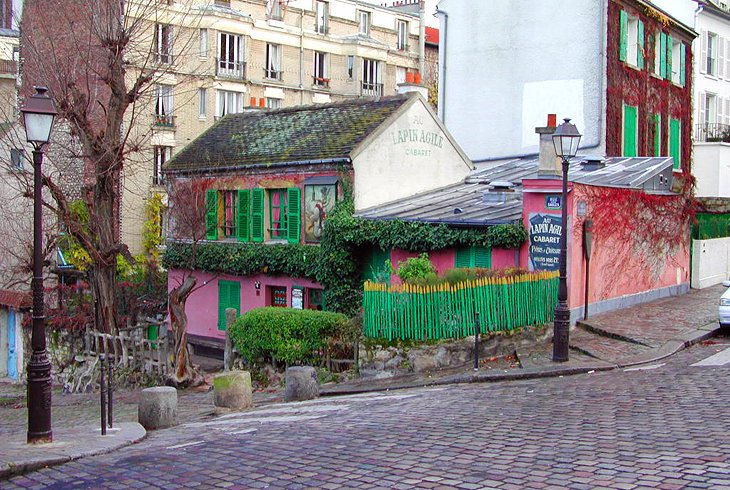
This peaceful square hints at the atmosphere of Montmartre when it was a little provincial village. Shaded with ancient trees, the spacious square feels far away from the Parisian metropolitan area. At the corner of Rue Saint-Vincent and the steep street Rue des Saules is a historic house associated with the Bohemian artists of Montmartre.
Look for the wording " Au Lapin Agile " painted on the side of the building (22 Rue des Saules). This legendary establishment dates to 1860 and took its name " Lapin Agile " ("Agile Rabbit") from a poster painted by André Gill that depicted a rabbit jumping out of a cooking pot.
Montmartre's last remaining (and Paris' oldest) cabaret, Au Lapin Agile continues to share the joys of traditional French chansons with enthusiastic audiences. This small, cozy venue presents an artistic cabaret show "Songs, Music, Poetry," featuring Edith Piaf songs and old French songs. The audience may sing along, adding to the convivial experience.
At the turn-of-the-century, Le Lapin Agile and this area of Montmartre was the haunt of avant-garde artists, poets, writers, actors, and singers. Famous artists such as Toulouse-Lautrec, Claude Debussy, Vincent van Gogh, Pablo Picasso, Amedeo Modigliani, Max Jacob, and Guillaume Apollinaire gathered here, providing artistic inspiration to one another.
When wandering around the alluring old streets of the Carré Roland Dorgelès, visitors are transported to a scene of Montmartre's Bohemian past when the spirit of creativity flourished.
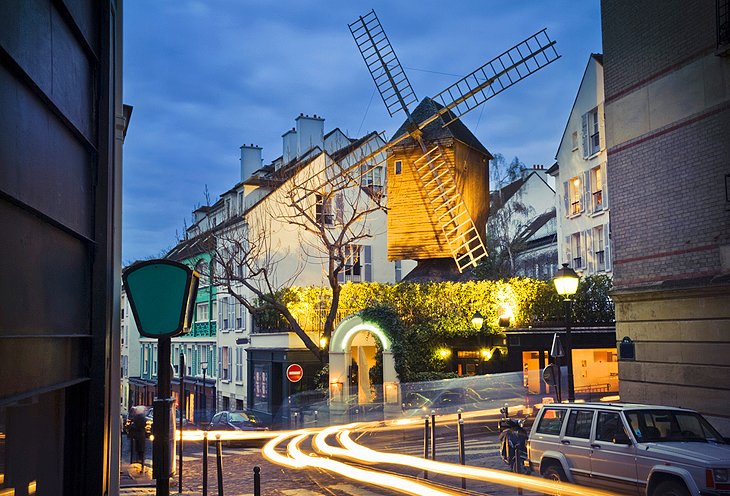
The village of Montmartre was once graced with many windmills but they were all taken down except for two: the Moulin Blute-Fin and Moulin Radet, which date back to 1717. Together, these two remaining windmills are known as Le Moulin de la Galette, a nostalgic reminder of Montmartre's old windmills.
The Moulin de la Gallette provided inspiration for a number of painters including Renoir and Van Gogh. Renoir's famous masterpiece, Le Bal du Moulin de la Galette , shows a festive scene at a traditional ball that took place in 1876 at the Moulin de la Galette, seen in the painting's background. This celebrated Renoir masterpiece is found at the Musée d'Orsay.
Travelers can imagine the real-life scene of the Dance at Le Moulin de la Galette (captured by Renoir) by dining at the Le Moulin de la Galette restaurant (83 Rue Lepic). Specializing in seasonal French cuisine, this historic brasserie restaurant has a pleasant terrace with a view of the Moulin de la Galette windmills.
Also nearby is the La Galette des Moulins pâtissierie (1 Rue Norvins), a tempting boutique that offers classic French pastries such as eclairs, fruit tarts, and millefeuille (layers of puff pastry and cream).
Address: 83 Rue Lepic, 75018 Paris
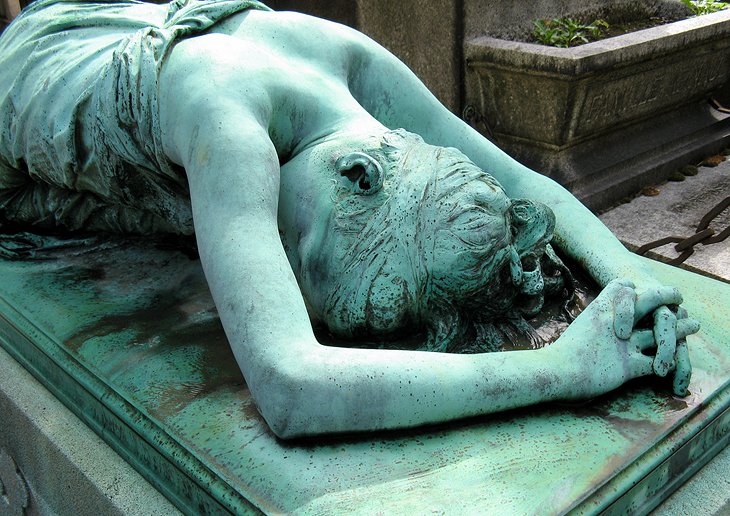
Opened in 1825, Montmartre Cemetery covers more than 11 hectares, the third largest in Paris and perhaps the most romantic, not only for its landscape but for the tombs, memorials, and chapels.
The cemetery's air of melancholy is intensified by the somewhat overgrown look of many of its monuments and by the poignant sculptures that adorn others.
Among the tombs are those of many of the artists who lived in Montmartre during its golden age. Visitors will find monuments to the painter Edgar Degas, the dancer and choreographer Vaslav Nijinsky, composers Jacques Offenbach and Hector Berlioz, writer Alexandre Dumas, and Marie Duplessis.
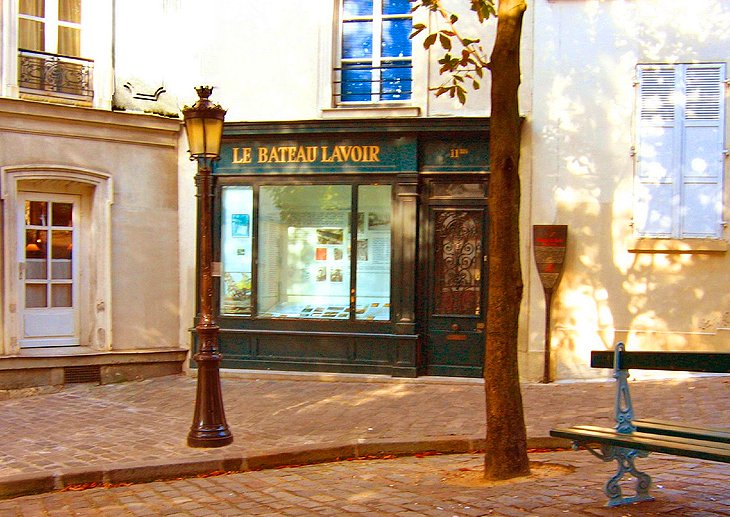
Le Bateau Lavoir is a historic atelier where famous artists Pablo Picasso , Amedeo Modigliani , Kees van Dongen, Juan Gris, and Max Jacob lived and worked. In this unassuming little building that was once a piano factory, the art of Cubism was brought to life.
Picasso moved here in 1904 and a year later painted Les Demoiselles d'Avignon . This surprising and distinctive painting is the first example of Picasso's signature Cubist style.
Many artists, writers, actors, and art collectors (including Henri Matisse , Georges Braque, Gertrude Stein , and Jean Cocteau ) also visited Le Bateau Lavoir to discuss art, which allowed new ideas to flourish.
In addition to the artists who visited and lived here, many noteworthy artists (including Paul Gauguin, Otto Freundlich, André Salmon, and Constantin Brancusi) had their studios here.
Back in those days, at the turn of the century, the house was rather squalid and had no electricity, heating, or running water, but it was very inexpensive, and the artists were happy living there because the cheap rent allowed for experimental creativity.
The atelier has since been rebuilt, replicating its original form, after being destroyed by a fire in the 1970s. However, only a small shopfront reveals the historic character of the original building that was home to a legendary artists' community.
Today the space houses 25 artists' studios. The Bateau-Lavoir is on the delightful tree-lined square, previously named Place Ravignan.
Address: 13 Place Emile-Goudeau, 75018 Paris
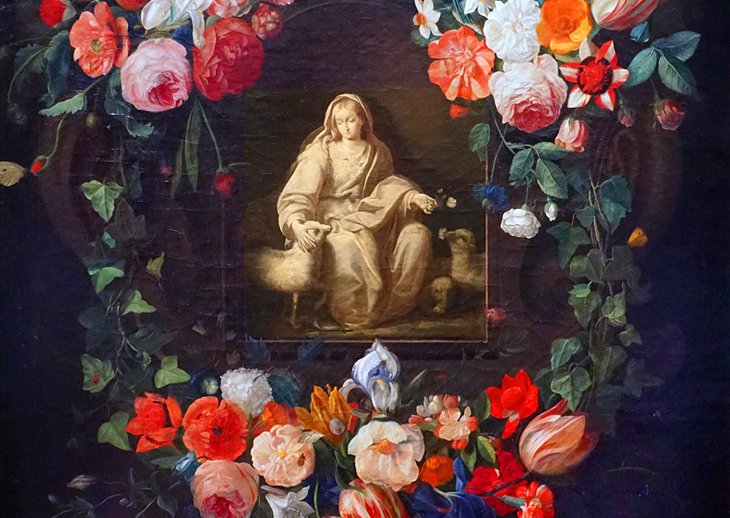
This charming museum celebrates the Romantic era in Montmartre. Romanticism was an artistic movement (focused on imagination and expressiveness) that influenced the artists of Paris around 1815 to 1848.
During the 1830s, the Dutch painter Ary Scheffer turned his elegant villa, the Hôtel Scheffer-Renan, into a salon. George Sand, Frederic Chopin, Eugène Delacroix, Franz Liszt, Jean-Auguste-Dominique Ingres, Alphonse de Lamartine, and Ivan Turgenev were habitués of the salon.
The museum occupies the Hôtel Scheffer-Renan and evokes the historical ambience with period portraits, decor, and furniture. The collection comprises Beaux-Arts (Fine Arts) works and Arts Graphiques (Graphic Arts), which includes portraits and landscapes.
There is also a section devoted to Memorabilia with numerous mementos of the artists and literary figures who frequented the salon. Throughout the year, the museum hosts temporary exhibitions, guided walks, art workshops, and conferences.
Tucked away in the property's garden greenhouse, the museum's salon de thé (tea salon) serves light meals, afternoon tea, pastries, and snacks. The tea salon is open year-round. In inclement weather, the garden greenhouse provides an idyllic setting overlooking the tranquil, bucolic scenery. On warm sunny days, the outdoor patio feels like a little corner of paradise with its shady campanula trees and fragrant roses.
The museum is open Tuesday through Sunday from 10am until 6pm. The tea salon is open the same hours except that it closes at 5:30pm. Both the museum and tea salon are closed on Mondays, as well as on January 1st, May 1st, and December 25th.
Address: Hôtel Scheffer-Renan, 16 Rue Chaptal 75009 Paris
Official site: http://www.museevieromantique.paris.fr/en
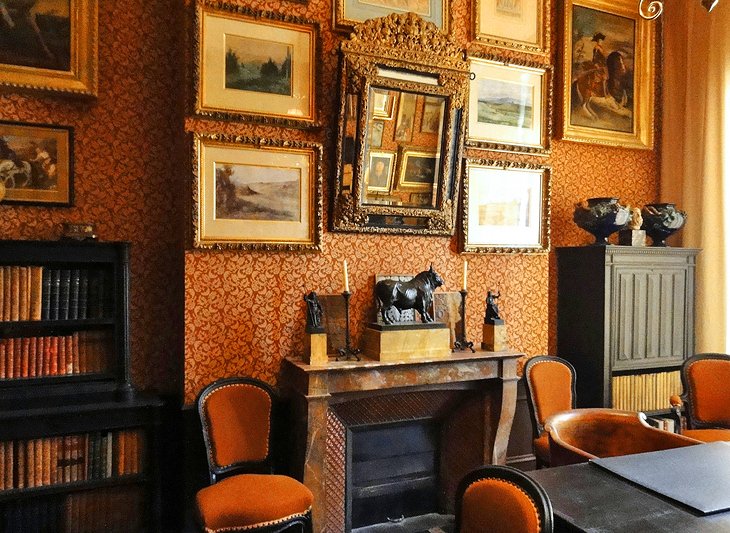
Bordering the Montmartre neighborhood in the 9th arrondissement, this museum is worth a detour for those who appreciate the art of Gustave Moreau. This museum was the residence and studio of Gustave Moreau from 1852 to 1898. The museum displays an extensive collection of Moreau's works, including around 1,300 paintings and 5,000 drawings.
Gustave Moreau was a Symbolist artist renowned for his romantic, whimsical, and fantastical style. Many of his paintings feature the theme of classical mythology, and others have a dreamlike quality. The museum has kept Moreau's cabinet de réception (study) in its original state.
Address: 14 Rue de La Rochefoucauld, 75009 Paris
Official site: https://en.musee-moreau.fr
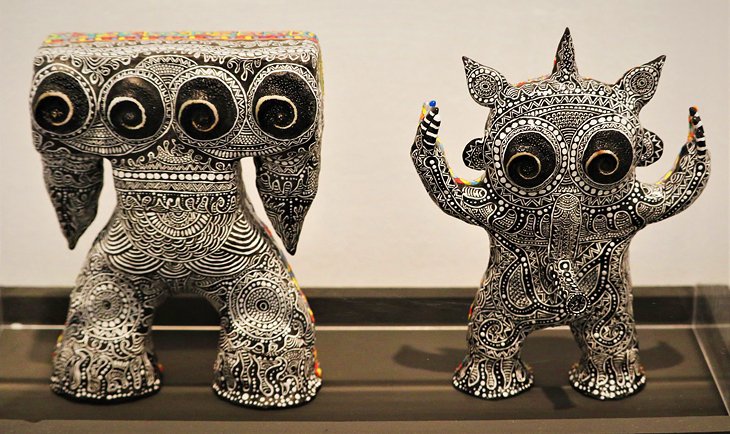
This innovative museum offers a more modern perspective of the Montmartre art scene, with a permanent collection of Max Fourny's artwork. The museum is at the foot of the Butte Montmartre in the Halle Saint-Pierre , a cultural center that opened in 1986. The building was originally designed as a marketplace but now is used as an exhibition center and a venue for cultural events.
Max Fourny is known for his naïve (folk) art, also called " art brut " ("raw art"). The collection includes more than 500 paintings and 80 sculptures. The museum at the Halle Saint-Pierre also features other exhibitions of folk art from around the world.
After viewing the artworks, visitors can stop at the bookshop and the café located within the Halle Saint-Pierre.
Address: Halle Saint-Pierre, 2 Rue Ronsard, 75018 Paris
- Tours of Montmartre: Soak up Montmartre's Bohemian spirit and learn about the history on a two-hour Montmartre and Sacré-Coeur Walking Tour in Paris . An expert guide will lead you through the neighborhood's atmospheric cobblestone street to the essential sights, such as the Place du Tertre, the Basilique du Sacré-Coeur, and Le Lapin Agile.
- Guided Art Museum Tour : To delve more deeply into the work of the Impressionist artists who lived and painted in Montmartre, try the Montmartre Impressionist Art Walking Tour . This 1.5-hour tour takes participants to the landmarks of Montmartre that Impressionist artists painted, and afterwards allows skip-the-line entry to the Musée d'Orsay, Paris' largest collection of Impressionist art, where the artworks are on display.
- Exploring Montmartre: Distances on maps of this part of Paris can be deceiving, as they don't show the steep terrain. Although a map is handy for street names if you're looking for a specific address, if you're merely exploring the neighborhood, it's better to wander and look forward to getting lost and making your own discoveries.
More Related Articles on PlanetWare.com
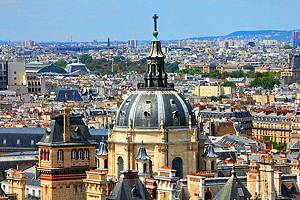
Exploring Bohemian Paris : By the late 19th century, Montmartre was an established gathering place for Bohemian artists such as Toulouse-Lautrec and Renoir. Montmartre continued to attract free-spirited artists through the Jazz Age and until the era of avant-garde art (Picasso and Dalí). At the same time, Bohemian artists and writers frequented other areas of Paris such as brasseries on the Boulevard Montparnasse and the sidewalk cafés of Boulevard Saint-Germain in the Latin Quarter . Similar to Montmartre, the Latin Quarter has an off-beat, artsy, and intellectual bent.
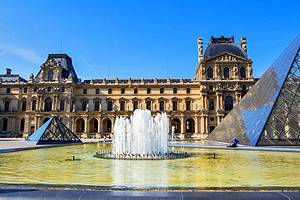
France for Art Lovers : Other destinations in France will appeal to travelers who love the artistic spirit of Montmartre. Tourists can begin by visiting the top museums in Paris to admire the works of the Impressionists and avant-garde artists who resided in Montmartre. Next on the artists' trail is the South of France . Many famous painters, such as Picasso, Van Gogh, and Cézanne, spent time in the Provence region and along the sunny Côte d'Azur (French Riviera) ; their work is on display at museums in Saint-Tropez , Saint-Rémy-de-Provence, Arles , and in Aix-en-Provence .

More on France


Montmartre hill guided tour
Montmartre guided tour.
Discover one of the most picturesque neigborhood in Paris. The former village of Montmartre still has its old streets, windmills, cabarets, cemetaries, churches and even a vineyard ! It has been the parisian artists' neighborhood for centuries, celebrities such as Renoir, Dalida and Picasso used to live here. From the massive Sacre Coeur basilica on top of the hill you'll be able to appreciate the most beautiful view of the city.
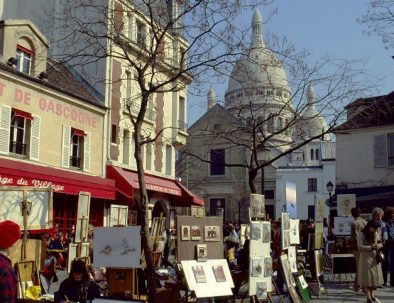
Meeting point
In front of the funicular railway exit, rue du Cardinal Dubois
An amazing fresh look on Paris
Discover Paris from every angle possible : our itineraries are designed to bring you authentic experiences of Paris' major attractions, neighborhoods and charming hidden locations.
A knowledgeable and entertaining tour guide
The Aime Paris tour guides are friendly, educated, enthousiastic, reliable, energetic, with academic background and professionnal experience. They are used to dealing with groups of all ages and sizes. They are able to offer tours in different languages.
A fascinating guided tour
Guided tours are the best way to get to know Paris, from the most famous monuments to the secret places only parisians know about. Learn everything about Art, Architecture and History in a fun way !
Easy access to the Parisian sights
The Aime Paris tour guides are holders of the Guide Conférencier National professional badge (the highest tourist guiding qualification in France), therefore they are able to use special entrances at certain well known attractions to avoid waiting in long lines.
Other guided tours you might be interested in :
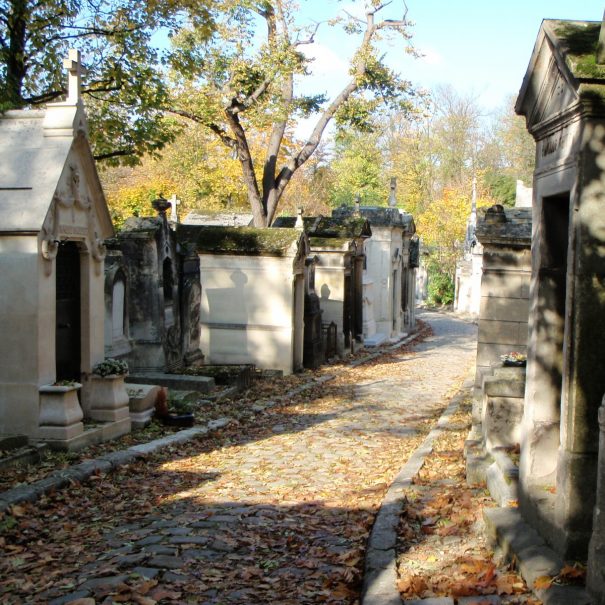
Pere Lachaise cemetery guided tour
Père-Lachaise guided tour Père Lachaise Cemetery is most visited cemetery in the world. It is notable for being the first garden cemetery, created in 1804, and for housing the tombs of many celebrities such as the writer Oscar Wilde, the … Read More
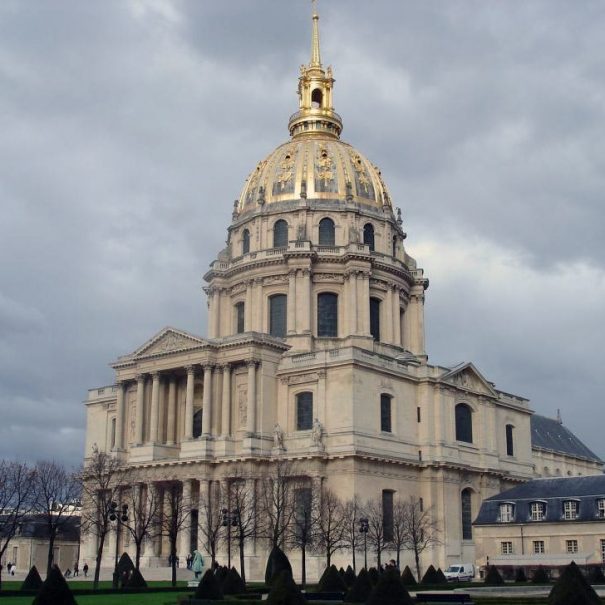
The Invalides guided tour
The Invalides : the Army museum and Napoleon's tomb Built in the 17th century by king Louis XIV as a retirement home for war veterans, the Hôtel National des Invalides nowadays also houses a military museum of the Army of … Read More
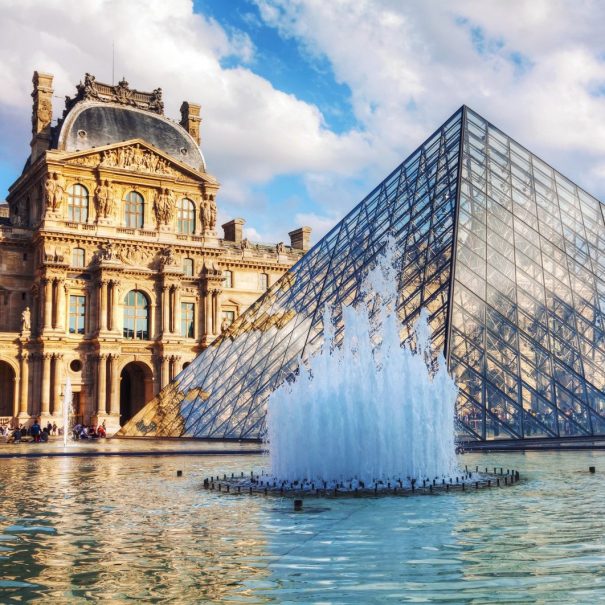
Louvre guided tour
Louvre guided tour From the Middle Ages castle to the famous glass pyramid, this former royal palace has lived centuries of History of France. Converted into a museum during the French Revolution, it now houses some of the most famous … Read More
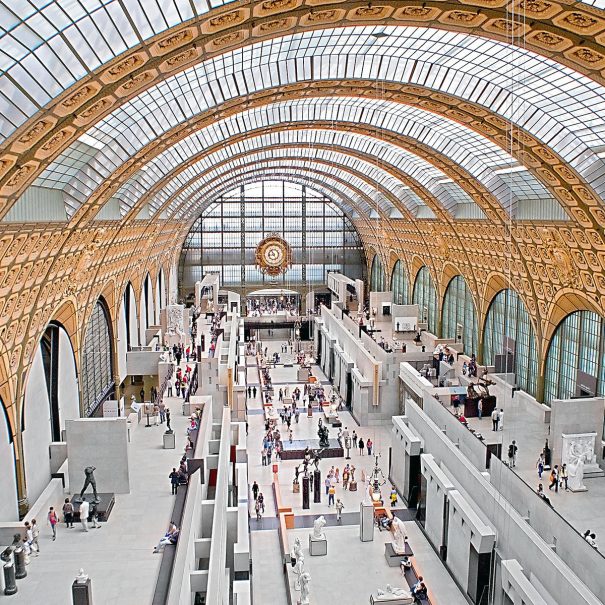
Orsay museum guided tour
Orsay museum guided tour This beautiful former train station, built for the World Fare of 1900, was converted into a museum in the eigthies. The Musée d’Orsay houses all kinds of Arts of the 19th and 20th century : Manet, … Read More
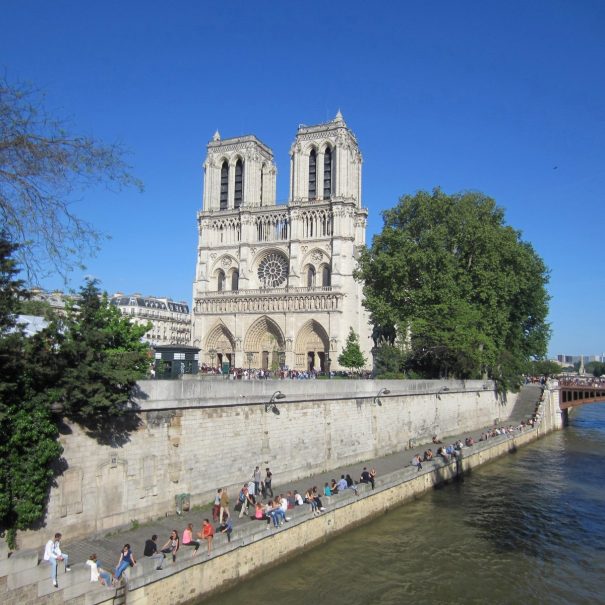
Notre-Dame & the City island
The City Island guided tour Considered as the craddle of the city, the Île de la Cité (city island) is in Paris’ very center. Explore its old streets, picturesque river banks and majestic monuments such as Notre-Dame cathedral, Sainte-Chapelle and … Read More
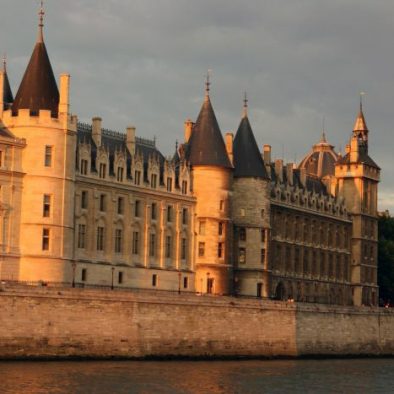
Conciergerie palace guided tour
Conciergerie palace guided tour Discover the oldest Royal palace in Paris, converted into a prison in the 15th century and nowadays housing the law court. Over the centuries, the Conciergerie has seen all kinds of people within its medieval walls … Read More

Montmartre Walking Tour: Self-Guided Walk of the 18th
By: Author Sophie Nadeau
Posted on Last updated: 23rd May 2023
Categories Paris , walking tour
Last Updated on 23rd May 2023 by Sophie Nadeau
Quirky architecture, rich history, and the fact that Montmartre has been a muse for artists, poets and writers alike for centuries make it the perfect spot to get lost in, perhaps even for a few hours. Here’s a Montmartre Walking tour ; a self-guided walk full of quirky activities and sites.
Montmartre. If there’s one arrondissement I could return to again, and again, it’s this time-warp in central Paris. The sights, the smells, and of course, all of the cobbled lanes come together to form a little piece of quirky France that’s best explored on foot.
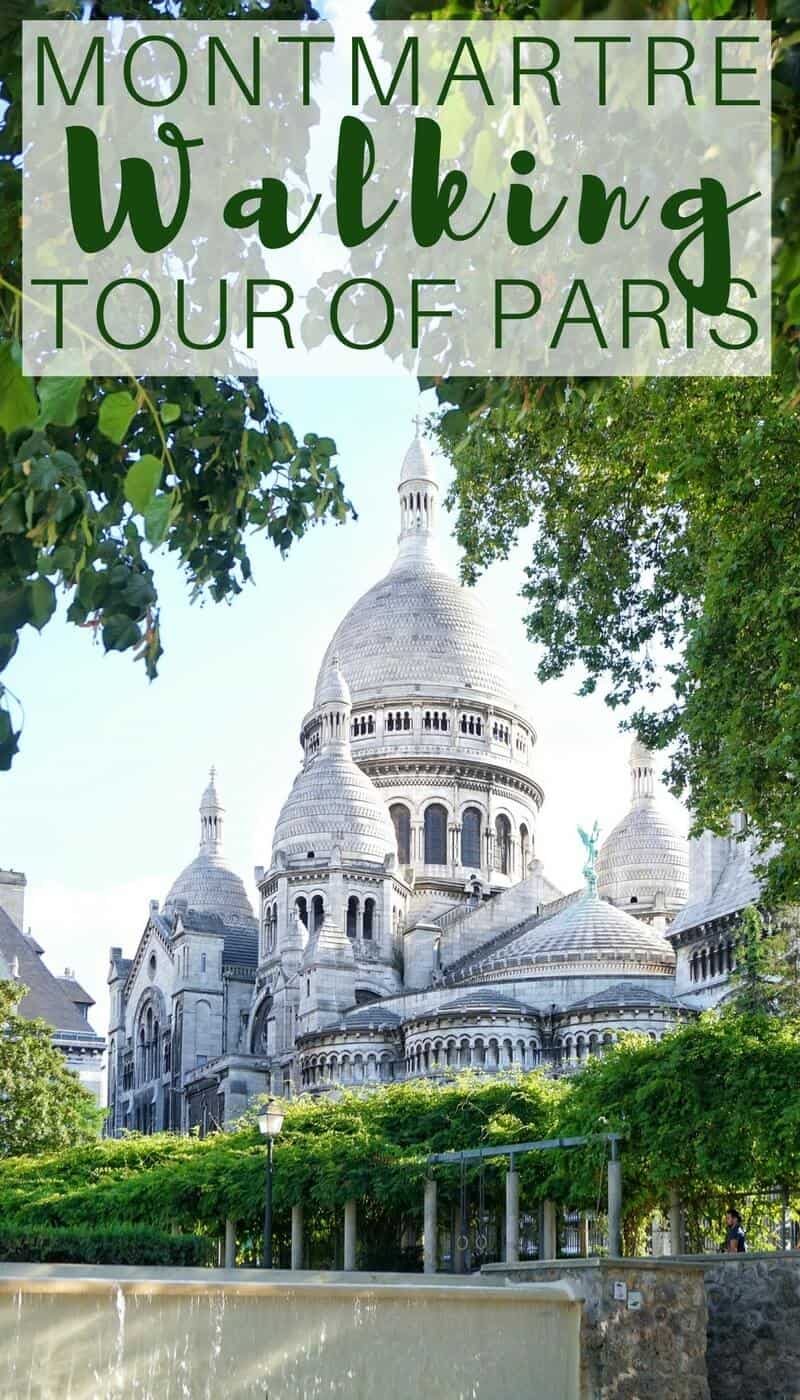
Psst. If you’re planning to visit Paris, then we’ve created a gorgeous 100+ page eBook full of beautiful photos and insider tips by a local. Included you’ll find hidden gems, arrondissement guides, walking tours, suggested itineraries, and more. Find more information here.
Montmartre Walking Tour: Practical Advice, Tricks & Tips
Parvis du sacré coeur, sacré coeur, musee de montmartre, clos montmartre, la maison rose, rue l’abreuvoir, place dalida, moulin de la galette, picasso’s paris studio, le consulat café, place du tertre, le refuge des fondus, le mur des je t’aime, l’objet qui parle, enjoyed following this free and self-guided montmartre walking tour of the 18th arrondissement pin it now, read it again later:.
Before you head out on your Montmartre Walking Tour, there are certain things you should know. Firstly, make sure that you wear suitable walking shoes: this is one area of Paris where there really are plenty of cobbled lanes.
Though the walking time is just 26 minutes, allow yourself at least a couple of hours to ensure that you have enough time to see all the sites and attractions along the way (after all, there are plenty of museums, small streets, and eateries you may want to spend a while in along the way) .
If you’re considering stopping for lunch, and perhaps also an afternoon tea, then allocate yourself an entire half day of your time in Paris to complete this tour, especially if you’re planning to explore the museum.
Walking time: 26 minutes
Distance Covered: 2km
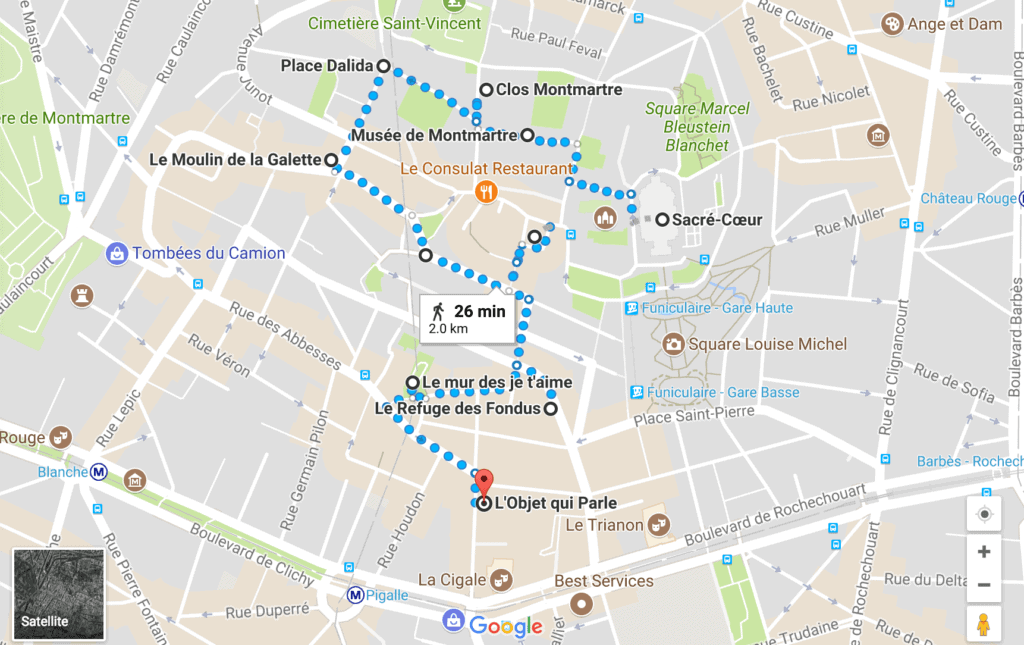
Places to see on this Montmartre walking tour
Begin your self-guided walking tour of Paris at the Parvis du Sacré-Coeur, the gateway to Montmartre. You can reach the Parvis du Sacré-Coeur via a number of different routes.
The nearest metro station is Anvers (line 2 blue) and you can walk up the numerous steps from the Carousel, up to the Sacré-Coeur. Just be sure to bring some water and snacks if it’s a hot day as it’s a pretty steep climb up!
If you approach the Basilica from this direction, you’ll pass the Sinking house of Montmartre along the way. Alternatively, you can reach the Parvis via the funiculaire de Montmartre (Montmartre funicular) . Opened in 1900, the journey lasts a minute and a half and costs the same as one metro ticket.
Once at the top, take a moment to admire the landscape, and the city of Paris sprawling out below you. This is your first glimpse of Montmartre and a portal into another time zone…
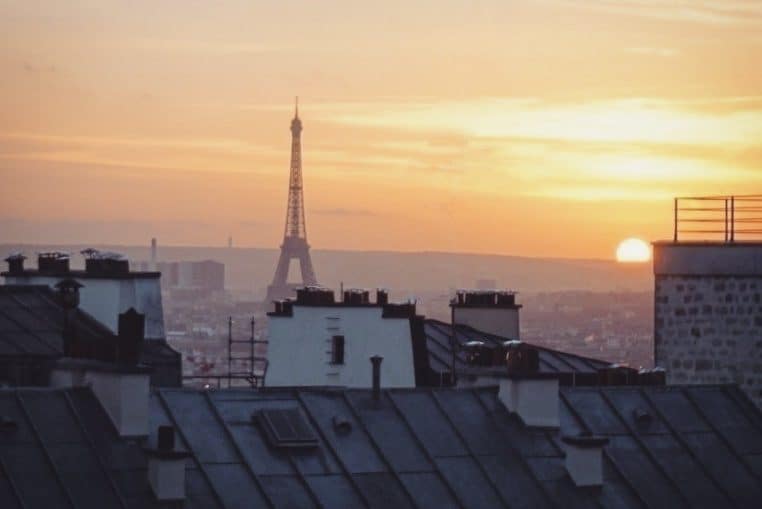
The iconic Basilica of the Sacré-Coeur has been a place of worship for thousands of years (during Roman times, it was even used as a pagan place of worship) . And, let’s face it, you predominantly visit Montmartre to catch at least a quick glimpse of the iconic Basilica.
Entry to the church is free, though no photographs are allowed inside (though I’m sure you’ll see plenty of people trying to take photos during your visit!). If you so wish, you can also pay a fee to go inside the interior top dome of the basilica to get an even better view of Paris from above.
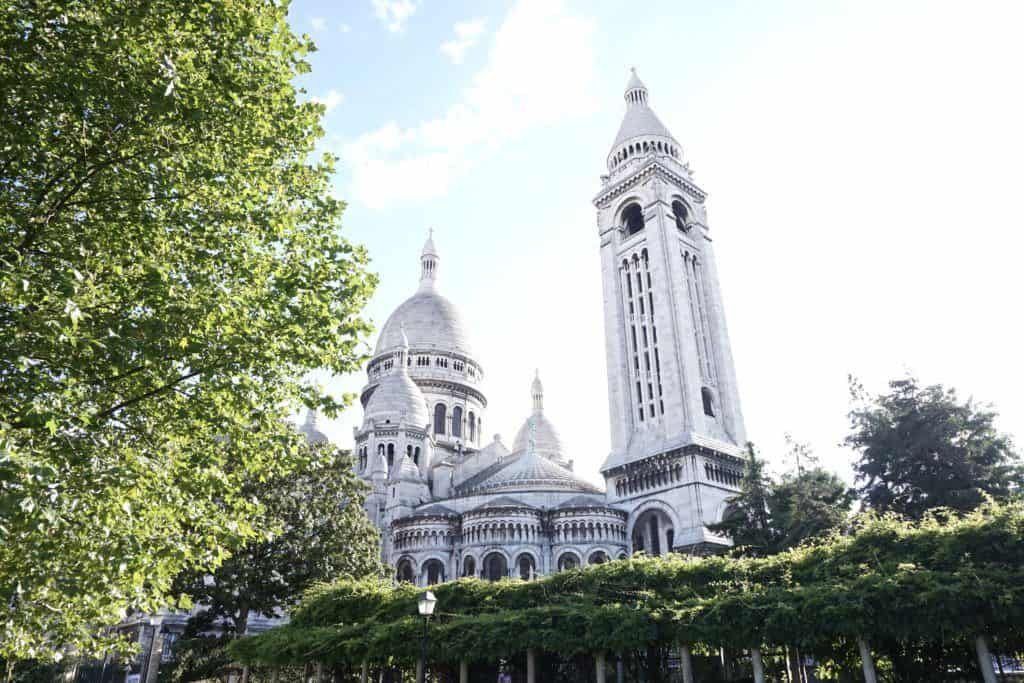
Pretty in pink, and complete with a set of gardens dedicated to Renoir, Musée de Montmartre is the perfect introduction to life in Montmartre, and the culture which has grown up around the area.
Located at 8-14 Rue de Cortot, here you’ll find a selection of artworks by many a famous resident of the area, as well as a brief history of Montmartre itself.
Purchase your Musée de Montmartre ticket here.

If you really want to get an understanding of Montmartre, and the history of the area, then no Montmartre Walking Tour would be complete without a visit to the Clos Montmartre , one of the last working vineyards in the middle of Paris. Situated just to the rear of Musée de Montmartre, the vineyard produces just a few bottles of wine annually.
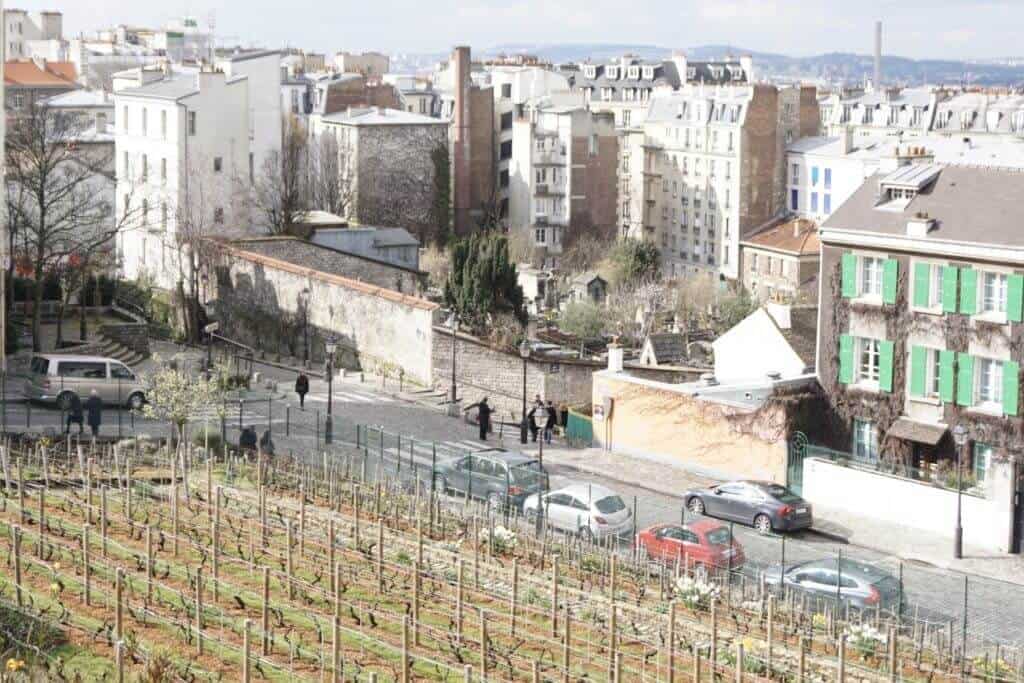
Incredibly famous since the rise of Instagram, La Maison Rose stands at the end of one of the prettiest roads in Paris and is surrounded by cobbled streets. The restaurant/ café is open daily for food and drinks and is pretty much as cute as you can imagine (from the photo) .
There has been a coffee shop at La Petite Maison Rose for well over a hundred years, and this small bar on the side of Montmartre was once a boarding house where writers would come to enjoy their lunchtime meals for a modest price.
Today you can still enjoy traditional French fare on the little chairs and tables outside of the Parisian café. However, you should note that the café gets incredibly busy and so be sure to head here mid-week and earlier in the day if possible!

The pretty little road of rue de l’Abreuvoir overlooks the Sacré-Coeur and some of the prettiest architecture Montmartre has to offer. Many of the houses are covered in ivy.
Rue de l’Abreuvoir also happens to be one of the best places to see Wisteria in the city come wisteria season in April/ May. The street takes its name from an ancient watering trough situated in its centre, and dates back all the way to the 14th-century.

Perhaps the prettiest square in Paris, Place Dalida is well worth a stroll around, and perhaps a quick stop to snap a photo or two. The square is named after the iconic singer Dalida, an Egyptian/ Italian who called Paris home during her most famous years.

Once upon a time, the hill of Montmartre and its surrounding countryside was home to a whole multitude of windmills. Though this is no longer the case, a few still survive to this day. Moulin de la Galette is a testament to the history of Montmartre, as well as its enduring culture.
Today, the Moulin (windmill) operates as a restaurant and is open on a daily basis for lunch and dinner. A windmill has stood here, in this spot, since at least the 17th-century.

As you will have already seen from your time at the Montmartre Museum, the area has inspired countless artists, writers, and poets for centuries. One of the most famous of these was Picasso, who spent a lot of time in Montmartre when he was starting out.
As a result, he set up shop in Montmartre, Le Bateau-Lavoir to be precise. Though much of the building was sadly destroyed by fire in the 1970s, the façade survived and the building was reconstructed.

Perhaps the cutest cafeé in Paris (if one coffee house is even allowed to claim that title) , Le Consulat is well worth a look when you’re in Montmartre. Situated at 18 Rue Norvins, this little café is overlooked by the Sacré-Coeur, a cobbled street and is the perfect place to stop off for a quick coffee. For exactly how to order a coffee in Paris, I’ve written a short guide here !

If you want to see where the artists spend their time in Paris nowadays, then you need to look no further than Place du Tertre. Filled with little artists’ stalls, here you’ll find painters painting en plein air .
There’s even the chance to purchase some of their artworks (if you’re looking for a particularly unusual souvenir from France to bring home with you).
Surrounding the Place du Tertre square, you’ll find a large selection of cafés and shops selling ice cream, snacks, and larger meals- though I don’t recommend actually eating around here.

If you’re looking for traditional French cuisine, as well as a convivial dining experience, then Le Refuge Des Fondus is the place to head to. Enjoy wine, by the [baby] bottle- yes, the wine quite literally is served in baby bottles. Here, you’ll also find more fondu than you could possibly eat (and it’s oh so delicious!)

A wall dedicated to all things love, the wall has ‘ Je T’aime ‘, (or I love you for all my English speaking readers) in over 250 languages, with over 300 declarations of love listed in total!
Spend the penultimate stop on your Montmartre Walking Tour celebrating love, and stop to admire the wall for a short moment. The I love you wall is at the base of the Butte Montmartre and comprises 612 tiles of enamelled lava. All in all, it’s well worth a look!

Finish off your Montmartre walking tour by indulging in a typically Parisian- and more specifically Montmartre- pastime. That’s right, try vintage shopping a la Parisienne in L’Objet Qui Parle (the talking object).
This vintage shop in Paris stocks quite literally everything; from drawings to ceramics, to the bizarre. It offers you the chance to purchase a particularly unique souvenir from your time in Montmartre, and Paris in general…

Sophie Nadeau loves dogs, books, travel, pizza, and history. A Francophile at heart, she runs solosophie.com when she’s not chasing after the next sunset shot or consuming something sweet. She splits her time between Paris and London and travels as much as she can! Subscribe to Sophie’s YouTube Channel.
This site uses Akismet to reduce spam. Learn how your comment data is processed .
Wednesday 5th of February 2020
Hello! This is great post, thank you for it! I personally love Montmartre and looking forward to visit Paris and especially this place again very soon. If I follow your suggestion, it could be quite different experience than previously. I love your website, keep great work! Bye Renata
Wednesday 4th of September 2019
We enjoyed following your tour and seeing some of the sights of Montmartre. However please include that the Fondu shop is only open at night. A big disappointment for us hoping to enjoy its fare!
Oh Paris, My Paris -> 5 “Off-The-Beaten-Track” Things To Do & See In the City Of Love – Wheeling It
Tuesday 23rd of October 2018
[…] you get there is to go outside the tourist zones and explore around. The walking tour described in THIS post is an excellent place to start, but otherwise just let your artists nose lead […]
Fleming Leigh Ware
Friday 12th of October 2018
How long would you allow for this walking tour?
Paris: A Solo Traveller's Guide to Where To Stay and the Best Things To Do
Thursday 2nd of August 2018
[…] Montmartre meander. I followed this excellent Montmartre Walking Tour guide from fellow travel blogger, Solo Sophie. I saved the stops on my offline Google map. Some of them […]
- Restaurants
- Paris Guides
- Main Courses
- France Travel Guides
- EU Travel Guides

Popular Topics
- Street Food
- South of France
Popular View All
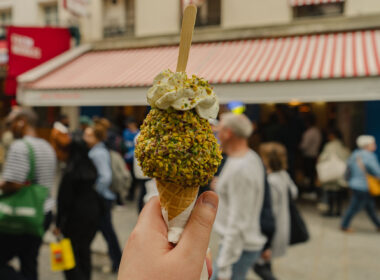
Where to Find the Best Ice Cream in Paris 2024
On the hunt for the best Ice Cream in Paris?
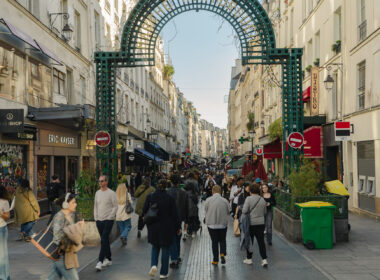
Guide to the Rue Montorgueil in Paris
The Rue Montorgueil in Paris (pronounced mon-tor-ghei) is bustling, authentic
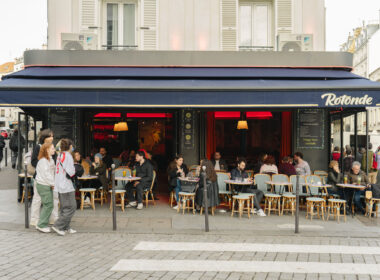
5 of the Best Bars in Bastille Paris
The Bastille area of Paris is, in my opinion, home to some of the best bars in
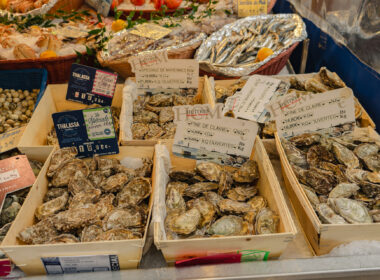
Where to Find the Best Oysters in Paris
If you’re looking for where to eat the best oysters in Paris then our guide has
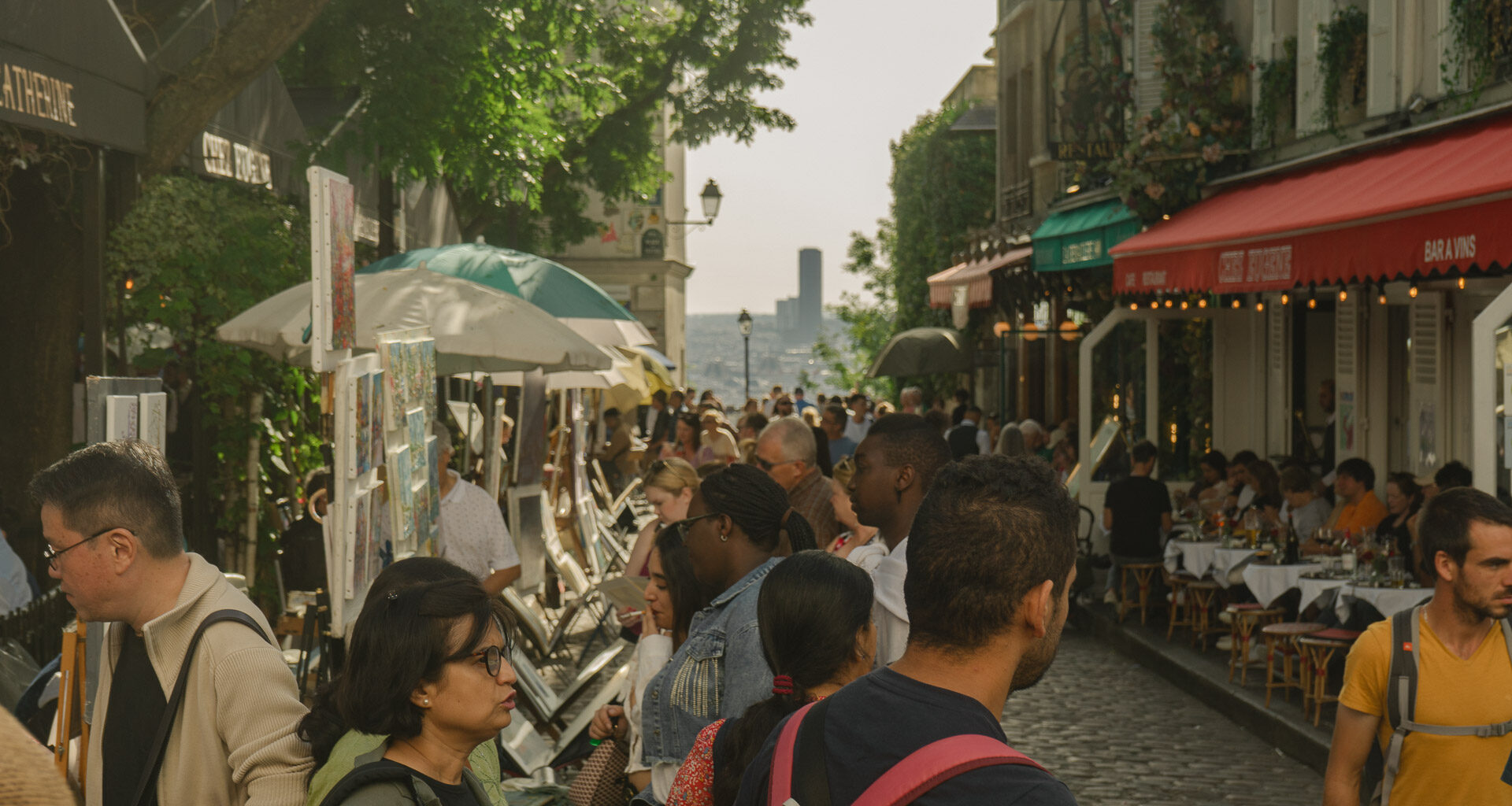
The Complete Guide to Montmartre Paris
If you’re visiting Paris then you’ll need to visit the wonderful Montmartre area of the city. Steeped in history, stunningly beautiful and with so much to see, it’s must-do during your trip to the city. From the famous white church (the Sacré-Cœur) to the Moulin Rouge, Montmartre is home to some of the city’s most iconic monuments and boy is it fun to explore.
Our guide is written by someone who actually lives in Paris and has done for the last 8 years. So read on to discover more about the incredible area of Montmartre!
Our guide is split into the following sections:
What is Montmartre and Where is it in Paris?
Practical information, what to do & see, where to eat & drink in montmartre, where to stay in montmartre, is montmartre paris safe at night, is it a good place to stay in paris, how to get there, montmartre wine festival.
Montmartre is an area in the 18th arrondissement, on the right bank and in the north of the city. It was once an ancient village outside of the city centre dating back to the 12th century where the Saint-Pierre church (which still stands today) was first founded by Louis VI. The old village survived the capital’s tumultuous years of change and finally became absorbed by the city in 1860.
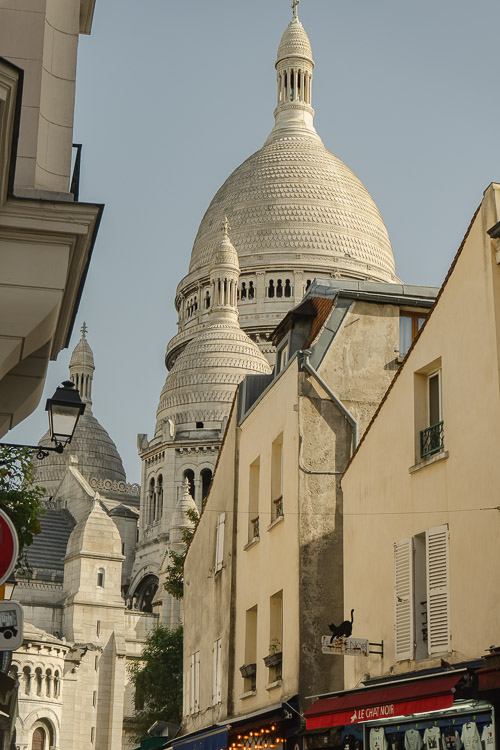
Nowadays Montmartre is known for its artistic side with Renoir and Picasso having lived and worked in the area. It’s also home to the famous white domed Sacré-Cœur basilica on the top of the hill which looks down to the rest of the city. The lower section of Montmartre, Pigalle, is known for its night-life and fantastic bars.
The area itself has been, on the whole, untouched by years of change and the area has retained it’s old Parisian charm. The old, cobbled streets are lovely to walk around in and take in the sights of the ancient area. For me, it’s definitely one of the must-do areas of the city!
I’d recommend visiting Montmartre by foot – it’s the only way to really explore the area.
It’s also an area of the city with few metro stations but there is the Montmartrobus which loops down from Pigalle, up past the Sacré-Cœur to the Clignancourt square and back again. It’s a very small electric bus (that isn’t disability friendly) that was made especially for the small, narrow streets of Montmartre.
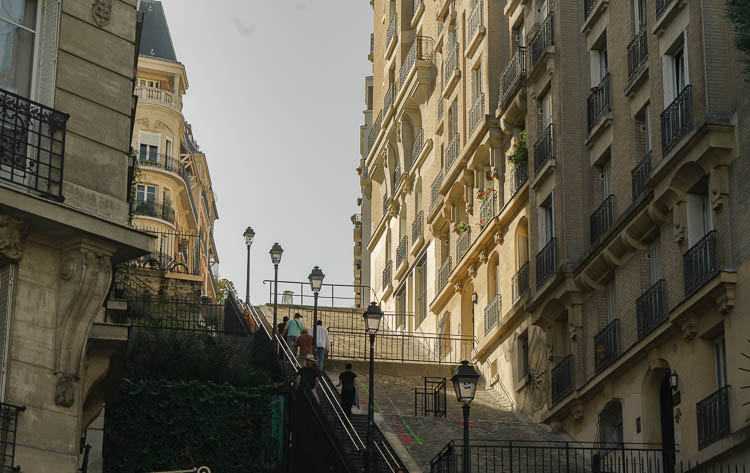
Note : The old village of Montmartre is on-top of a 128m high hill and getting by foot means climbing up many of the famous staircases of Montmartre. I’d advise to wear comfortable shoes and to bring a bottle of water!
Montmartre has so many things to see and do. It’s a charming old area of Paris which is perfect just to walk around and
Sacré-Cœur: The Sacré-Cœur Basilica is one of the most iconic monuments of Paris. Located right at the top of the hill, the white domed church is a must-visit. It’s free to enter the main church or you can pay to climb up to the top. The area infant of the church has uninterrupted views across the city.
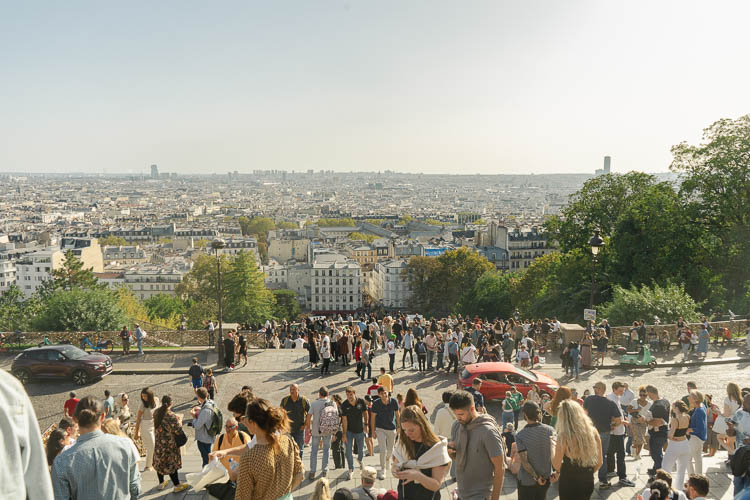
Place du Tertre: The Place du Tertre is the old central square of the ancient village. Here’s where you’ll find the famous artists of Montmartre painting portraits & caricatures. There’s a limited amount of artists and their spots are highly sought after – they work is even judged by professionals to ensure that they’re good enough to be there
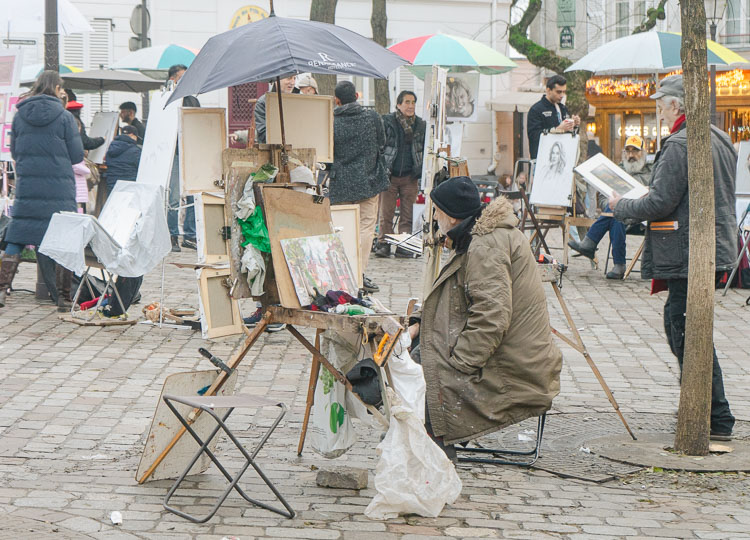
Wall of Love: The Wall of Love is a large wall contains the words ‘I love you’ 311 times in 250 languages. It’s located right next to the Abbessess metro station in Montmartre.
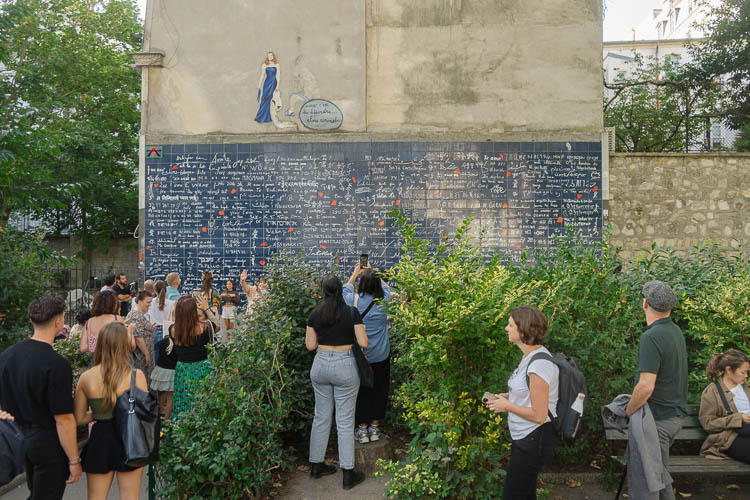
The Vineyard of Montmartre: A peculiarity of Montmartre is that is has the only vineyard in the city. On the smaller side, you unfortunately can’t go inside but you can walk around the outside. Located a stones throw from the Sacré-Cœur, it’s also next to the famous ‘pink restaurant’ and the Au Lapin Agile cabaret.
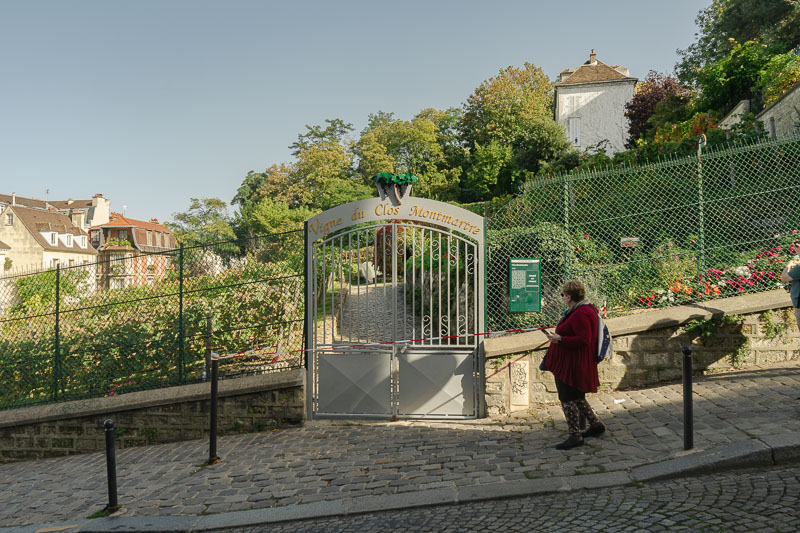
Check below to discover even more things to do in Montmartre:
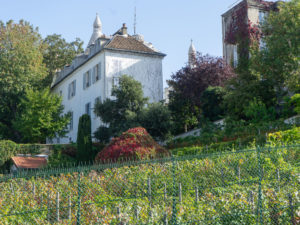
12 Amazing Things to See & Do in Montmartre in Paris
Tip: If you love food and want to do discover Montmartre in one evening then I’d recommend you go on an evening food tour in Montmartre – click to read our unbiased review. You can also book tickets here directly.
Montmartre is home to some fantastic restaurants but there’s also a lot of tourist traps (especially around and below the Sacre-Cœur!). I’d avoid going to any restaurants with English menus and photos of the food outside.
For really good French food in Montmartre I’d recommend Le Réciproque , Chantoiseau or, on the cheaper side, Bouillon Pigalle . Click below to read more about these restaurants:
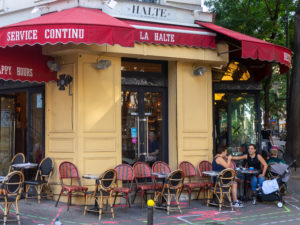
Guide to the Best Restaurants in Montmartre
Tip: Avoid eating in the famous Place du Tertre (the square next to the Sacre-Cœur. This square, although charming, is full of overpriced tourist traps that don’t serve particularly good food! (it is nice for a drink though)
If you’re wanting on the hunt for somewhere to drink in the area then you’re in luck, there are some of the best bars in the city in Montmartre! The majority are in the Pigalle area , on the footsteps of Montmartre. I’d recommend trying the Dirty Dick and Le Lipstick for some fantastic cocktails. Read more in our Best Bars in Montmartre guide below:
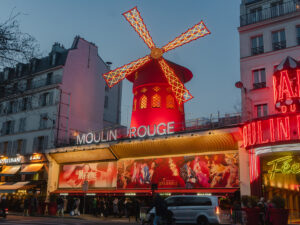
5 of the Best Bars in Montmartre
There are some fantastic hotels in Montmartre and we’ve picked 3 of our favourites.
- Terrass Hotel : This is a really nice 4* hotel located at the end of Rue des Abbesses. The hotel overlooks the incredible Montmartre Cemetery and also has a fantastic rooftop bar.
- Hôtel Des Arts : The Hôtel Des Arts is another beautiful 4* boutique hotel in the heart of Montmartre. The hotel’s in a stunning old Parisian building and they’ve kept the vintage Paris charm in their beautiful decor.
- Manolita: The Manolita is a 5* hotel which is perfectly located right next to the Moulin Rouge. Here you’ll be in the middle of the eclectic Pigalle neighbourhood which is perfect to explore Montmartre and the surrounding areas.
FAQ: Montmartre
Montmartre is generally a safe area but, just like the rest of the city, there are some spots you will want to careful in. The Pigalle area gets very lively at night and there can be some sketchy characters around. I’d advise to avoid the dimly lit areas and side streets.
Around the Sacré-Cœur and the Place du Tertre there will be some scammers so avoid individuals approaching you. Find out more on popular scams in Paris in our Is Paris Safe guide.
Yes! Montmartre generally has a very authentic Parisian feel despite the high density of tourists. It’s still very central and you can easily walk down the Seine and explore other areas of the city. I would say that, depending on where you’re staying, as it’s on a hill, you will be walking up and down a lot .
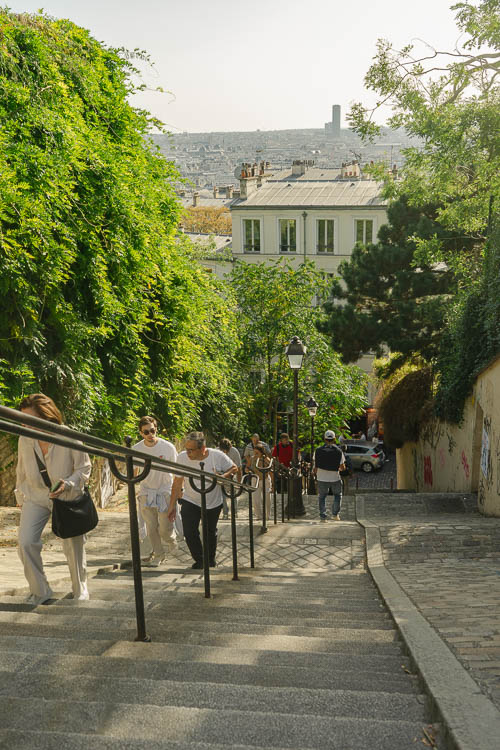
You can get to Montmartre by metro on Line 2 which serves the stations at the bottom of Montmartre ( Pigalle, Anvers and Blanche ). You can also skip a lot of the stair cases by taking Line 12 which goes to Abbesses – this is the most central metro station in Montmartre.
How to Get to Montmartre from the Eiffel Tower
Getting to the Montmartre from the Eiffel Tower isn’t the most straight forward and by public transport the quickest route takes around 40 minutes.
By Bus: The Bus 30 goes directly from the Eiffel Tower to Pigalle. It stops just opposite on the river side, on the Pont d’Iéna. Note that you’ll need to have a travel pass or you can buy a single one way ticket with cash. By Metro: You can take Line 6 from Bir-Hakeim and then change for Line 2 at Charles de Gaulle – Étoile . The walk to Bir-Hakeim takes around 10 minutes from the tower itself and then the metro ride takes around 20 minutes. You can get off either at Pigalle or Anvers and walk up.
Every year there’s a wine festival (the Fête des Vendanges de Montmartre ) which takes place in mid October. The festival celebrates the annual wine harvest from Montmartre’s vineyard and has become a huge event bringing in wine lovers from across the city. It’s on my favourite food and drink events in the year and it’s a must-do if you’re around in October! Click here to find out more about the festival.
Leave a Reply Cancel reply
Your email address will not be published. Required fields are marked *
Save my name, email, and website in this browser for the next time I comment.

Vibrant Green Chive Oil
This chive oil recipe is super easy and results in a vivid green oil that’s full

Sous Vide Confit Leeks with Soubise Sauce
This Sous Vide leek recipe is a great way to cook leeks to absolute perfection
Subscribe to Our Newsletter
Get notified on new recipe and Paris guides!
You May Also Like
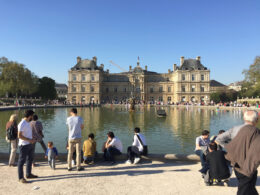
Guide to the Best Parks of Paris
If you’re coming to Paris then visiting the city’s parks is a must-do
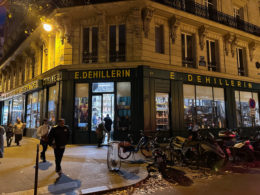
Where to Find the Best Kitchen Supply Stores in Paris
In Paris and want to check out Kitchen Supply Stores?
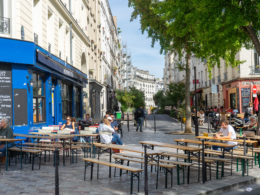
Guide to the Belleville Quarter of Paris (Tips from a Local)
Looking for more information on the vibrant Belleville area of Paris?

Street Food in Paris: The Insider Guide
Our insider guide to new, modern street food in Paris
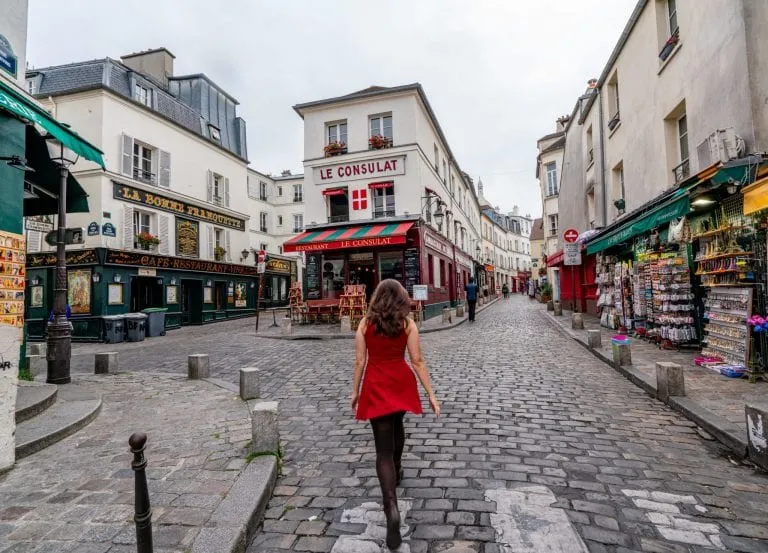
25+ Magical Things to Do in Montmartre, Paris (+ Map & Tips!)
Winding cobblestone lanes, artistic haunts, endless cafes, and historic cabarets, all topped off with a basilica that stands proudly on the highest hill in Paris: Montmartre has long captured the hearts of travelers, and with so many wonderful things to do in Montmartre, it’s not hard to see why!
Once the home of artists like Picasso, Renoir, Van Gogh, and Matisse–just to name a few–visiting Montmartre today provides plenty of glimpses into the neighborhood’s Belle Époque past.
While Montmartre, or Paris’ 18th arrondissement , is one of the most popular places to visit in Paris today, that doesn’t mean that it hasn’t retained its magic–you just have to know where (and when) to look.
We’ve had the chance to visit Montmartre many times, including basing ourselves in the neighborhood on two separate trips, most recently for a full week.
Here is exactly what to do in Montmartre, from iconic views to hidden gems, plus tips for making the most of your visit!
Table of Contents
Want to visit Montmartre the easy way?
The best things to do in montmartre, paris, fun things to do near montmartre, where to stay in montmartre, where is montmartre in paris (+ how to get there), tips for visiting paris’ montmartre neighborhood, self-guided montmartre walking tour itinerary, faq for visiting montmartre in paris, map of the best places to visit in montmartre.
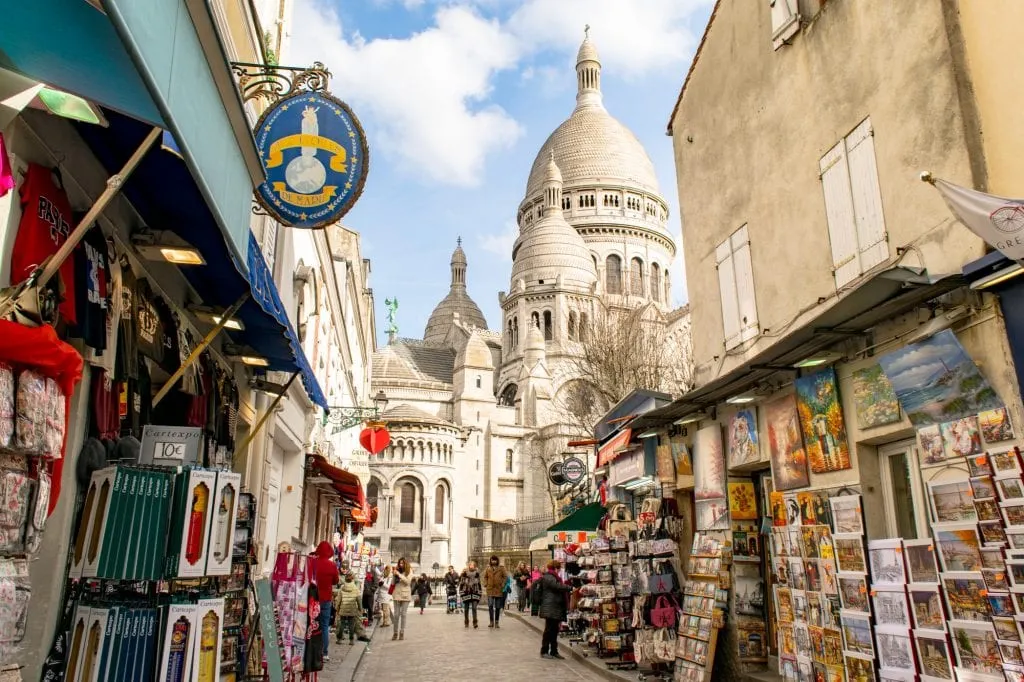
Some links in this post may be affiliate links. If you make a purchase through one of these links, we may earn a small commission at no extra cost to you. Please see our disclosure policy for more detail.
Only have a short time (say, half a day or less) to visit Montmartre and want to make the most of it?
This popular walking tour covers many of the most popular places to visit in Montmartre that we talk about in this travel guide ( this is an even shorter tour option that also gets great reviews).
Opting for a walking tour instead of exploring independently does come with a few trade-offs–one of the great joys of visiting Montmartre is wandering semi-aimlessly around the neighborhood–but it comes with big benefits, too.
A knowledgeable guide with colorful stories can bring Montmartre’s bohemian past to life in a vivid way that is difficult to replicate on your own.
(… Without doing a lot of reading about the history of Paris in advance, anyway–for example, did you know that for a brief time in 1871, Montmartre wasn’t even part of Paris?).
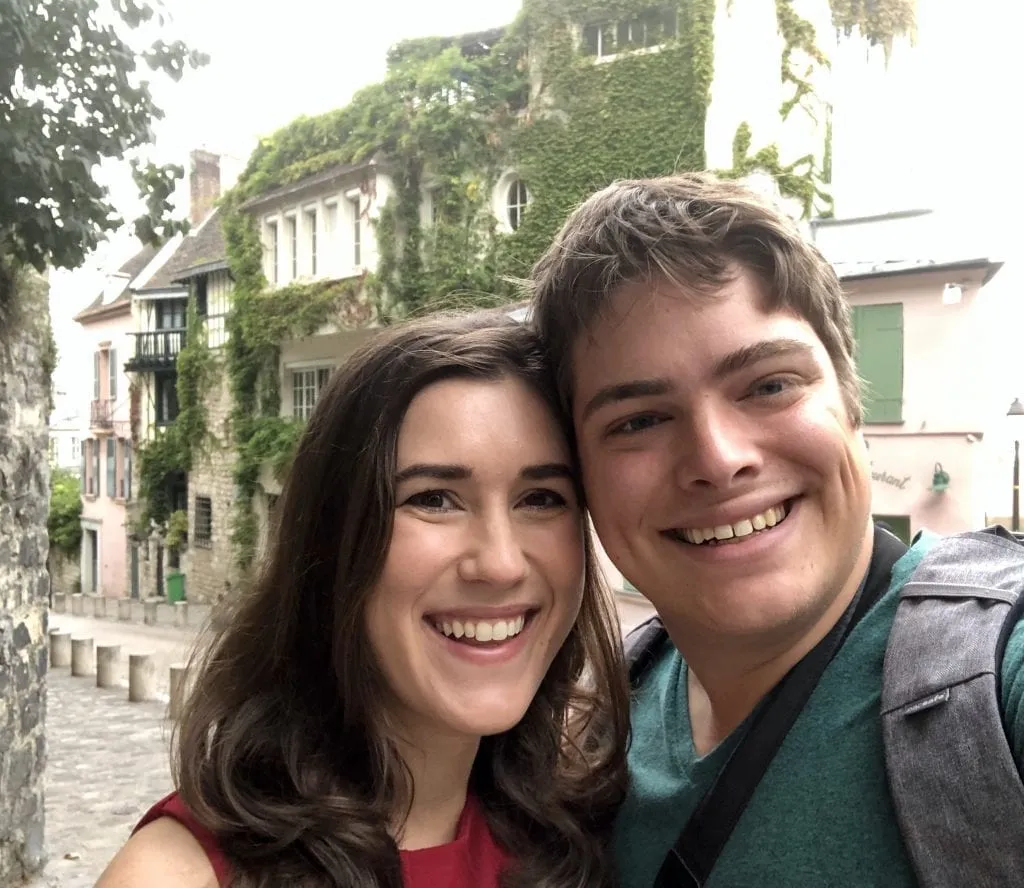
A walking tour also has the benefit of making sure you have a chance to enjoy Montmartre’s best angles without getting lost or climbing a few extra staircases in the process, which is easy to do.
If you do opt for a Montmartre walking tour, we recommend saving a little extra time before or after your tour to enjoy a drink at one of the neighborhood’s many outdoor cafes, and/or climb to the top of Sacré-Coeur, after your tour if at all possible.
Book your walking tour of Montmartre today!
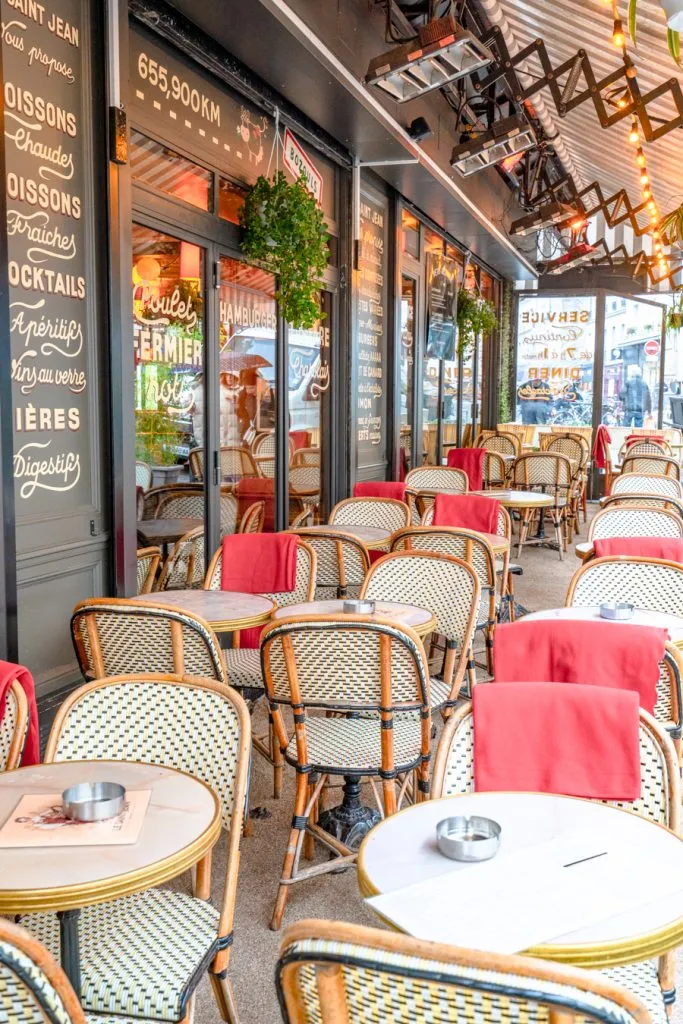

Step inside the incredible Sacré-Coeur Basilica.
Standing tall at the peak of the Montmartre butte and visible from many of the best viewpoints in Paris, Montmartre’s Sacré-Coeur Basilica is a must-see when in the neighborhood!
The basilica itself is free to enter, and its Romano-Byzantine interior, complete with marvelous mosaics that remind me of a more modern Ravenna , is worth admiring.
Sacré-Coeur is newer than you might think, too!
Construction started in 1875 and was declared completed in 1923, a clear reminder of how ever-changing the Montmartre neighborhood is.
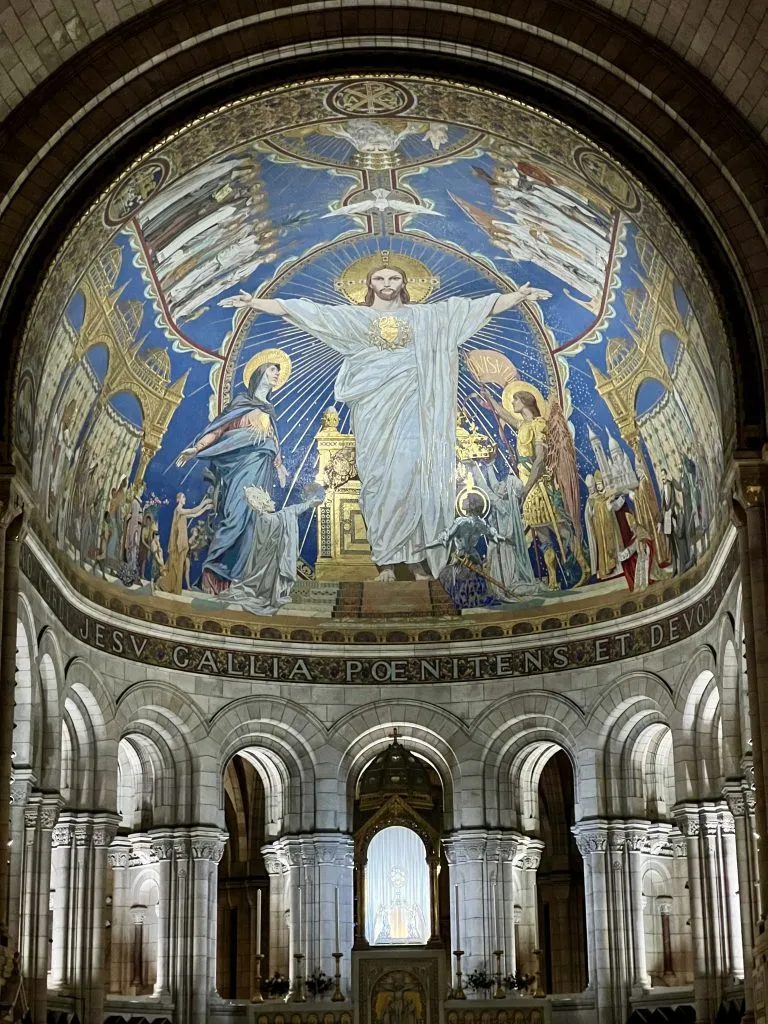
… and climb to the top to enjoy one of the absolute best views of Paris.
Climbing another 300 steps after already climbing all the way up to the base of Sacré-Coeur may feel a bit overwhelming (visiting Montmartre can be quite the workout), but it’s absolutely worth it!
While the view of Paris from the steps of the Sacré-Coeur is popular and lovely, the view from the top of the dome is stupendous .
The dome is open daily, but with different opening hours depending on the season.
You can check here for the current opening hours.
If at all possible, we recommend timing your visit to the dome for sunset, and be sure to leave yourself 15+ minutes to circle the dome (you can walk all the way around the edge of it) and enjoy the view!
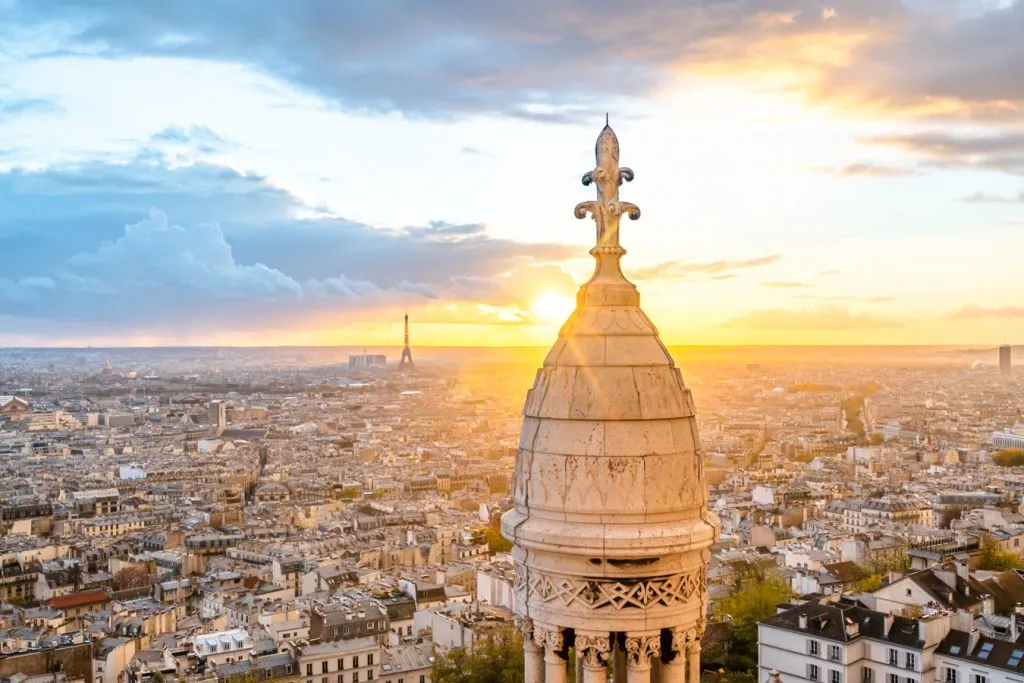
Admire Sacré-Coeur without the crowds at Square Marcel Bleustein Blanchet.
If you start circling Sacré-Coeur after enjoying views from the front, you’ll eventually come to the lovely Square Marcel Bleustein Blanchet, which is home to one of the loveliest views of the basilica!
This small park is located behind Sacré-Coeur, and thanks in large part to its location, is a delightfully uncrowded hidden gem in Montmartre.
From here, you can take a deep breath and enjoy gorgeous views without fighting for space or asking touts to leave you alone.
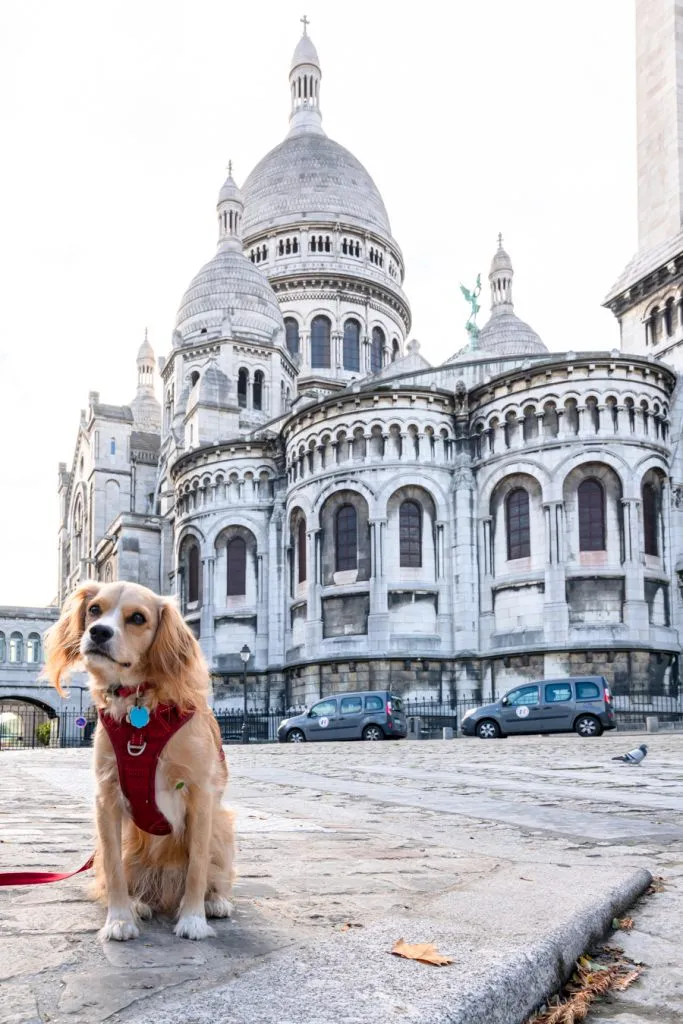
Enjoy the bustling, artistic atmosphere of the Place du Tertre.
Lined with picturesque cafes and covered with artists’ easels, the beautiful Place du Tertre is the heart of Montmartre’s artistic culture and has been for centuries.
If having your portrait drawn by a local artist is on your Montmartre bucket list, this is the place to do it!
The artists with easels set up in the Place du Tertre are licensed and regulated, and have to apply with the city to set up there–not just anyone can join.
For that reason, we recommend approaching a sitting artist if you’re interested in buying art here.
Roving artists who pitch their wares to you are not regulated, technically not allowed (though they always seem to be around), and much less likely to provide a product you’ll be satisfied with.
Regardless of whether or not you’re in the market for artwork, the atmosphere in the Place du Tertre is lovely and visiting is a great addition to a trip to Montmartre.
Don’t forget to turn back toward Sacré-Coeur for a view of the domes peeking up over the square!
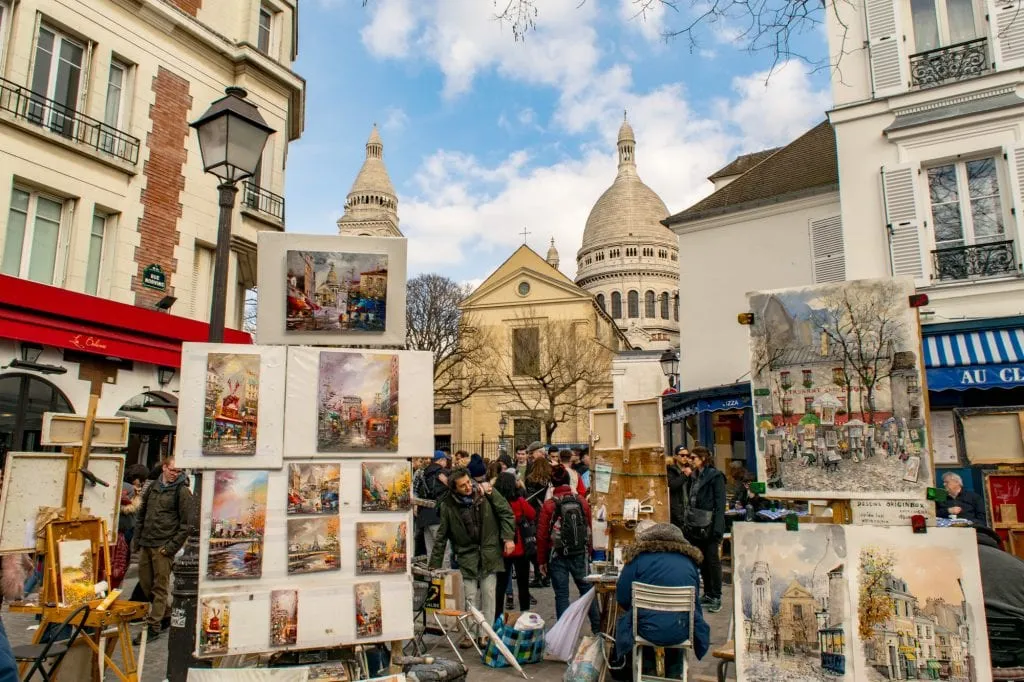
Watch the world go by at one of Montmartre’s many charming cafes or bistros.
Montmartre is positively covered in picturesque cafes and bistros, and sitting outside to enjoy a coffee and croissant in the mornings is a fabulous way to enjoy them.
Of course, given how popular visiting Montmartre is, many of the cafes and bistros have mediocre food, high prices, or both–but you can usually find somewhere worth enjoying.
The famous spots of Le Consulat (where you can drink at the same cafe Picasso and Monet once enjoyed, Le Refuge, and Le Vrai Paris all get solid, if not raving, reviews.
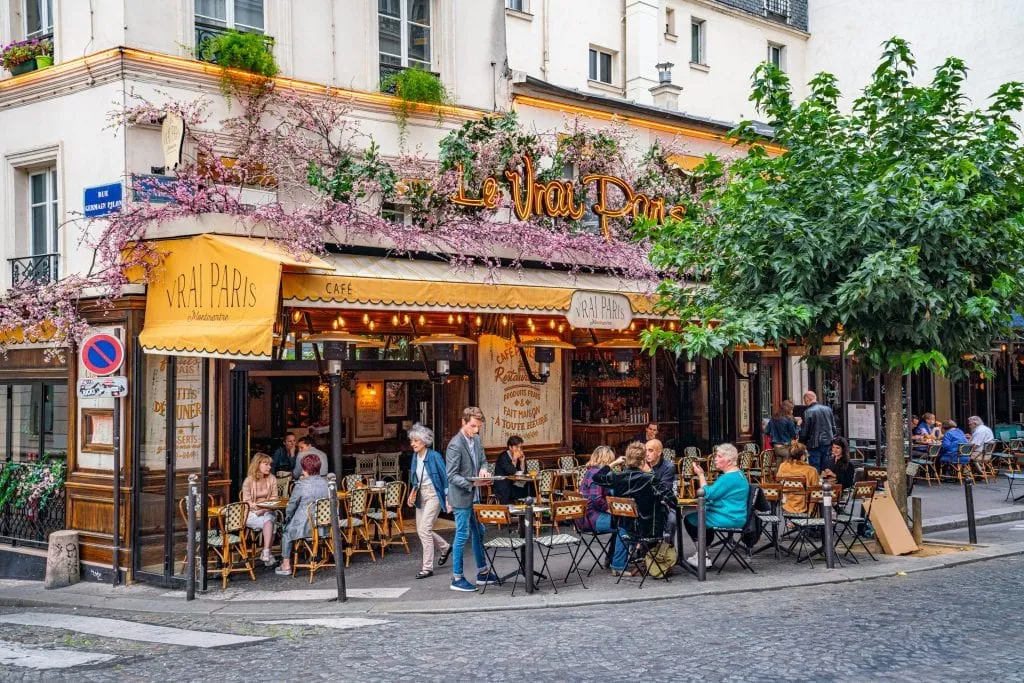
Café des Deux Moulins , which was featured in the movie Amélie , doesn’t get as good of reviews, but visitors hoping to enjoy the nostalgia seem to enjoy it.
We have also enjoyed a morning café at Le Bimbo , and Porto-Paris (Portuguese rather than French, but good).
And, while you can’t sit down there, I can’t talk about breakfast in Montmartre without mentioning Pain Pain , a former winner of the best baguette in Paris award and a must-taste when visiting Montmartre!
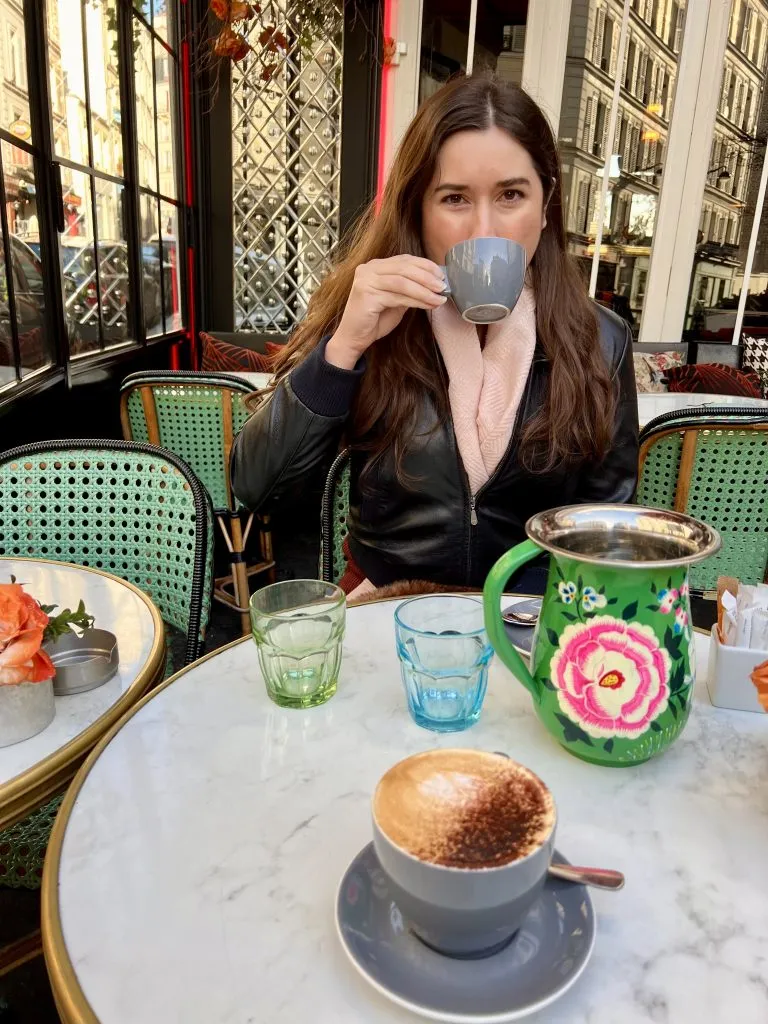
Stroll down the beautiful Rue de l’Abreuvoir.
Sandwiched between La Maison Rose at the top and Place Dalida at the bottom, the short street of Rue de l’Abreuvoir is one of the prettiest streets in Montmartre, and quite possibly one of the prettiest streets in all of Paris!
And, it’s without a doubt one of the 18th’s most famous photography spots.
As you walk down the street, be sure to turn back regularly to look behind you!
Like many of the most beautiful places in Montmartre, the domes of Sacré-Coeur will start peeking out over the top of the hill as you descend.
While not particularly busy, this is still an active driving street, so keep an eye out for cars as you explore!
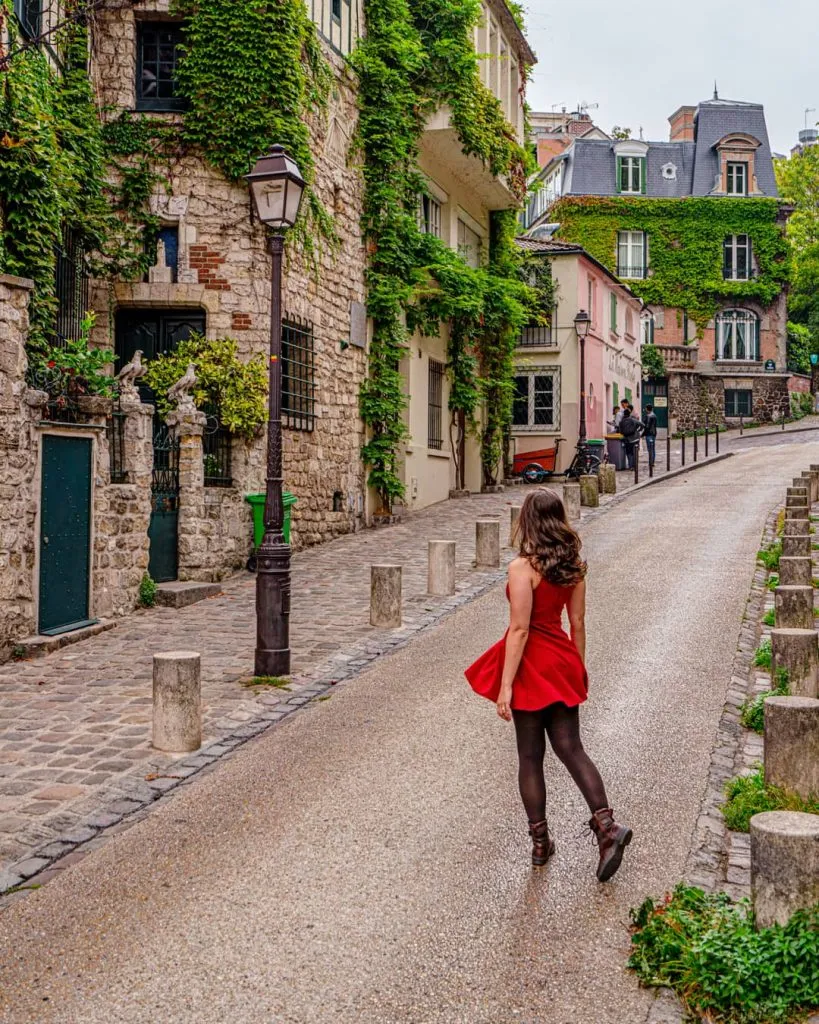
… and pause at the bottom to enjoy Place Dalida.
Shady and peaceful Place Dalida is situated at one end of Rue de l’Abreuvoir and features beautiful views of the picturesque street framed with the white domes of Sacré-Coeur.
It’s also home to a bust celebrating–who else–the famous French singer Dalida, who was known for performing in more than 10 languages.
Legend says that touching Dalida’s bust is good luck–and based on the discoloration, it’s easy to see that many people visiting Montmartre have given it a chance to work.
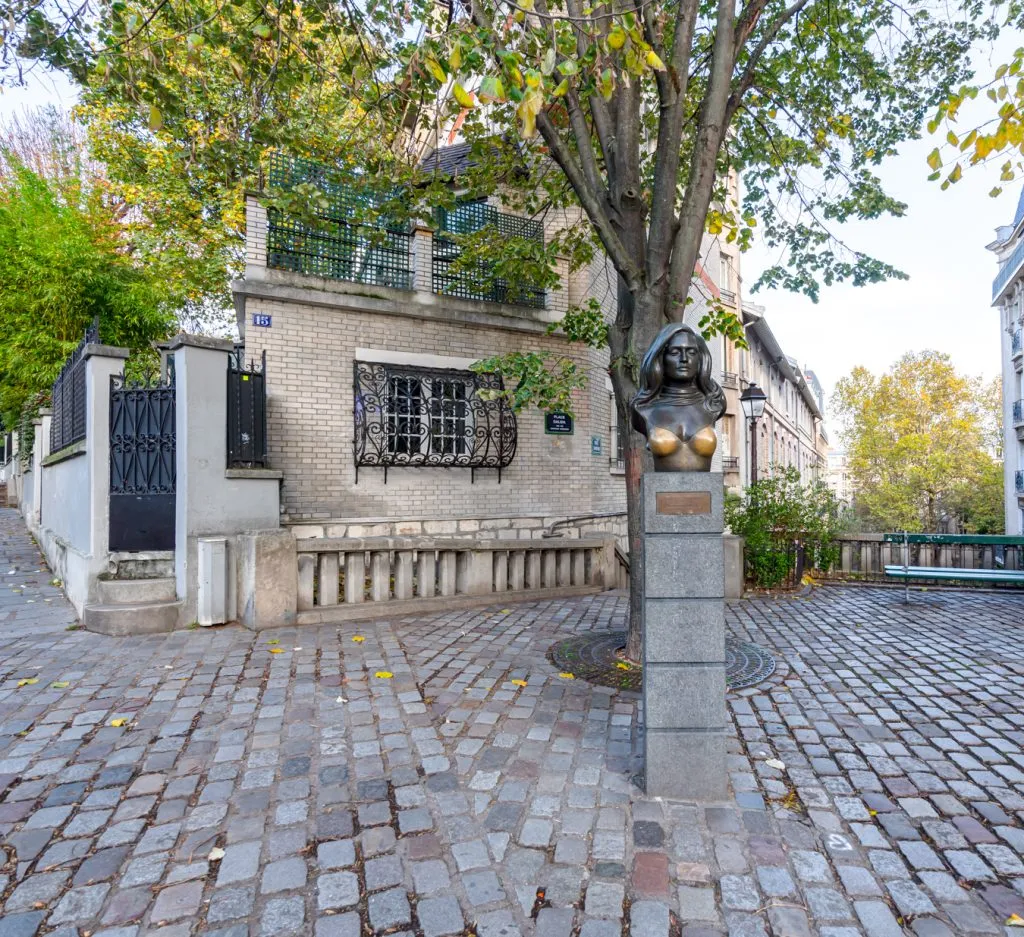
Explore the Montmartre Museum.
Generally speaking, Montmartre is less of a museum-hopping neighborhood and more of a place to soak up the atmosphere–but it’s worth making an exception for the Musée de Montmartre .
Housed in the former home of Auguste Renoir, the Montmartre Museum explores the history of the neighborhood.
Most of the attention is focused, of course, on Montmartre’s heyday starting in the 19th century, with exhibits on the building of Sacré-Coeur, the iconic shadow theatre of the original Chat Noir, a recreated apartment of Suzanne Valadon, and much more.
We thoroughly enjoyed the museum and the attached Renoir Gardens.
The gardens are also home to the best accessible view of Le Clos Montmartre, one of the only remaining vineyards in Paris!
Buy tickets to visit the Montmartre Museum today!
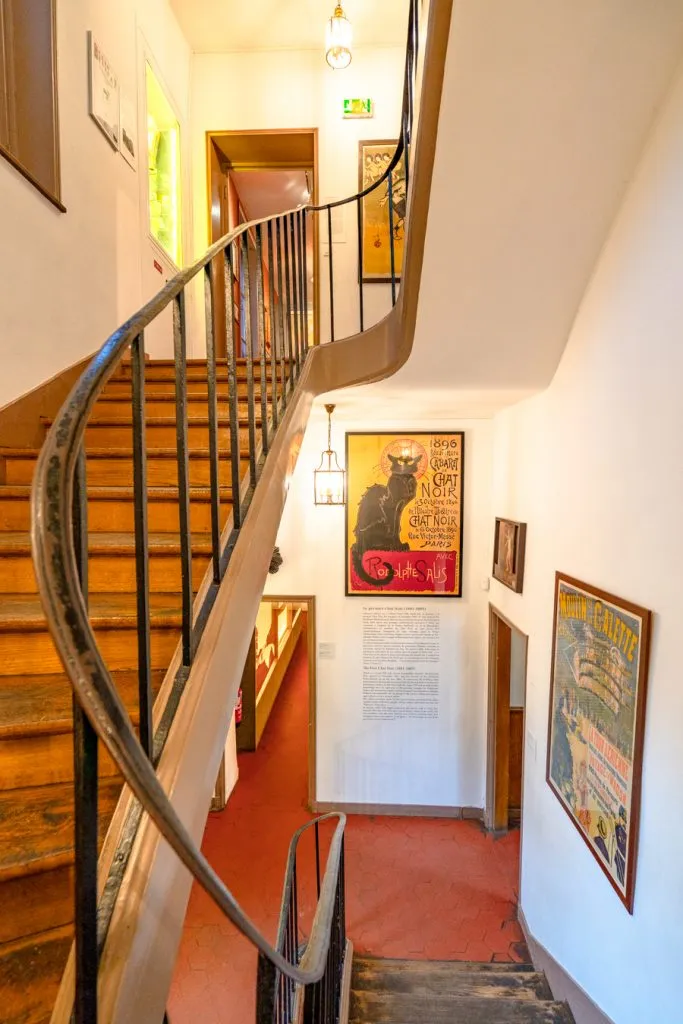
Admire the vines of Le Clos Montmartre (from outside the gate).
In a city as modern and busy as Paris, finding a small vineyard nestled amongst the buildings is an absolute treat!
And, what better home could there be for a quirky urban winery than Montmartre village, which already feels worlds apart from much of the city?
Unfortunately, Le Clos Montmartre isn’t generally open to the public, but that doesn’t stop travelers from eagerly peering through their front gate on Rue des Saules (it helps that the gate is just around the corner from La Maison Rose).
The best view of the vineyard, where I took the below photo, is from the Montmartre Museum’s gardens, but you’ll need to purchase a ticket to the gardens to access it.
Garden access is included with a museum ticket , or you can purchase only access to the gardens separately.
Le Clos Montmartre only produces a small amount of wine–1000 bottles a year or less–but if you’d like to try it, you can find it for sale around Montmartre (including in the Montmartre Museum gift shop).
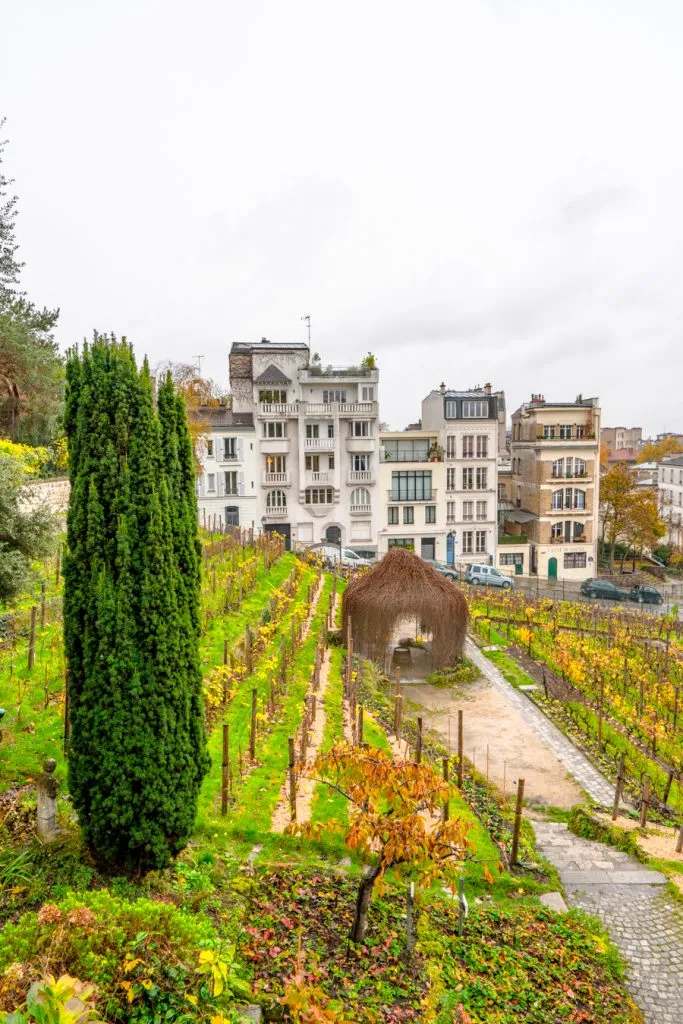
See the best of Montmartre’s cuisine on a food tour.
Want to sample delicious Parisian food while exploring Montmartre on foot with an excellent guide?
Consider booking a Montmartre food tour with Devour Tours!
Devour Tours is one of our favorite food tour companies in Europe (they’re also associated with Take Walks , another favorite of ours).
We loved this Paris food tour we booked with them, among several others!
Their Montmartre food tour offers an incredible combination of excellent food and memorable stories about the history and culture of the 18th arrondissement.
Book your Montmartre food tour today!
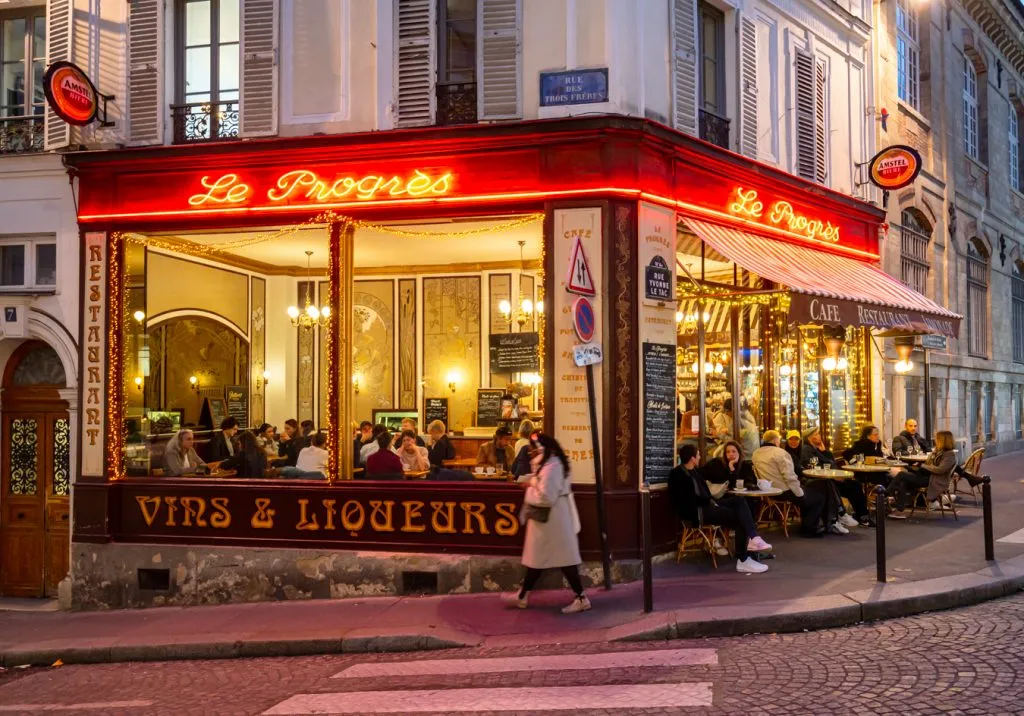
Visit the famous La Maison Rose.
Originally opened in 1908, the beautiful pink facade of La Maison Rose has been a staple of Montmartre for generations.
While it has gone through a handful of closures, reopens, and ownership changes over the years, its iconic pink facade dates all the way back to the original.
Staples of Montmartre, such as Albert Camus and Dalida, were once clients, and today, La Maison Rose remains a functioning restaurant (we highly recommend making reservations if you want to eat there).
Most visitors, though, no doubt come merely to admire the exterior.
The facade has been slightly updated in the few years since I took the below photo–“La Maison Rose” is now printed in a more modern, blocky green style.
I have to admit I’m still extremely partial to the script version, so opted to preserve my favorite version in this Montmartre blog post.
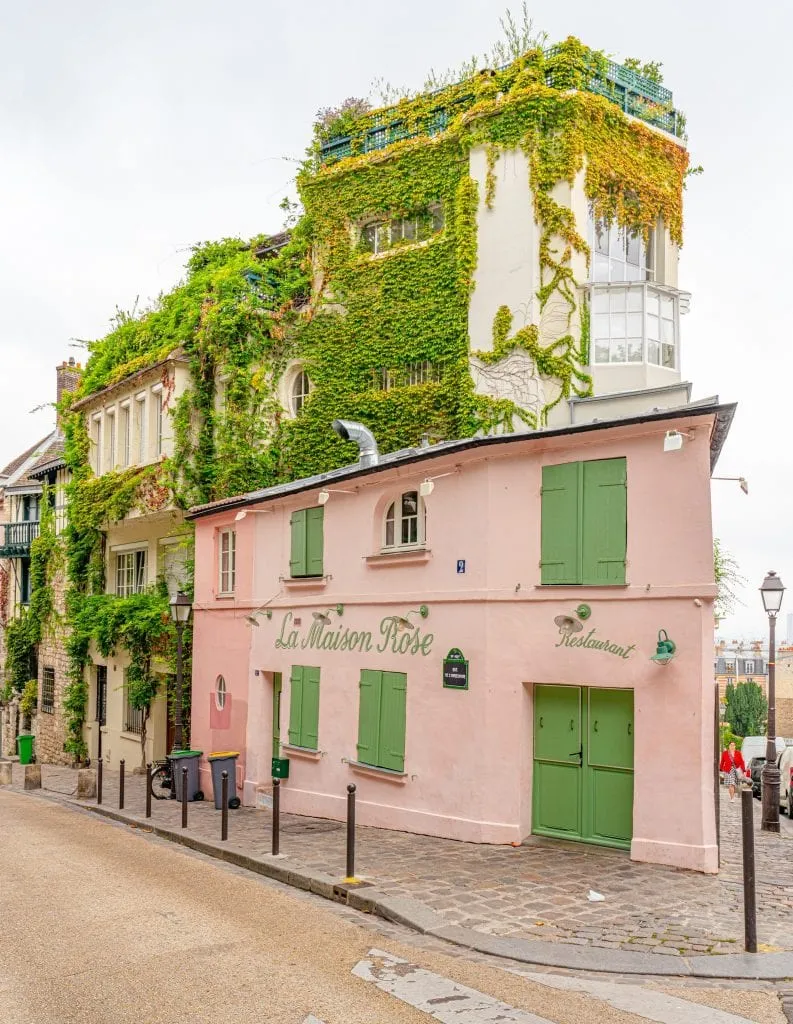
Enjoy the Place Saint-Pierre (and its carousel).
Tiny Place Saint-Pierre is one of the most recognizable places to visit in Montmartre, but you may have never heard its official name before–because Place Saint-Pierre is much better known for what sits inside it.
Home to the Montmartre carousel (technically named the Carrousel de Saint-Pierre , but generally referred to as the Montmartre carousel), the Place Saint-Pierre sits below Sacré-Coeur.
Rides are short but inexpensive, and popular with kids visiting Montmartre!
The carousel may be even more popular with photographers, though: the ability to capture the Sacré-Coeur and a historic Parisian carousel in one image is a delight.
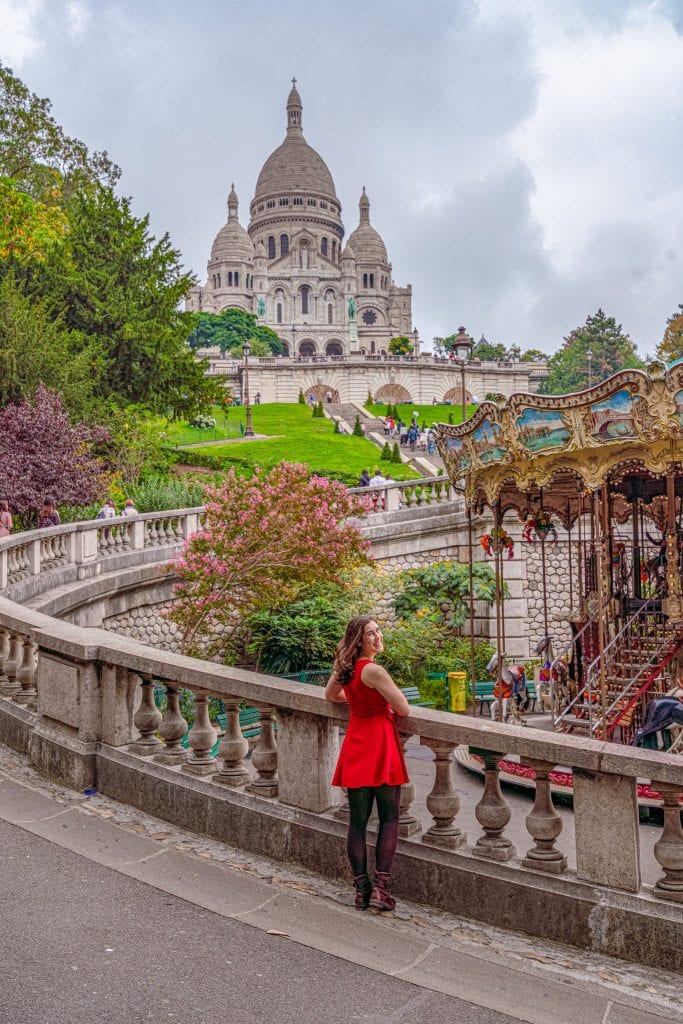
Find Montmartre’s remaining windmills.
Once upon a time, Montmartre was known for its many windmills.
Today, only a handful remain–including, Moulin Radet, the windmill that overlooks the restaurant La Moulin de la Galette .
There’s also a windmill named Moulin Blute-Fin, which is on private land but you can spot from the street.
Collectively, these two windmills are known as Moulin de la Galette, and they have been featured in paintings by Van Gogh, Renoir, and many more.
Meanwhile, the iconic windmill on top of the Moulin Rouge, while not technically in Montmarte, is near-synonymous with the neighborhood.
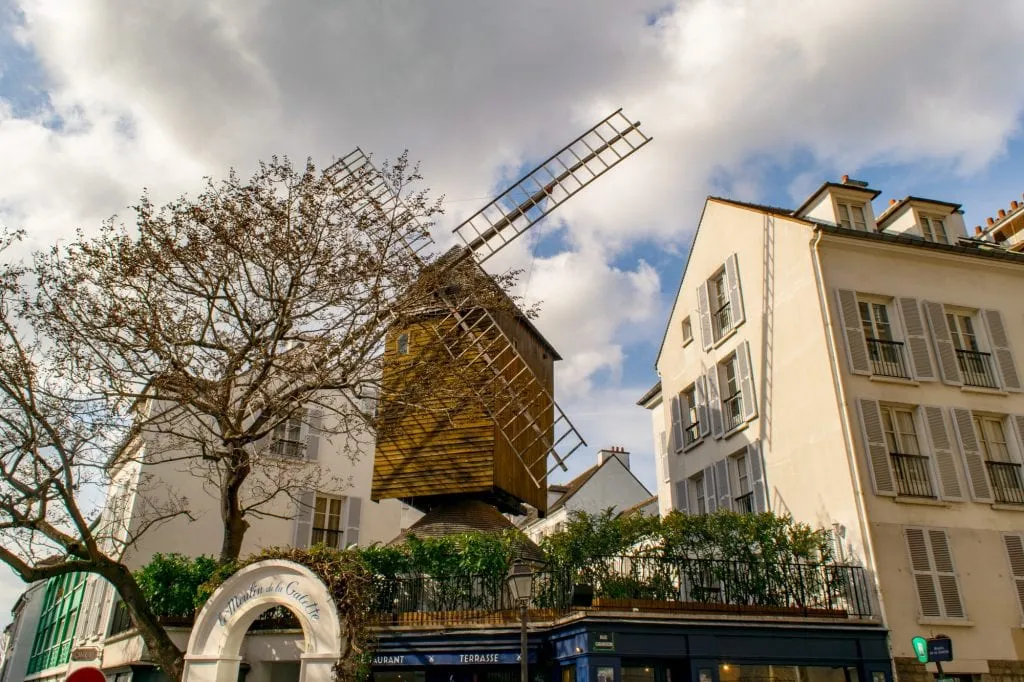
… and the quirky statue of Le Passe-Muraille .
The bronze statue of Le Passe-Muraille (or “Passer Through Walls”) is one of the quirkiest attractions in Montmartre, and only takes a minute to see!
Depicting a man stuck inside a wall as he attempts to walk through, Le Passe-Muraille is actually a statue of a specific character from the French novel Le Passe-Muraille .
The character, and therefore his statue, met his unfortunate fate of being permanently stuck in a wall after using magical powers for immoral purposes.
You don’t need to have read or even be familiar with the book, though, in order to appreciate this unusual art piece that feels right at home in the 18th arrondissement .
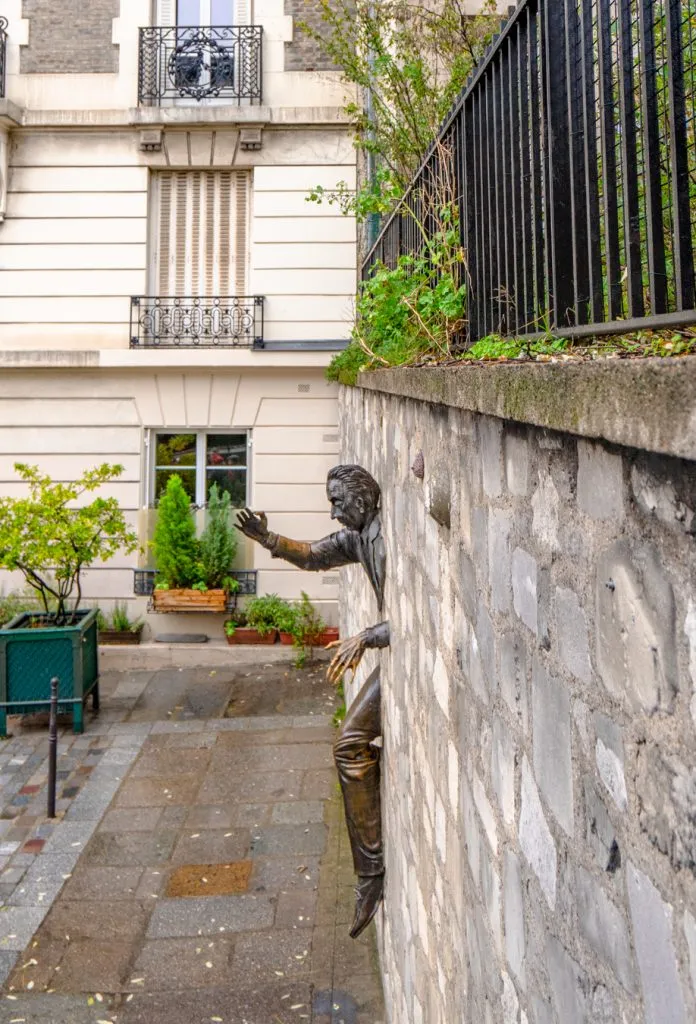
Spend some time relaxing on the Sacré-Coeur steps that overlook Louise Michel Park.
Enjoying the view of Paris from the steps leading to the Sacré-Coeur is one of the most popular things to do in Montmartre, especially at sunset!
Regardless of what time you visit, though, it’s worth stopping to rest and enjoy the view (especially if you just climbed the roughly 270 steps it takes to reach the Sacré-Coeur from Place-Saint Pierre).
However, be cautious: the combination of the viewpoint being popular and free to access means that pickpockets and scammers are rife here.
That’s not a reason to stay away, but it’s definitely a reason to be extra cautious with your belongings.
We have enjoyed several stunning Paris sunsets from this spot, and hope to see many more in the future!
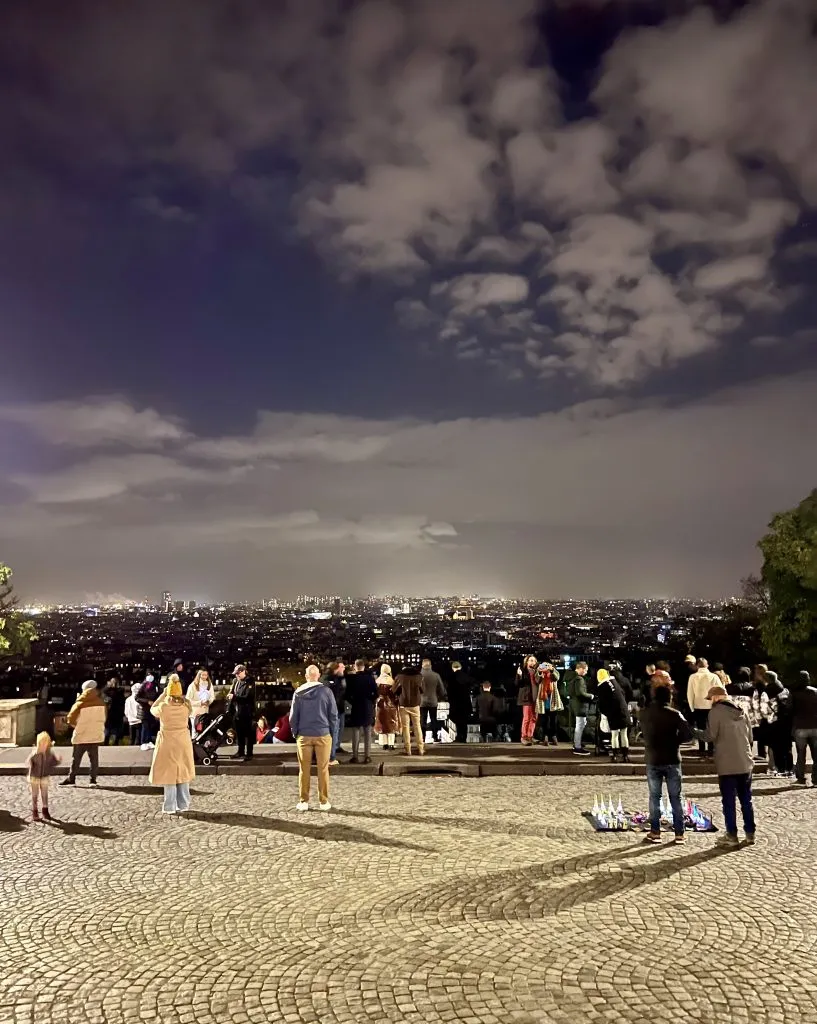
… and don’t miss seeing the Sinking House of Montmartre while you’re there!
The Sinking House of Montmartre is one of Paris’ most beloved optical illusions, and it’s very easy to find during a Montmartre visit!
If you’re standing amongst the crowd on the steps of the Sacré-Coeur, face the basilica and then turn to your right.
You’ll see a red building jutting out in the distance, beyond the lawn.
Turn your camera ( this is our beloved camera , though we shot the below photo years ago on this one ) so that the lawn is straight.
Voilà –suddenly the red building is “sinking”!
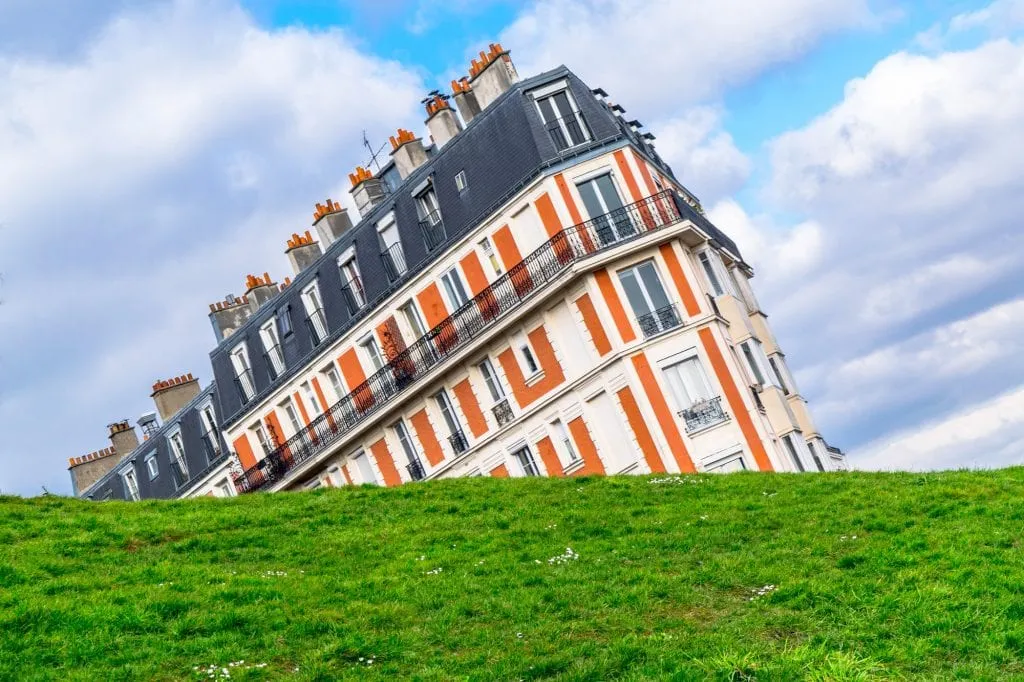
Seek out “secret” Eiffel Tower views from Montmartre.
Meander along the top of the Montmartre butte long enough, and you’ll come across some pretty spectacular views of Paris that you won’t find on any map or in any guidebook.
Often visible in only a small sliver when peering through buildings or trees, these views are all the more rewarding for how surprising it often feels to stumble across one (and many of them even overlook the Eiffel Tower).
Here’s one spot to get you started: navigate to the restaurant Chez Plumeau, located just around the corner from the Place du Tertre.
Start at the top of the staircase, and then meander along the edge of the wall, and you’ll find plenty of gorgeous Eiffel Tower views!
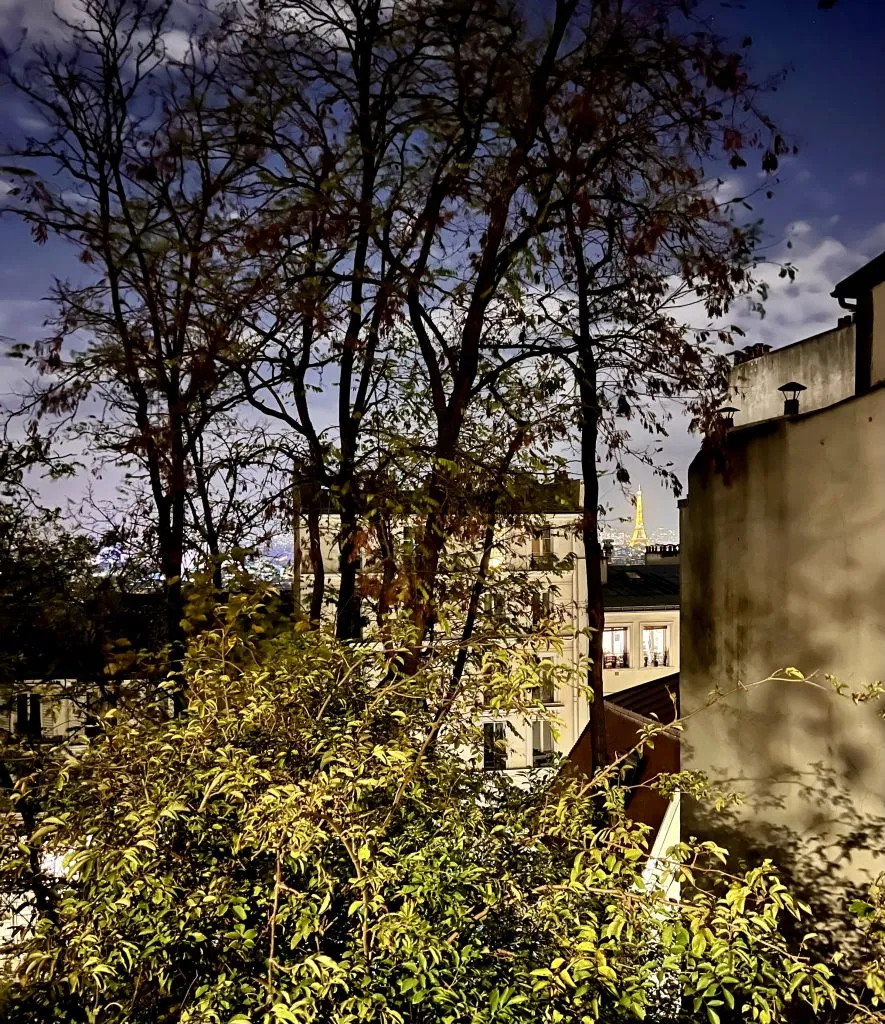
Duck inside the second-oldest church in Paris.
Situated right between Sacré-Coeur and Place du Tertre, you might suspect that the second-oldest church in Paris would be crowded with visitors–but this is actually one of the many hidden gems of Montmartre that are tucked away in plain sight.
Construction of the Church of St. Pierre de Montmartre began in 1133, though it is believed that a church has stood on this site since the 3rd century.
Home to the Montmartre Abbey before the French Revolution, St. Pierre de Montmartre has a long history in the 18th arrondissement –significantly longer than the more-famous Sacré-Coeur.
The interior is fairly simple, with featured stained glass and lots of stone, but lovely and worth a quick peek inside (it’s free to visit).
St. Pierre de Montmartre is also home to the Calvaire Cemetery, which you should definitely visit if you get the rare opportunity.
It’s only open one day a year, on All Saint’s Day (November 1)!
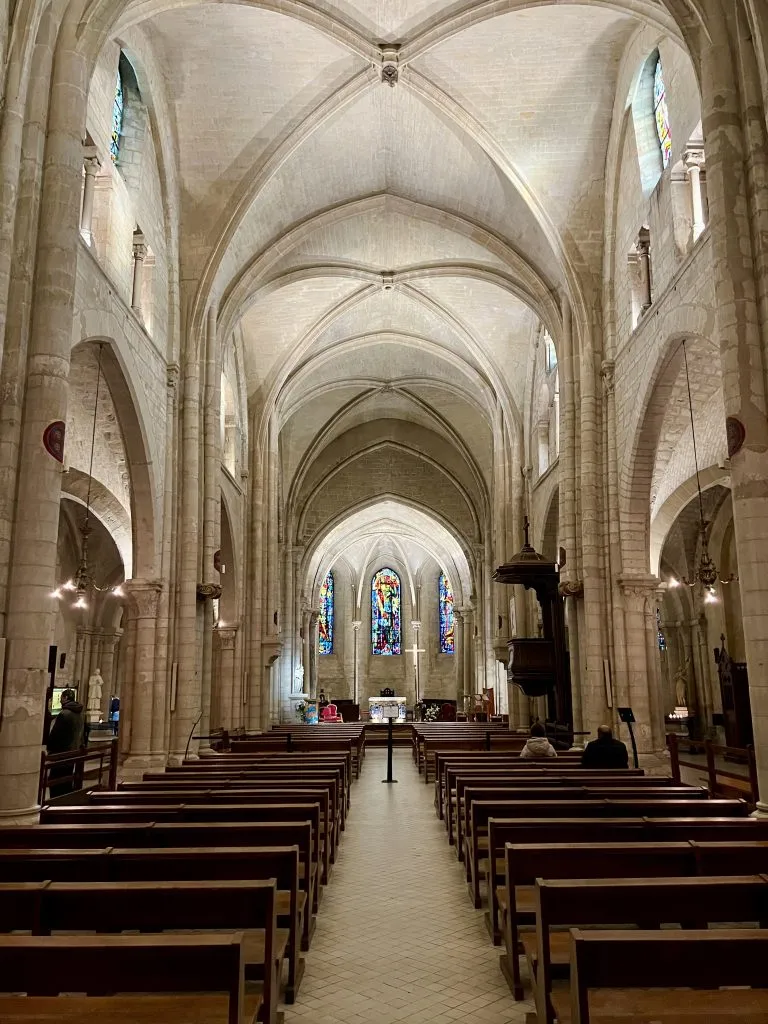
Enjoy a world-famous cabaret beloved by Picasso at Cabaret Au Lapin Agile.
Dating to 1860 and the inspiration behind a Picasso painting of the same, Cabaret Au Lapin Agile bills itself as Paris’ oldest cabaret.
Situated in the heart of Montmartre (along Rue des Saules), and once the haunt of many of Montmartre’s most famous residents, the party is still going like it’s the Belle Époque every night in Au Lapin Agile.
Today’s version is touristy, yes–but still lots of fun.
Be sure to make reservations in advance if you want to spend an evening in Montmartre tucked inside this lively spot.
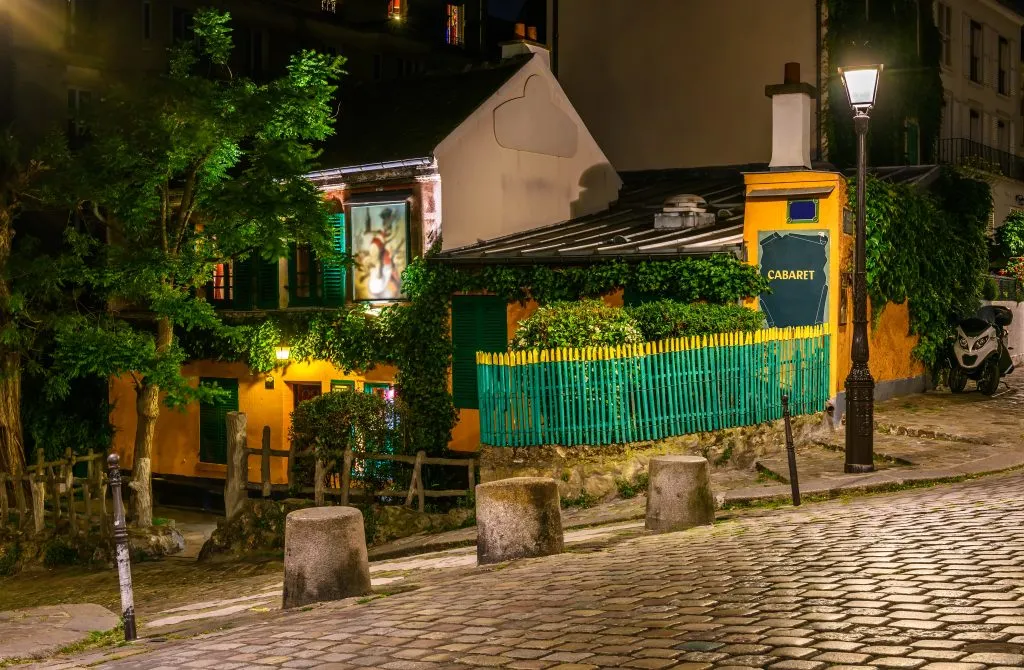
Snap a selfie with someone you love at the “I love you” wall.
Located in Square Jehan-Rictus, just a few steps from the Abbesses metro stop, you’ll find one of the most beloved Montmartre photo spots!
The dark blue Wall of Love is adorned with the phrase “I love you” in more than 300 languages, making it the perfect place to visit with one of your favorite people.

Stroll along some of Montmartre’s most picturesque streets.
Montmartre is made for wandering, and one of the absolute best things to do in Montmartre is to turn down random streets and find your favorites.
A few of the prettiest streets in Montmartre include the famous Rue de l’Abreuvoir, the winding Rue Lepic, and Rue Abbesses.
Rue des Saules is well worth a stroll as well, as are Rue Andre Antoine and Rue Lamarck.
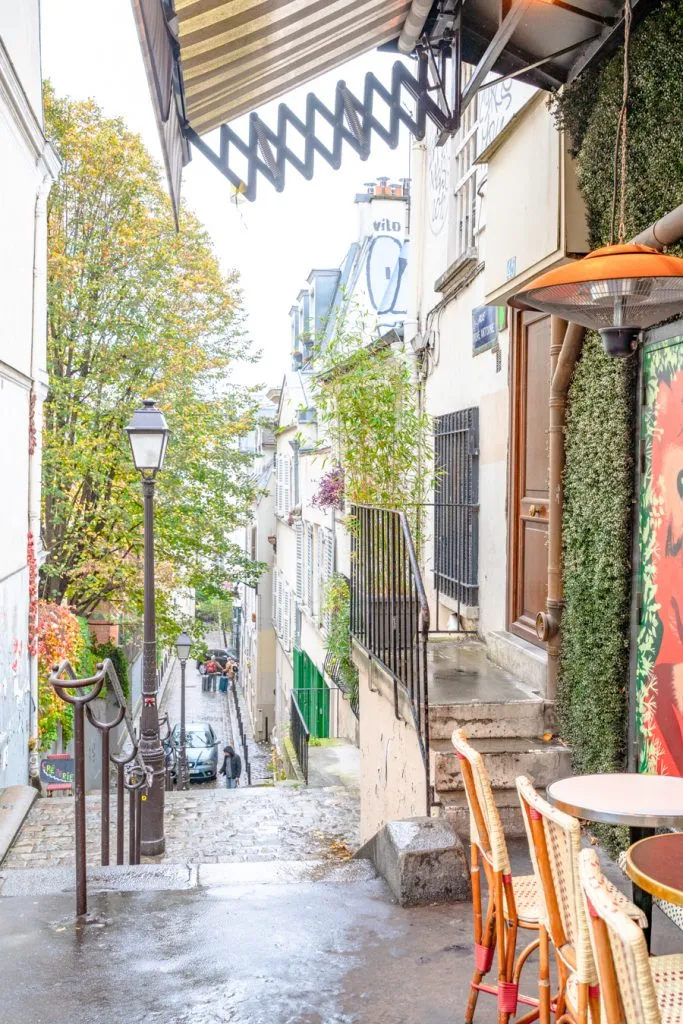
Pay a visit to the Montmartre Cemetery.
As the largest cemetery in Montmartre and the third-largest cemetery in Paris, the Montmartre Cemetery (technically named Cimetière du Nord ) is the final resting place of many of the 18th arrondissement’s most famous residents!
Located in a former quarry, strolling through the Montmartre Cemetery definitely gives the impression that you’re wandering beneath the ground (though it is all open air–just sunken).
Alexandre Dumas, Dalida herself, and many more were laid to rest here.
The Montmartre Cemetery is free to visit and an easy addition to most Montmartre itineraries.
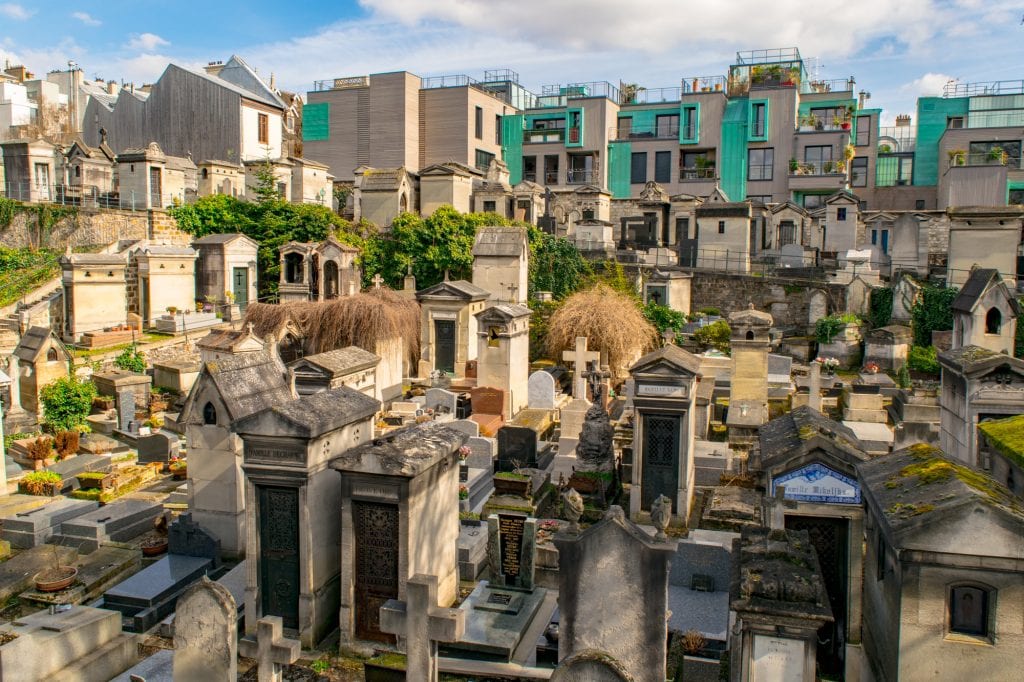
Seek out Amélie filming locations.
The popular French movie Amélie just may be the most beloved piece of cinema that has ever been filmed in Montmartre!
As a result, visiting Amélie filming locations is popular in Montmartre (and if you don’t know what I’m talking about, watching the movie before visiting will definitely inspire you to visit Montmartre)!
Café des Deux Moulins and Au Marché de la Butte (which played the Maison Collignon grocery store) are 2 of the most popular spots to visit that won’t necessarily already be on your Montmartre bucket list.
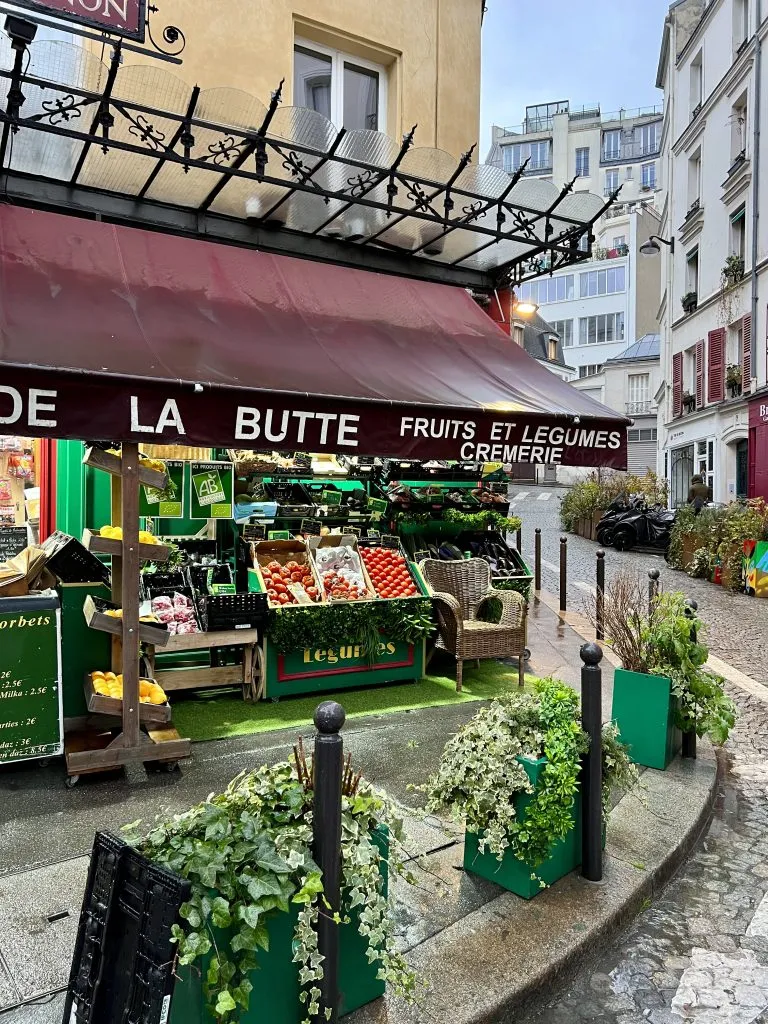
Wander through the St. Vincent Cemetery.
The final resting place of many of Montmartre’s former poets, artists, actors, and more, the peaceful St. Vincent Cemetery is a smaller and quieter alternative to visiting the larger Montmartre Cemetery.
Free to visit and home to notable Parisians like Maurice Utrillo, Léontine Aubart, and more, the cemetery also has a view of the rooftop of the famous Au Lapin Agile Cabaret.
There are also free public toilets located inside the cemetery, a nice perk for travelers who have been pounding the pavement on a self-guided Montmartre walking tour.
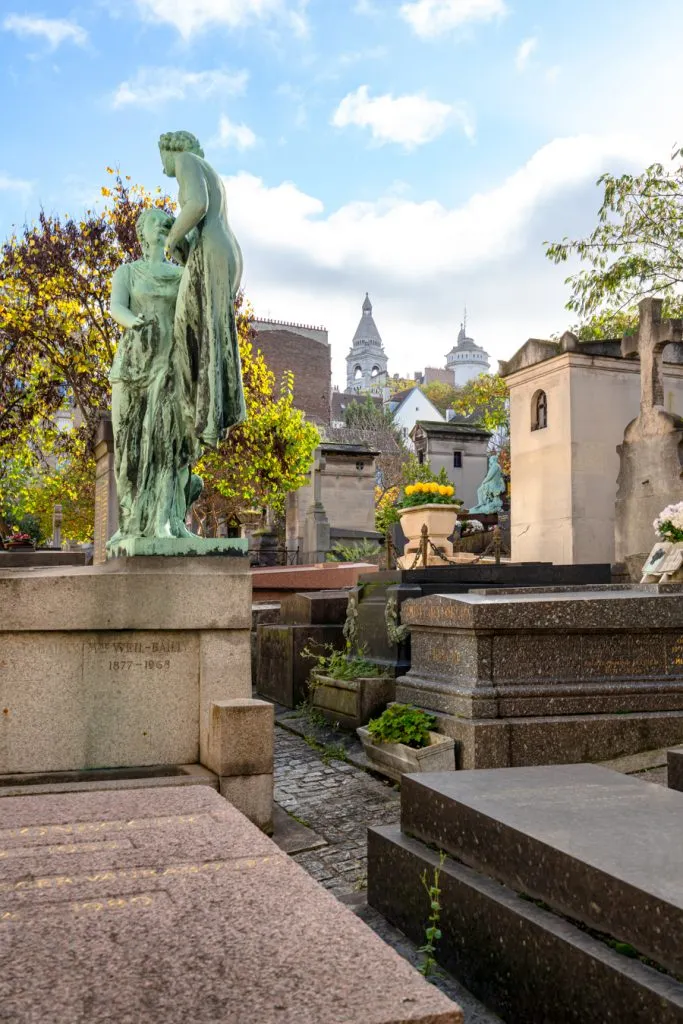
Explore the Espace Dalí Museum.
Dedicated to the one and only Salvador Dalí, the Dalí Museum features over 300 works by the prolific artist.
Originally amassed as a private collection, Espace Dalí was completely redone in 2018.
If your taste in art leans more toward the contemporary, this is the place in Montmartre for you!
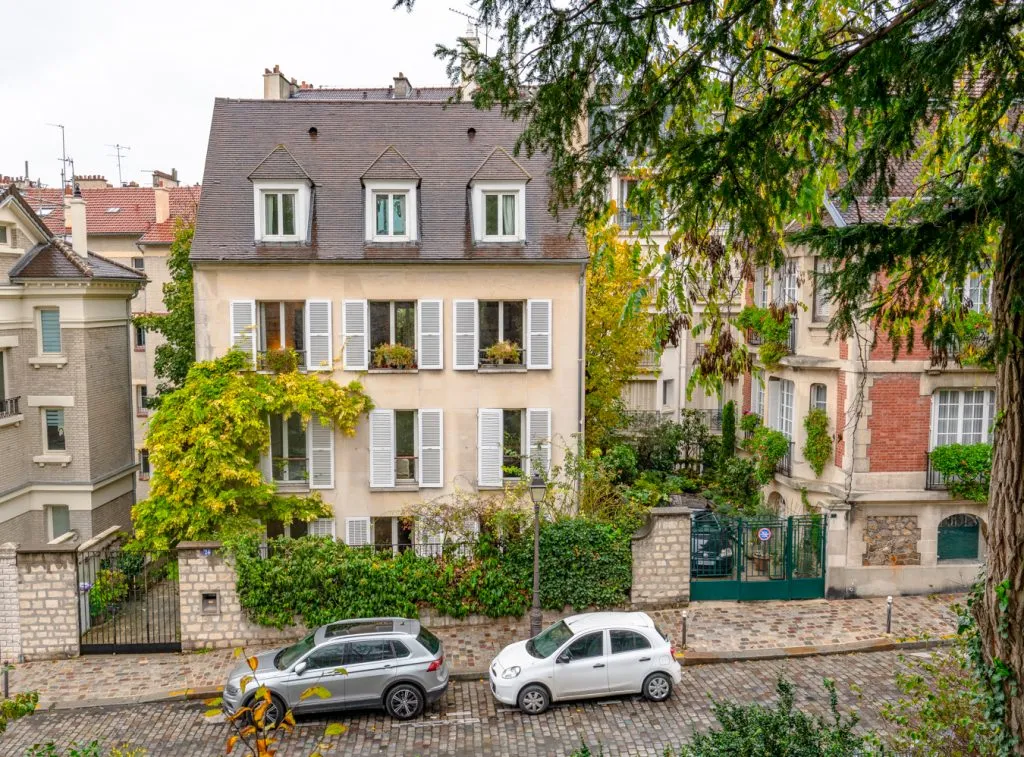
Wander aimlessly and find your own unusual places to visit in Montmartre.
Cliche it may be, but to this day, one of the most rewarding things to do in Montmartre is simply to wander through the neighborhood!
From quiet cafes to stately homes to shady staircases to quirky shops to unusual views of Paris (including the Eiffel Tower), Montmartre’s a wonderful place to explore on foot.
On our most recent trip to Montmartre in Paris, we stumbled across a Portuguese-themed coffee shop among many other treasures, which delighted us to no end as we had a chance to reflect on the 14 months we lived in Lisbon .
We wouldn’t have found that shop in a guidebook, but it was a memorable stop all the same.
Just remember to wear comfortable shoes and prepare for hills when exploring on foot: visiting Montmartre involves climbing lots of hills!
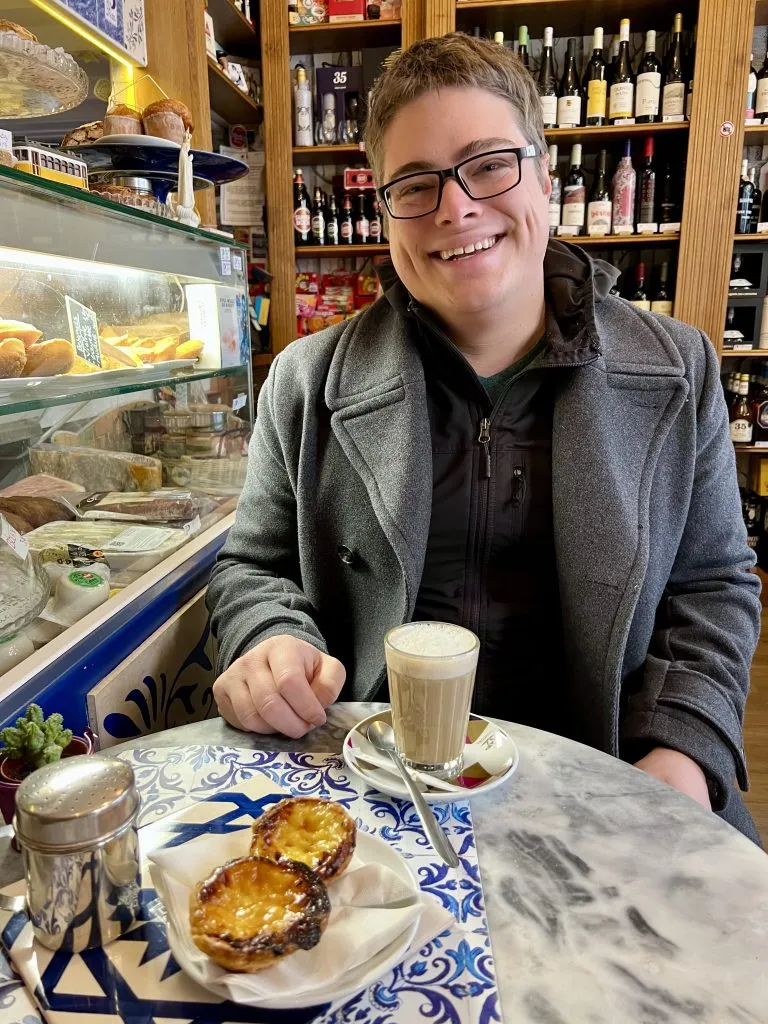
Just outside the boundaries of the neighborhood, you’ll find several more fun things to do near Montmartre.
That includes one of Paris’ most famous attractions, too–one that is often associated with the 18th arrondissement …
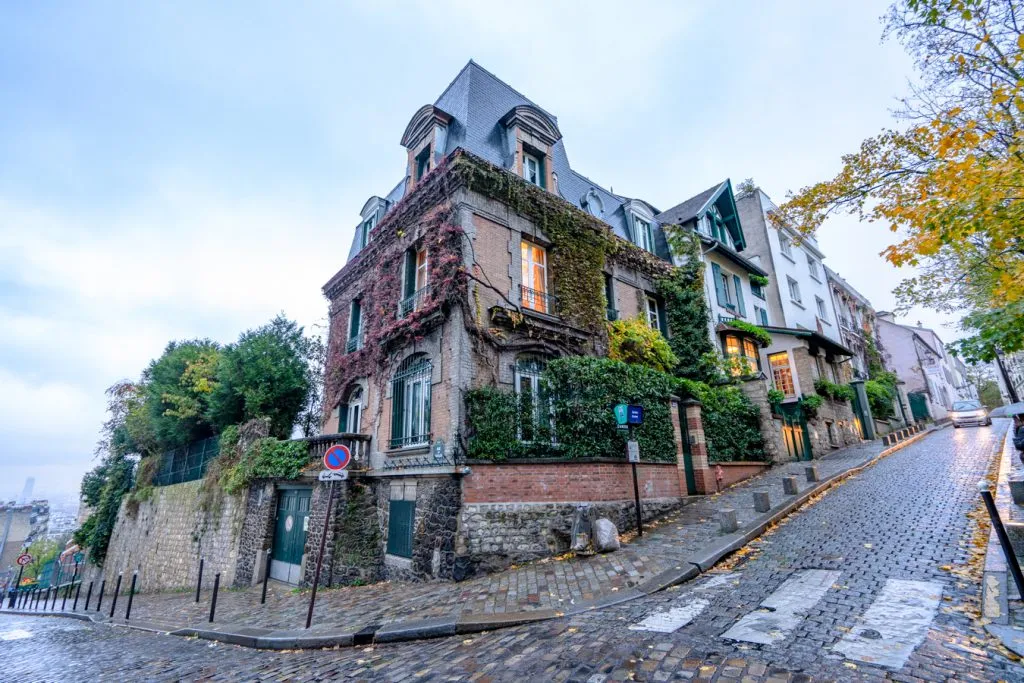
See a show at the famous Moulin Rouge!
Thanks in large part to the 2001 movie starring Nicole Kidman and Ewan McGregor, the Moulin Rouge is one of the most recognizable Montmartre landmarks.
… but it’s not technically located in Montmartre!
Located in the Pigalle district just south (and downhill) from Montmartre, the Moulin Rouge is Paris’ most famous cabaret and is topped by its most recognizable windmill.
You can file this one under “indisputably touristy and extremely memorable”, and most people love the performance (think variety show, not cohesive play).
If you want to see the cabaret show, be sure to book at least a couple of weeks in advance !
Even if you don’t go inside, though, it’s worth stopping by for a quick photo op with the windmill.
Book tickets to the Moulin Rouge cabaret show today!
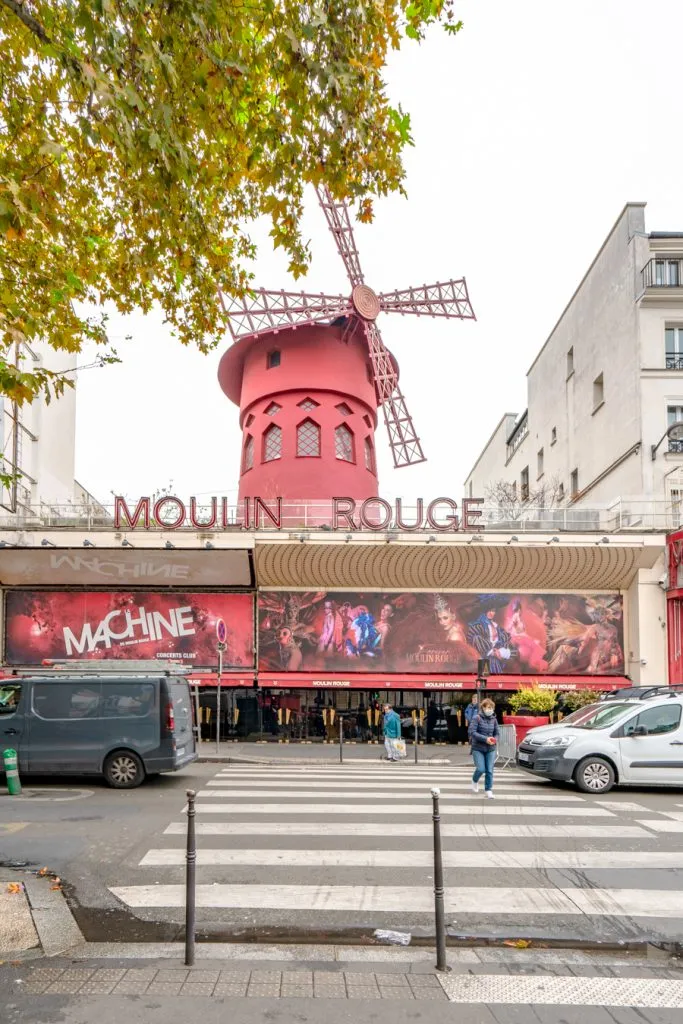
… and pay a visit to the current Le Chat Noir.
Thought to be the original Parisian cabaret, a form of nightlife that took Montmartre by storm at the end of the 19th century, Le Chat Noir has an enduring legacy in the area.
If you visited the Montmartre Museum, you no doubt learned all about the original Le Chat Noir and its unique “shadow play” that helped make it an icon.
And, if you’ve ever so much as glanced into a shop when browsing for Paris souvenirs , you have no doubt seen posters, placemats, and more decorated with the black cat drawings that have their origins at Le Chat Noir (translation: the black cat).
While the original Le Chat Noir has been closed for over a century, a later location opened in 1907 is still in business to this day.
Reviews are solid if not exceptional, and the atmosphere is a clear nod to Montmartre’s historic cabarets, complete with live music every night.
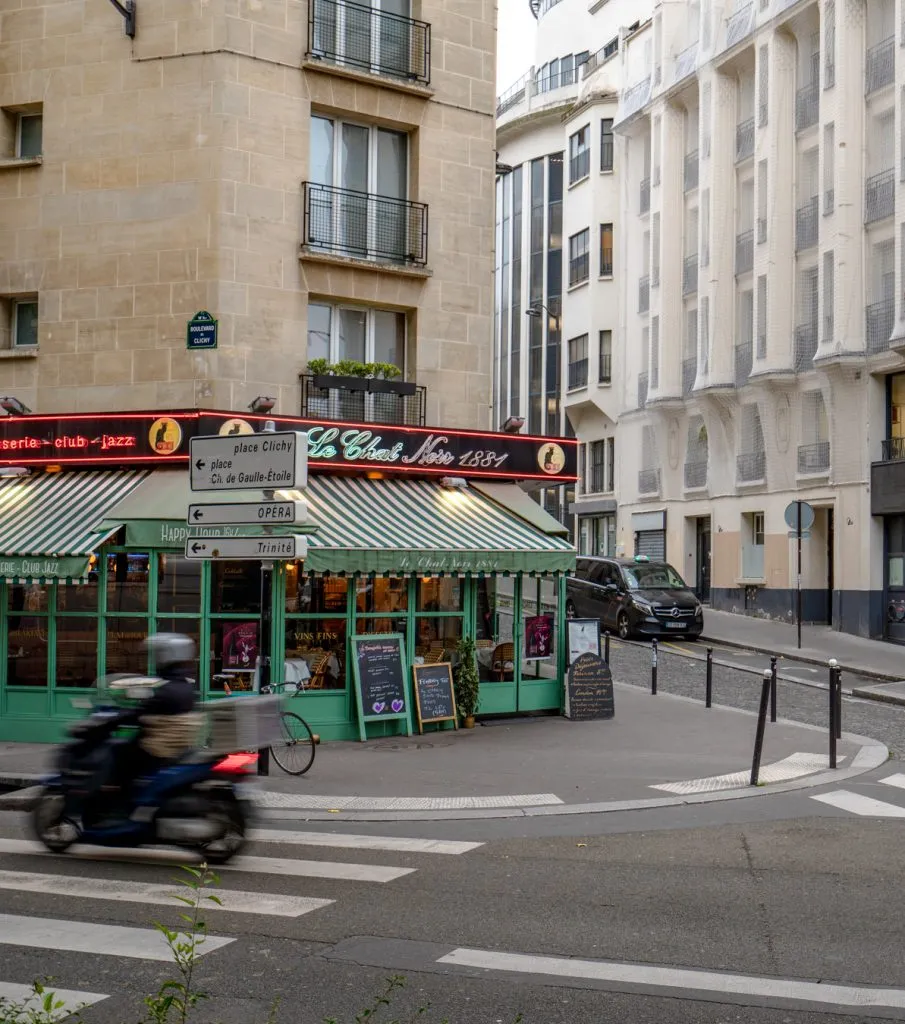
Check out the Museum of Romantic Life.
Housed in a pretty and delicate home dating to 1830, the Musée de la Vie Romantique explores a literary side of Paris, with a focus on George Sand.
Peaceful and quiet, the Museum of Romantic Life is tucked away in a charming courtyard that feels worlds away from central Paris (though if you visit during recess, you’ll hear the nearby schoolchildren playing!).
The museum includes a garden which is home to a pretty cafe, perfect for relaxing a bit before continuing your sightseeing in Paris.
The permanent exhibitions are free to visit, and we felt like we had the museum all to ourselves when we visited a few years ago.
However, now that the Museum of Romantic Life was briefly featured in season 3 of Emily in Paris, it may get a bit more crowded!
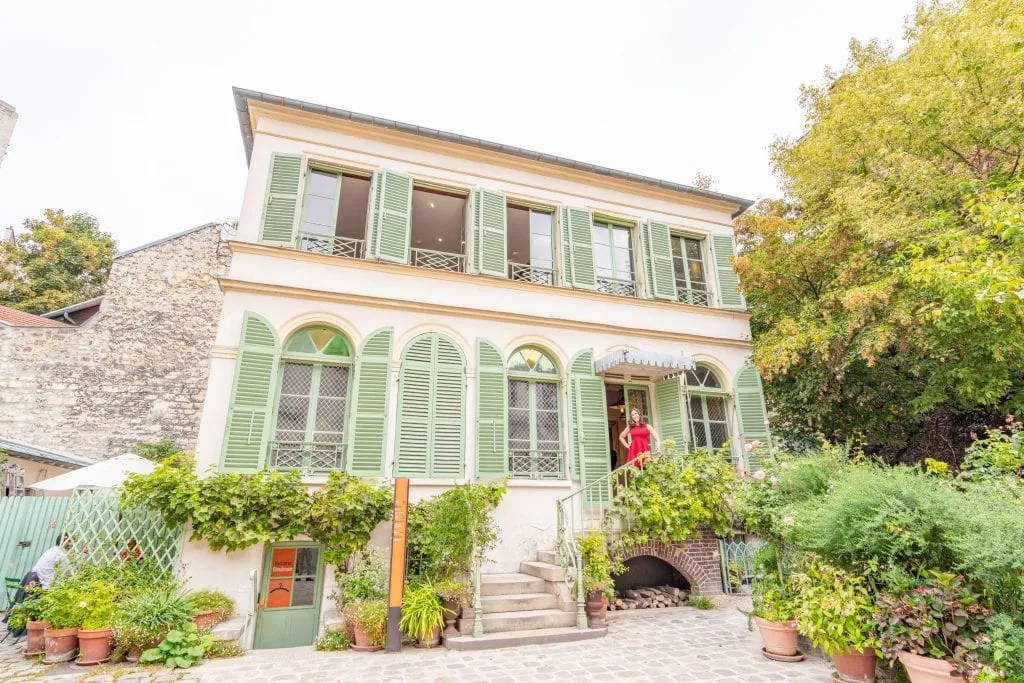
Hoping to make Montmartre your base for your trip to Paris?
As much as we love Montmartre, we first need to caution that given Montmartre’s comparative remoteness to many of the other things to do in Paris, it may not be the best fit–and we say that as travelers who have stayed in Montmartre twice and loved it both times ( this is where we stayed most recently ).
Generally speaking, we would suggest that most first-time visitors to Paris choose a more centrally located neighborhood to stay in (the Latin Quarter (5e) or Saint-Germain-des-Prés (6e) fairly close to the Seine are our go-to suggestions).
However, if you’re a repeat visitor to Paris who loves Montmartre, or you’re hoping to save money by staying a bit further out, Montmartre can be a lovely option as long as you’re prepared to “commute” to most of the top things to do in Paris.
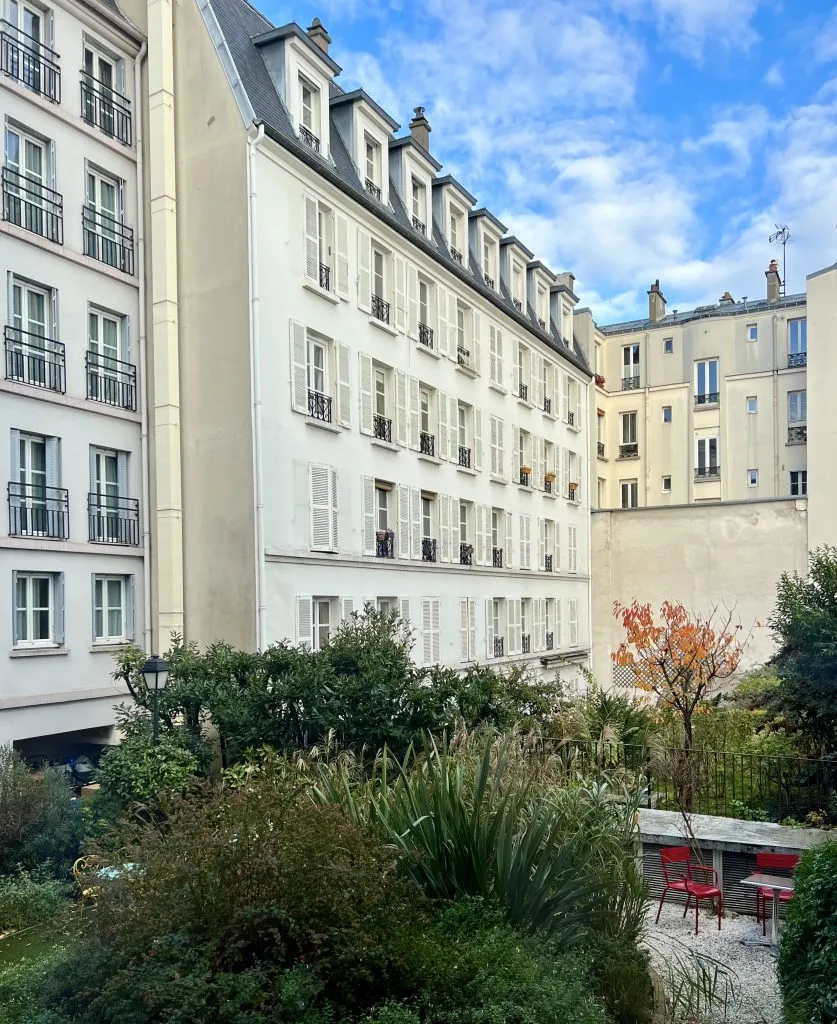
During our first trip based in Montmartre, we checked into Hotel Bellevue Montmartre (small rooms but adequate), and most recently at the Aparthotel Adagio Paris Montmartre , which we loved!
As you leave the boundaries of Montmartre itself, the nearby Pigalle area (where the Moulin Rouge is) can be a bit louder due to the nightlife, as well as a bit less refined, so keep that in mind as you’re browsing places to stay in Montmartre.
Ateliers de Montmartre ADM and the Mom’Art Hotel are two well-reviewed properties we’d love to stay in during future trips to Montmartre.
Check rates & book your stay in Montmartre today!
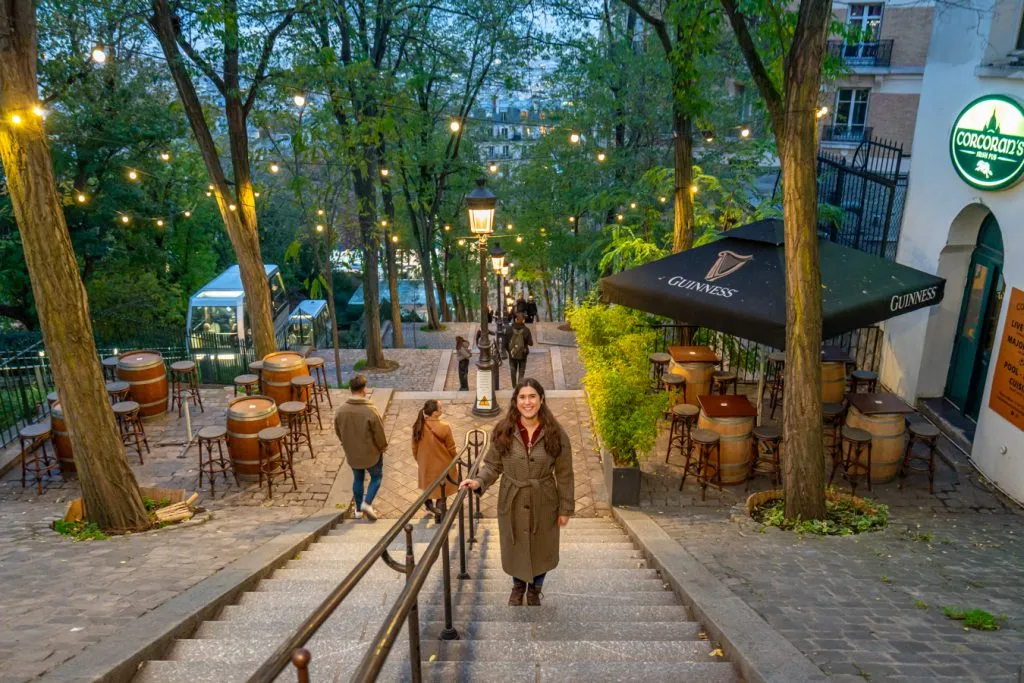
Paris is famously divided into 20 arrondissements , or neighborhoods, that are named via a number system that starts with 1 in the center of the city and circles outward like the shell of a snail.
Montmartre is the 18th arrondissement and is located on the outskirts of the city center, just north of Pigalle (where the Moulin Rouge is).
Because it is fairly far removed from–not to mention uphill from–many of the other popular things to see in Paris (it would take roughly an hour and 15 minutes to walk to Sacré-Coeur from the Eiffel Tower, for example), most visitors don’t arrive in Montmartre on foot.
You can either head to the Abbesses stop (Line 12), the deepest metro in Paris, and right next to the Wall of Love, or go to the Anvers stop (Line 2) and walk directly up Rue de Steinkerque from there until you dead-end into the Sacré-Coeur.
If you head to Abbesses, be sure to take the elevator/lift out of the station–it takes 144 steps to reach the surface!
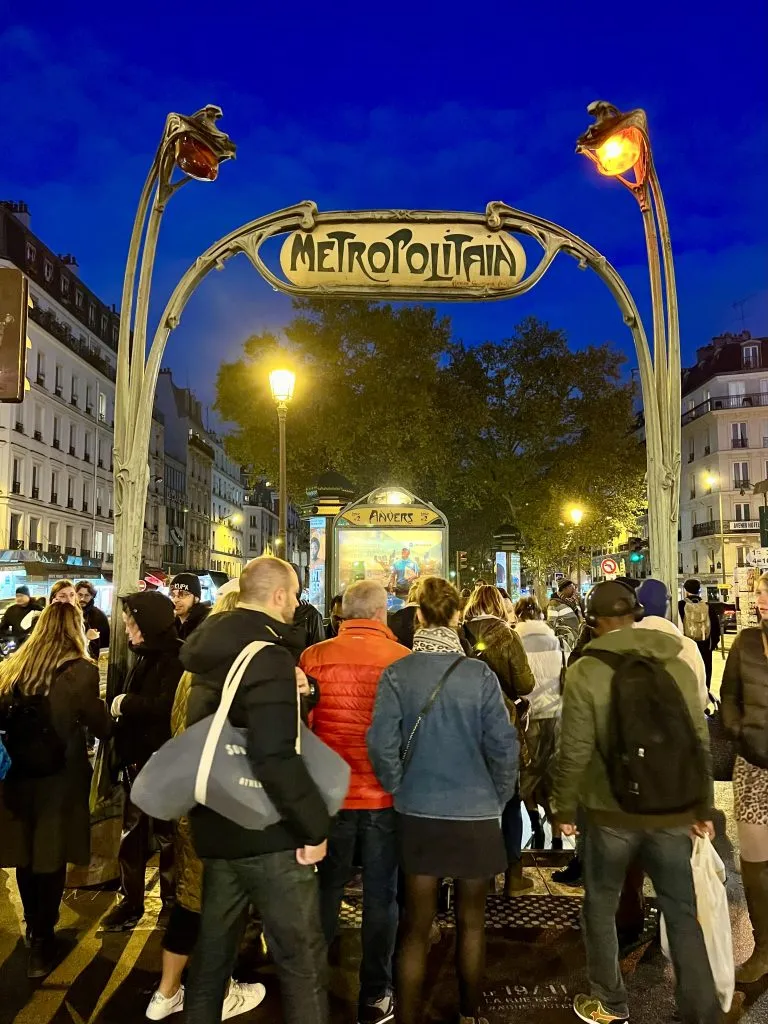
The Lamarck–Caulaincourt (Line 12) is another option on the north side of Montmartre, near Le Refuge. Its photogenic entrance is worth a look!
If you’d rather not take the metro, a taxi or Uber is always an option as well.
If you’d like to walk at least one leg of the trip to and from Montmartre, we recommend walking as you leave (downhill).
The Palais Garnier and Galeries Lafayette flagship store (with its famous dome and rooftop view) are about a 30-minute walk downhill from Montmartre.
The journey is part of the fun on this route, though: take the Rue des Martyrs and you’ll be surrounded by distractingly tempting cafes, bakeries, cheese shops, butcher shops, fruit stands, and more as you meander back toward more central neighborhoods in Paris.
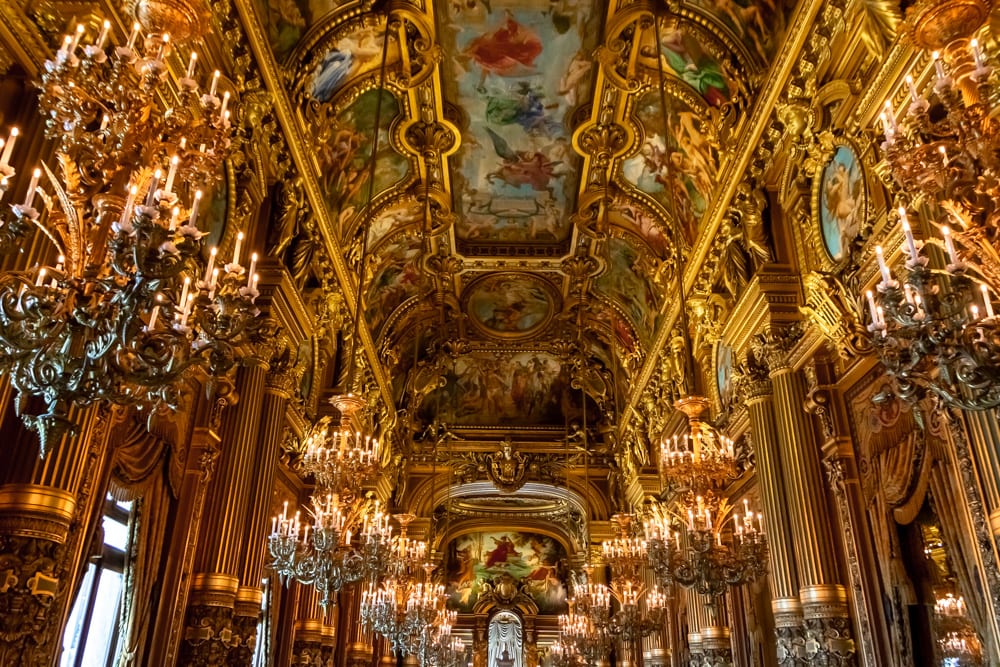
Be prepared to climb lots of hills!
There’s no getting around it: exploring the best things to do in Montmartre means climbing lots of hills, including several steep staircases!
This can be somewhat mitigated in a few places, but ultimately, it’s an unavoidable feature of the neighborhood.
To limit your climbing, you can take the Montmartre Funicular from near the Place St. Pierre to the base of Sacré-Coeur for the price of one metro ticket.
The Montmartre tourist train is also a cute way to stay off your feet, especially if you’re visiting Montmartre with kids.
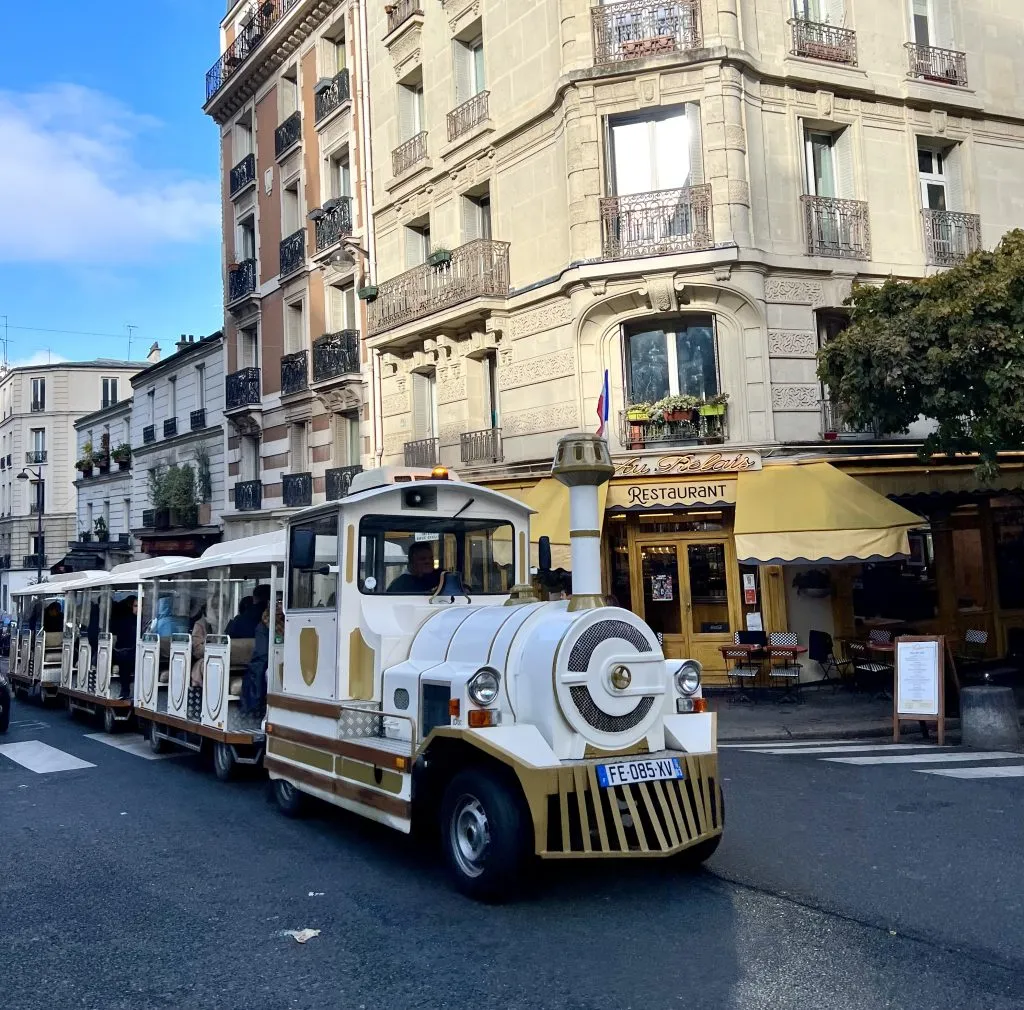
Keep an eye out for scams, especially on the steps of Sacré-Coeur.
Petty tourist scams are, unfortunately, a persistent issue in parts of Montmartre.
In particular, be cautious near the Place du Tertre, Place St. Pierre (near the carousel Sacré-Coeur), and especially on the Sacré-Coeur steps.
Common scams include unlicensed roving artists charging too much for mediocre (or worse) work, “friendship bracelets” offered for free and then charged for once they’re on your wrist, and of course, standard pickpockets.
This isn’t a reason to be frightened or stay away, but keep your wits about you and your belongings close, especially when you’re in crowds!
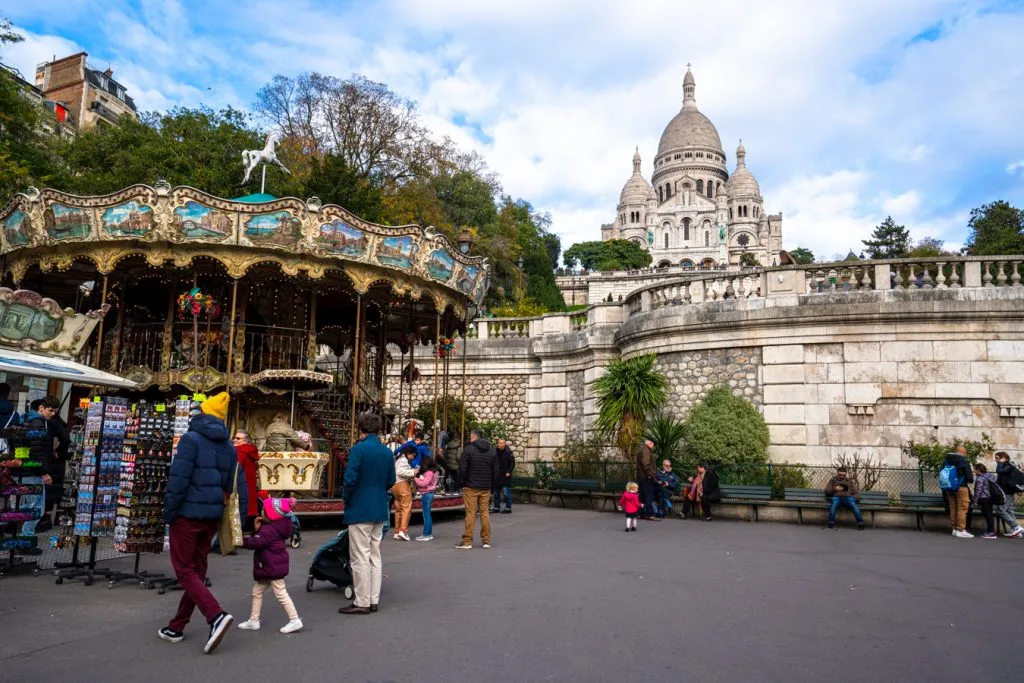
Proceed carefully if you want to have your portrait drawn in Montmartre.
I mentioned this when discussing the famous Place du Tertre, but it bears repeating: if you want to have your portrait drawn in Montmartre, choose your artist carefully!
An artist who is seated with an easel in the Place du Tertre is licensed and approved by the city, and is your best bet for quality work.
Don’t forget to discuss the price before committing!
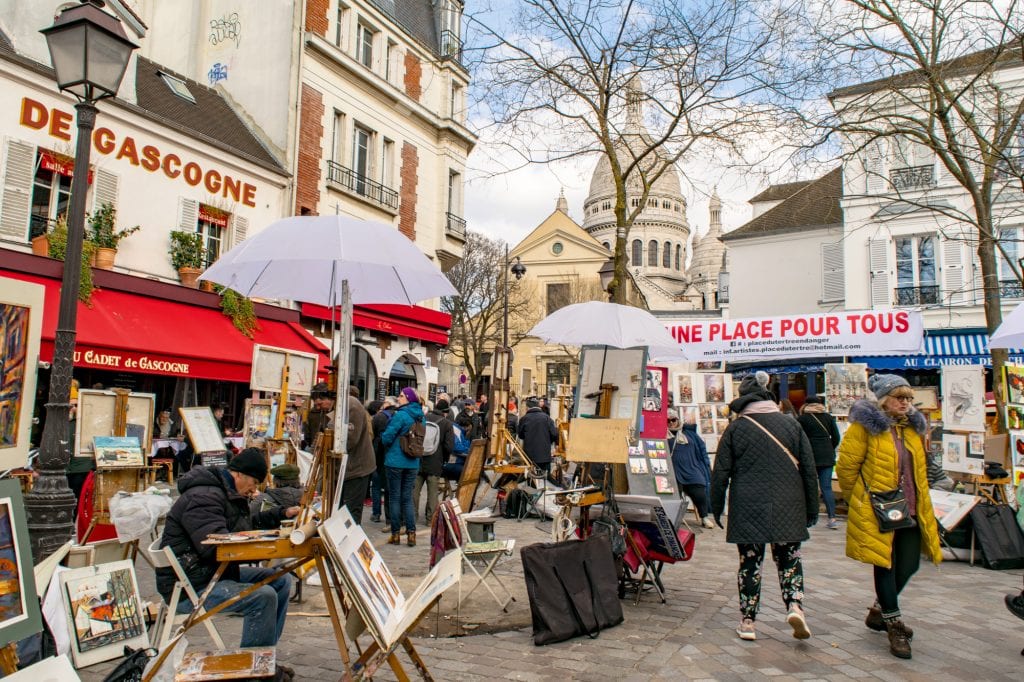
Consider visiting in the morning (or off-season) for the lowest crowds.
Generally speaking, a good rule of thumb for visiting Montmartre in Paris is that the earlier you arrive, the fewer crowds you’ll have to contend with.
If you are visiting Paris in the winter , then all the better: there’s far less congestion in Montmartre then.
Regardless, as one of the most popular neighborhoods to visit in Paris, it’s best to come to Montmartre expecting to be surrounded by tourists, souvenir hawkers, and more–unless, of course, you arrive at dawn.
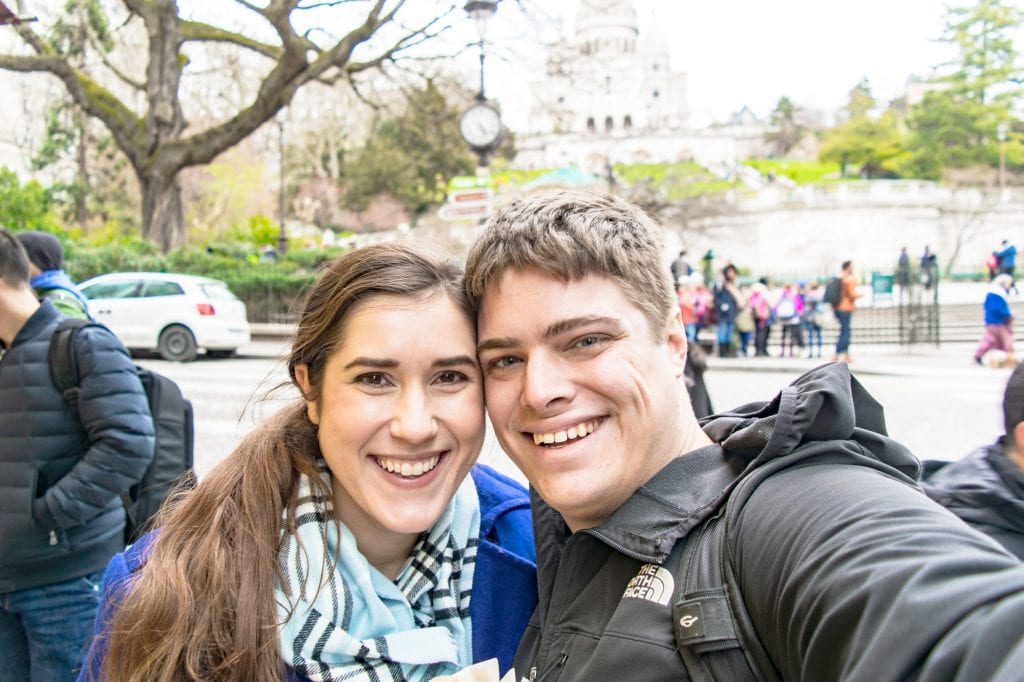
… but watching the sunset from Montmartre is also something special.
Watching the sun set over Paris from the butte of Montmartre is a beloved tradition in Paris and a fun addition to your trip!
The views are best from the top of Sacré-Coeur’s dome, but they’re still wonderful from the steps (you can’t see the Eiffel Tower from the steps, though).
Students, ex-pats, visitors, and more all gather into a jovial crowd to watch the sunset from the steps of the Sacré-Coeur every night, and it’s a memorable experience to join in the fun (just watch your pockets closely).
If you’d prefer a little more peace and quiet, wander around until you find one of the many smaller-but-still-magical viewpoints overlooking Paris.
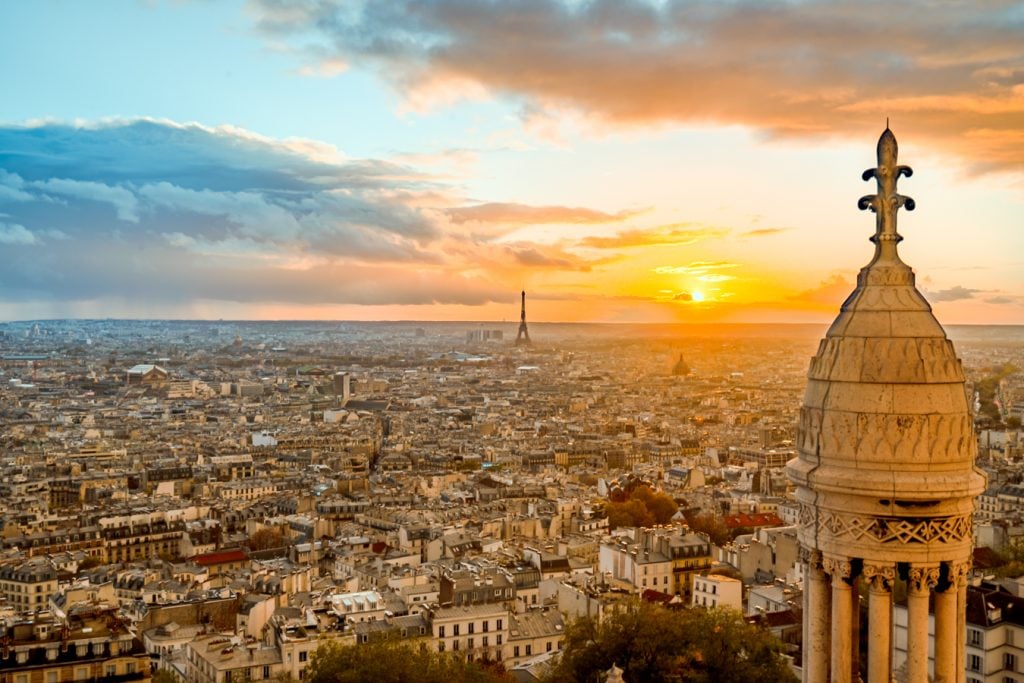
Don’t sit down at a restaurant without a quick check of its reviews.
In a place as popular with visitors as Montmartre, it’s inevitable that plenty of mediocre restaurants and cafes will pop up to serve them.
That’s not a reason to avoid eating in Montmartre at all, and we’ve enjoyed some lovely meals there (more on that in the FAQ section), but you’ll want to exercise the same caution here that you would when choosing restaurants near the Eiffel Tower or the Louvre.
Namely, avoid places that ask you to come inside, have a multi-lingual menu with flags printed on it out front, and (generally) that are within view of a major monument.
We like to use Google Reviews to check a place’s credentials before sitting down too–if you stick with places rated 4.1 and above, you’ll generally enjoy at least a solid (and sometimes delicious) meal without running into issues like surprise fees.
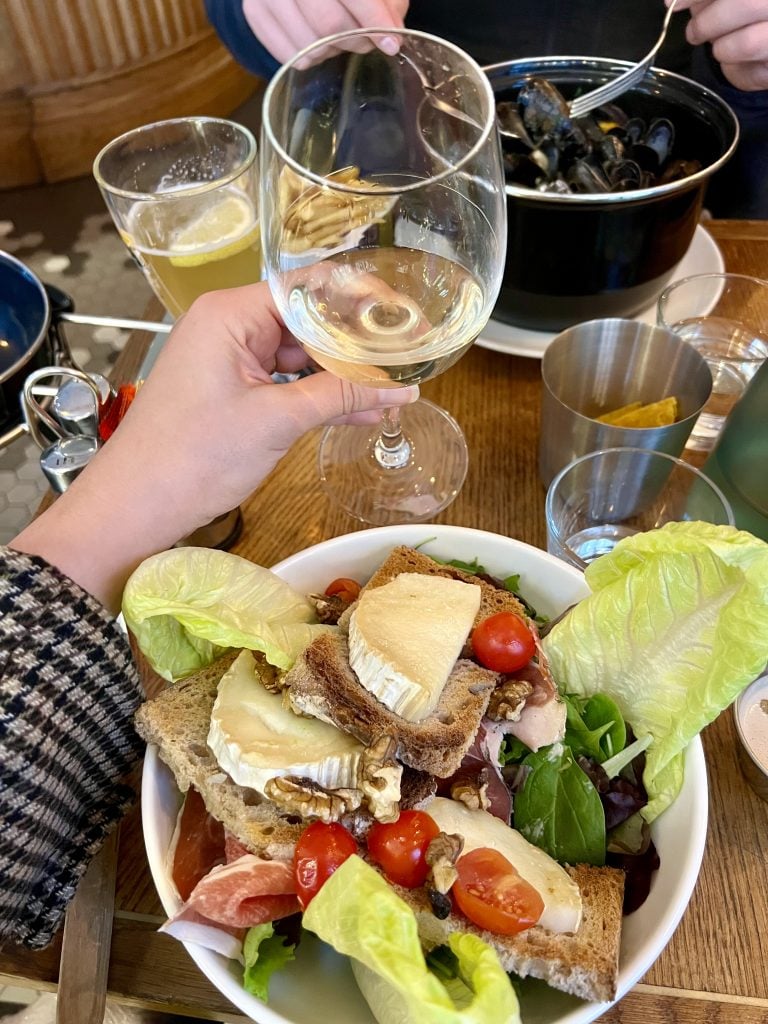
Only have time for a short visit and want to enjoy as many of the best things to do in Montmartre as possible?
Here’s a quick Montmartre walking route that we have enjoyed variations of many times!
Starting from the Anvers metro stop, head up Rue de Steinkerque until you reach Place Saint-Pierre and its beautiful carousel and view of Sacré-Coeur.
Head further uphill (ideally by passing through Square Louise Michel, though you can take the funicular as well) to the steps of Sacré-Coeur.
Enjoy the view, head inside (it’s free!), and if you’re so inclined, climb the 300 steps to the top of the dome (it’s worth it).
Afterward, circle the basilica and pay a visit to Square Marcel Bleustein Blanchet.
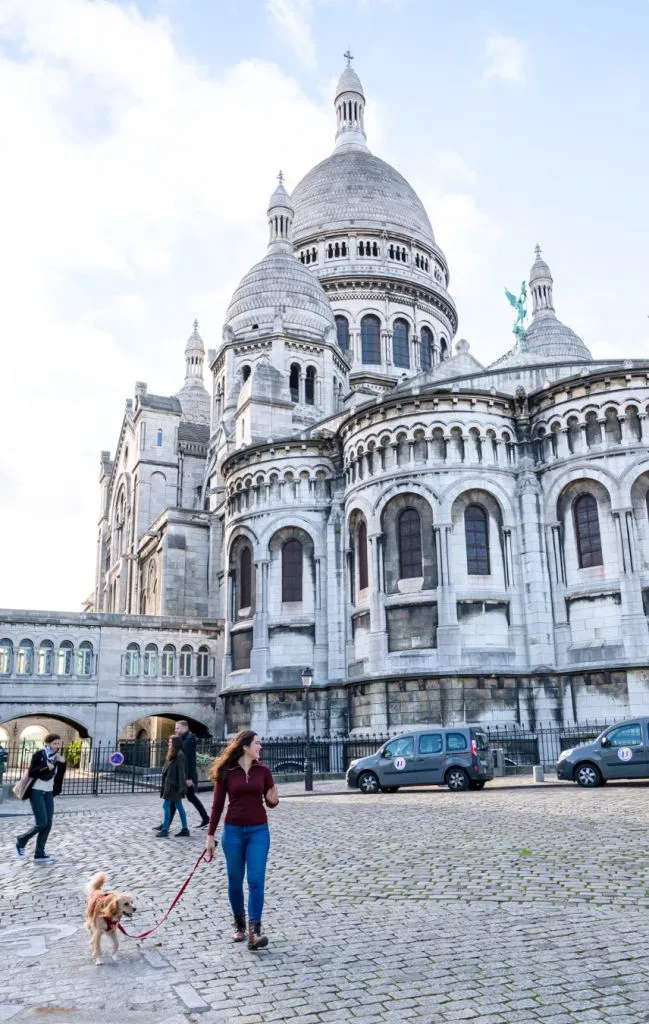
From there, finish encircling the church and head to the Place du Tertre, potentially ducking inside the Church of Saint-Pierre de Montmartre on your way.
Continue down Rue Norvins until you hit Le Consulat, and then right onto Rue des Saules.
In a very short time, you’ll come upon Le Clos Montmartre on your right.
Take a peek, then double back to La Maison Rose and stroll down the Rue de l’Abreuvoir until you hit Place Dalida (don’t forget to look behind you to enjoy the view!).
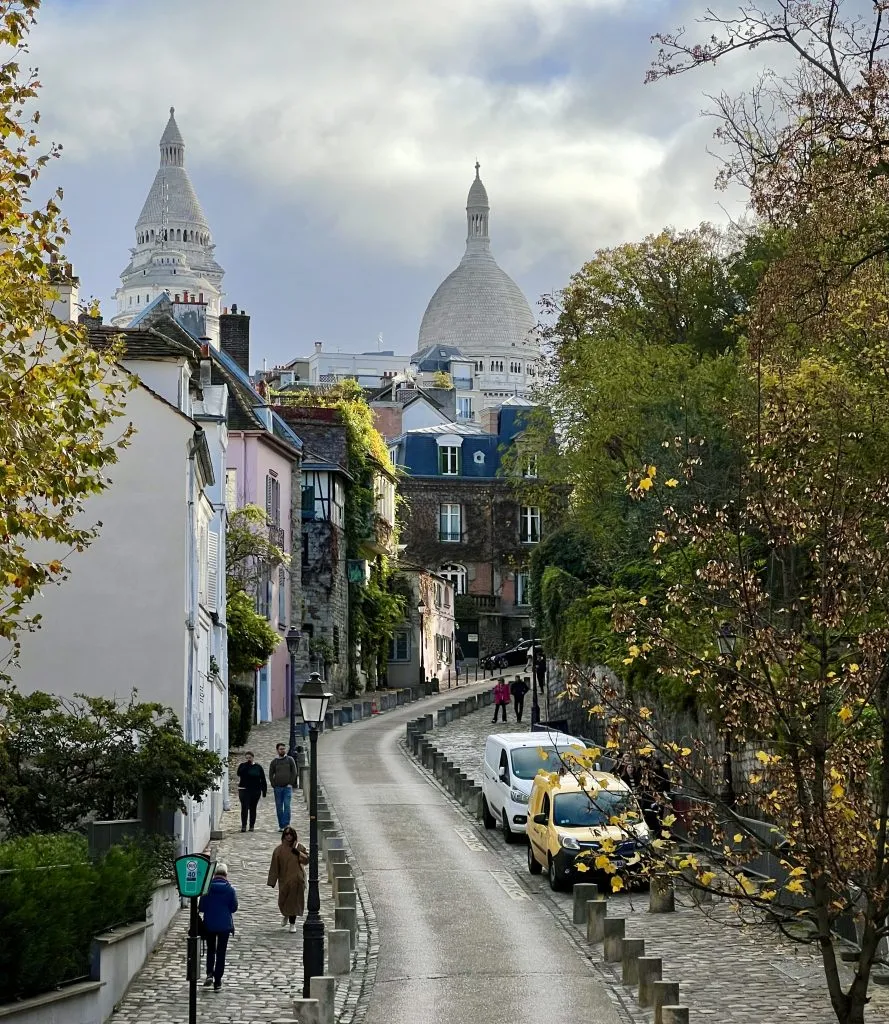
Head up Rue Girardon to famous Rue Lepic, and follow Rue Lepic as it curves back around and eventually meets up with Rue des Abbesses.
Right by the Abbesses metro stop, you’ll find the Wall of Love tucked inside Square Jehan Rictus (and right next to the metro stop, you’ll also find a crêperie stand that makes an excellent Nutella crepe).
From there, you can either hop on the metro and head off to another place in Paris, or double back to Rue Lepic and walk down to the Moulin Rouge (it’s about an 8-minute walk from the Wall of Love).
While this clearly doesn’t cover all of the beautiful places in Montmartre to visit, it’s an efficient way to get a memorable snapshot of Paris’ 18th arrondissement for those who may only have a few days in Paris and are working with limited time.
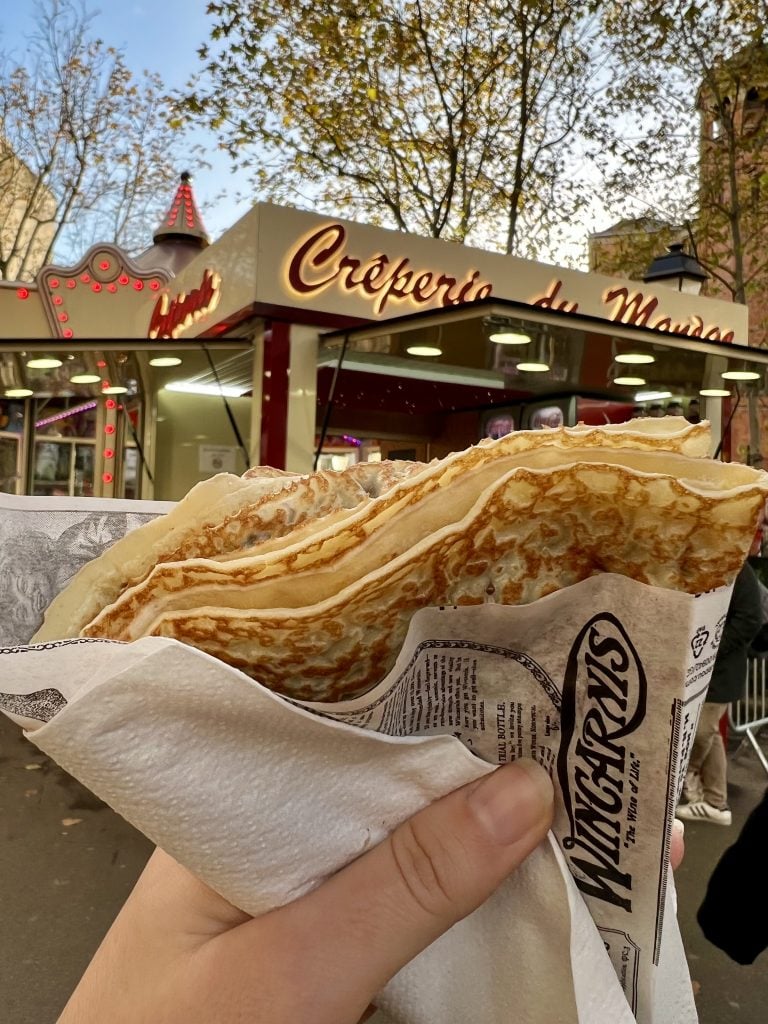
What’s the best way to get to Montmartre?
We covered this in more detail in the how to get to Montmartre section of this blog post, but essentially, the easiest way to get to Montmartre is to take the metro.
The Lamarck–Caulaincourt (Line 12) is another option on the north side of Montmartre, near Le Refuge.
If you want to see the Moulin Rouge on your way up, you could get off at the Pigalle stop and walk to Montmartre from there.
While there are a few other nearby metro stops and ways to access the neighborhood, Abbesses and Anvers are generally the most frequently used metro stops in/near Montmartre for visitors.
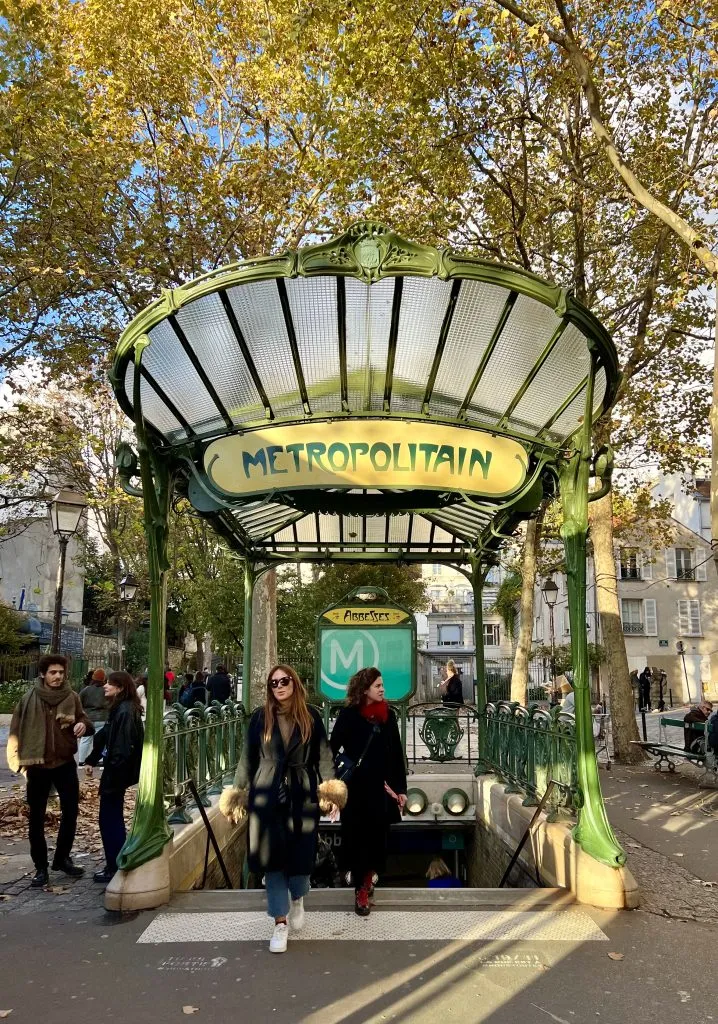
Where should I eat in Montmartre?
Montmartre has more than its fair share of mediocre restaurants aimed at tourists, so be sure to look up the reviews of anywhere you want to eat before you go!
For a special occasion, the Michelin Guide has some great suggestions!
For something unique, La Refuge des Fondus famously serves popular fondue at long, family-style tables–and serves their wine in baby bottles (yes, really).
Personally, we had tasty, casual lunches at Café de Luce and La Villa des Abbesses and would be happy to return to either.
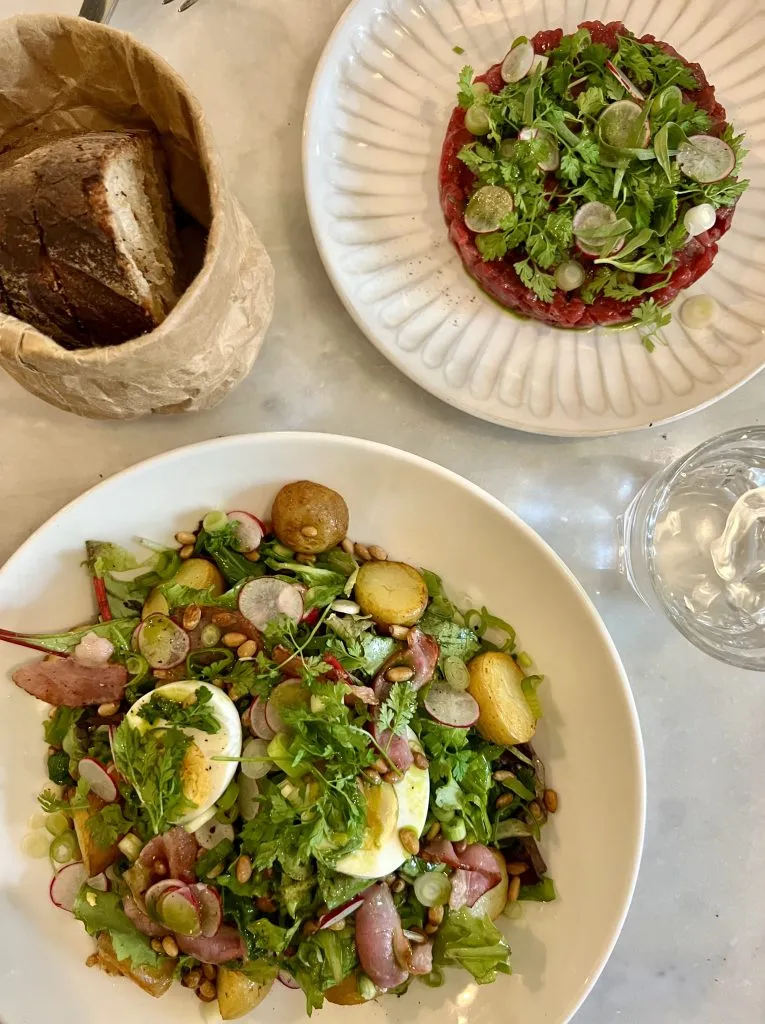
For a quick bite, Fric-Frac gets wonderful reviews for their variety of croque-monsieurs .
And, don’t forget to stop by Pain Pain to sample a baguette that was once voted the best in Paris!
This barely scratches the surface of Montmartre restaurants, of course, but ultimately, just be sure to check the reviews of an eatery before sitting down.
And, like elsewhere in Paris, it’s best to either make reservations or show up at opening in order to have a good chance at getting a table (in the most popular or famous places, reservations are often a must).
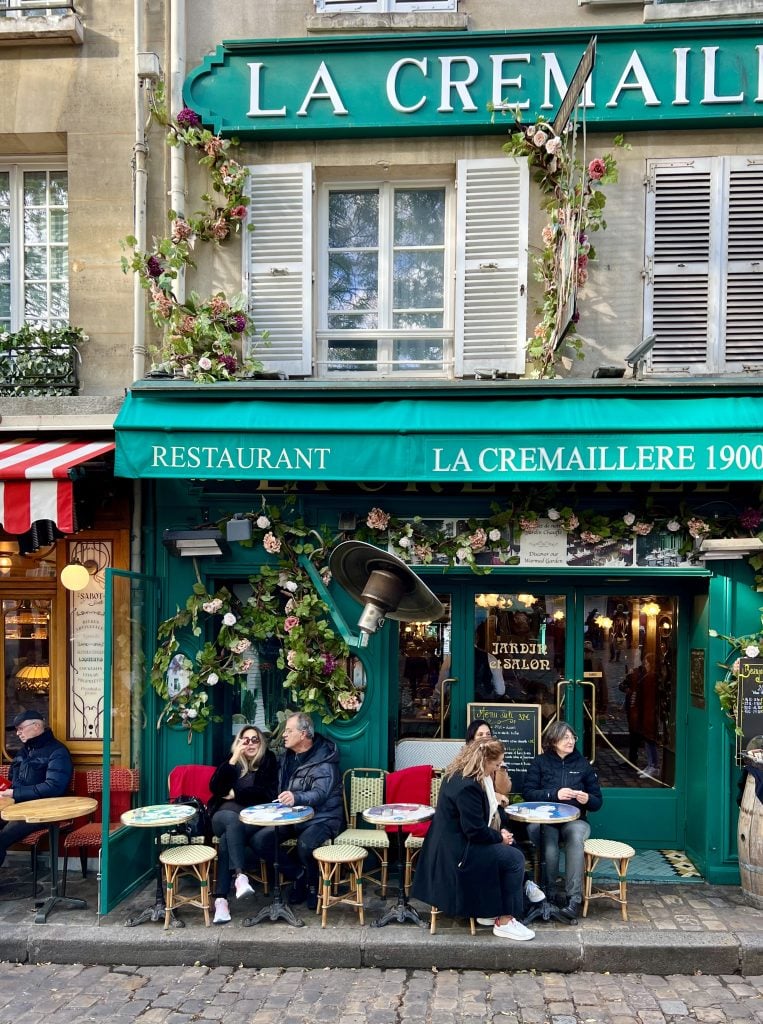
Is Montmartre a good place to stay in Paris?
It can be, depending on what kind of traveler you are!
We’ve stayed in Montmartre twice, first in a Hotel Bellevue Montmartre (small rooms but adequate), and most recently at the Aparthotel Adagio Paris Montmartre , which we loved!
Keep in mind that as you leave the boundaries of Montmartre itself, the nearby Pigalle area (where the Moulin Rouge is) can be a bit louder due to the nightlife, as well as a bit less refined, so keep that in mind as you’re browsing places to stay in Montmartre.
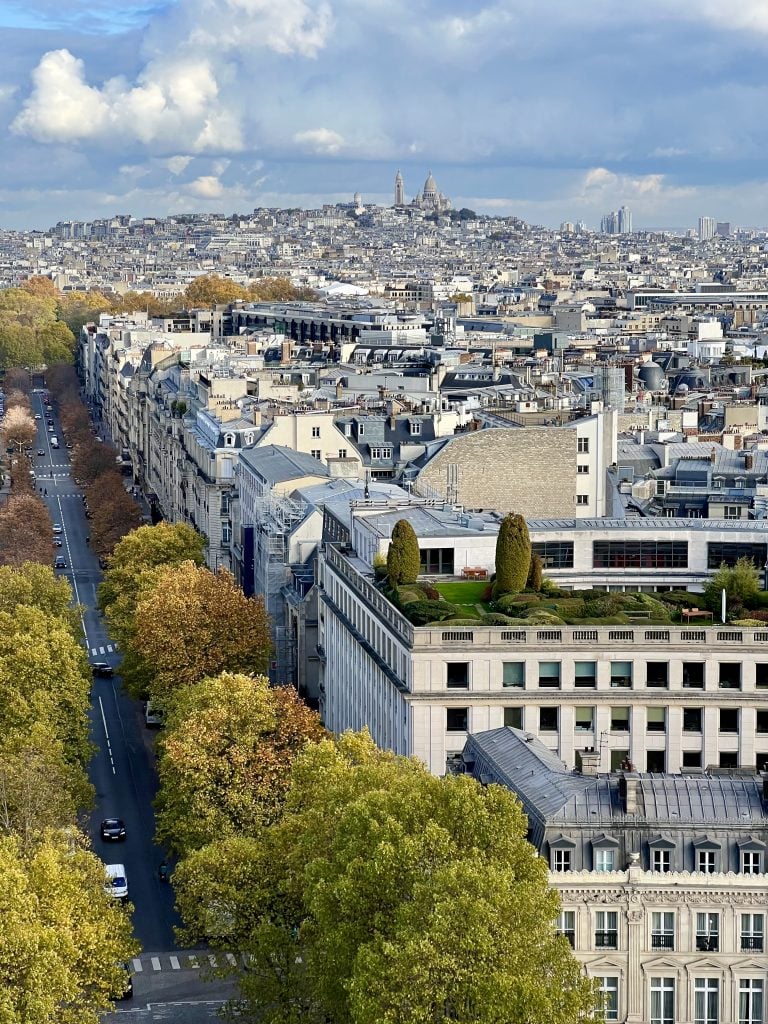
Is Montmartre worth visiting?
Yes, Montmartre is absolutely worth visiting!
Montmartre is one of Paris’ prettiest and most popular neighborhoods to visit and has been a favorite among visitors for generations.
While you’ll find more tourists than artists in this formerly bohemian neighborhood these days, that doesn’t mean it’s not still worth exploring–just that you’ll have to work a little harder to find quiet corners.
The most popular places to visit in Montmartre are typically popular for good reason, though, so don’t let the crowds scare you off (though maybe show up early to avoid the worst of them–more on that below).
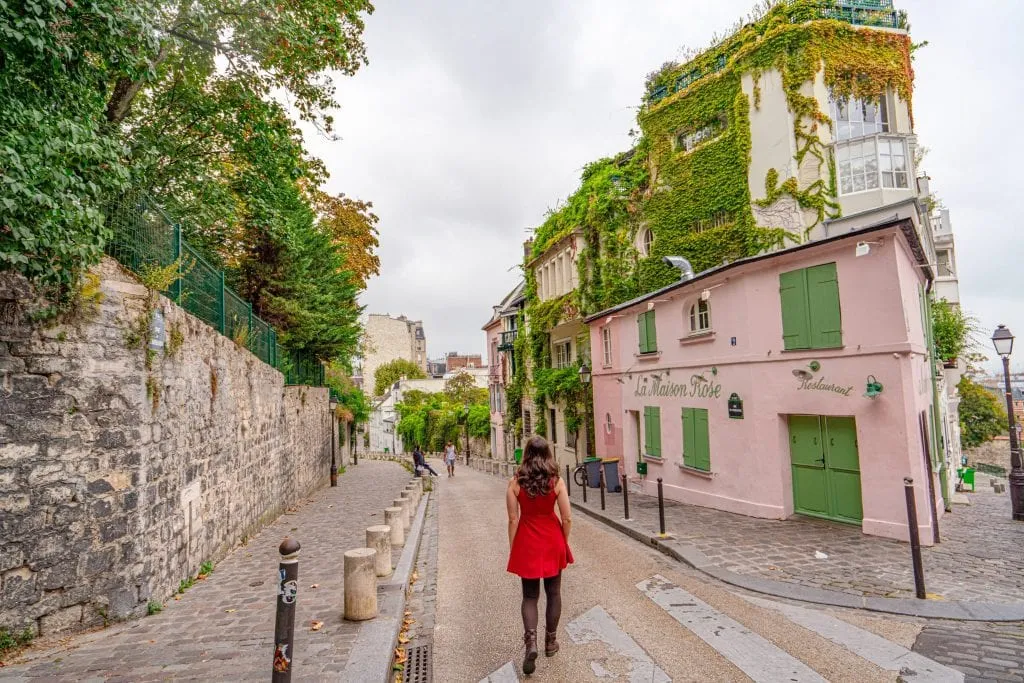
Is Montmartre safe?
When it comes to staying physically safe, Montmartre is generally as safe as any other tourist destination in Paris–which is to say, statistically very safe!
However, petty crime is a different story.
Pickpocketing is a problem in Montmartre, especially in places where tourists congregate in large crowds like the steps of Sacré-Coeur and the Place du Tertre.
Definitely keep an eye on your belongings, and don’t set your bag down at a cafe or restaurant in a place you can’t easily watch it ( our favorite anti-theft backpack latches to chairs for a bit of extra safety).
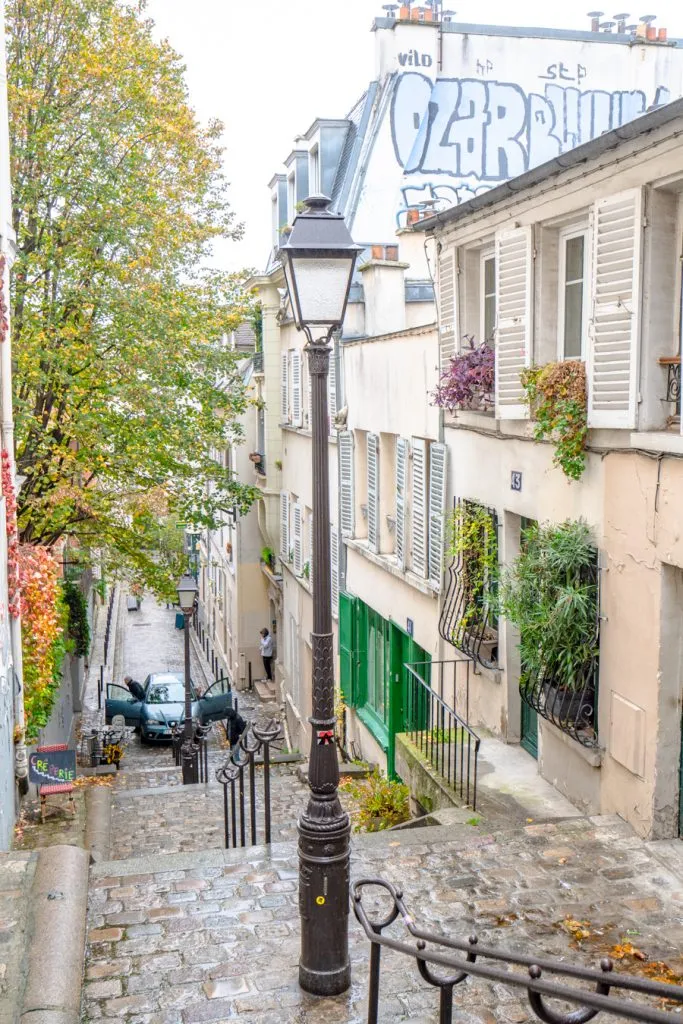
Scams are also an issue, but easily avoided: don’t give anyone money, and don’t accept any “free” items from touts (friendship bracelets are frequently offered).
A simple but firm “ non, merci ” and moving on is the best way to deal with a persistent tout.
We’ve never been pickpocketed, but it does happen and we do know people who have been robbed in Montmartre.
This is absolutely not a reason to avoid Montmartre, but staying aware of your belongings and surroundings is a must.
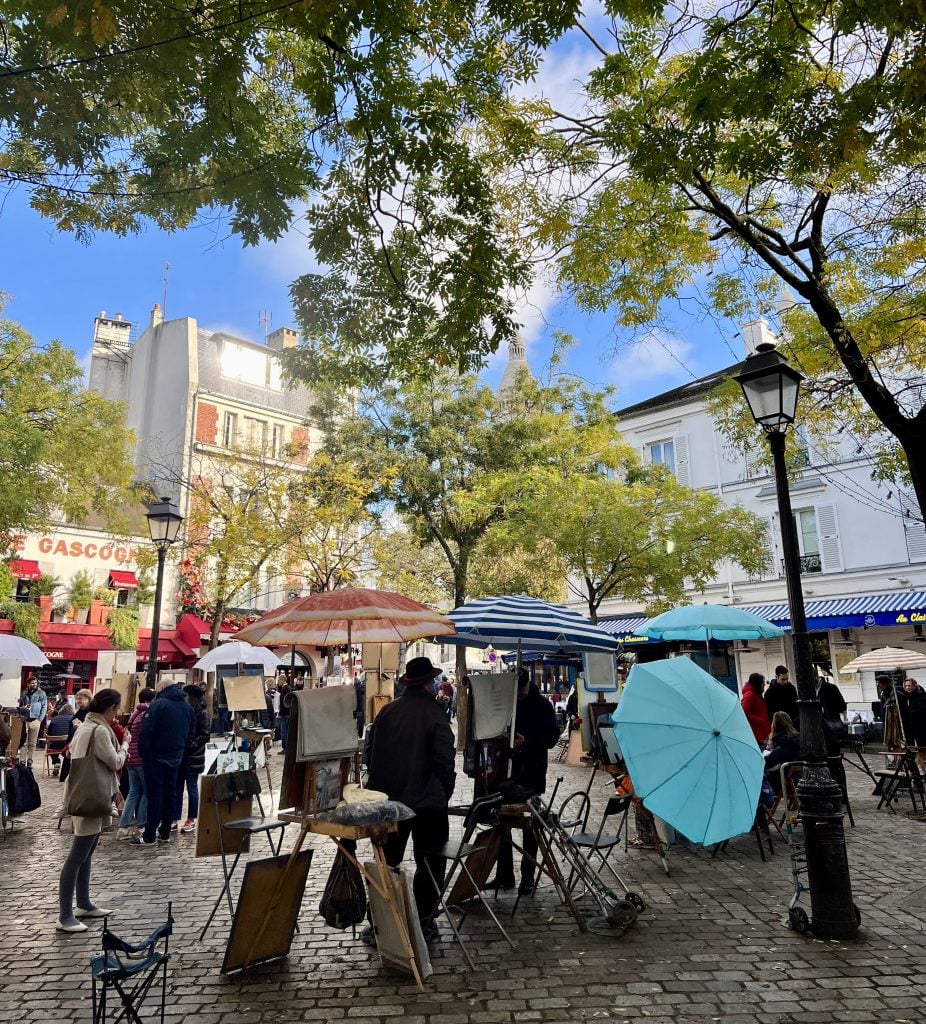
Is Montmartre safe at night?
Montmartre is very busy and touristy, and it’s generally considered just as safe at night as it is during the day!
You’ll want to be vigilant about common scams and pickpockets, but there’s no reason not to visit Montmartre at night.
Some of our favorite memories of visiting include enjoying Montmartre in the evening.
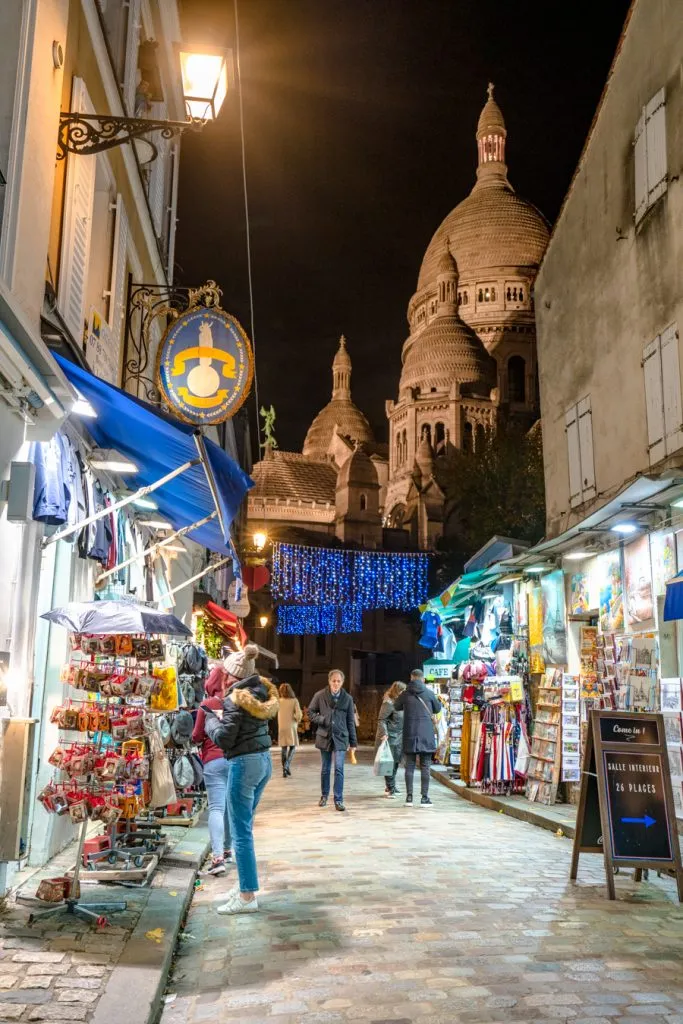
How long does it take to see Montmartre?
Our shortest visit to Montmartre lasted a couple of hours, and our longest visit was when we based ourselves in Montmartre ( in this aparthotel , which we loved) for a week!
In other words, exploring the Montmartre neighborhood is very adaptable to however much time you do have.
Since it does take a bit of a time commitment to get there from the center of Paris, I’d recommend planning to spend at least 2 hours there to make the journey worth it.
If you have less time to spare than that, you’re probably better off enjoying one of the many other incredible things to do in Paris that are closer to the center–but then again, that depends on just how much you want to see even the tiniest sliver of Montmartre.
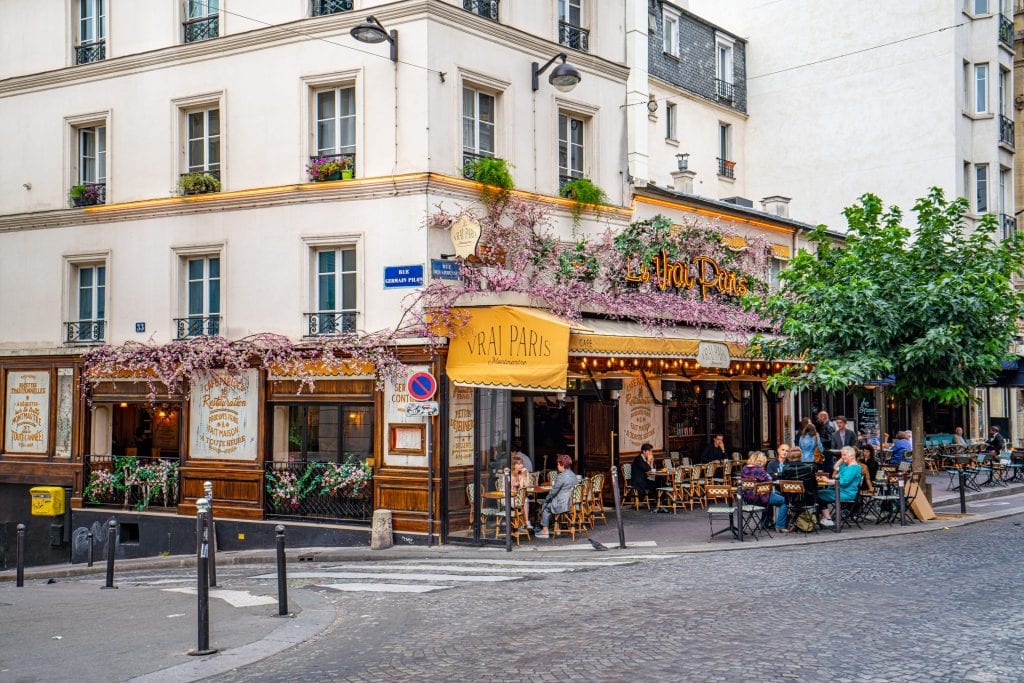
What’s the best time to visit Montmartre?
The most peaceful time to visit Montmartre is in the early morning, as soon after dawn as you can manage to get there!
Mornings generally have wonderful light for photography, too.
The most crowded time of day to visit Montmartre is the middle of the day and afternoon.
The evenings, including sunset, are far less peaceful than the mornings but are wonderful to experience.
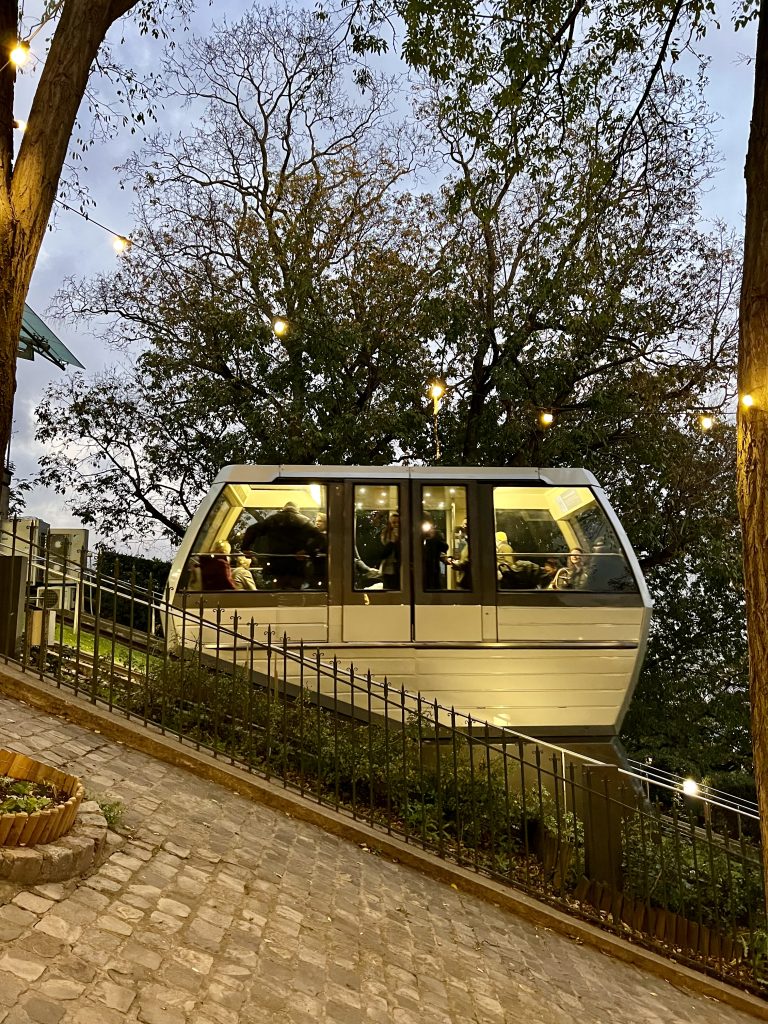
What’s the best month to visit Montmartre?
As far as the season goes, the crowds in the neighborhood of Montmartre follow those in the rest of Paris: summer is the busiest, winter the most empty, and spring and fall somewhere in the middle.
There’s not a single month of the year where I’d turn down a morning in Montmartre, though!
Cherry blossom season (late March to mid-April), fall foliage season (the first half of October), and Christmas market season (late November through early January) all also bring their own perks to the neighborhood.
Regardless of which month you visit, you’ll be able to enjoy all of the typical top things to do in Montmartre, Paris, plus perhaps some seasonal attractions as well!
Take This Map With You! Click each highlight to pull up the name of the destination. To save this map to “Your Places” on Google Maps, click the star to the right of the title. You’ll then be able to find it under the Maps tab of your Google Maps account! To open the map in a new window, click the button on the top right of the map.
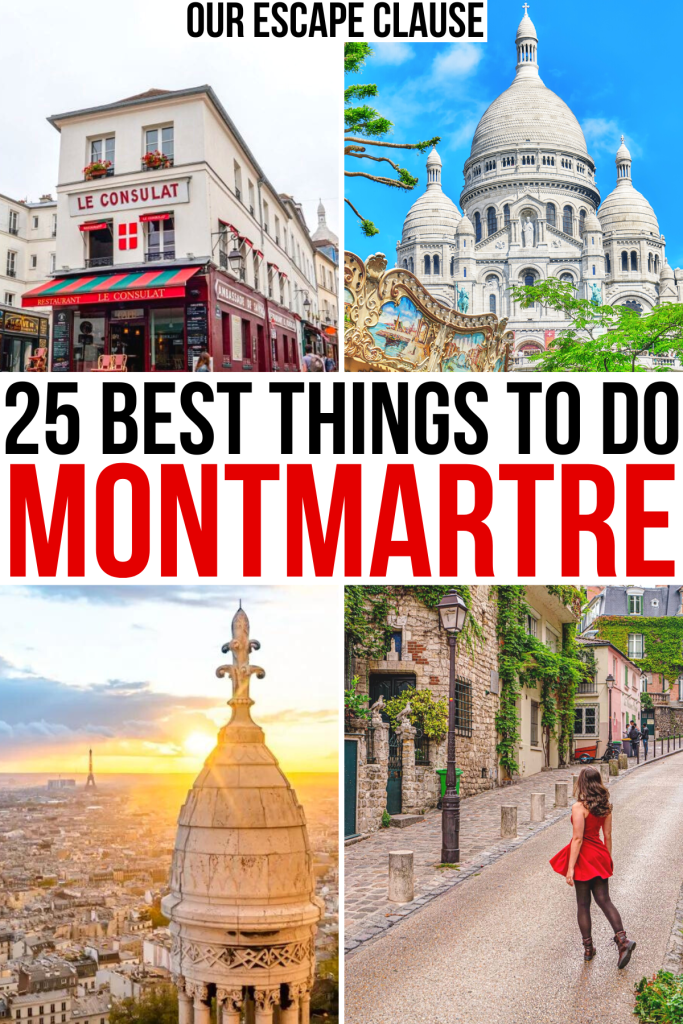
About Kate Storm

In May 2016, I left my suburban life in the USA and became a full-time traveler. Since then, I have visited 50+ countries on 5 continents and lived in Portugal, developing a special love of traveling in Europe (especially Italy) along the way. Today, along with my husband Jeremy and dog Ranger, I’m working toward my eventual goal of splitting my life between Europe and the USA.
2 thoughts on “25+ Magical Things to Do in Montmartre, Paris (+ Map & Tips!)”
Do you have any suggestions for: Monte Carlo, Monaco, Marseille, France, Sete (Montpellier) France, & Barcelona, Spain? We will be taking a fall cruise and visiting these places each for a full day of 8 hours or more. Looking for options of what to see. I really LOVE following you 2 and Ranger. Wishing you nothing but the BEST & HAPPINESS. Keep on traveling.
We’ve visited most of those, but not very in-depth for most of them (we have spent almost a week in Barcelona). We had the terrible luck of a rainy day when we were in Monaco, so didn’t get to see nearly as much of it as we would like!
I hope to publish a guide to spending one day in Barcelona sometime this spring, but in the meantime, I talk quite a bit about it in this post: https://www.ourescapeclause.com/10-days-in-spain-itinerary/
Thank you so much for following along with us! Wishing you and yours all the best. 🙂
Leave a Comment Cancel reply
This website uses cookies to improve your browsing experience and analyze the use of the website. Learn More

Montmartre Walking Tour

This post is a free and self-guided walking tour of Montmatre, one of Paris's most iconic neighborhoods, along with a map.
We also provide an audio tour version that is GPS-enabled to help guide you through the area.
And lastly, we provide a comparison of the various live-guided Montmartre walking tours , including, free walks , food tours , and art walks.
The neighborhood is a popular destination for visitors from around the world who are eager to follow in the footsteps of artistic legends such as Dali, Degas, and Hemingway, among several others.
The Moulin Rouge and Sacre Coeur Cathedral are especially famous attractions that have been attracting visitors, and tour companies, to the neighborhood for decades.

Click the Montmartre walking tour map to enlarge it.
SELF-GUIDED TOUR OF MONTMATRE
This self-guided tour should take between 2 and 4 hours depending on how long you dwell at each stop. In reality, there's no more than 1 hour of walking.
The tour begins at Place Pigalle ( map ). Take the metro to Pigalle on line 2 or 12 and prepare to stroll in the footsteps of geniuses. The tour ends near where it starts.
We also offer our own, GPS-led audio tour , developed and narrated by one of our local tour guides, Christina.
Here is a sample of the tour.
Place Pigalle
Take the metro to Pigalle on line 2 or 12 and prepare to stroll in the footsteps of geniuses.
Exit the metro and you’ll find yourself in Place Pigalle on the Boulevard de Clichy ( map ).
Downhill you’ll head back into Paris and going across either east or west you’ll be walking around the Butte du Montmartre or the hill of the martyrs.
We’ll find out about the name later, but in the late 19 th Century this went from being the countryside outside of the city to the most radical artistic neighborhood in the world.
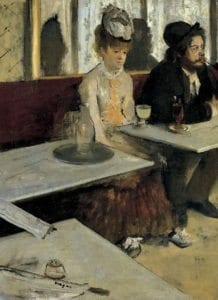
Looking down the hill you’ll see a nightclub called Folies Pigalle, this was once the café Nouvelle Athènes frequented by Van Gogh, Henri Matisse, and Degas where the latter painted his famous L’Absinthe (see picture).
Back then absinthe, a supposedly hallucinogenic drink made of anise, fennel, herbs, and wormwood, was all the rage but we’ll hear more about that later too.
By the 1940s, the bar had become a striptease club where the Nazis and later French Resistance fighters would relax.
Sex and the erotic have always been a big part of the Montmartre story. Looking around today you’ll see lots of clubs and sex shops along the Boulevard.
It can be quite seedy here at night, but as we head up the hill you’ll notice the atmosphere becomes much less bawdy.
The name Pigalle comes from the 18 th- Century painter, Jean Baptiste Pigalle, but American GIs arriving in Paris after its liberation by Free French forces found the same pleasures here and nicknamed the area Pig Alley!
Right now we’re going to head west along Pig Alley (the Boulevard de Clichy) keep downhill on your left and uphill on your right.
Le Chat Noir
(68 Boulevard de Clichy)
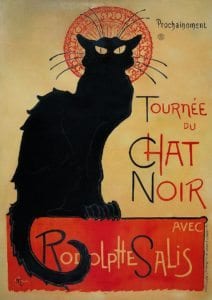
You are standing in front of the world’s first modern cabaret.
La Chat Noir is now most famous for stylish retro posters on a thousand student walls (see picture).
But this was the soul of Belle Époque Paris, a place where fashionable artists came to be entertained at their tables by raucous music hall entertainment.
The club opened in 1881 as the meeting place of Les Hyrdopathes a group of artists who preferred wine to water!
The doormen at the club dressed like the Pope’s Vatican Swiss Guard but their job was to stop priests and the military people from entering this bohemian and radical club.
The list of famous patrons is like a who’s who of modern art and culture; the musician Claude Debussy, the singer Aristide Bruant and painters like Henri Toulouse Lautrec.
Henri Toulouse Lautrec was a fascinating character. Born to a noble family with a history of inbreeding, Toulouse broke both legs when aged 14, and his legs ceased to grow, leaving him with an adult torso, a child’s legs, and hypertrophied genitals!
He became the center of the Montmartre social scene, a leading post-impressionist painter, and a legendary lover to many local prostitutes and models.
From this, he contracted syphilis, went crazy, and drank himself to death at the age of 36.
Today he’s probably best known for designing the posters and flyers for the most famous cabaret in the world.
You probably don’t need us to tell you the name of that cabaret, keep walking west on the Boulevard de Clichy, and on your right, you’ll spot a big red windmill!
Le Moulin Rouge

The original red windmill stood atop a low building here which marked the entrance to the cabaret where kings and paupers could mix and watch girls dancing the famous Can-Can dance.
That windmill burned down in a fire, but the club was rebuilt and continues to wow audiences.
The Can Can, where dancers kick up their legs one after the other, getting quicker and quicker, was originally danced by both sexes but women in the late nineteenth century wore open underclothes which would occasionally flash audiences as they danced.
Here at the Moulin Rouge, they found that the more the girls flashed the more customers kept returning, and over the years the underclothes got shorter and shorter as the club became more and more famous.
Baz Luhrmann’s film with Nicole Kidman and Ewan McGregor reignited interest in the club in 2001.
If you’ve seen the film John Leguizamo’s character is based on the painter Toulouse Lautrec.
The Moulin Rouge remains one of the main attractions in Paris with shows every night at 21:00 (9 pm) and 23:00 (11 pm).
Tickets start at 87€ per person , it’s not cheap but will certainly be an unforgettable evening.
For now, let’s head up into Montmartre. Turn back towards the Blanche Metro stop and then left up Rue Lepic.
Café des Deux Moulins
As you head up Rue Lepic, you’ll find this charming café-bar on the left-hand side - 15 Rue Lepic ( map )
Movie lovers will instantly recognize this as Amelie’s workplace from the famous 2001 French film; Amelie. The quirky love story is set around Paris but focuses heavily on Montmartre.
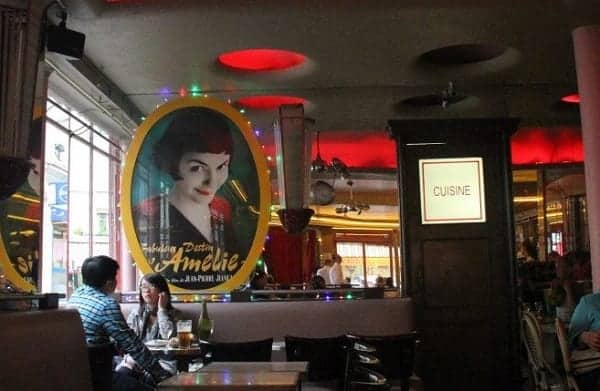
The cigarette machine from the film is missing but the Café’s bathroom remains identical to how it is in the raunchy movie scene!
Despite its fame, the Café des Deux Moulins is no more pricey than other cafés and restaurants in the area.
A top tip for saving money in Paris is to drink at the bar. You will pay a higher price for table service and an even higher price for sitting outside on the terrace.
Continue up Rue Lepic, you will get to what looks like a junction, but turn left and you’ll find that Rue Lepic continues curving its way up the hill.
Van Gogh’s House
As Rue Lepic turns right uphill you’ll find a plaque on the wall at 54 Rue Lepic ( map ) commemorating Vincent Van Gogh’s time here.

This was the home of Theo Van Gogh, Vincent's brother, who worked for a local art dealer. Vincent showed up in 1886 penniless and moved in with his brother.
This began a 2-year stint in Paris. It's here where Vincent's studio was set up (well, it was his bedroom).
In Paris Van Gogh became interested in Japanese art, pointillism, and impressionism and was hanging out with artists like Toulouse Lautrec, Paul Gauguin, and Camille Pissarro and his art took a transformative turn in these days.
Financial success eluded him to this point. Ironically, Van Gogh's poverty led him to focus on painting inexpensive and readily available items, which is why many of his paintings of this era involve flowers.
This is also the period when he painted several versions of his self-portrait.
For more information on his time here in Paris, there is an excellent article , which was a source for this entry, as well as an online exhibit .
Le Moulin de la Galette
Stop on Rue Lepic at the corner with Rue Tholozé ( map ) for fantastic views down into Paris. Cast your eyes upwards and you’ll see the Moulin de la Galette.

A galette is a kind of wholemeal crepe that was a staple food of the poor of Montmartre and Paris at the turn of the 20 th Century.
The windmill here is the only original windmill remaining today, but back then, Montmartre was full of windmills. This one is famous for two reasons:
During the 1870 Prussian siege of Paris, the mill’s owners defended the area and the miller was nailed to the sails of the mill in punishment by Prussian soldiers.
On a happier note, the mill was famous as a café, cabaret, and meeting point for artists. Many painted scenes here, but most famously Pierre-August Renoir.
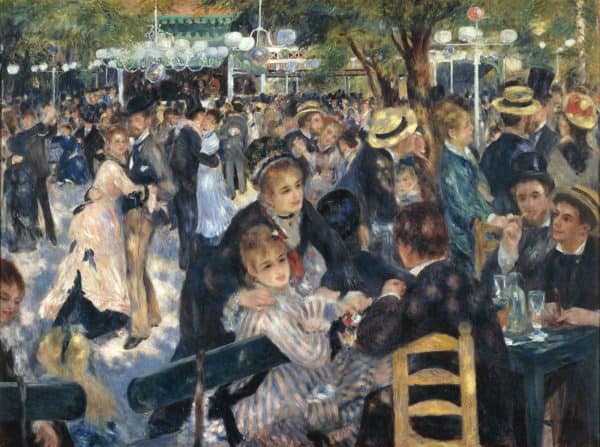
Renoir and the impressionists took art away from trying to capture purely accurate images. They preferred to show how things move and change over time as light changes from morning to evening.
Renoir’s Moulin de la Galette painting appears in the film Amelie for those who’ve seen it.
Today the windmill is privately owned and you can’t go up there so we’ll continue around the corner on Rue Girardon.
Saint-Denis Statue
One block on, at 2B Impasse Girardon ( map ), you will find a small park, Square Suzanne Buisson, on the left of the Rue Girardon.
In the park, there’s a statue of the first Bishop of Paris, Saint-Denis.
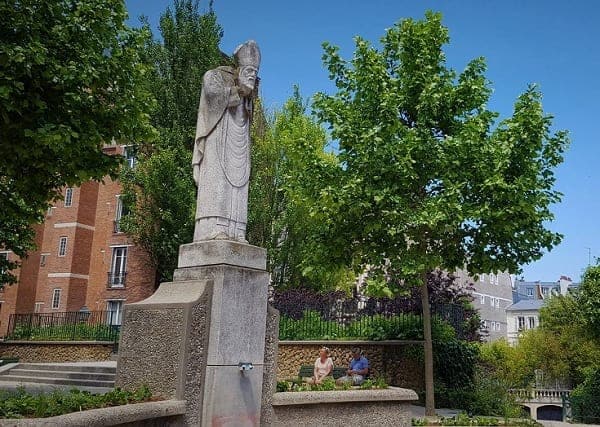
Saint-Denis was beheaded here on the hill by the Romans in the 3 rd Century.
According to legend his corpse picked up his head and walked 10km to the point where the Cathedral of Saint-Denis now stands in the suburbs of Paris.
Every French king is buried at Saint-Denis and it’s great for a visit if you get the time.
Historically, the name Montmartre, the Hill of the Martyrs, has been attributed to this event.
However, most historians today think the hill was already known as Montmars, the hill of Mars, by the pagans before the advent of Christianity.
Buste Dalida
Exit the park the same way you entered and continue down Rue Girardon.
At the corner, where it turns to the right onto Rue L’Abreuvoir ( map ), you will see a small bust of the famous Egyptian-Italian-French singer Dalida.
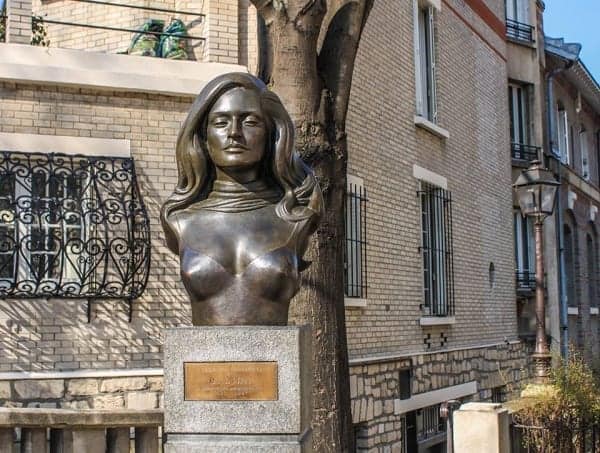
Dalida had an incredibly successful career but tragic love life.
Her first fiancé shot himself, her husband shot himself, her friend jumped to his death from a Paris apartment and her final lover gassed himself in his Renault car.
All this became too much and Dalida overdosed on barbiturates in 1987 leaving a note saying; life has become unsupportable for me. Can you blame her?!
Rue L’Abreuvoir
This charming street was immortalized by the painter Maurice Utrillo. Utrillo was one of the few painters born in Montmarte.
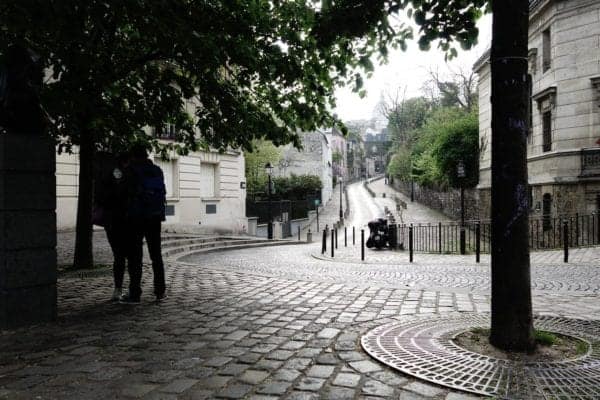
His mother Suzanne Valadon was the first woman admitted to the society of fine arts and learned her art from the countless painters she’d modeled for as a young woman.
Her former house is now the Montmarte Museum just ahead at number 12 Rue Cortot.
When Valadon fell pregnant she didn’t know who the father was. According to one Montmartre resident at the time; “she went to Renoir, but he looked at the baby and said, ‘can't be mine, the color is terrible’!
So she went to Degas, who said, 'He can't be mine, the form is awful!'
Valadon then saw an artist named Miguel Utrillo and told him her woes. He told her to call the baby Utrillo: 'I would be glad to put my name to the work of either Renoir or Degas!”
La Maison Rose
On the corner with the Rue des Saules ( map ), you’ll see the Maison Rose, or pink house, where Utrillo and many other painters used to hang out.
Upstairs was once a brothel where Van Gogh is reported to have contracted syphilis.
Today it’s been cleaned up and is a lovely spot for a bite to eat! Honestly!
Au Lapin Agile
Turn left down Rue des Saules with the vineyard on your left and stop on the corner by the Lapin Agile ( map ).
This little cabaret started life as a hang-out for low-lives and criminals.
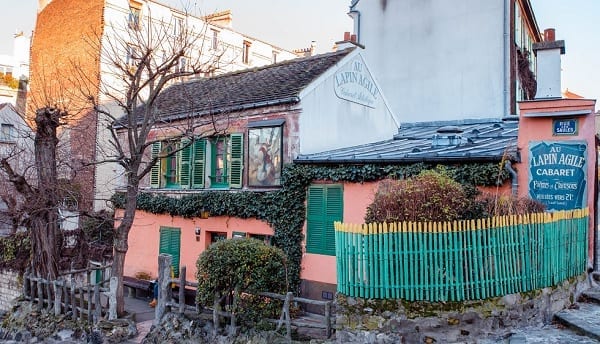
After the owner’s son was killed in an attempted robbery, the place was known as the Cabaret des Assassins.
But, fortunes changed when Andre Gill painted a new sign with a rabbit jumping out of a saucepan. People started to refer to the place as Gill’s Rabbit and this later changed to the Agile Rabbit.
At the turn of the 20 th Century the place was bought by Aristide Bruant to save it from closing and it became a favourite meeting place for struggling artists.
A young Picasso used to flirt with the waitresses and doodle their portraits on napkins in exchange for them letting him off the bill!
This is still a Cabaret today and well worth a visit for a more intimate and less bank-breaking French cabaret experience.
Le Jardin Sauvage
Turn right on Rue de Saint-Vicent and you’ll head past the old wild garden vineyards.
The wine they made here was Beaujolais, some of the first wines of the season and cheap wines for the people of Paris.
Unfortunately, the wine crops failed for several years in the late 19 th Century and this is where the tradition of drinking absinthe came from.
Once the wine stocks returned, many poor artists preferred to stick to absinthe as it was cheaper.
In order to get their customers back, many vineyards began spreading the idea that Absinth made drinkers go mad, hallucinate and commit all sorts of terrible crimes.
They also tried to get its sale prohibited. The legend they invented of hallucinogenic trips with the ‘green fairy’ persists to this day.
Le Sacré-Coeur
Continue uphill along Rue de Saint-Vicent. You’ll cross the path with the stairs heading up and down the hill.
The view down the hill is beautiful but we’ll continue uphill on the more gradual incline.
As the road bends to the right you’ll suddenly catch a view of the back of the Sacré-Coeur Basilica ( map ).
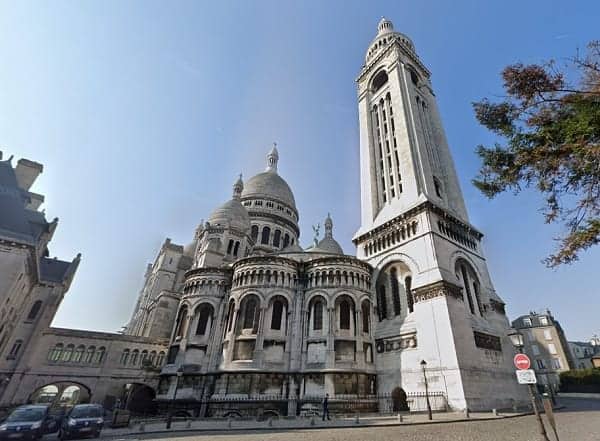
Le Sacré-Coeur Rear
The basilica was built to make up for what many saw as the moral corruption for which they blamed for the French defeat in the 1870-71 Franco-Prussian War
When Prussian troops took Paris in January 1871, the French Government and Army surrendered.
However, the working-class National Guard and the people of Paris refused to accept the surrender or the authority of the French Government and created an autonomous commune up here in Montmartre.
This was the first example of the working-class rule in the history of the world, but it only lasted a few months.

Barricade set up by Commune shown captured by French Army forces
In May French troops attacked and destroyed the Commune in what became known as the Semaine Sanglante or bloody week
On both sides, terrible atrocities were committed and the Sacré-Coeur was seen as a way to atone for those sins.
Construction of the basilica began in 1875 but didn’t finish until during WWI, so it was only consecrated after the war in 1919.
Let’s head around the church to its right, at the front you’ll get the most spectacular view of Paris, prepare to have your breath taken.

View of Paris from Le Sacré-Coeur
Take all the time you need to drink in the incredible views of Paris. In the afternoons the steps will be packed with people listening to street musicians.
Once you’ve regained your breath, turn back to the basilica and you’ll see two statues of people on horseback.
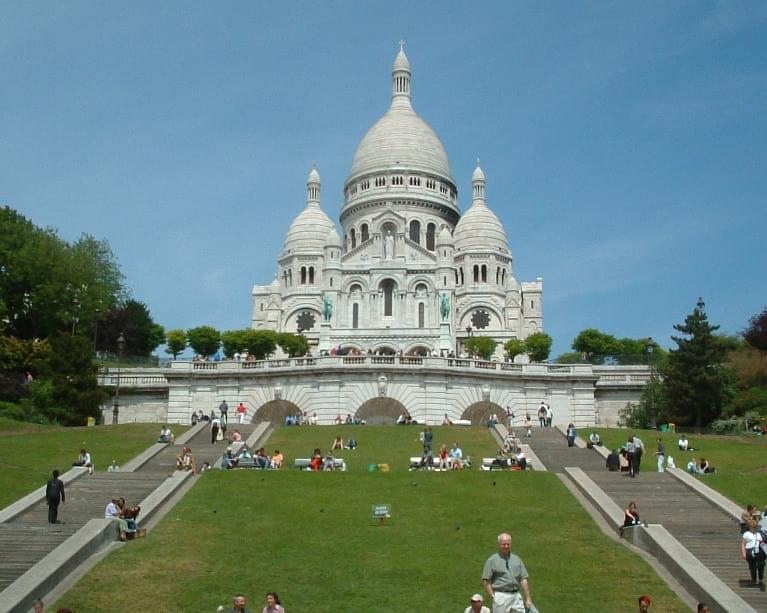
Le Sacré-Coeur Front
The statue to the left is King Louis IX, the only king of France to be made a saint.
Louis brought in the right to a fair trial and banned medieval trials by torturous ordeals like walking over hot coals.
From his fights in the crusades, he brought back holy relics that you’ll find today in the Sainte-Chapelle in the centre of Paris.
The statue on the right is Joan of Arc. During France’s darkest hours when the English were conquering at will, Joan rallied the French armies and started their fightback.
She was captured and burned as a witch by the English ensuring her legend forever in history.
You can enter the Sacré Coeur free from 6 am – 10.30 pm. You have to pay to climb the dome and you’ll need strong legs to climb the 300+ steps!
Place du Tertre
Once you’ve checked out the church and got your breath back from the view turn right with the church at you back and head along Rue Azais.
Looking out towards Paris you’ll catch a glimpse of the Eiffel Tower, then turn uphill to the right. As the street bends left you’ll enter the Place du Tertre ( map ).

Place du Tertre on a rather slow day.
Today, as in years gone by, the square will be full of painters selling their art. If you’d like your own portrait they’ll be more than happy to paint you.
On the northern side of the square, the Mere Cathrine restaurant was the first Bistro in the world.
Russian soldiers at the end of the Napoleonic wars demanded their drinks quickly- Bystro in Russian, and the idea of a bistro or rapid service restaurant was born!
Salvador Dalí Museum Paris
Once you’re done in Place du Tertre, leave on the downhill corner, diagonally opposite to the side you entered.
At the end of the small street steps go downhill, do not take those, turn right on Place du Calvaire and you’ll come to the Espace Dalí Montmartre ( map ).

Salvador Dalí is today the most famous surrealist artist in history, which is ironic as the surrealists kicked him out of their movement!
Surrealism was a reaction to all the craziness of wars and destruction in the world.
A group of writers, poets, and painters led by Louis Bréton began to question whether the comforting world of our dreams was actually the real world and our crazy world just a nightmare.
To connect with the dream world, they tried to write and paint without thinking consciously.
This automatic writing, as they called it, can be fun to try and to read back to yourself, but generally reading the nonsense of someone else’s head isn’t too engaging.
Dalí’s painting seemed intended to provoke and he was kicked out of the movement for thinking too much about his work and more than anything for making too much money from it!
People are still making money from his work today , entrance costs €13 and is a must for fans of surrealism.
Bateau Lavoir
Continue on Rue Poulbot and turn left at the end on Rue Norvins then left on Rue Jean-Baptist Clément and right on Rue Ravignan into Place Emile Goudeau ( map ).
This hidden little square is named after the leader of Les Hydropathes, who we met right at the start of our tour.
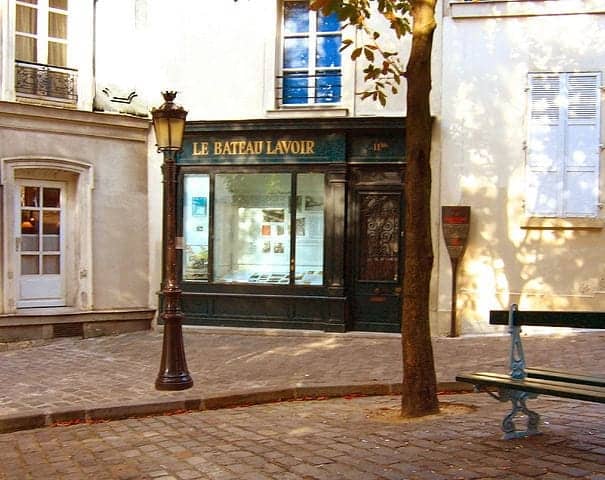
On the right, as you enter downhill, you’ll find the Bateau Lavoir which is steeped in art history. Only the façade remains for the original building after a fire in the 1970s.
But, at the turn of the 20 th Century the creaky building would sway in the wind like the washing boats on the River Seine, hence its name- the washing boat.
The name was coined by Picasso’s life-long friend the writer Max Jacob.
The original Bateau Lavoir had many floors below going downhill towards the back, and when Picasso arrived in Paris in 1900 the place was packed with struggling artists.
Picasso had been painting in dark blue colors since his arrival in Paris when his best friend shot himself over unrequited love.
But living here Pablo met his first love, Fernande Olivier, and began painting in happy pink or rose colors, he then moved on to experiment with African masks and created the first-ever cubist painting here in 1907.

The impressionists had been moving away from 100% accurate depictions of their subjects.
But in Les Demoiselles d’Avignon (see picture) Picasso took the art rule book, ripped it up, and threw it out of the window, representing five ladies with hard angular blocks of color.
Avignon is in the South of France but most people now think this painting is of five prostitutes from the Carrer d’Avinyó in Barcelona where Picasso grew up.
Picasso and his friends were poor struggling artists but always to be found out and about in Montmartre.
If you’re on the Picasso trail, check out the Picasso Museum in le Marais .
Murs de j’taime – The love wall
Leave the square downhill on Rue Ravignan and turn on Rue de Abbesses to Place des Abbesses.
On the upper side of Place de Abbesses you’ll find a small park with I love you written in over 250 languages.
The wall was created by the artists Frédéric Baron and Claire Kito and is a must for lovers and honeymooning couples.
If you come back this way Abbesses is the nearest Metro stop ( map ) to the top of the hill but its spiral staircase is hard work for all but the fittest of visitors.
If you’re looking for a place to eat, there are many great restaurants for all budgets around here.
A personal favourite of ours is l’Annexe on Rue des Trois Frees or for something fun and different, the Refuge de Fondues on the same street where the wine is served in baby’s bottles!

Refuge de Fondues
Take Rue Yvonne le Tac and Rue Tardieu across the hill (neither up nor down) and you’ll arrive at a park with fantastic views back up to the Sacré-Coeur.
This is where Amelie calls her lover on the payphone and tells him to follow the blue arrows.
Hopefully, you’ve enjoyed our time in this most romantic of neighbourhoods.
If you’re done with Montmarte just head down Rue de Steinkerque to Place Anvers where you’ll find the Boulevard where we started and the Metro station Anvers to head off to your next Paris destination.
If you’d rather hang around longer and explore, just remember whichever way you go downhill on the Sacré-Coeur side of the hill, you’ll hit the big Boulevard where we started and where you’ll find a Metro station.
Related Posts:
- Île de la Cité and Latin Quarter Self Guided Tour
- Banks of the Seine Tour (The Last Rulers of France Tour): Self Guided Paris Tour
- Paris Transport Guide
- Things to Do in Paris
If you're interested in a different kind of experience, there is a self-guided exploration game in Montmartre which tasks you with solving a mystery as you're discovering the area.
GUIDED WALKING TOURS
There are 4 main companies leading live-guided walking tours of the Montmartre District, including one pay-what-you-wish tour.
If you're looking for a different kind of experience, there is a self-guided exploration game in Montmartre which gives you the opportunity to solve a mystery while discovering the area.
We also offer our own, GPS-led audio tour , developed and narrated by a local tour guide, which you can take it anytime you wish.
Disclosure: We think you should consider our free tours , but we have also provided other options. While our recommendations are always unbiased, we may receive a small share of sales through some of the links below at no cost to you. See the full text .
Discovery Walks
Discovery Walks offer a 90-minute tour of Montmartre, visiting the areas from Moulin Rouge to the Sacre Coeur Cathedral.
The tour is name-your-own-price, leaving you free to decide its worth or what you could afford at the end. Group sizes can exceed 20 people, but reviews don't support this as an issue.
Montmartre Tour: Moulin Rouge to Sacre Coeur
- Departs daily at 11:00 am, 14:30 (2.30 pm)
- Pay-What-You-Like
- Book this tour .
New Europe Tours
At €16 per person, this is a reasonably priced option for those looking to explore this artistic neighborhood.
Like with other tours, you will learn about the famous figures who frequented Montmartre throughout history before finishing at the Sacre Coeur Cathedral.
New Europe tends to be popular with backpackers, so expect a younger crowd and larger(ish) group sizes.
Montmartre District Tour
- 2 hours
- Departs daily at 11 am and 6 pm
- €16 per person
- Get more information or to book .
Free cancellation up to 24 hours before the tour.
This company offers a variety of popular tours in Paris, including two outings that will take you through the neighborhood of Montmartre.
Their main Montmartre tour is approximately 1 ½ hours in length and it covers several notable sites such as Moulin Rouge, the Wall of Love, Picasso's Studio, and many other historic locations.
Alternatively, you can also take their Paris in a Day tour and visit additional neighborhoods such as the Latin Quarter and notable attractions like the Eiffel Tower and the Louvre museum.
Montmartre: Paris' Picture Perfect Village
- €15 per person
- Duration: 1 ½ hours
- Maximum of 20 guests.
- Includes stops at several notable locations.
Paris in a Day
- €165/Adults | €163/Students | €155/Children
- Spring/Summer Availability: Wed - Mon at 9 am
- Fall/Winter Availability: Mon, Wed, Sat at 9 am
- Duration: 9 hours
- Maximum of 15 guests.
- Includes admission to the Louvre.
- Includes admission to the Eiffel Tower.
- Includes Seine River cruise.
Fat Tire Tours
Though known around Europe for their fabulous bike tours, Fat Tire Bike Tours also lead walking tours!
Their Montmartre 2-hour walking tour is one of their most popular, as it visits all of the main attractions in this popular neighborhood.
This tour and Fat Tires as a company are both well-reviewed, averaging over 4 out of 5-stars on TripAdvisor and Get Your Guide ( read the reviews ).
This is the most expensive option in this section, but they also have the smallest group sizes and tend to attract a more mature clientele.
Paris: Montmartre 2-Hour Walking Tour
- Departs Wednesdays and Fridays at 10:00 am, and Sunday, Monday, and Thursday at 15:00 (3 pm)
- €25 per person
- Get more information or to book .
SPECIALTY WALKING TOURS
Montmartre impressionist art walking tour with skip-the-line musee d'orsay ticket.
This 1.5-hour tour is perfect for art lovers who are interested in learning the colorful histories of artists such as Van Gogh, Degas, and Monet.
With your purchase, you also receive a skip-the-line ticket to the Musee d'Orsay ticket, which is a great bonus considering the huge crowds that this museum usually attracts.
This tour is very well reviewed on TripAdvisor and Viator ( read the reviews ).
- Departs Sunday, Tuesday, Thursday, Friday, and Saturday at 10:30 am and 2 pm
- From €45 per person
- NOTE: This tour isn't currently available as of March 2024.
Meeting the French Tours
Meeting the French Tours are known for their specialty tours of Paris and offer 2 tours of the Montmartre District:
- (1) Paris Movie Tour of Montmartre and
- (2) Paris Romance Walking Tour of Montmartre.
As specialty tours, they are significantly more expensive than the traditional guided tours listed above.
However, for film aficionados and diehard romantics, these tours are totally worth it!
On the Paris Movie Tour of Montmartre, you will learn about filming rights in Paris and why Montmartre is such a popular place for filming, in addition to visiting several major filming locations for world-famous films.
Paris Movie Tour of Montmartre
- Departs daily at 10 am or 5 pm
- From €85 per person
- More information or to book .
The Paris Romance Walking Tour of Montmartre visits Moulin de la Galette, the ‘I Love You Wall,’ Studio 28 and other famous love-struck sights, as well shares stories about Paris’ history and culture of love and romance.
Paris Romance Walking Tour of Montmartre
- Departs daily at 2 pm or 4 pm
- From €65 per person
Paris is often considered one of the greatest culinary cities in the world... and with good reason!
And as a bustling neighborhood with an important history, Montmartre is one of the best places to dine.
This 3-hour culinary adventure will have you sampling homemade pies, cheese, charcuterie, and a glass of wine as your walk through the Montmartre District.
You will learn how these items are made, as well as how Parisien's shops traditionally prepare each dish every day.
Also, you will learn more about the culinary history of the neighborhood.
Food is included in the price of the tour.
Montmartre Gourmet Tour
- Departs daily at 2:30 pm
- From €95 per person
Culinary Tours of Paris
Named after Ernest Hemingway's famous novel set in Paris, Montmartre Moveable Feast Tour is a culinary tour of one of Paris's most famous neighborhoods.
With Culinary Tours of Paris, you will visit 3 different restaurants, enjoying 1 course at each. In the first, you get to sample an appetizer or charcuterie and fromage.
After moving on to the second stop, you will be served the main course, before finally eating a dessert presented at the last stop.
Between restaurants, you are taken through the streets of Montmartre and told the history of the area.
The tour is approximately 3.5 hours and includes each meal with the cost of the ticket.
Montmartre Moveable Feast Tour
- Departs Wednesday-Sunday at 11:45 am
- € 110 per person
Choose a Destination... I want them all PLUS general travel tips. Amsterdam Berlin Boston Charleston Chicago Dubai Lisbon London Los Angeles Miami Nashville New York City New Orleans Paris Philadelphia Prague Rome San Francisco Washington DC
About The Author
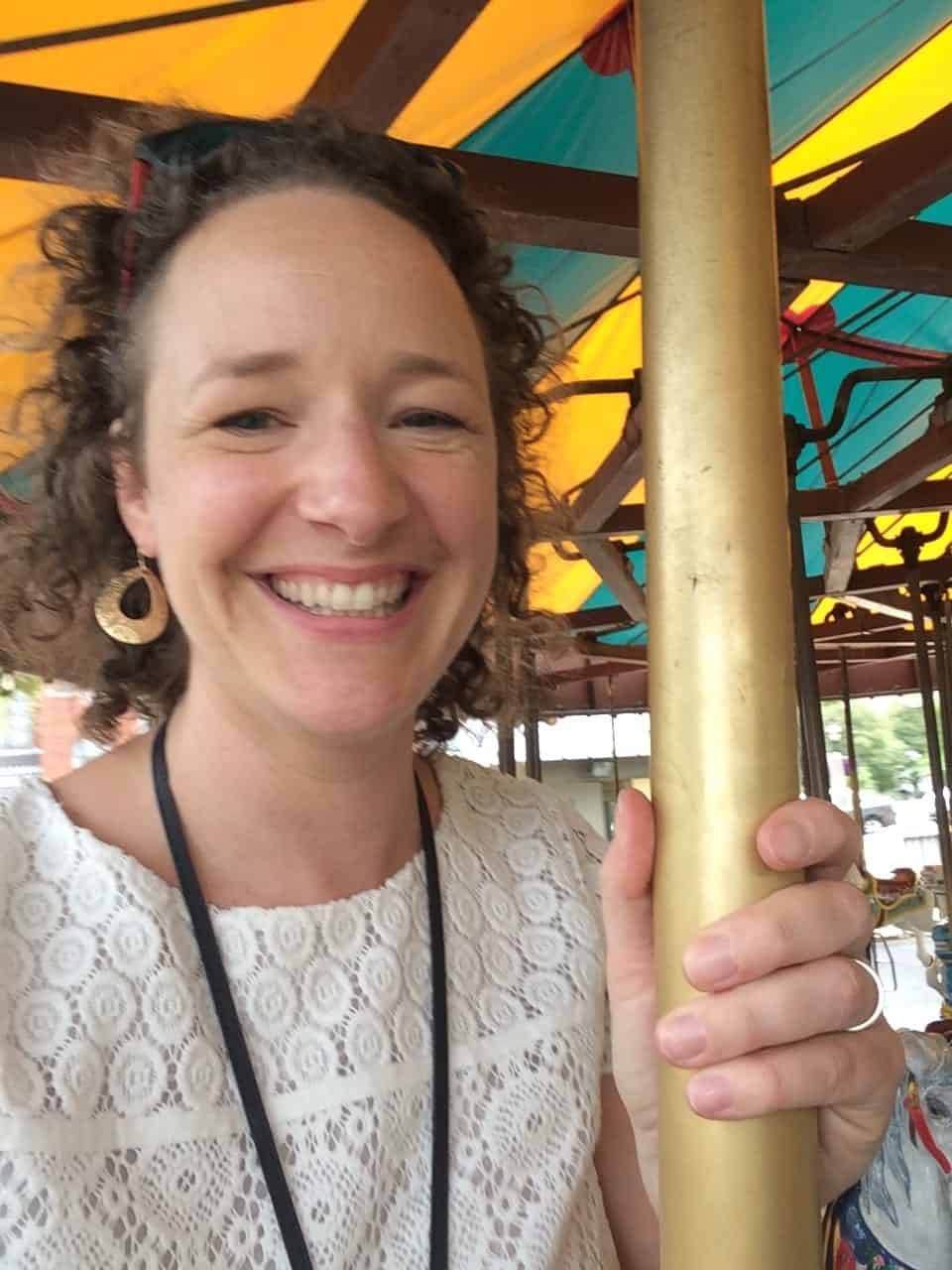
North America
United kingdom & ireland, middle east & india, asia & oceania.
Montmartre is one of the most charming neighborhoods in Paris.
With its rolling hills of cobbled streets and uninhibited bohemian atmosphere, Montmartre attracted artists such as Toulouse-Lautrec, Van Gogh and Picasso during the Belle Époque.
This neighborhood was a picturesque town with small farms, vineyards, and windmills, independent until 1860, when it became an arrondissement of Paris .
In terms of accommodation , few neighborhoods have as much charm as this one. Because? We tell you, come on!

The Montmartre painters
At the end of the 19th century Montmartre became notorious for the cabarets and brothels that opened in the area, but artists such as Monet, Dalí, Picasso, van Gogh, Renoir and Degas moved here, attracted by a cheaper and more liberal cost of living, and they built an artistic community that helped shape the spirit of what Montmartre is today.
What to see in Montmartre
Walking through Montmartre is like traveling back in time.
The main streets of Montmartre could be said to be rue des Martyrs, rue Lamarck, rue Caulaincourt and rue des Abbesses. But the most picturesque are those that surround the Plaza de Tertre and the Sacre Coeur .

Place du Tertre
The Place du Tertre or Plaza de Tertre is the “artists’ square in Paris”. For more than 140 years, since the Belle Époque, the Place du Tertre has been a paradise for painters.
The artists, many of them graduates of prestigious schools of Fine Arts, are assigned a small space of one square meter from the many stalls that divide the small square. Each stall is used by two artists who work alternate days.
To get a place in the Plaza de Tertre you have to present a portfolio that shows your skills and sign up for a waiting list that can take up to a decade.
Only painting is allowed, preferably of Parisian landscapes, portraits, caricatures and silhouettes. Around the square you will find numerous terraced cafes, souvenir shops, traditional restaurants and a very lively atmosphere.

Sacre Coeur
Sacred heart.
In the highest part of Montmartre is the Basilica of the Sacred Heart , an emblematic monument of the city built in travertine and in the Roman Byzantine style.
The Sacre Coeur and its surroundings are worth a visit, if only to admire the view of Paris from the Place Louise-Michel , located at the foot of the basilica.

vineyards of Montmartre
Behind the Sacre Coeur you find the rue des Saules , where the oldest vineyard in Paris, Vignes du Clos Montmartre, is located . It was planted in 1933 with mixed grape varieties from different regions.
Since 1934, every second weekend in October, Montmartre celebrates its winemaking tradition and welcomes the arrival of the new harvest from its vineyard with a traditional popular festival.

Moulin Rouge
Blanche and Pigalle squares are located (with their neon lights announcing shows and sex shops), there is a different atmosphere, a bit decadent, of partying and spectacle, and it is here that the famous Moulin Rouge .
The Moulin Rouge’s “Féerie” show presents 100 performers in 1,000 costumes of feathers, beading and sequins designed by Corrado Collabucci. It is a memorable show.
More interesting places to visit in Montmartre:
- At 49 rue Gabrielle, you can find Picasso ‘s first Parisian apartment and studio . Where he lived in 1900.
- At 22 rue des Saules is Au Lapin Agile , one of the oldest cabarets in Paris.
- Also on rue des Saules you will find a mythical restaurant, La Bonne Franquette . Artists such as Degas, Renoir and Monet used to gather here. And it was in the garden of this place that Vincent Van Gogh painted his famous painting La Guinguette, in 1886.
- The Montmartre Museum is housed at 12 rue Cortot, in the Maison du Bel Air, the oldest house in the neighborhood. Where there was also a Renoir workshop , where the painter carried out his work Le Moulin de la Galette in 1876.
- At 11 rue Poulbot, you’ll find the Dalí Paris , a permanent exhibition of surrealist art by Salvador Dalí with an emphasis on sculptures and prints. Buy Dalí Paris tickets .
- The Montmartre Cemetery , at 20 Av. Rachel, is the resting place of the likes of Émile Zola and Degas. You can take a quiet walk through its gardens.
- The well-known Je t’aime Wall , or I Love You Wall, with the word “I love you” in 250 languages, is a popular meeting place. You can visit it in Jehan-Rictus Square, near Abbesses Station.
A good way to get in touch with the neighborhood without spending too much is by participating in the Montmartre Free Tour, one of the free tours in Paris with the best opinions and completely in Spanish.
Movie neighborhood in Paris
Blockbuster films such as La vie en rose , Amelie and Midnight in Paris have also been shot in Montmartre .

Take a look at our Amélie tour to discover the places in the neighborhood that appear in the famous film.
Montmartre funicular
Another particularity of this neighborhood of Paris is that it has a public transport service that only works here: the Montmartre Funicular .

Sacré Coeur de Paris and the Place du Tertre are located . Useful if you want (or need) to save yourself the almost 200 steps to the top.
If you decide to live for a few days in this charming neighborhood, check out these Hotels in Montmartre .
Tip: The Paris Pass includes a walking tour of Montmartre.
More attractions in Paris
Keep planning your trip to Paris with these ideas
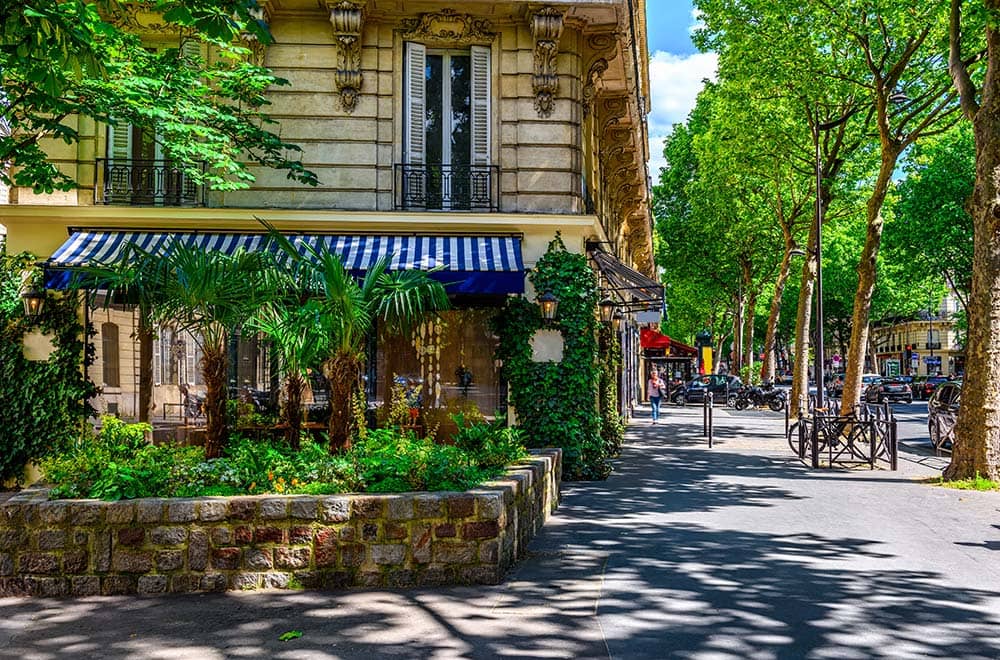
Saint-Germain-des-Prés
Elegant district of Paris with a beautiful boulevard full of stores, famous historic cafes and a medieval church.
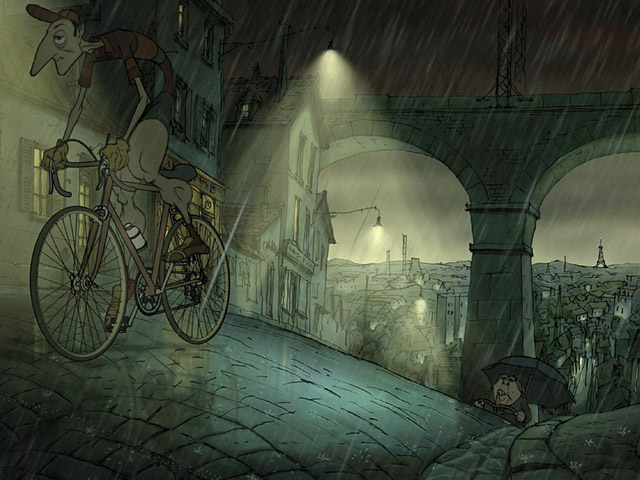
Orsay Museum
Exhibition of 19th century fine arts including impressionist art by artists such as Manet, Degas, Renoir, Cezanne and Monet.
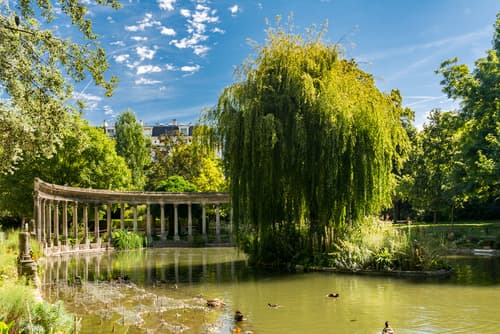
Parks and Gardens of Paris
Spaces of relaxation and inspiration, scattered throughout the city. Visit the parks and gardens of Paris, find the nearest one in this list.
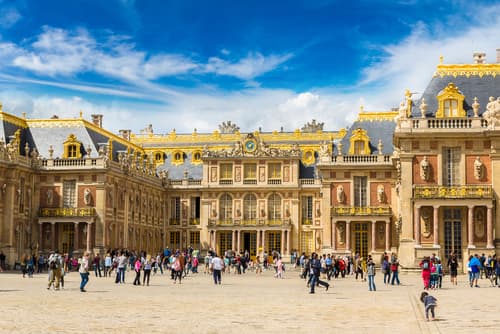
Palace of Versailles
A few minutes from the center of Paris is the Château de Versailles. A worthwhile excursion. You can buy your tickets here and find out how to get there.


Free self-guided walking tour of Montmartre, Paris (with map)
Posted on Last updated: March 7, 2024
Explore Paris’ bohemian, artistic neighbourhood with this free walking tour of Montmartre’s artistic history, beautiful architecture, pavement cafés and scenic views – map and directions included.
* This site contains affiliate links , where I get a small commission from purchases at no extra cost to you.
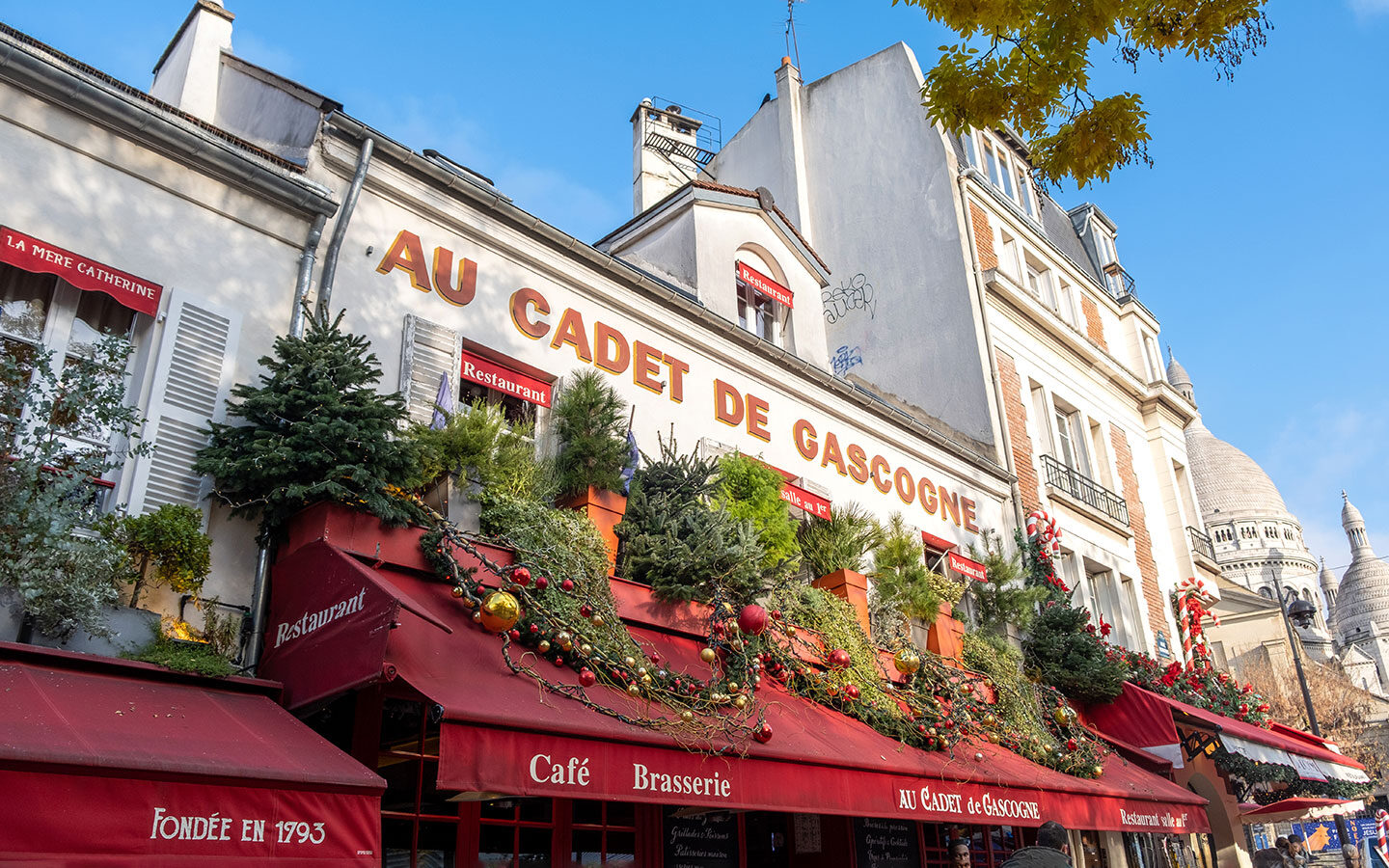
The hilltop neighbourhood of Montmartre, Paris , is one of the city’s most popular tourist spots. But not too long ago it was synonymous with drinking, dancing and debauchery. In the mid-19th century, Montmartre was just outside Paris’ city limits so it was free of the city’s taxes and controls and evolved into a bohemian, artistic enclave.
The artists you’ll see now are more likely to be caricaturists and painters capturing tourists in the Place du Tertre than Impressionists drinking absinthe in their atelier. But the area still has the feel of a charming small village within a big city, and this self-guided walking tour of Montmartre takes you through its historic and artistic highlights.
A self-guided walking tour of Montmartre
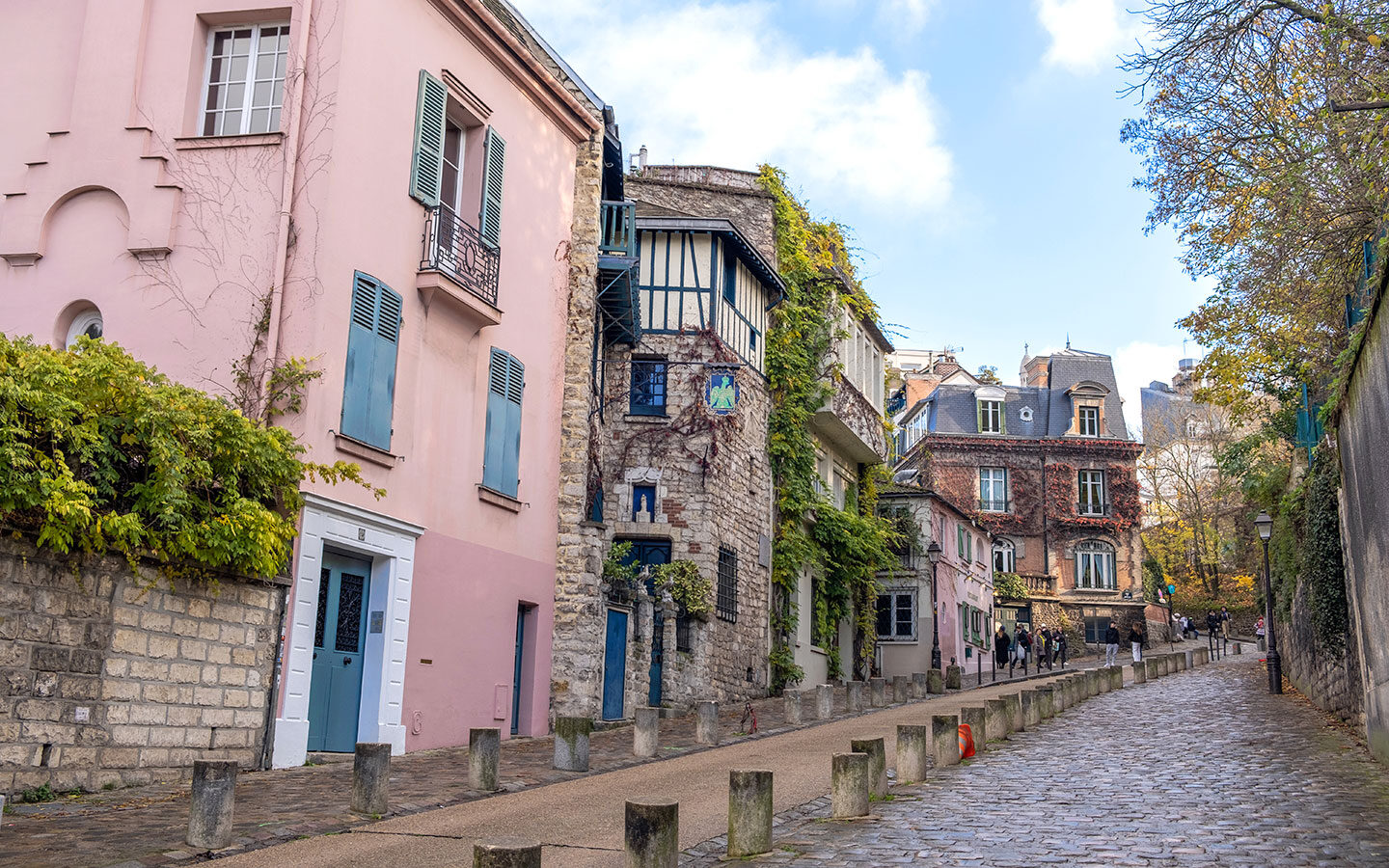
Start your Montmartre self-guided walking tour at Blanche Métro station, which is on Line 2 (or you could also take the Métro to nearby Pigalle on Line 12 which is only a five-minute walk along the Boulevard de Clichy). From there, walk up Rue Lepic – you’ll see the colourful Moulin Rouge cabaret hall on your left, home of the can-can.
Café des Deux Moulins
If you’ve seen the film Amélie then you might recognise a few of the shops along Rue Lepic, including the Café des Deux Moulins on the corner of Rue Cauchois. In the film, the main character Amélie Poulain, played by Audrey Tautou, worked here as a waitress.
The tobacco counter that featured in the film might not be there any more, but the café still has that classic Parisian bistro feel with its dark woodwork, red booths and zinc counters. There are a few nods to the film too, with a poster of Amélie on the wall and a tasty crème brulée d’Amélie on the menu if you’re in need of a sugar hit.
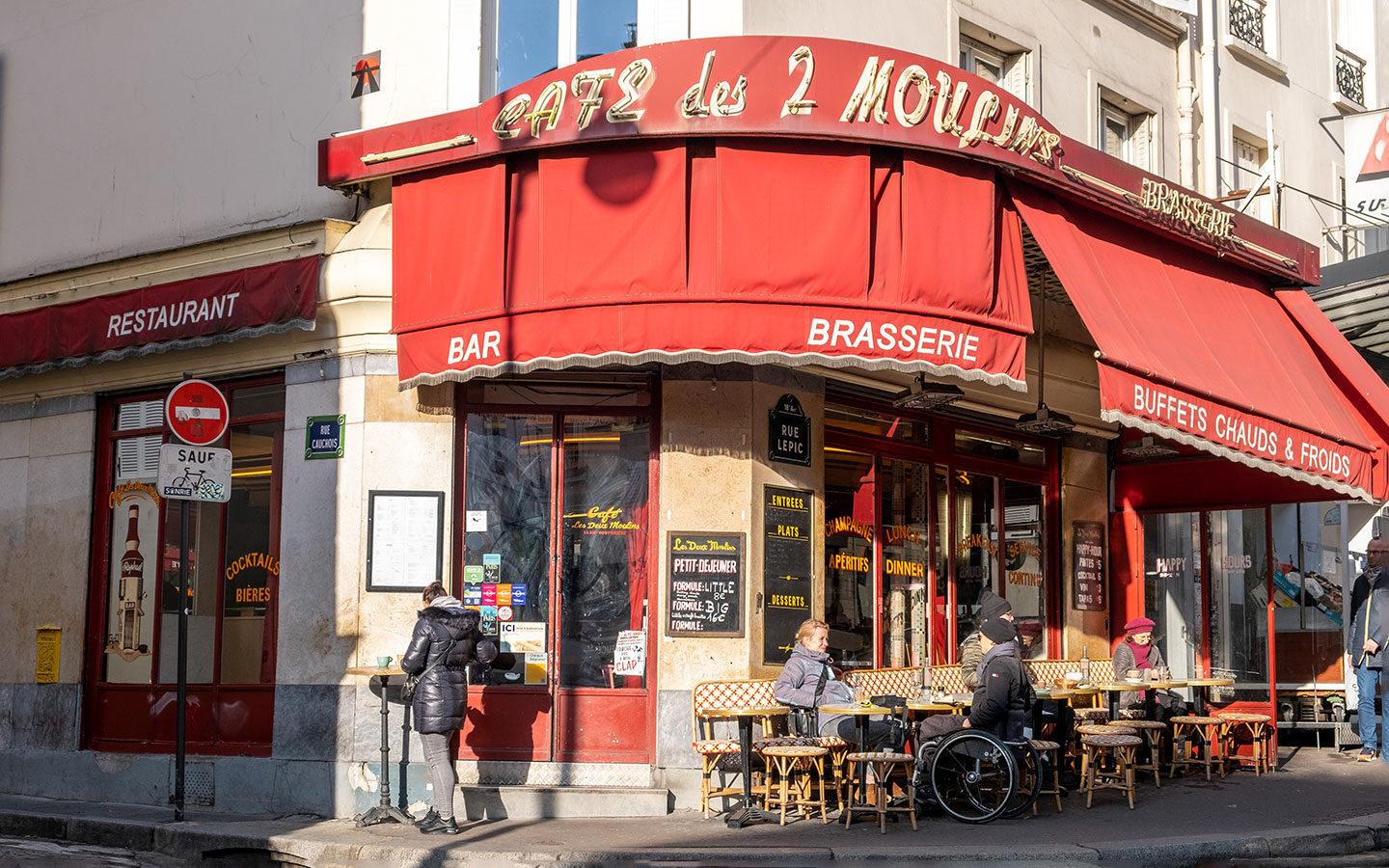
Carry on along Rue Lepic, then when you come to the junction at the end, take a short diversion to the left to see the exterior of number 54 Rue Lepic. This was where Vincent Van Gogh lived with his brother Theo from 1886 to 1888, and he did several paintings of the view of Paris from the window of their third-floor apartment.
Then retrace your steps back to the junction and continue on down Rue des Abbesses. Turn left into Rue Ravignon and follow it to Place Émile Goudeau.
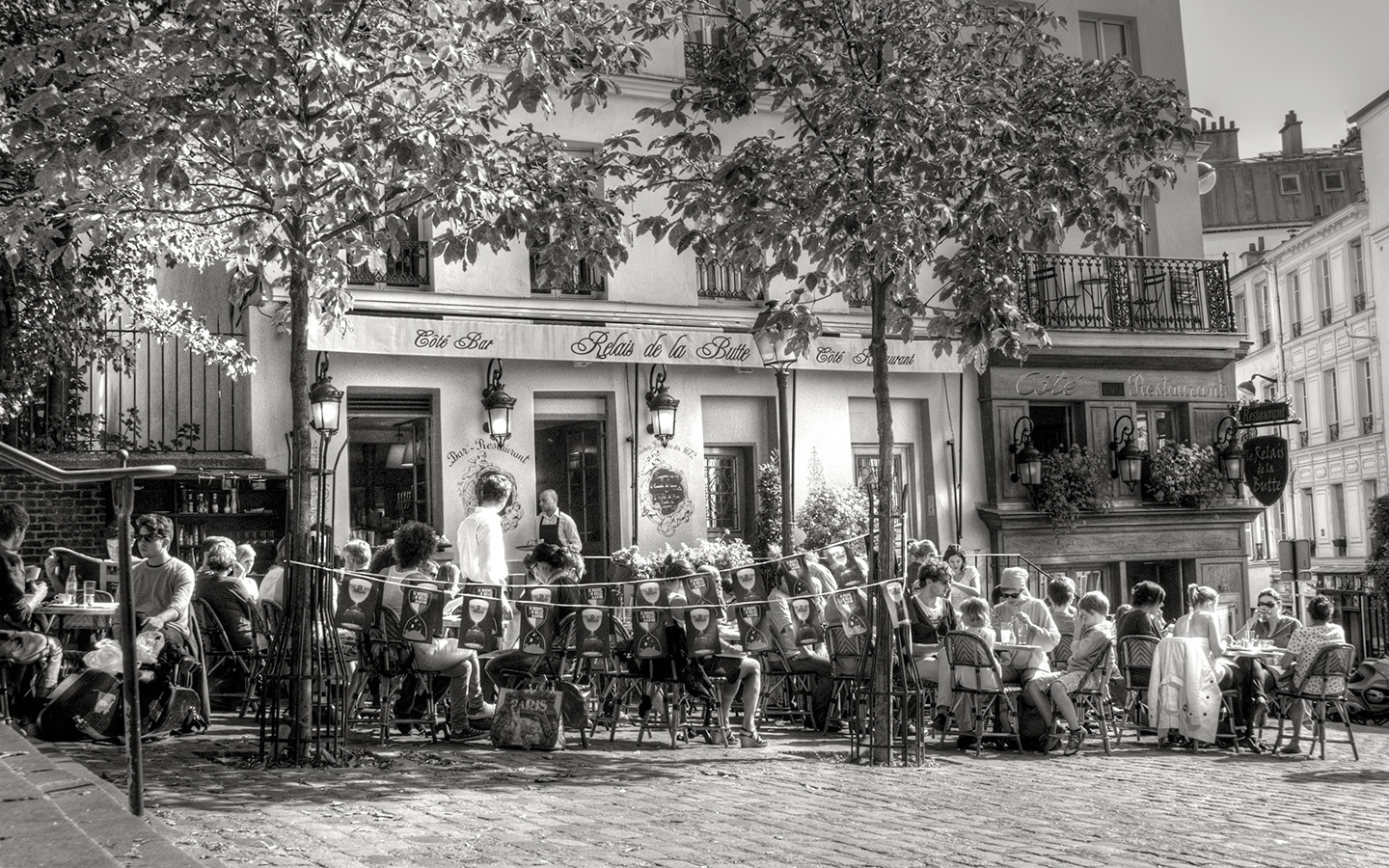
The Bateau-Lavoir
Place Émile Goudeau was at the heart of Montmartre’s art scene in 1889 as the home of the Bateau-Lavoir artists’ commune. This former factory was divided into 20 small studios. It was dark and dirty, had no heating and was so unstable it creaked and swayed on stormy days just like the laundry boats on the Seine that gave it its nickname.
But the Bateau-Lavoir was also was a hotbed of talent. Artists like Picasso, Matisse and Modigliani passed through its doors as well as composers, writers, actors and art dealers. They started moving out after the First World War and most of the original building was destroyed in a fire in 1970, but you can see its frontage at 13 Rue Ravignan.
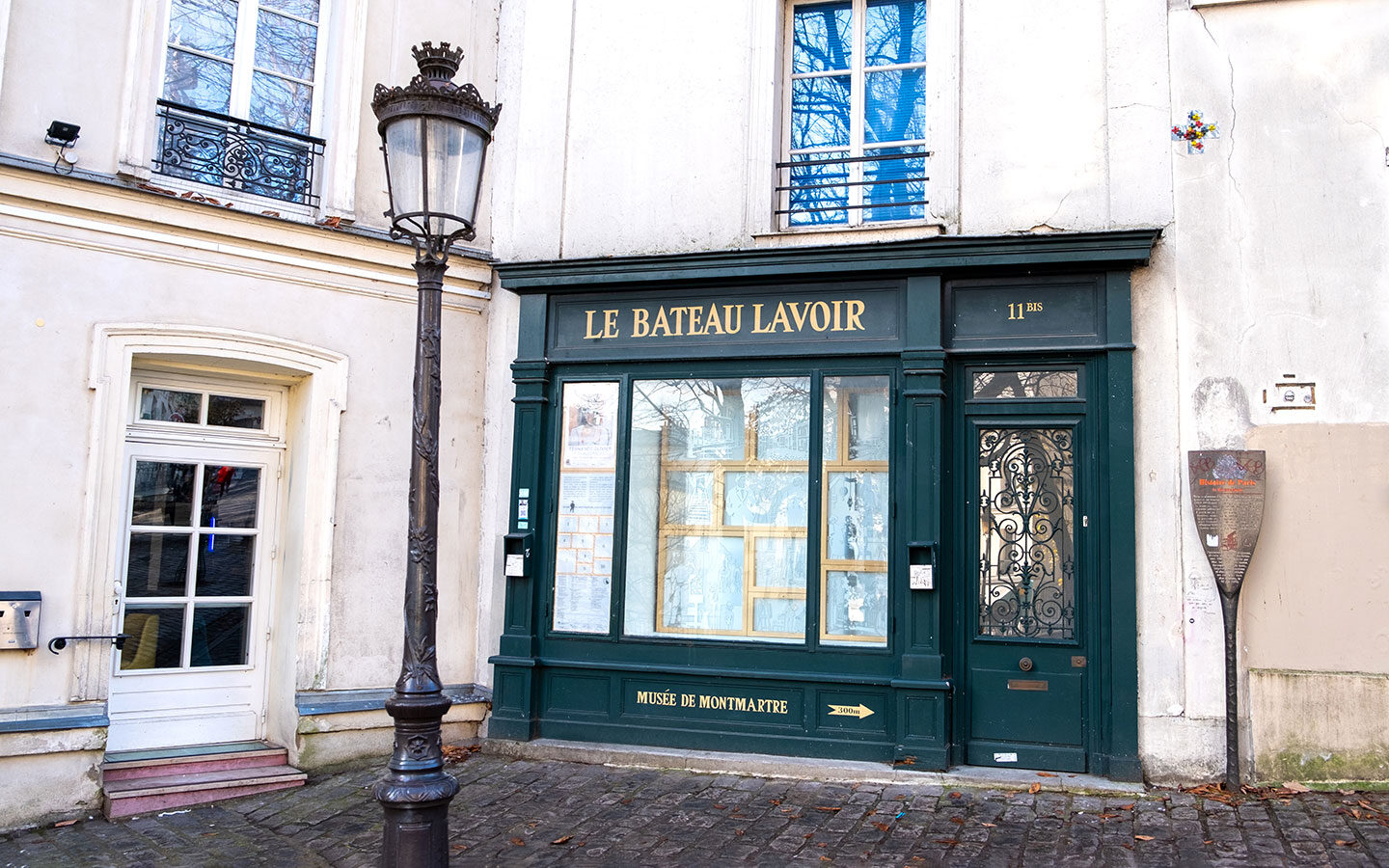
At the end of the square, take a left up Rue d’Orchampt and follow it until you reach the junction with Rue Lepic and Rue Girardon, where you’ll see a windmill in front of you.
The Moulin de la Galette
Montmartre’s 17th-century windmills originally ground grains to make the bread which gave the Moulin de la Galette its name. But they were later turned into cafés and dance halls where people could socialise with a glass of local wine and bread from the mill.
Parties at the Moulin de la Galette were popular with local artists, including Renoir whose painting Dance at Le Moulin de la Gallette is on show in the Musee d’Orsay. A smaller version sold for $78 million in 1990, making it one of the world’s most expensive paintings. The Moulin was also captured on canvas by Van Gogh and Picasso.
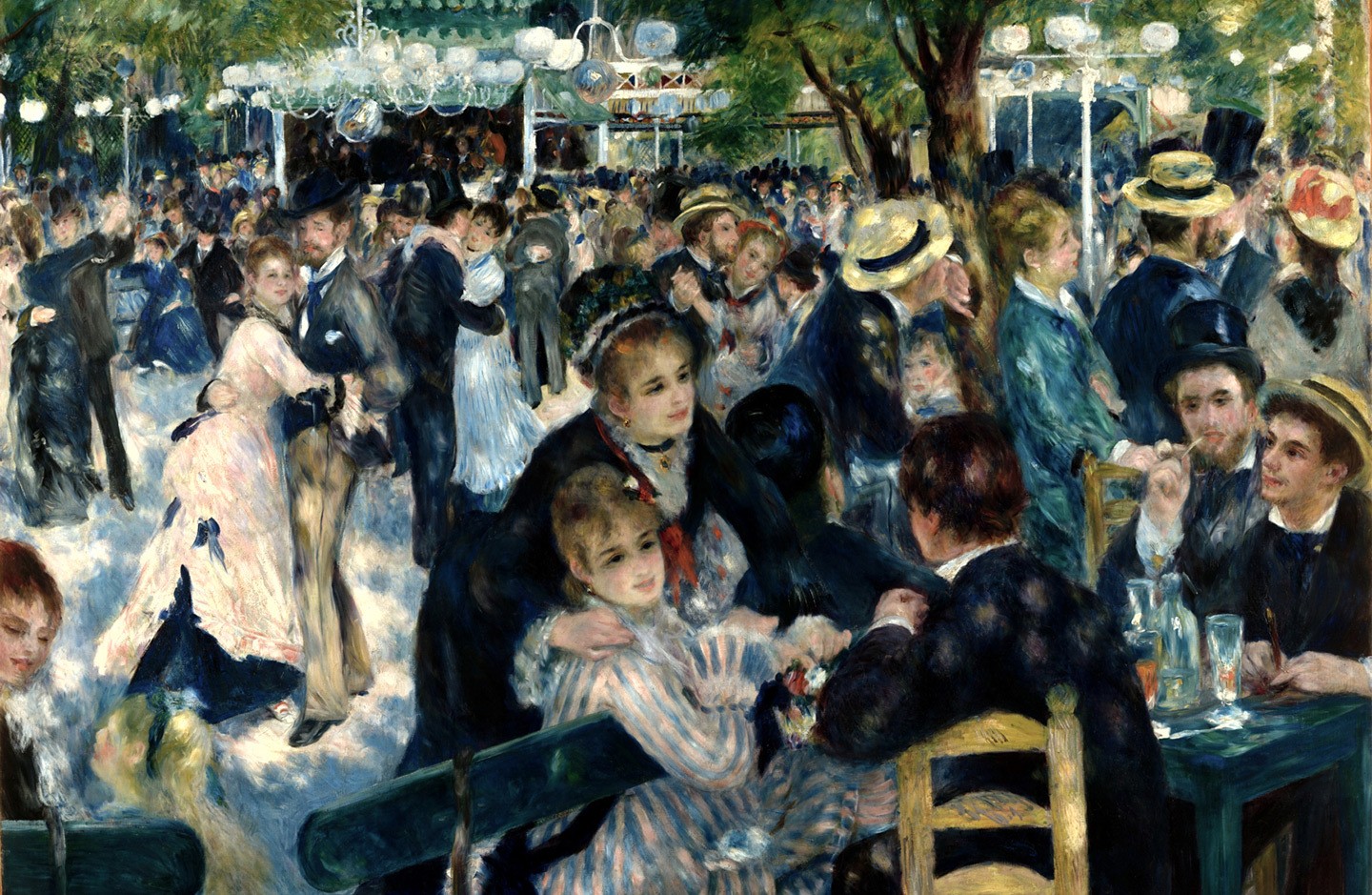
There were originally up to 30 windmills covering the hills around Montmartre, but only two are left now. The original Moulin de la Gallette (which is marked on maps as the Moulin de Blute-Fin, as that was its original name) is now private property so you can’t take a look around. But you can get a glimpse of it from Rue Lepic or Avenue Junot.
And in front of it is Montmartre’s other surviving windmill – the Moulin Radet, which was built slightly later in 1717. Today it sits on top of a restaurant (slightly confusingly) called the Moulin de la Galette , which has a terrace underneath the windmill.
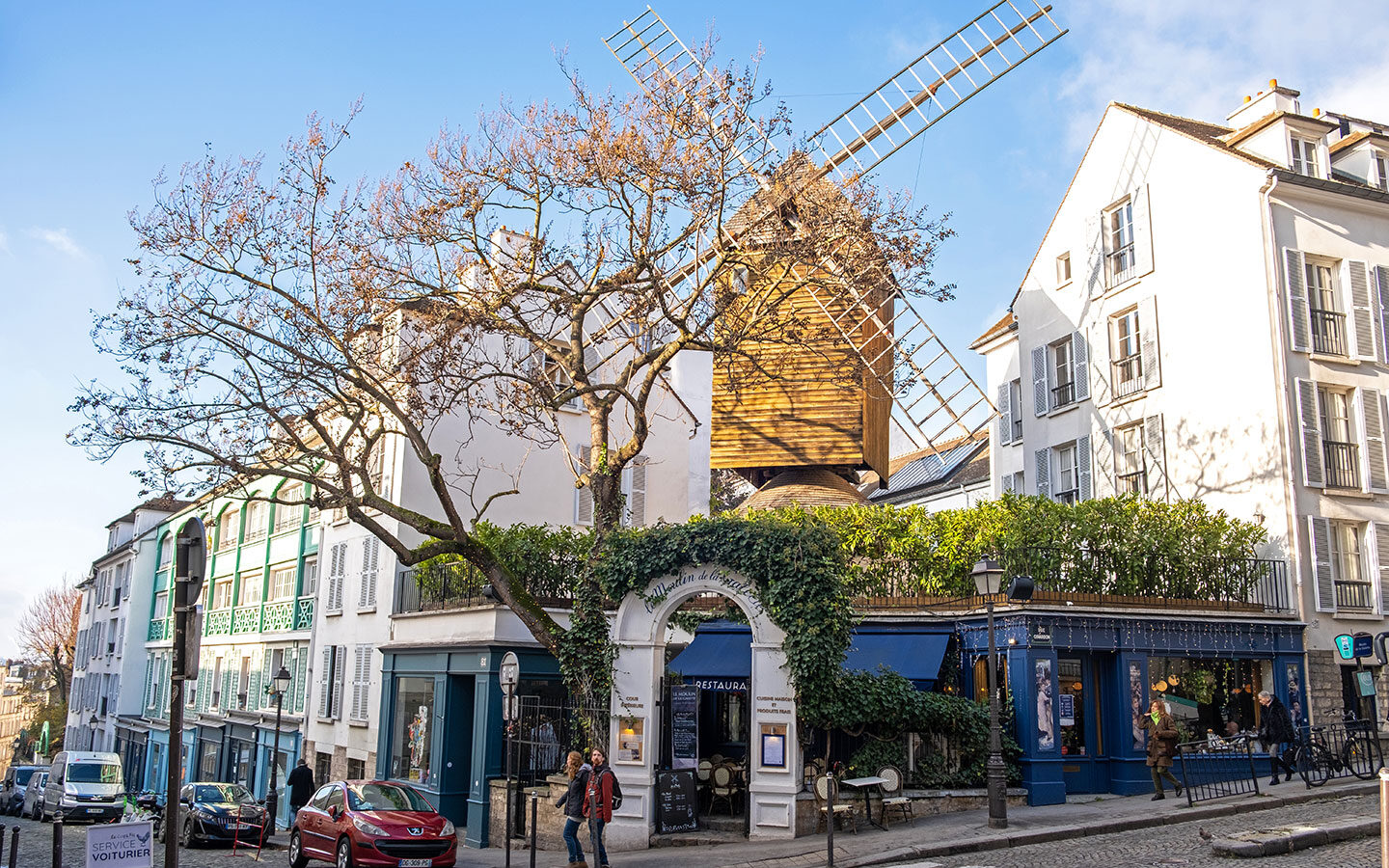
Next walk up Rue Girardon until it turns the corner into Rue de l’Abreuvoir, where you’ll see a small square with a bronze bust of a woman on your left.
Place Dalida
This tiny square is named after an Egyptian-born singer who became a huge star in France during the 1960s and 70s. Dalida – originally named Iolanda Cristina Gigliotti – lived on Rue de l’Abreuvoir and is commemorated with a bronze statue in the square.
She sold millions of records, but her life was full of tragedy, and after she lost several lovers and friends to suicide she eventually killed herself with an overdose in 1987 at her house in Montmartre. Dalida is buried in Montmartre cemetery nearby. And she’s still a cultural icon in France, with films, documentaries and over 50 biographies written about her.
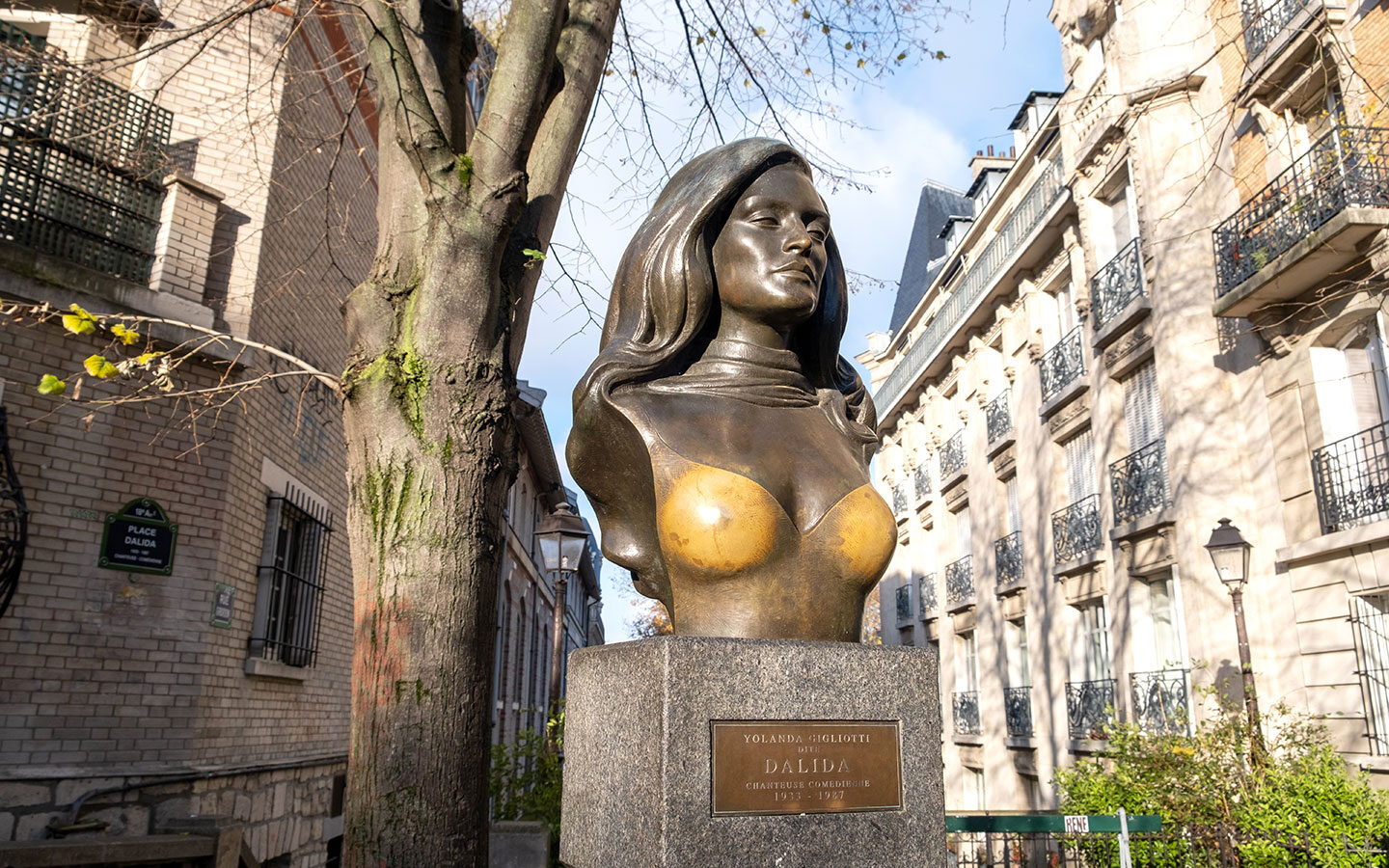
Carry on walking along picturesque Rue de l’Abreuvoir, which has great views of the white dome of Sacré-Cœur Basilica rising up behind the buildings.
Rue de l’Abreuvoir
With its ivy-covered houses, Rue de l’Abreuvoir is one of Montmartre’s prettiest streets. It’s though to be one of the oldest streets in Paris too, dating from the 14th century. Though the name (from the French for a watering trough used by livestock) came much later.
At the top of the street is La Maison Rose , a candy pink café and restaurant. It was once the home of Catalan painter Ramon Pichot, who turned it into a restaurant which hosted his friends Salvador Dali and Picasso. It was also painted by artist Maurice Utrillo. Today it’s a favourite for Instagrammers and a filming location for TV series Emily in Paris .
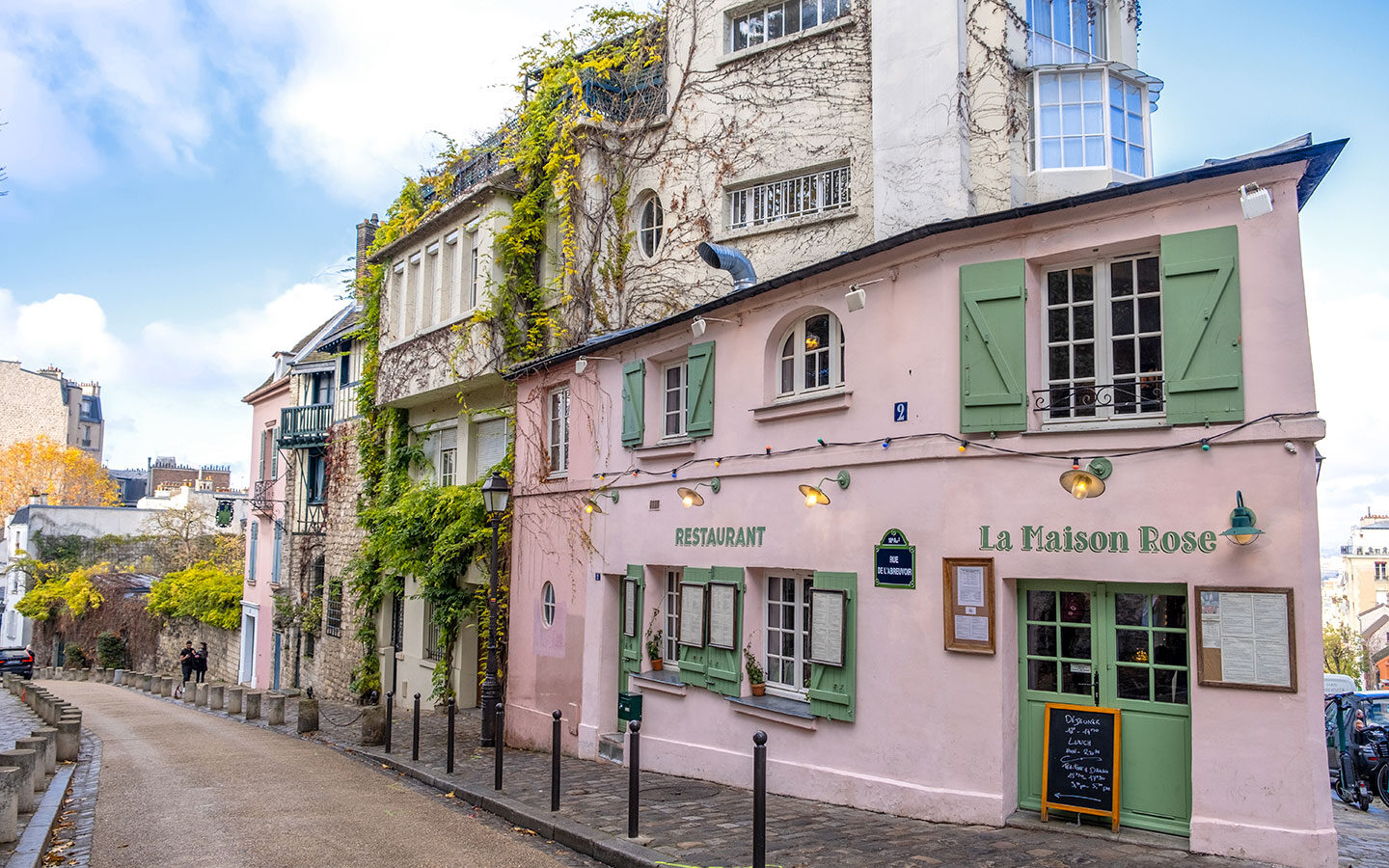
Once you reach the end of Rue de l’Abreuvoir, turn left and take a short diversion down Rue des Saules to see Paris’ last remaining vineyard.
Clos Montmartre
Vines have been grown in Montmartre since the Romans, who built a temple here dedicated to Bacchus, the god of wine. Most of the vineyards were sold off for development over the years, but 1500m² of vines were saved by a group of artists in the 1930s.
The Clos Montmartre vineyard produces 1500 half-litre bottles of wine each year, which are auctioned off for charity. They’re not France’s finest wine, but get snapped up for the novelty value. You can visit the vineyard during the Fête des Vendanges , a five-day celebration of French food and wine each October with stalls, parades and fireworks.
Just past the vineyard you’ll see the orange building of the Lapin Agile . This has been a cabaret since the mid-19th century and got its name from their speciality sautéed rabbit. Past regulars included local artists Picasso, Modigliani and Utrillo.
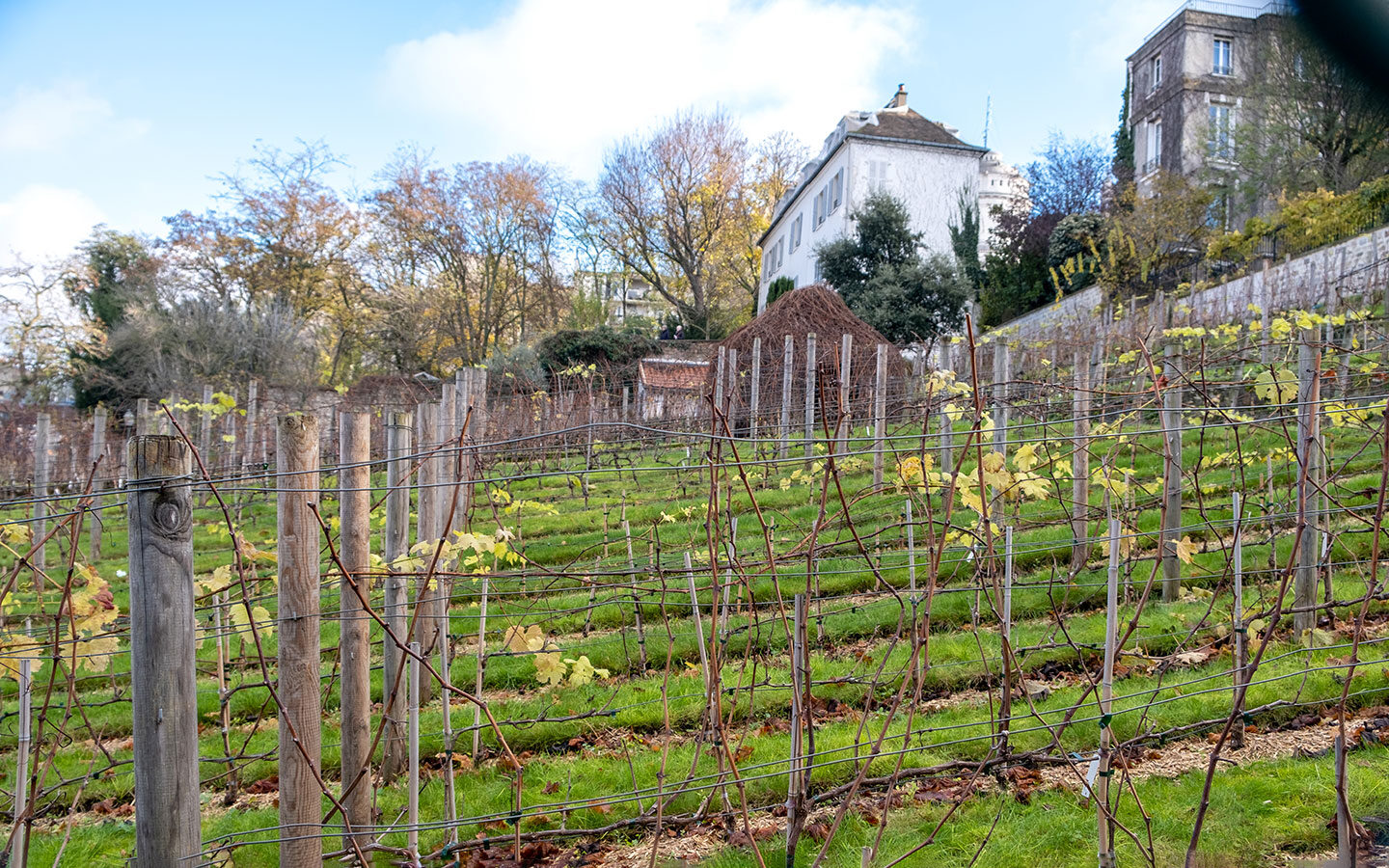
Backtrack to La Maison Rouge, where you can turn left into Rue Cortot to visit the Musée de Montmartre * if you want to find out more about the area’s history. Otherwise head south down Rue des Saules and left along Rue Norvins past the pretty Le Consultat café – another Montmartre Instagram hotspot – to the Place du Tertre.
Place du Tertre
The Place du Tertre was once the centre of Montmartre village, located on the site of an old Benedictine Abbey. Singers, musicians and artists would gather there, and it’s still one of the city’s artistic hubs. You can wander around and watch the artists in action painting a mix of Parisian street scenes, portraits, caricatures and silhouettes.
Competition for a pitch in the square is so fierce that there’s a 10-year waiting list. Each artist only gets a tiny one-square-metre space to work in, and you don’t even get it to yourself – each spot is shared between two different artists who use it on alternate days. It’s a good spot for people watching, with café terraces all around the square.
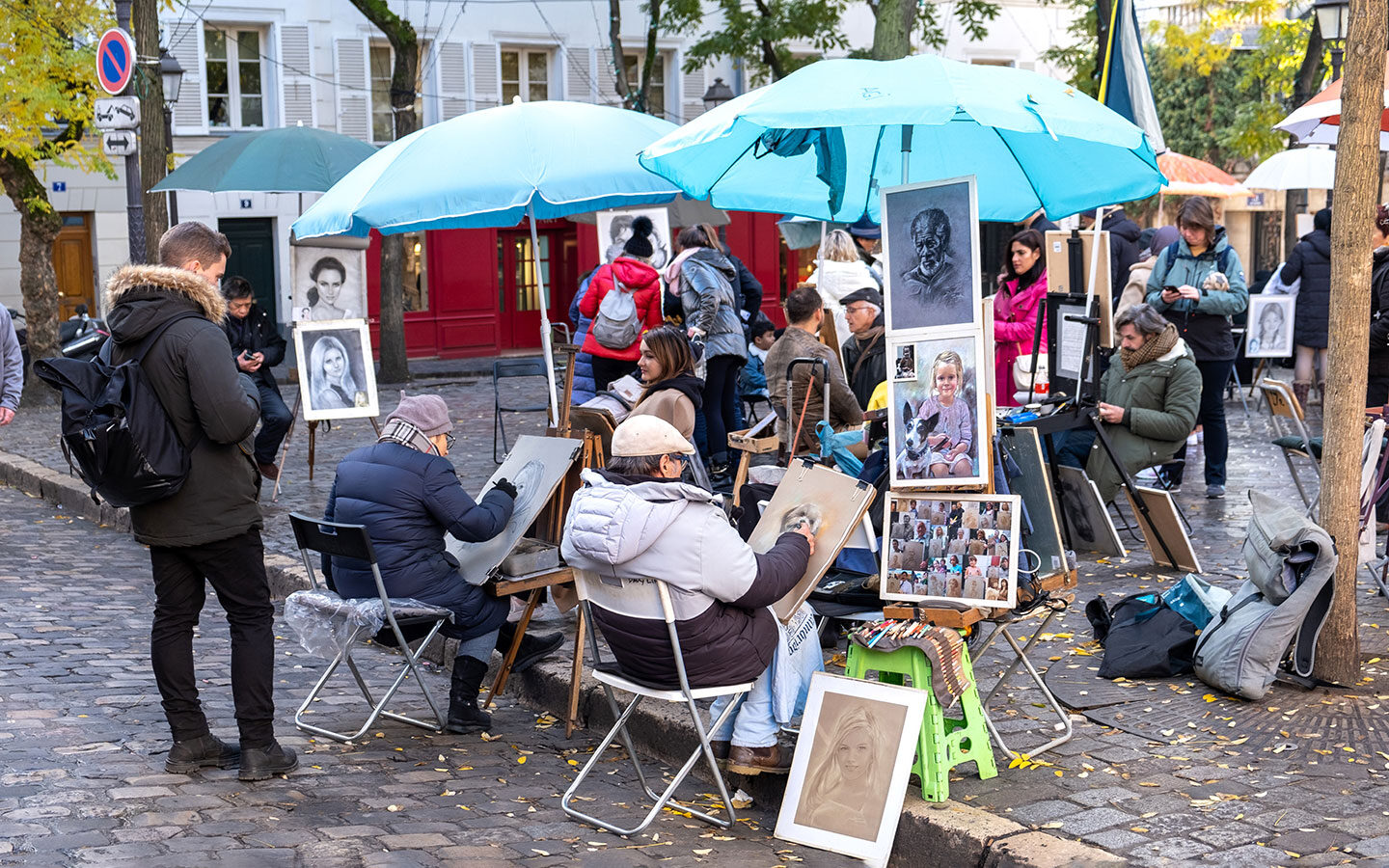
Leaving the Place du Tetre behind you, take the Rue du Mont Cernis then turn left into Rue Azais and follow it along the edge of the park to Sacré-Cœur Basilica.
Sacré-Cœur Basilica
Sacré-Cœur was built between 1876 and 1912 to honour the victims of the Franco-Prussian war, using travertine limestone that’s designed to get whiter as it ages. It’s a real mix of architectural styles which was a bit controversial at the time – some people described it like a gaudy giant wedding cake – but it’s grown on Parisians as time’s gone by.
The steps outside the front of Sacré-Cœur are one of Paris’ best viewpoints , with the city stretching out in front of you. You can climb up 300 spiralling stairs to the top of the basilica’s tower for an even higher view. There also a huge golden mosaic of ‘Christ in Majesty’ behind the alter inside, and a crypt which allegedly contains Christ’s heart.
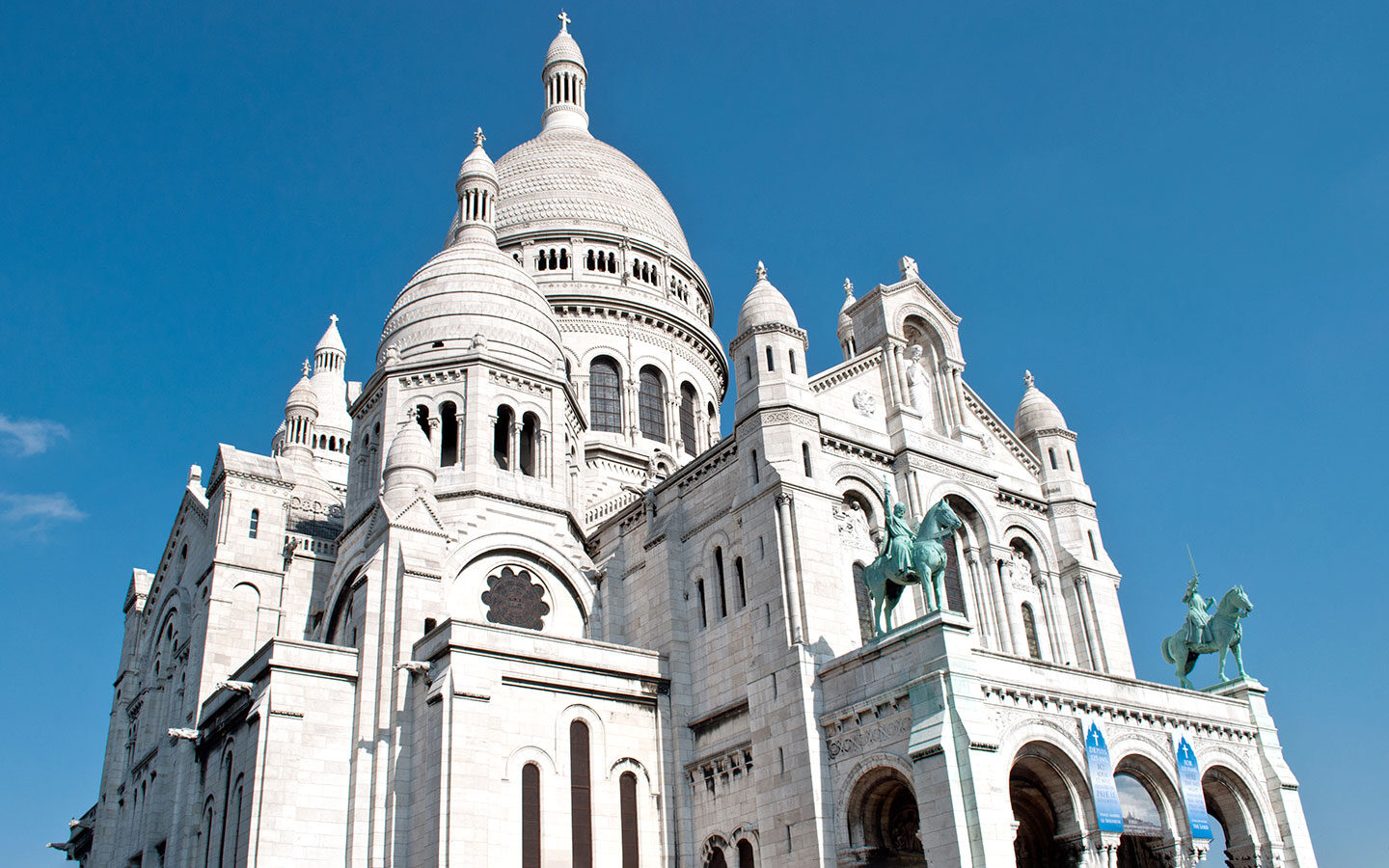
Walk down the steep lawned area in front of Sacré-Cœur, which is packed full of sunbathers, picnickers and street performers on sunny days. Then turn right at the bottom of the hill into Rue Tardieu and go straight on to Abbesses Métro station.
Mur des je t’aime
Finish your self-guided walking tour of Montmartre at the Le mur des je t’aime (Wall of Love) in Square Jehan Rictus, just behind the entrance to Abbesses Métro station. The wall is made up of 612 tiles which say ‘I love you’ in 250 different languages. It’s a favourite selfie spot for loved-up couples, honeymooners and wedding photoshoots.
From there you can catch the Métro Line 12 on around Paris. Or find a café or bar to finish off your walk with a drink – GCD Montmartre is a good wine bar on Rue Durantin or Marlusse et Lapin on Rue Germain Pilon is a quirky cocktail bar.
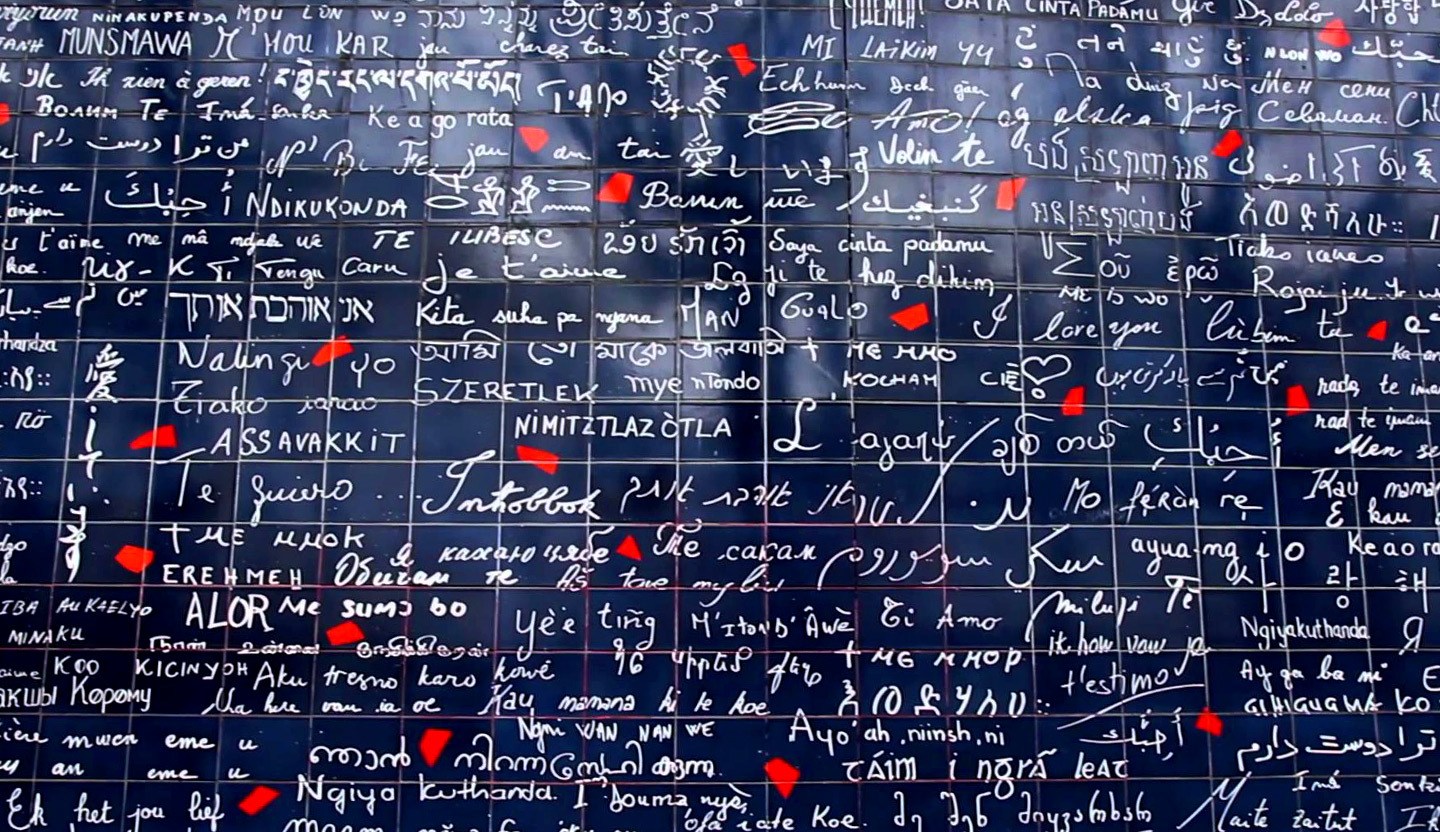
Self-guided Montmartre walking tour map
If you’d like to do this Montmartre walk yourself, click on the map below to access directions through Google maps. The route is just over 2.5km (1.6 miles) and takes 35 minutes to walk straight through, but allow a couple of hours to include stops.
It’s not a particularly challenging walk, though there are hilly sections, and Montmartre has some cobbled streets so trainers or walking shoes are a good idea.
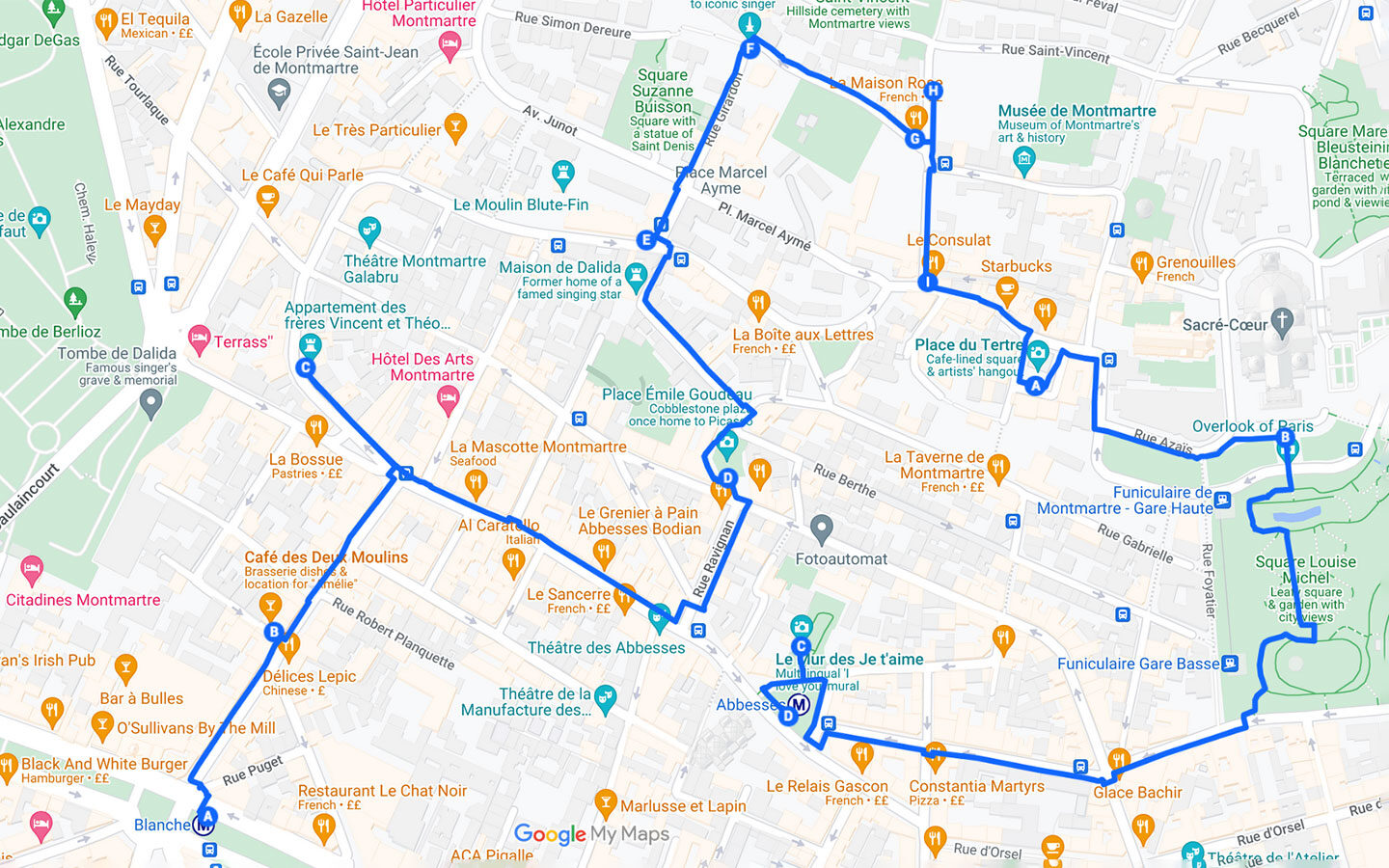
Looking for somewhere to stay in Paris?*
Save for later
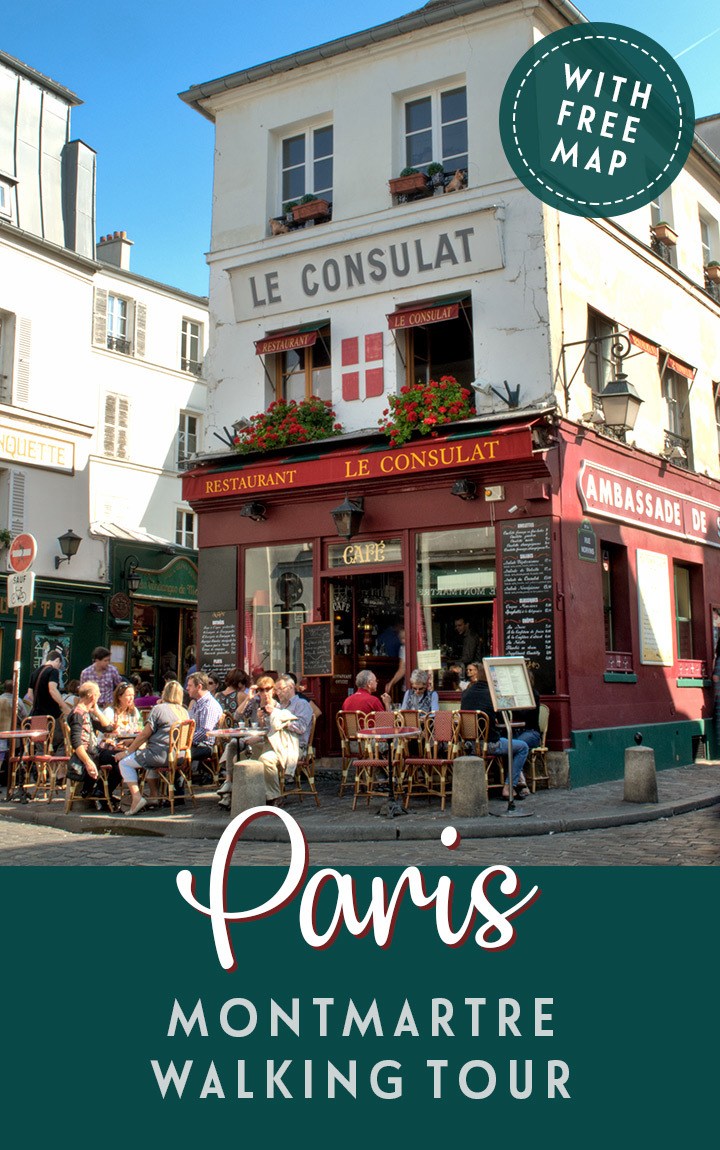
You might also like
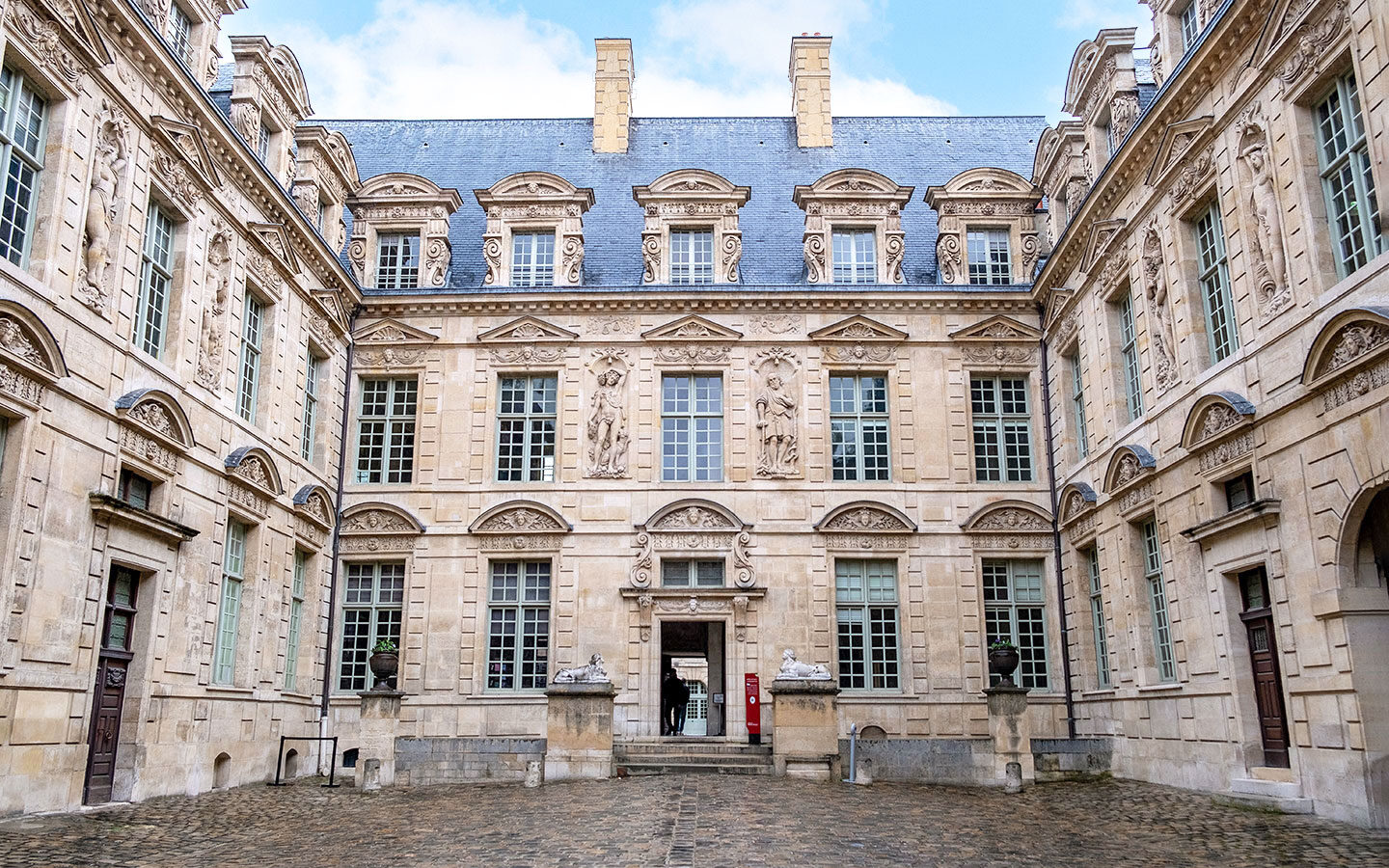
Free self-guided Marais walking tour, Paris
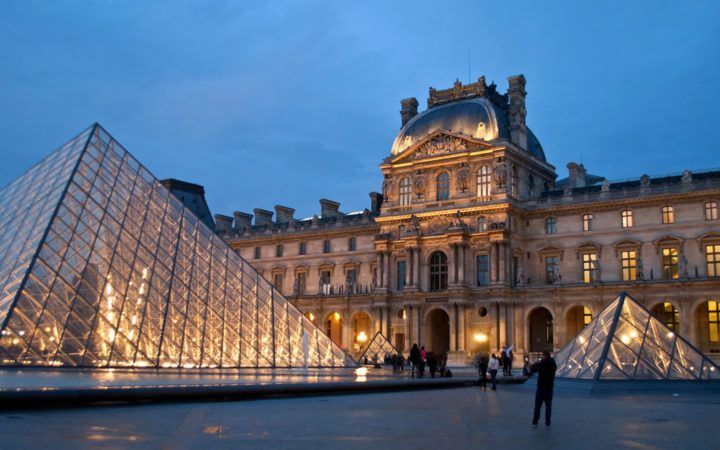
Alternative things to do in Paris
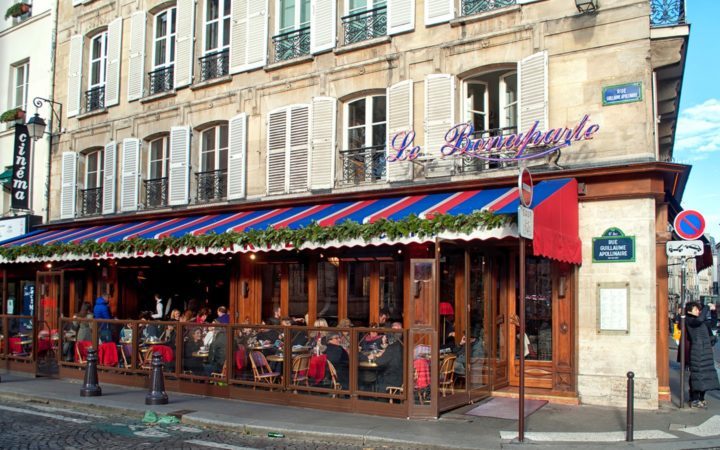
Free self-guided St Germain walking tour, Paris
Friday 15th of March 2024
Estimated time of the tour?
Lucy Dodsworth
Hi Maria, the route is just over 2.5km (1.6 miles) and takes 35 minutes to walk straight through, but allow a couple of hours to include stops.
Magda Colodetti
Tuesday 26th of December 2023
We went on a Montmartre tour today, stopping at all suggested points along the way. The route was excellent.
Saturday 30th of December 2023
That's great – really glad you enjoyed it!
Saturday 8th of July 2023
Thank you Lucy for the tour. Me and my husband learned a lot about this neighborhood. Do you have any other walking tour?
Sunday 9th of July 2023
Hi Adriana – great to hear you enjoyed it! I have a couple more Paris walks, on on St Germain (https://www.ontheluce.com/st-germain-paris-walking-tour/) and one on film locations along the Seine (https://www.ontheluce.com/paris-film-locations-walk/).
Thursday 16th of February 2023
Thank you for this route, it helped us a lot!
You're very welcome – great to hear it was useful!
Tuesday 9th of April 2019
Me and my missue are going there this weekend will defo use your map.
What other areas are good to visit?
Monday 15th of April 2019
Hi, I also love the St Germain area and the walk along the Seine is lovely – the Marais is a great neighbourhood too with lots of places to eat and drink.

Home > Paris Attractions > Stories of Old Montmartre Walking Tour – Map Included
Stories of Old Montmartre Walking Tour – Map Included
Montmartre self-guided walking tour.
This Montmartre walking tour takes you through the main sights of old Montmartre and the stories and legends behind it.
The Montmartre Hill in Paris, also known as La Butte by locals, is famous for its Basilica of the Sacred Heart, the Love Wall, and its panoramic view of Paris. However, it is also a gastronomic and cultural district with authentic charm, dotted with many picturesque stairs and old lampposts.
Montmartre was an independent village from its origins until 1860 when it was annexed to Paris. Due to the beautiful light from ‘the heights’ and the low rents, the Butte was colonized by artists in the 19th century. When walking in Montmartre at that time, you could come across people like Corot, Géricault, Renoir, Degas, Cézanne, Max Jacob, Apollinaire, Juan Gris, Vlaminck, Braque, and Picasso!
Needless to say, the history of this neighborhood is fascinating and you will learn many quirky stories and fun facts during this walking tour of Montmartre.
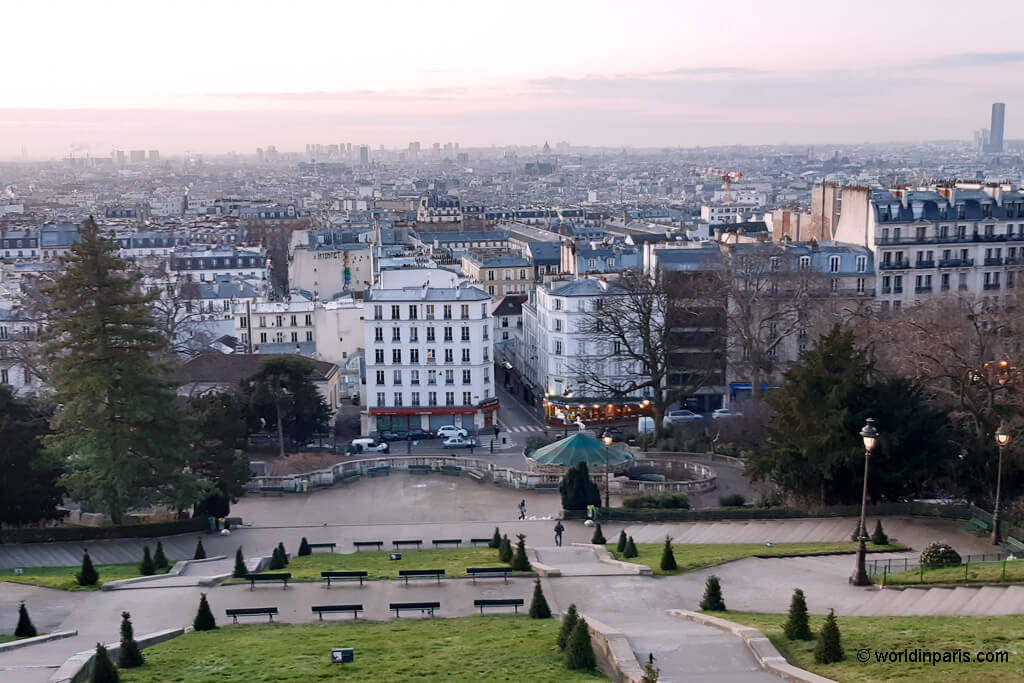
The neighborhood of Montmartre is one of the top places to visit in Paris. We recommend doing this Montmartre walking tour in the following Paris itineraries:
- 2 days in Paris itinerary
- 3 days in Paris itinerary
- 4 days in Paris itinerary
- 5 days in Paris itinerary
- 6 days in Paris itinerary
- 7 days in Paris itinerary
Montmartre Practical Information
How to get to montmartre.
Two metro lines operate within Montmartre Hill: lines 12 (green) and 2 (blue).
Montmartre is a hilly neighborhood with many staircases and cobbled streets. If you want to get to Montmartre from the airport and have a lot of luggage, we recommend booking a private transfer service like Welcome .
Where to Eat & Sleep in Montmartre?
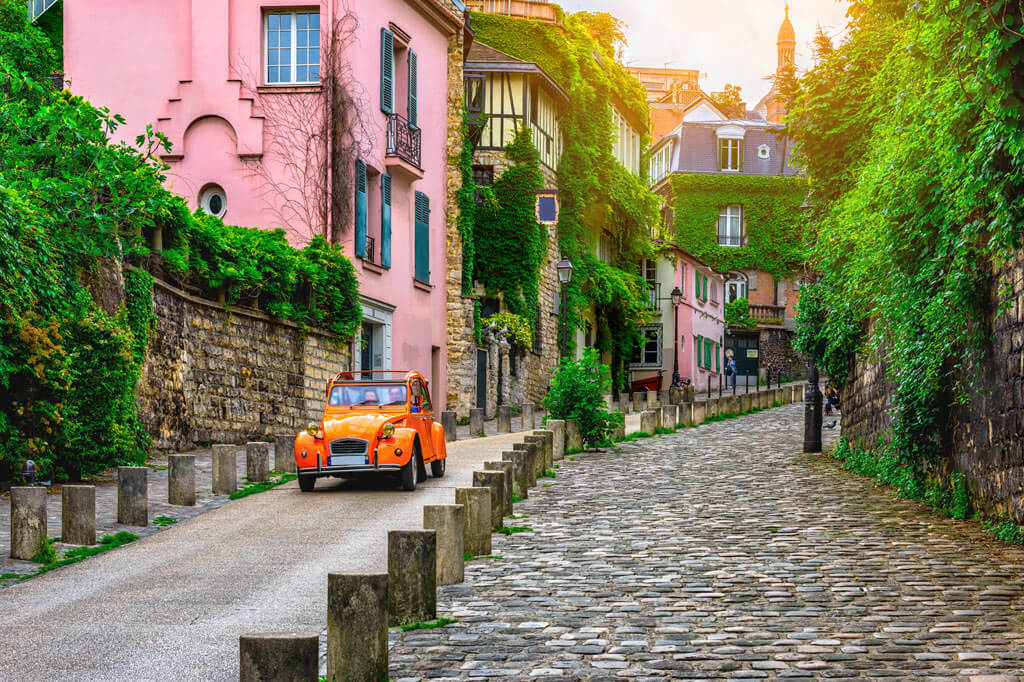
Montmartre Walking Tour Map
Walking in Montmartre is a wonder as long as there are no tourist crowds. That’s why I recommend taking this Montmartre tour early in the morning, right after sunrise, when everything is still calm and quiet.
This Montmartre self-guided walking tour starts in front of the Sacré-Cœur Basilica , in the heart of the neighborhood. The starting point (Sacré-Coeur) is marked with #1 on this Montmartre walking tour map.
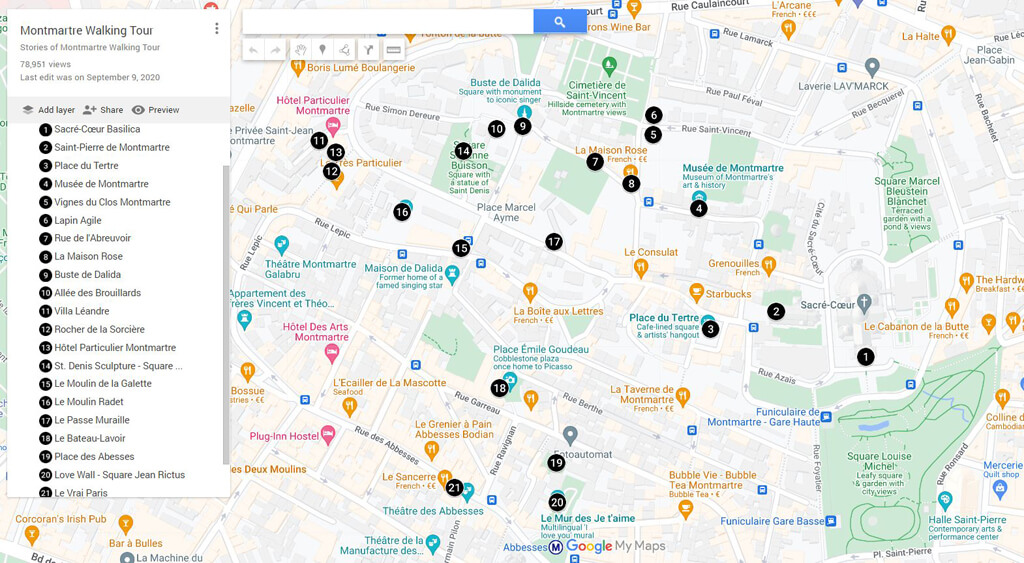
Click here to view this Montmartre walking tour on Google
Walking Tour of Montmartre – Itinerary
1. the secret of sacré-coeur’s eternal beauty.

The Basilica of the Sacré-Coeur , located at the top of Montmartre Hill in Paris, is a major religious building built at the end of the 19th century. With more than ten million pilgrims and visitors per year (in 2006), it is the second most visited monument in France after Notre Dame de Paris Cathedral!
While most of the monuments of Paris tend to darken over time and are constantly subject to renovations, the Sacré Coeur is recognizable by its characteristic and unpolluted white color. How Montmartre’s symbol can stay so white?
The Sacré Coeur was built with the stone of Château-Landon, also used to build the Alexandre iii Bridge and the Arc de Triomphe. This stone has a very interesting characteristic: when it rains, it secretes a white substance in contact with water (the cullet) which flows along the walls of the building before hardening in the sun. This is Sacré- Coeur’s secret of eternal youth and the reason why it has never been renovated!
2. Saint-Pierre Church and the Myth of Saint-Denis
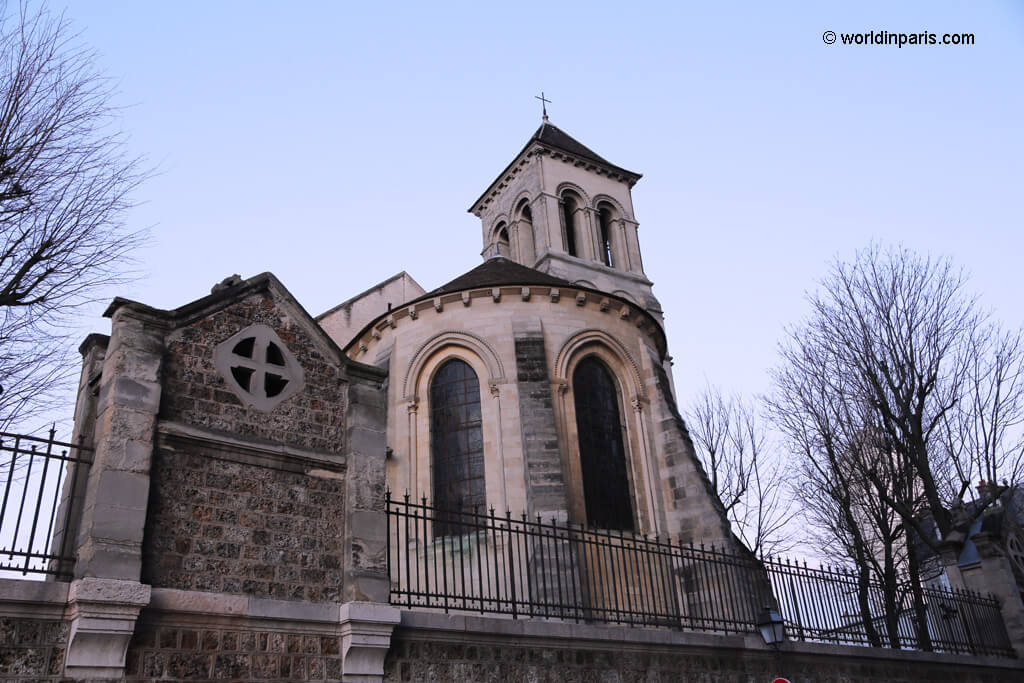
The next stop of this walking tour Montmartre is 2 rue du Mont-Cenis . Here, there’s one of the oldest churches in Paris, built in the Middle Ages.
Saint-Pierre Church is connected to the legend of Saint-Denis. The saint martyr was martyred on the Butte-Montmartre (Mount of Martyrs), which became a sacred place for Christians.
Before the Middle Ages, a temple dedicated to the Roman god of Mars stood at the site of the current church. This temple became in the 5th century a Merovingian chapel surrounded by a cemetery around which a small hamlet developed.
The site experienced a new development in the 12th century. In 1133, it was ceded with the Merovingian chapel to King Louis VI and Queen Adelaide of Savoy, who decided to found a Royal Abbey of Benedictine nuns in this place. In 1147 the Royal Abbey replaced the old chapel with a new church in Romanesque style (Saint-Pierre Church) and added more constructions around it.
During the troubles of the French Revolution, the parish worship spared Saint-Pierre Church while the rest of the religious buildings were demolished entirely. After being converted into a Temple of Reason (1794), and later transformed into a tower on which Claude Chappe installed his first aerial telegraph, Saint-Pierre Church was restored between 1899 and 1905.
Today, the church’s interior keeps its original Romanesque style, except for the Gothic rib vault and some Gallo-Roman parts recycled from the Merovingian chapel. Adjacent to the church there is the charming Calvary Cemetery , the oldest cemetery in Paris! The cemetery opens its doors only on 1 November and during the European Heritage Days.
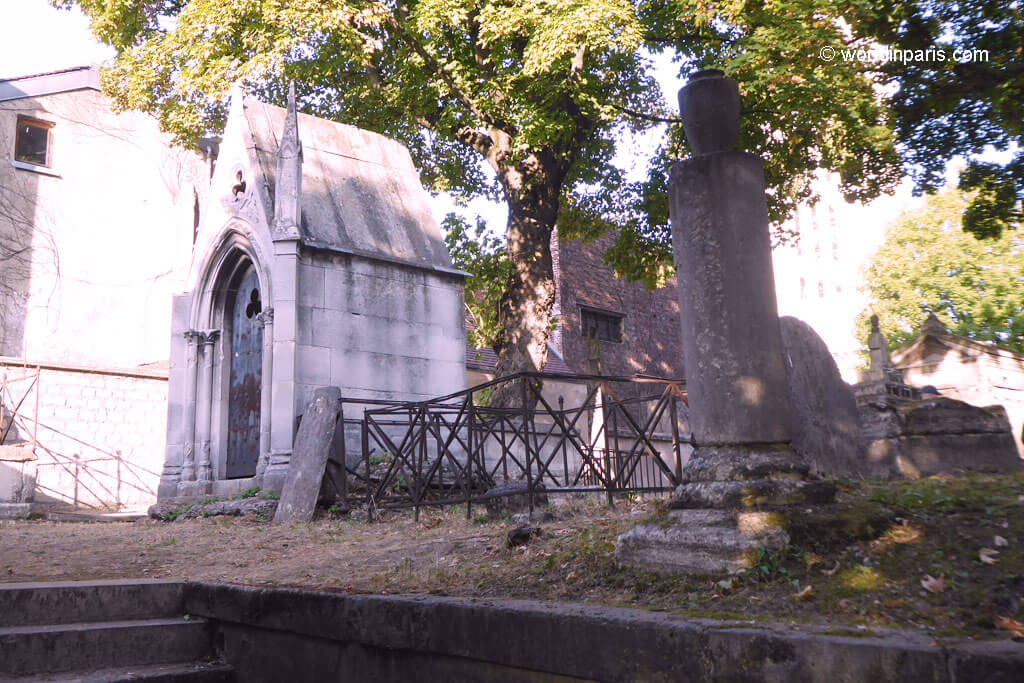
The hillock, dominated by Saint-Pierre Church and its public square (Place du Tertre), has long kept its village atmosphere. While the village’s fame has been widely exploited (you just need to see all those souvenir shops..) and completely distorted, the church retains a picturesque side with its clear perspective.
3. Place du Tertre and the Artists of Montmartre
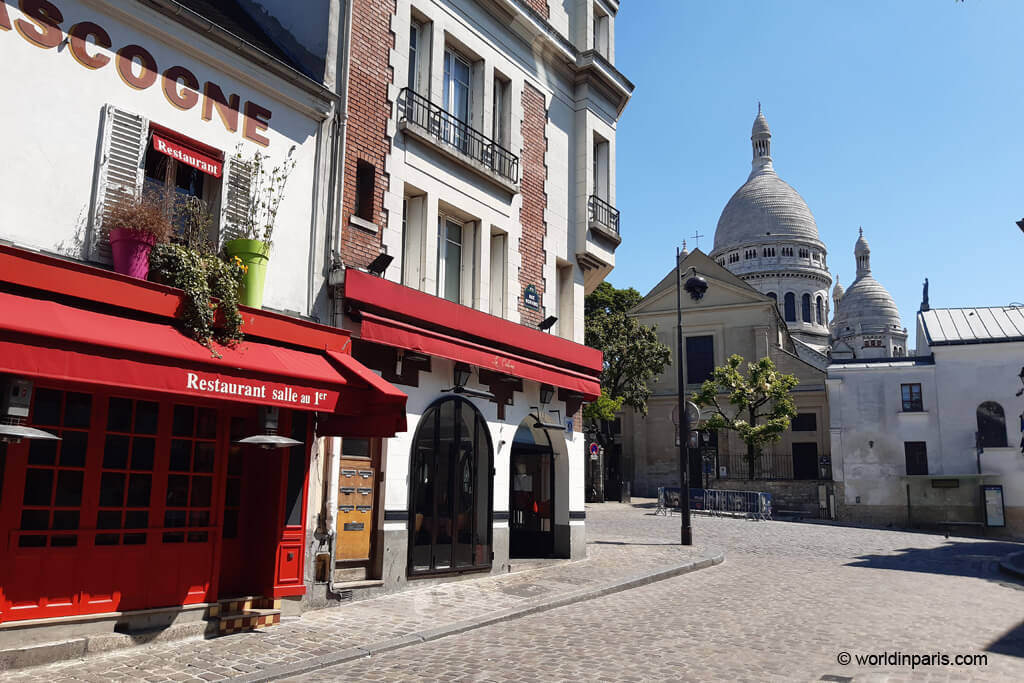
Place du Tertre is Montmartre’s beating heart. This picturesque square framed by 3-4 story 18th-century buildings and with a beautiful view over the Sacré Coeur corresponds to the center of the old village of Montmartre.
The village of Montmartre was officially founded in 1790, and its first town hall was at 3 Place du Tertre . In the square, there is also a plaque on the façade of house #21 which commemorates the arrival of the first automobile on Christmas Eve 1898, with Louis Renault behind the wheel. This event marks the beginning of the automobile industry in France.
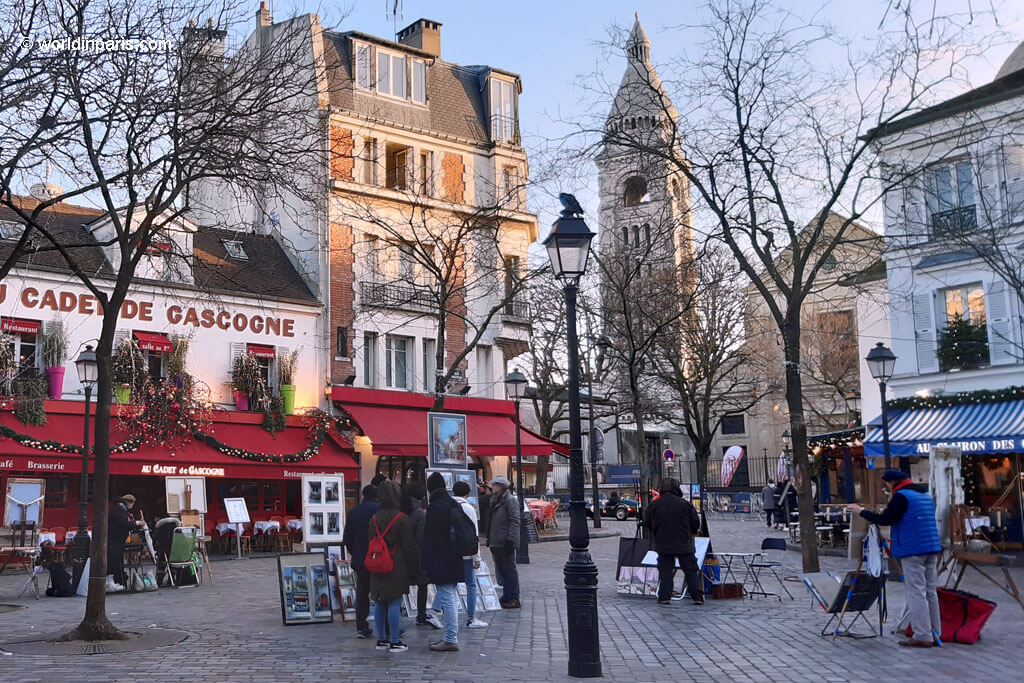
The local art trade is a tradition of the slopes of bohemian Montmartre, started around 1890 by famous Montmartre artists like Modigliani, Utrillo, Valadon, and Picasso. Each year, the City Council grants 140 licenses for a one-square-meter stall in Place du Tertre to be shared by two artists on alternating schedules.
Let’s take Rue Novins , the old village’s main street. This street was referred to in the 11th century as the cart road that goes from Montmartre to Paris . The even side is lined up with 18th-century townhouses with wooden shutters, wrought iron window railings, and dormers.
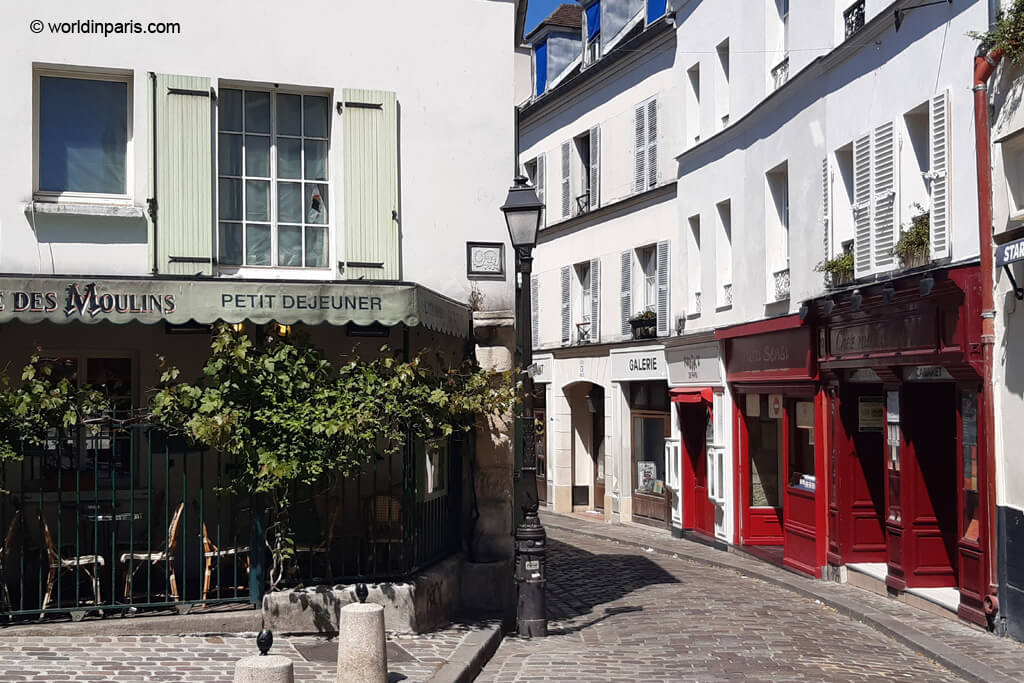
At #6 there’s the Mère Catherine Restaurant , a small bistro founded in 1793. This bistro replaced a 15th-century old presbytery, and guests liked to meet for drinking and to play wooden billiards. An old postcard shows the Mère Catherine and the pool players posing in front of the bistro.
Now, let’s turn left onto Rue des Saules , which plunges down the north side of the Hill. Don’t forget to take a picture of Le Consulat , one of the most Instagrammable cafés in Montmartre.
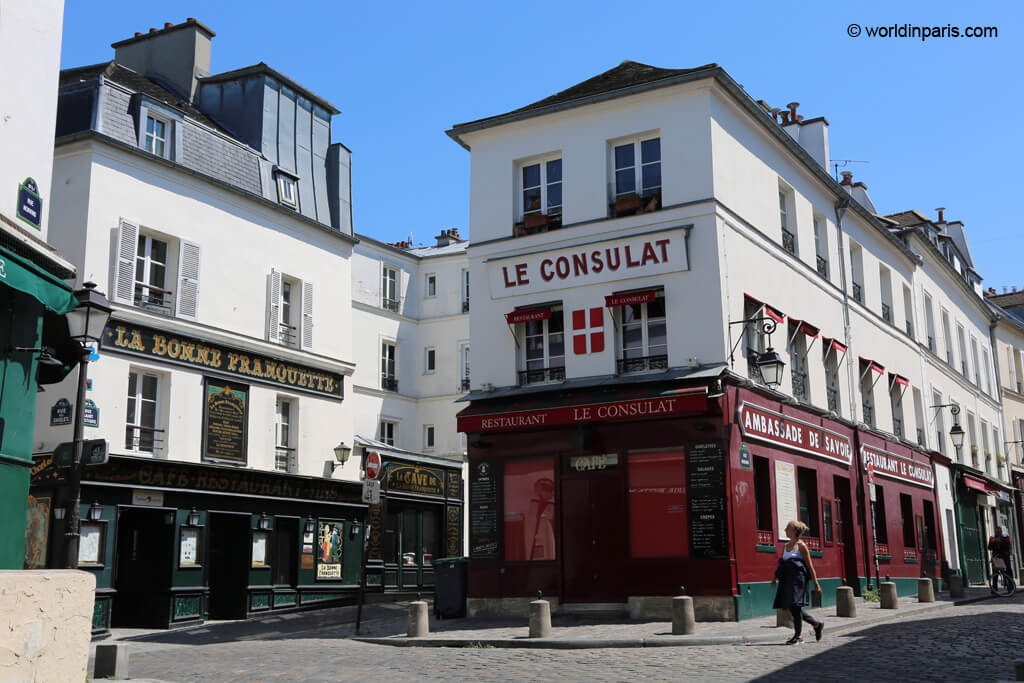
Rue des Saules was called in the 15th century the Chemin de la Saussaie, and it traversed swampy lands where willow trees ( saules in French) grew. For this walking tour of Montmartre, you will take the second intersection with Rue Cortot .
4. A Hothouse for Artists
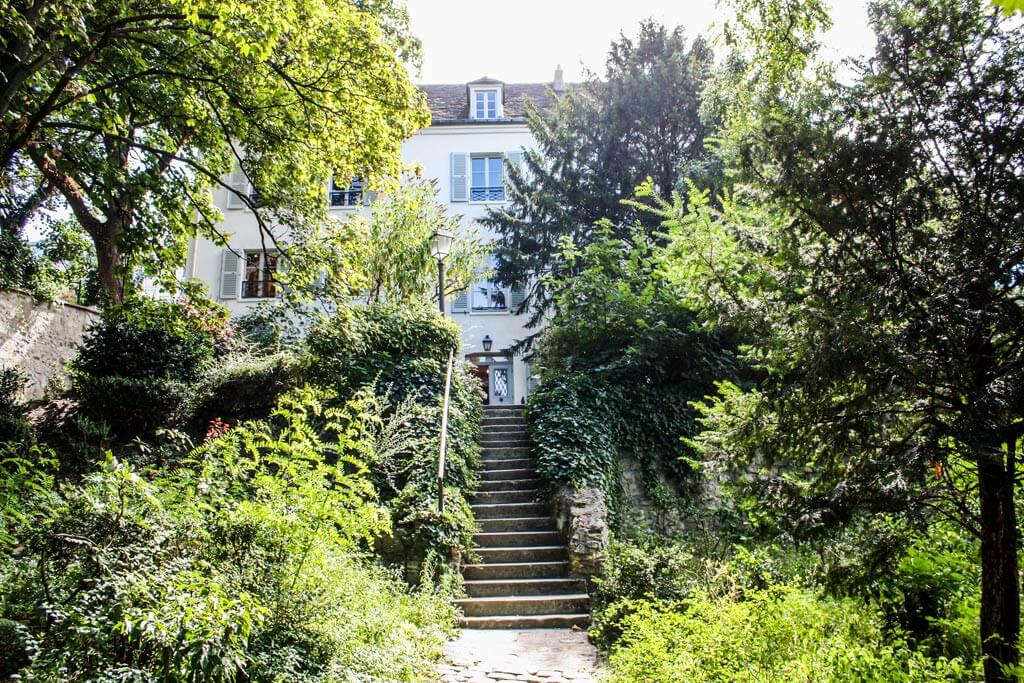
Considered the oldest house in Montmartre and formerly the art studio of many artists, Le Musée de Montmartre (12 rue Cortot) is nestled on a quiet street. Although the museum is located a stone’s throw from busy Sacré-Coeur, it feels a world away.
Auguste Renoir was perhaps its most illustrious guest. In 1876, He rented a studio and stables in the left wing to store Le Moulin de la Galette, the extra-large painting he was working in.
The rarely crowded museum has collections on the village’s history (the section on cabarets, for example, is very interesting). The setting is very romantic, and from the exterior areas, you are treated to excellent views over the vineyard of Montmartre. Take a drink in the beautiful café in the garden, immortalized by artists like Renoir in The Swing.
After the visit to the Musée de Montmartre, this Montmartre walk turns left on Rue du Mont-Cenis. This street was in the 12th century a steep path – only accessible to pedestrians and mules – which linked the Abbey of Saint-Denis to the Abbey of Montmartre through the Hill’s northern slope.
Then turn left onto Rue Saint-Vincent , a street with a provincial feel, and stop at Montmartre’s vineyards.
5. The Wine of Montmartre
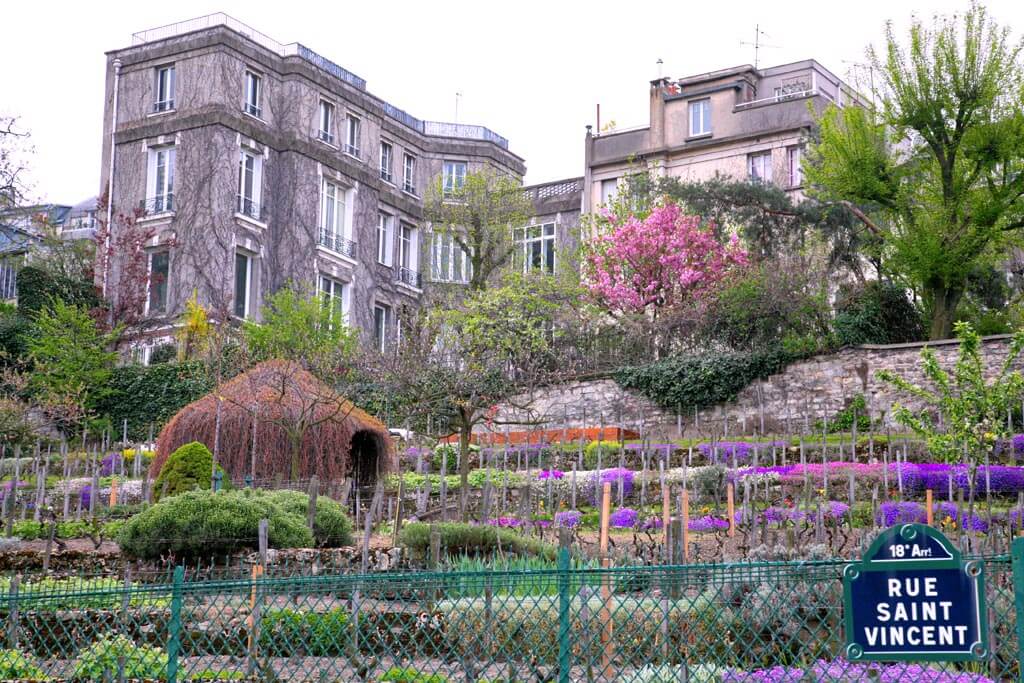
The Montmartre vineyards of Rue Sait Vincent, whose official name is Clos-Montmartre , perpetrates the memory and tradition of the many vineyards that used to cover these slopes.
In the 16th century, the inhabitants of Montmartre – then a village located outside Paris – were mainly laborers-winegrowers. The vineyards were cultivated from the top of the Butte to the surrounding plains.
In the 17th century, the Montmartre wine was a small wine reserved for local consumption. A popular saying of the time makes fun of its quality which seems to be exclusively diuretic: “It is the wine from Montmartre – Who drinks a pint, pisses a quarter of it!” .
This vineyard in Rue Saint Vincent was planted in 1933 to prevent any new construction on the grounds of a former (then abandoned) open-air dance hall called Le Parc de la Belle Gabrielle . Today, this vineyard includes “the most classic varieties from the wine provinces of France, as well as a selection of vigorous and fertile hybrids”. The whole is embellished by decorative plantations.
Public access is not permitted, except for exceptional occasions, such as the Fête des Jardins organized every autumn since 1997. The yearly harvest is generally in early October. The crop is hauled to the Mairie of the 18th Arrondissement cellars, and the 800-odd bottles of wine are sold at auction the following year during the popular Montmartre’s Harvest Festival . You can read more about this popular food & wine festival here .
6. Cabaret Life in Montmartre
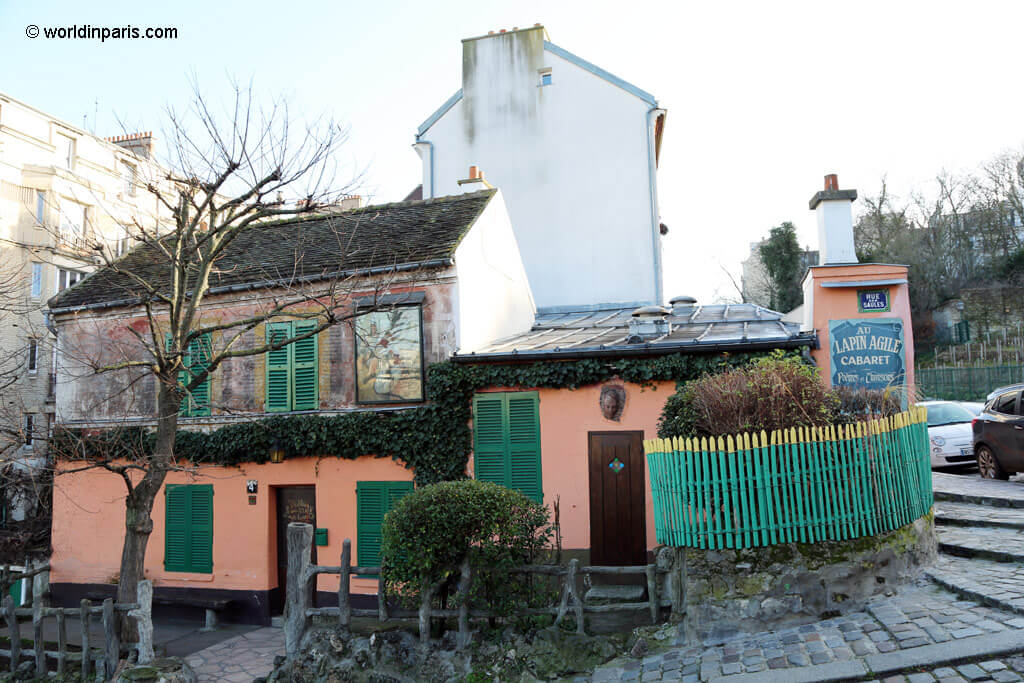
Le Lapin Agile at 22 Rue des Saules is a traditional cabaret established in the second half of the 19th century, bought by Aristide Bruant in 1913. We know that in 1886 this was a restaurant run by Adèle Decerf whose specialty was sautéed rabbit.
In the early 20th century, this village-style house was the center of bohemian life in Montmartre. Dorgelès, Carco, Renoir, Courteline, Forain, Picasso, Fargue, Utrillo, Van Gogh, Clemenceau, and many more were frequent guests of this cabaret. Picasso liked sitting out on the terrace beneath the giant acacia with his dog Frika.
Today, the Lapin Agile has preserved the original and warm atmosphere of the cabarets. You can read more about the Lapin Agile and other Parisian Cabarets in our quick guide to the Cabarets of Paris .
7. Rue de l’Abrevoir
Let’s walk up Rue des Saules , then turn right onto Rue de l’Abrevoir . In the 19th century, the residents of Montmartre followed this path to fetch water for themselves and to lead horses and cattle to the watering trough ( abrevoir in French) located on this street. The 19th-century house at #15 is the site of that old watering trough.
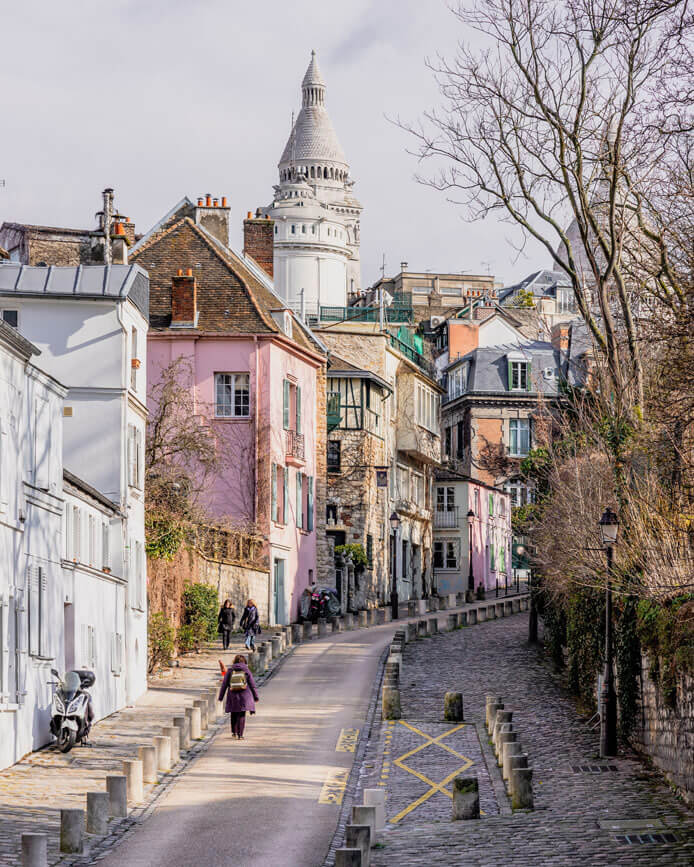
At #2, the little Maison Rose (point #8 on the Montmartre walking tour map) painted by Maurice Utrillo is now a legendary spot in Montmartre and one of Instagrammers’ favorite spots in Paris.
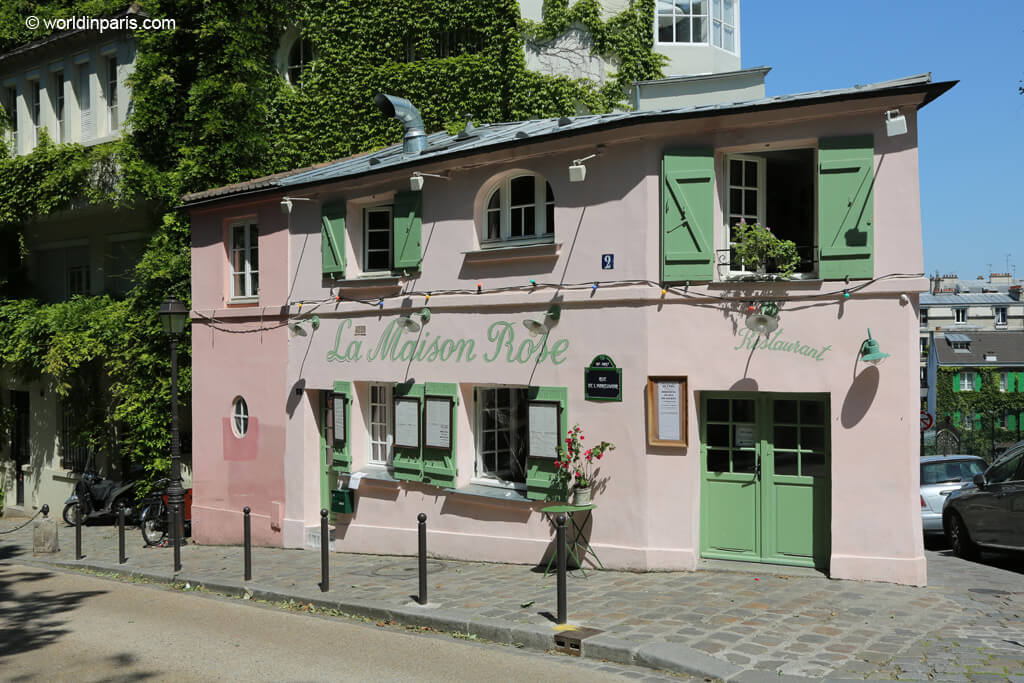
9. Dalida’s Tragic Life
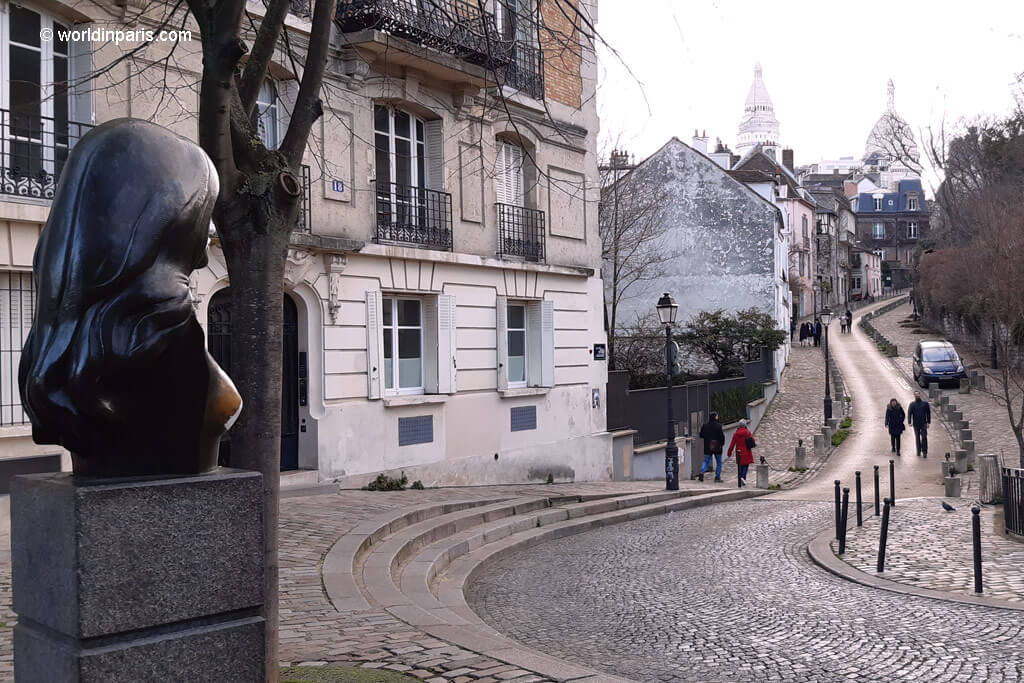
This Montmartre tour stops for a break at Place Dalida . This tiny square has one of the most beautiful views of Montmartre, with Rue de l’Abrevoir towards the Sacré-Coeur. The square is dedicated to Dalida , a famous pop singer who lived in Montmartre. Her incredible talent as a performer made her an icon of pop music in France.
The singer Dalida found a home in Montmartre, where she moved in 1962. She bought a beautiful mansion on the narrow 11 bis Rue d’Orchampt . She used to eat at the neighboring Italian restaurant Grazziano, down by the Moulin, and she also frequented the shops in the Rue Lepic. Dalida joined in the fight to defend and protect the Butte, so dear to her.
Weakened by the loss of her former companions (all committed suicide), as well as her friend Mike Brant, the singer died on 2 May 1987, breaking the hearts of the French. “Life is unbearable to me, please forgive me,” were Dalida’s last words. Dalida committed suicide in her house, and she was buried in the Montmartre Cemetery (not included in this Montmartre tour).
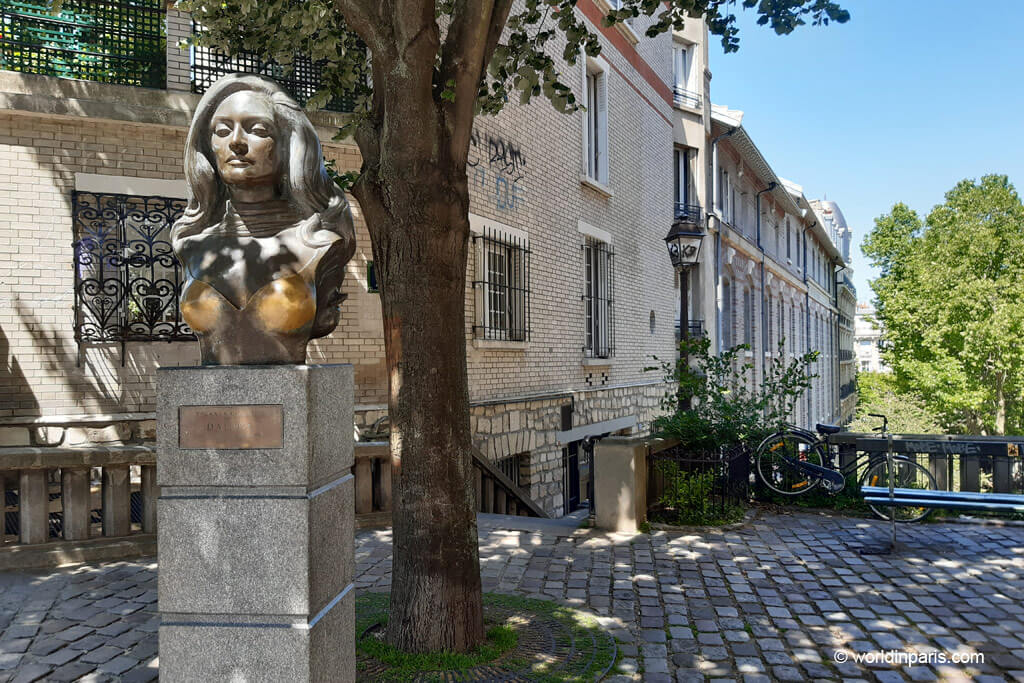
It is soon noticed that the bust dedicated to Dalida is particularly polished in some places – on the artist’s chest, in particular – leaving some visitors doubtful. There is no particular reason for that (unlike Giulietta, Dalida does not bring good luck, love, or money but quite the opposite…) so please be respectful towards this great artist and Montmartroise.
10. L’Allée des Brouillards
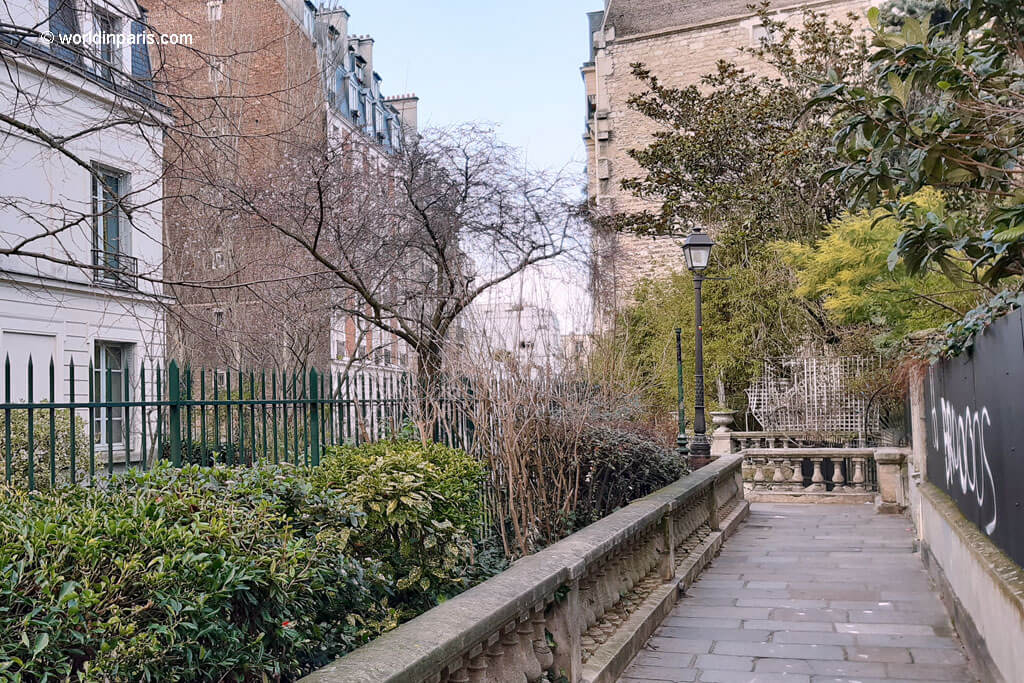
The romantic Allée des Brouillards is one of the few places that still can transport us back in time to the picturesque village of Montmartre. Renoir and his family lived at #8 from 1890 to 1897. His son, Jean, a famous film director, was born here in 1894.
On the right, behind a lawn, rises the delightful facade of the Château des Brouillards , in front of which so many painters set up their easels in the past.
In the 17th century, a modest farm and a mill occupied this site ( the Moulin des Brouillards ), which served as a press for Montmartre’s (not-so-good) wine. The name Allée des Brouillards (Mists Alley) tends toward two explanations: the morning mists generated by the abundance of the sources in the area or (another one much more festive) an allusion to the vapors of the wine.
In 1764, the hovel and the ruined mill were sold to a lawyer in the French Parliament who built a beautiful house, the ‘Château des Brouillards,’ parts of which you can still see today on the left side. The Château comprised a farmyard, orchard, cellars, and wells, and it was a pleasant country residence.
In 1850 the outbuildings of the Château were torn down to make room for individual houses separated by mere hedges, now on the tiny alley with the poetic name. Its park, gradually invaded by miserable huts, became the famous “maquis” (bush), so dear to nostalgic Montmartrois.
It was not until the 1920s that the castle owner began to restore it. He launched a campaign for its conservation because the City of Paris wanted to remove the old alley and demolish the house. Today, the Château des Brouillards receives the visit of many walkers and lovers of Montmartre in search of an air of the rural and picturesque Butte of better days.
11. Villa Léandre
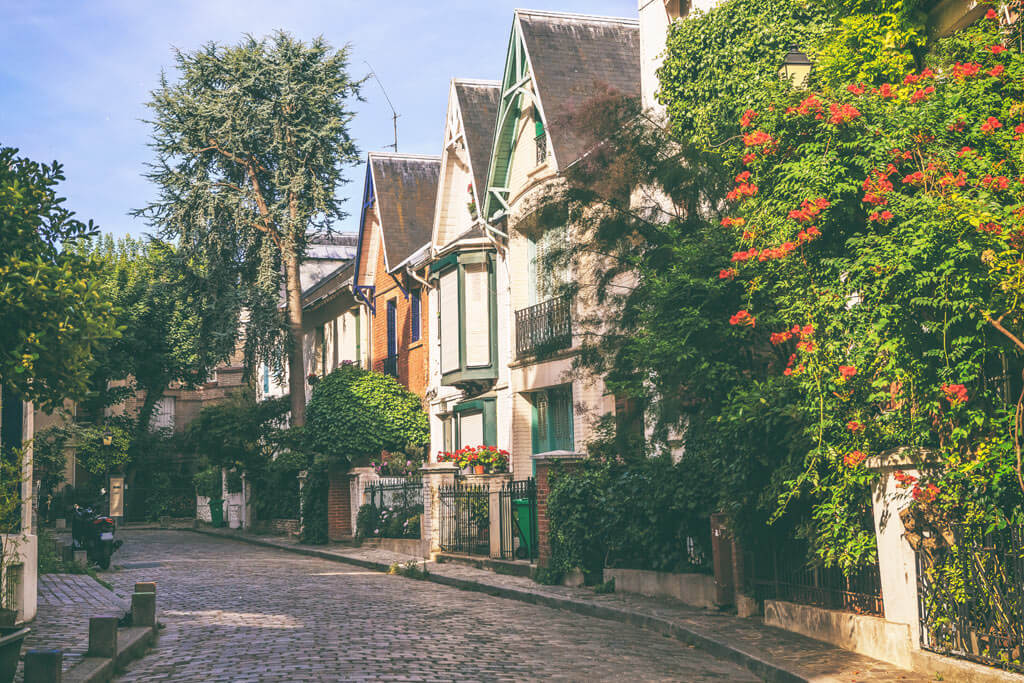
This walking tour Montmartre takes now Rue Simon-Dereure and then Avenue Junot on the left. Before walking uphill, stop at the charming Villa Léandre for a couple of pictures.
Created in 1926, Villa Léandre was initially named Villa Junot , after its larger street tributary. Its current name comes from the caricature artist Charles Léandre, whose studio was located nearby. The cobbled cul de sac is lined with colorful anglo-Normand style houses covered with climbing plants and with small front yards.
Montmartre Things to Do and Hidden Gems
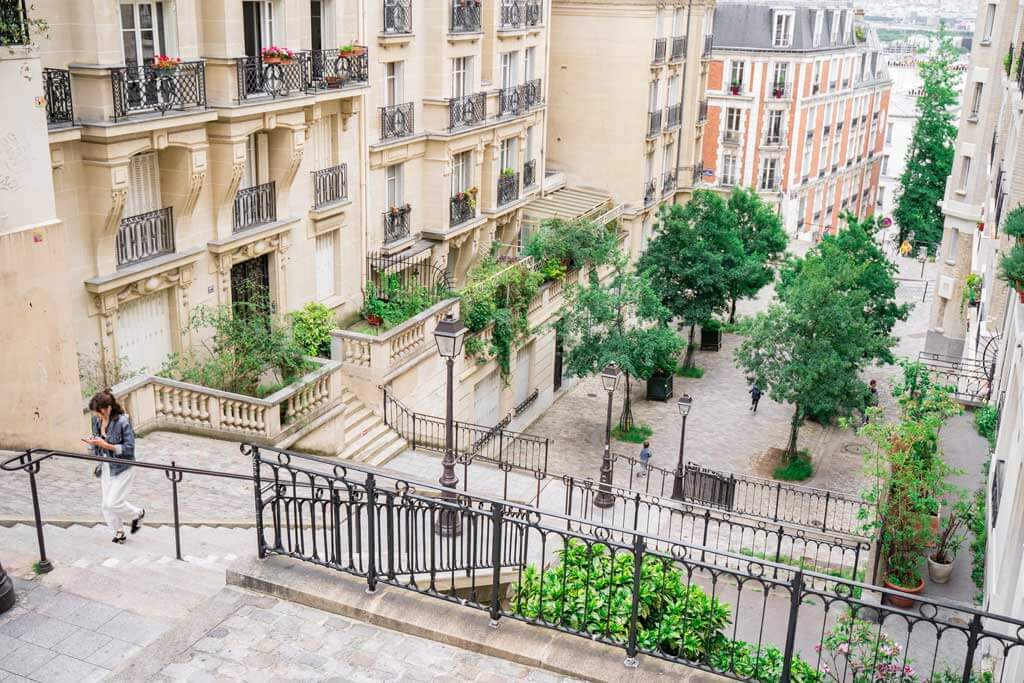
12. The Mysterious Witch’s Rock
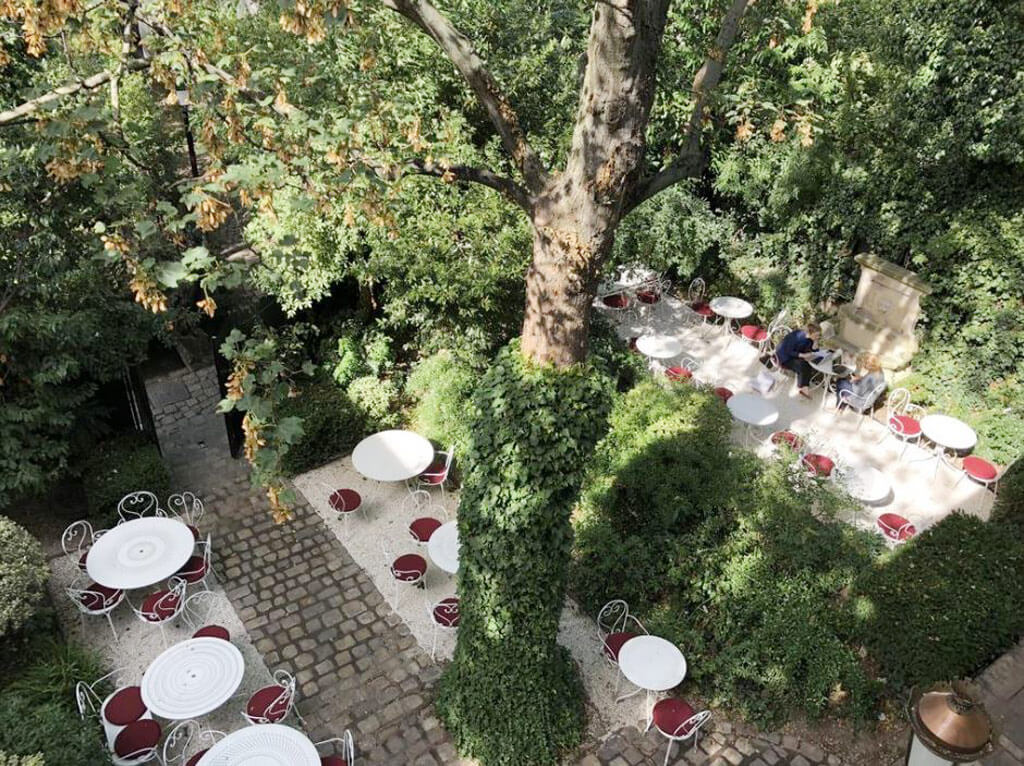
The Passage de la Sorcière , accessible from 23 Avenue Junot or 65 rue Lepic, is one of the most pleasant and privileged little alleys in Montmartre. But this little corner of the Butte comes with many legends! Among the mysterious stories linked to this passage, we find the legend around the imposing block of stone found in its center – La Roche de la Sorcière (the Witch’s Rock).
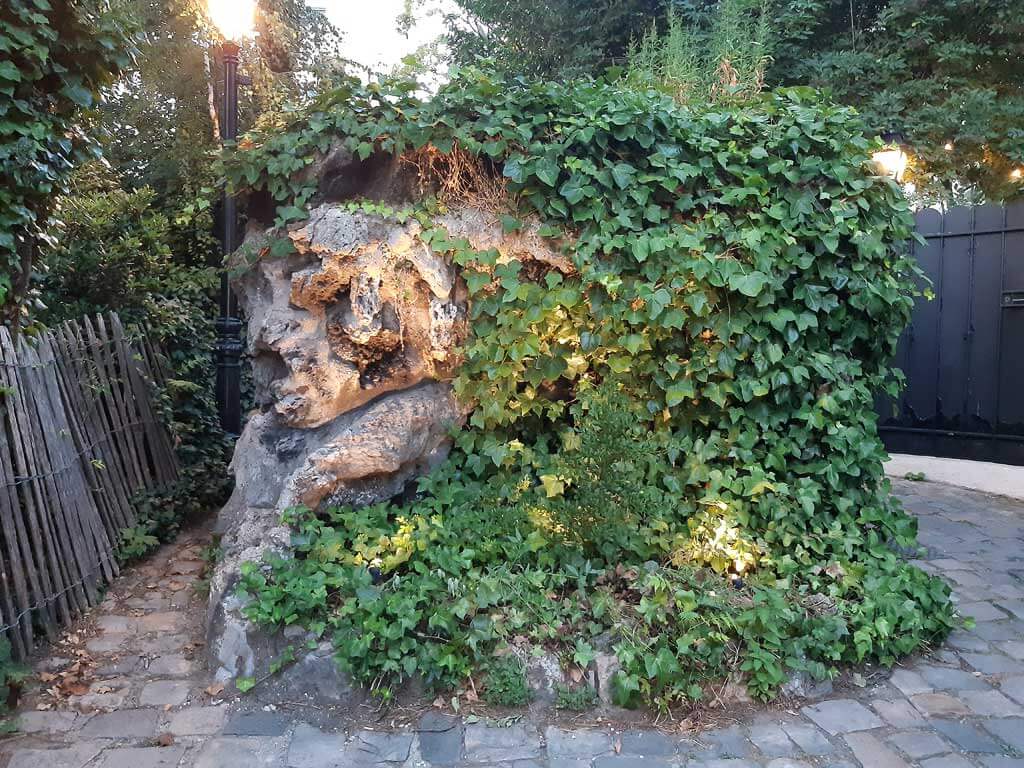
The inhabitants of Montmartre had long believed that this rock was a meteorite, which fell there we do not know when, or how … and it was a magic tool used to protect a witch! Indeed, this imposing rock faces a rather intriguing portal that hides a big and beautiful house. According to legend, this house belonged to an old – and a little bit crazy – woman.
This rock, however, is the vestige of a disused fountain, ‘La Sourcière’ (from source , spring in French), and the neighbors transformed the name of the Passage de la Sourcière , from the name of the fountain which was present there, into Passage de la Sorcière (=Passage of the Witch). Soon, the Rock of the Witch turned into an evil tool with many legends around and spread for generations among the inhabitants of Montmartre.
Today, the witch’s private mansion is one of the most beautiful addresses in the capital, the Hôtel Particulier Montmartre (point #13 on the Montmartre walking tour map). I always recommend this hotel for a romantic stay in Paris which also comes with one of the most beautiful bars in the city. The Hôtel Particulier Montmartre is your only chance to see the Rock of the Witch as this alley is private today.
14. The Legend of Saint-Denis
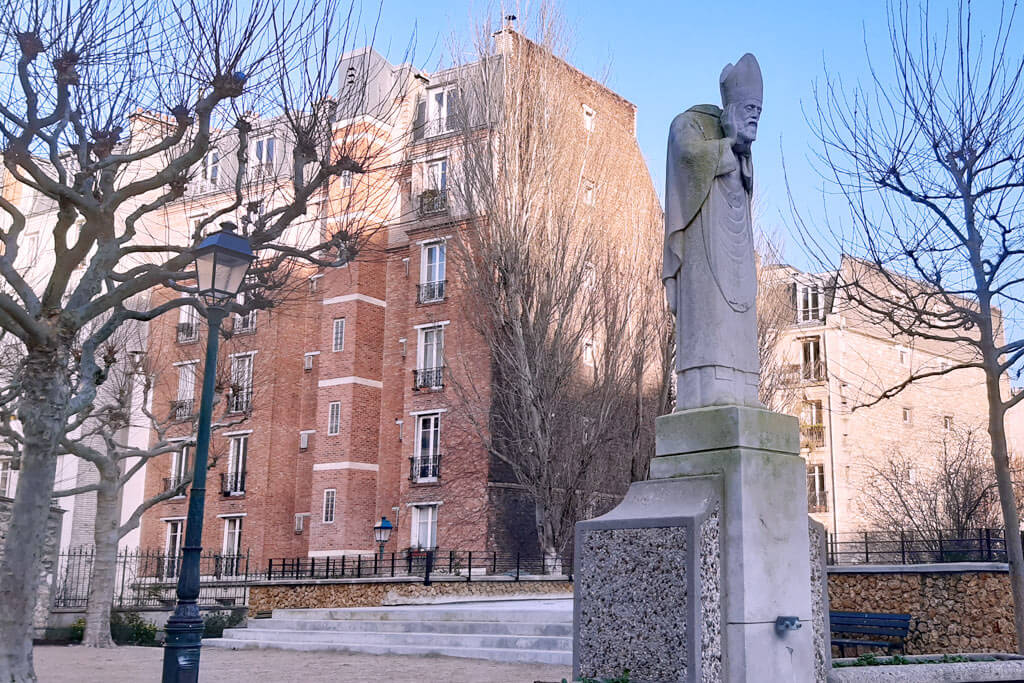
Back to Avenue Junot , this Montmartre self-guided walking tour stops at Square Suzanne-Buisson , dominated by the statue of Saint-Denis. Saint-Denis was the first Christian bishop of Paris in Roman times and the evangelist of the Parisians. The Saint was martyrized and beheaded with his companions Rustique and Éleuthère during Emperor Valerian’s prosecutions.
Legend has it that after his martyrdom (circa 275), the Saint washed his decapitated head in the spring that flowed here until the early 19th century before continuing quietly on his way towards the site where he was buried (current location of the crypt in the Basilica of Saint-Denis). For this reason, the Basilica of Saint-Denis became the burial place for all the Kings of France, who wanted to rest eternally near the remains of the Saint.
15. The Windmills of Montmartre
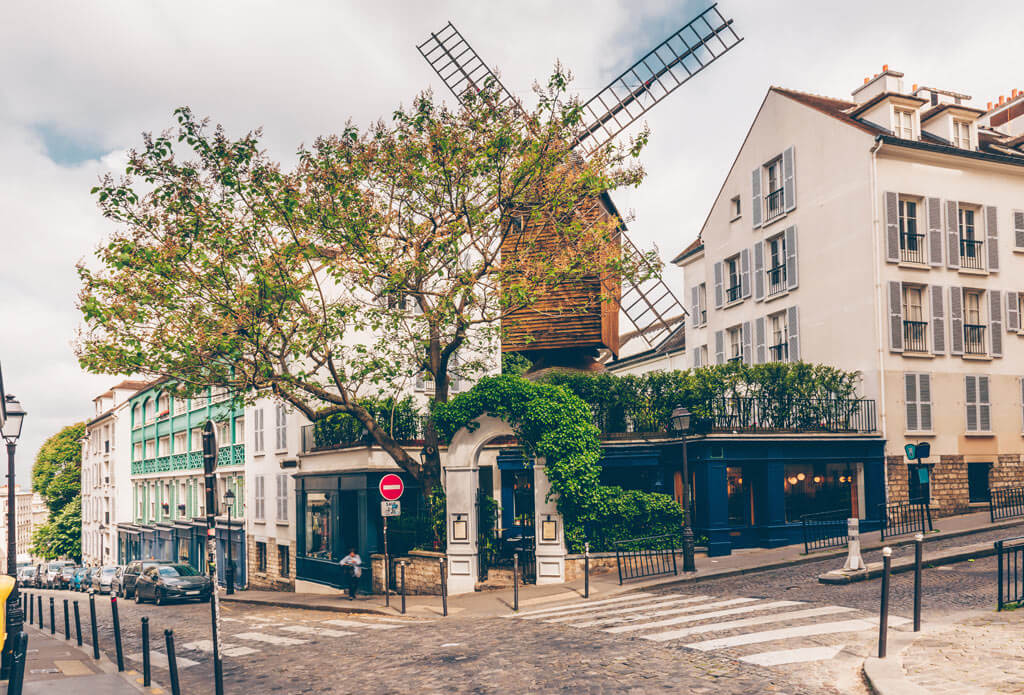
Back to Avenue Junot, on #3, you can get a glimpse of the Moulin of the Blute-Fin , built around 1622. Of the thirteen mills which once stood on the Butte Montmartre, only this one and the Moulin Radet (#16, at the corner of Rue Girardon and Rue Lepic) survive. These windmills were used to grind wheat, press grapes, and crush materials needed in factories.
These two remaining windmills, their surrounding gardens, and a farm made up the popular guinguette (dance hall) Bal du Moulin de la Galette in the 1870s. Every Sunday, the Parisians flocked to the Ball to dance the polka, quadrille, rowdy, and French cancan .
From the 1900s, the Moulin de la Galette gained popularity and quickly became the favorite haunt of many celebrities (painters, designers, actors, etc.). Artists like Renoir, Toulouse-Lautrec, and Picasso immortalized the entertainment of Moulin de la Galette in their paintings.
17. The Fable of the Passe-Murailles
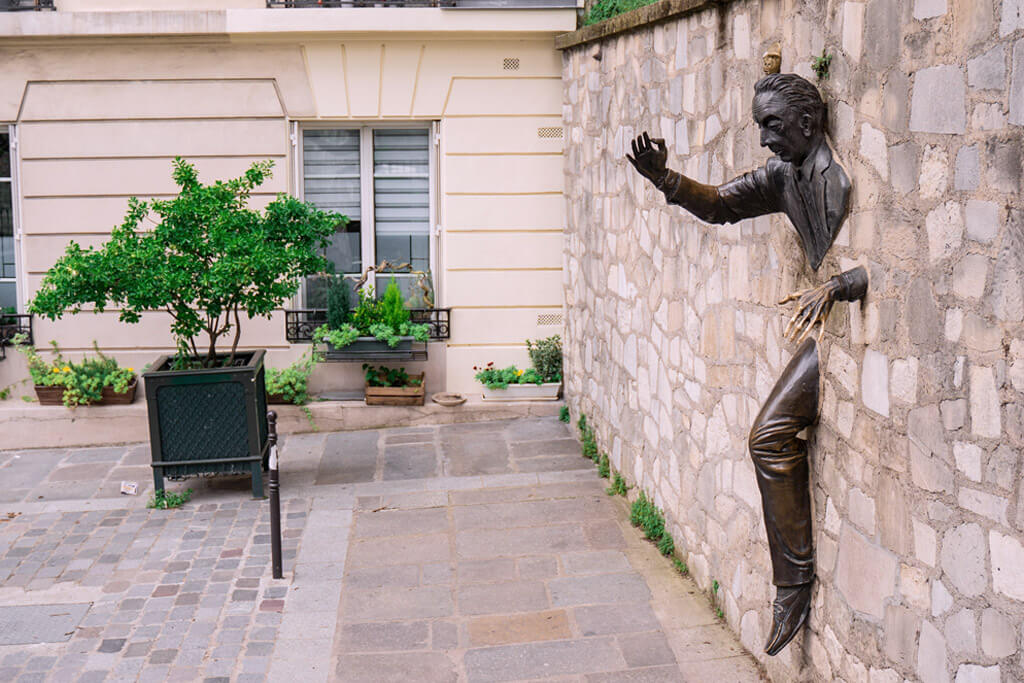
Continue walking Avenue Junot up to Place Marcel-Aymé . This is a beautiful place to see during the cherry blossom season. Here, you can see a man in bronze breaking through the wall.
The Passe-Muraille , the name of the sculpture, personifies a short story written by Marcel Aymé in 1943. ‘ An excellent man named Dutilleul had the extraordinary gift of being able to walk through walls without any trouble.’ This is a beautiful homage to the writer, who lived in Montmartre for 40 years.
Go back to the junction with Rue Girardon and then take Rue Orchampt down to Place Émile Goudeau. On the way, you can see Dalida’s house at 11bis Rue Orchampt and some picturesque artist studios.
18. Picasso and Le Bateau Lavoir

Formerly a ballroom and then a piano factory, the Bateau Lavoir facing Place Émile Goudeau was divided into twenty small workshops for artists. The place was without heating and provided with a single water point.
The Bateau-Lavoir hosted a good part of all the art people of the time: Le Douanier Rousseau, Amedeo Modigliani, Henri Matisse, Georges Braque, Guillaume Apollinaire, Jean Cocteau… All went through the small, cramped workshops of this unusual house.
Until his death, Pablo Picasso (1881-1973) kept nostalgia for the rural Montmartre of his youth, with its picturesque farms, orchards, and cabarets. The artist arrived at the Butte at 19, and he took up a workshop at Le Bateau Lavoir in 1904. Here, he executed the last works of the blue period, those of the pink period – inspired by his love for Fernande Olivier – and The Young Ladies of Avignon (1907), a prelude to cubism.
In 1970, the Bateau Lavoir’s wooden structure did not resist a terrible fire and only the facade, today listed as a historical monument, survived.
19. Place des Abbesses
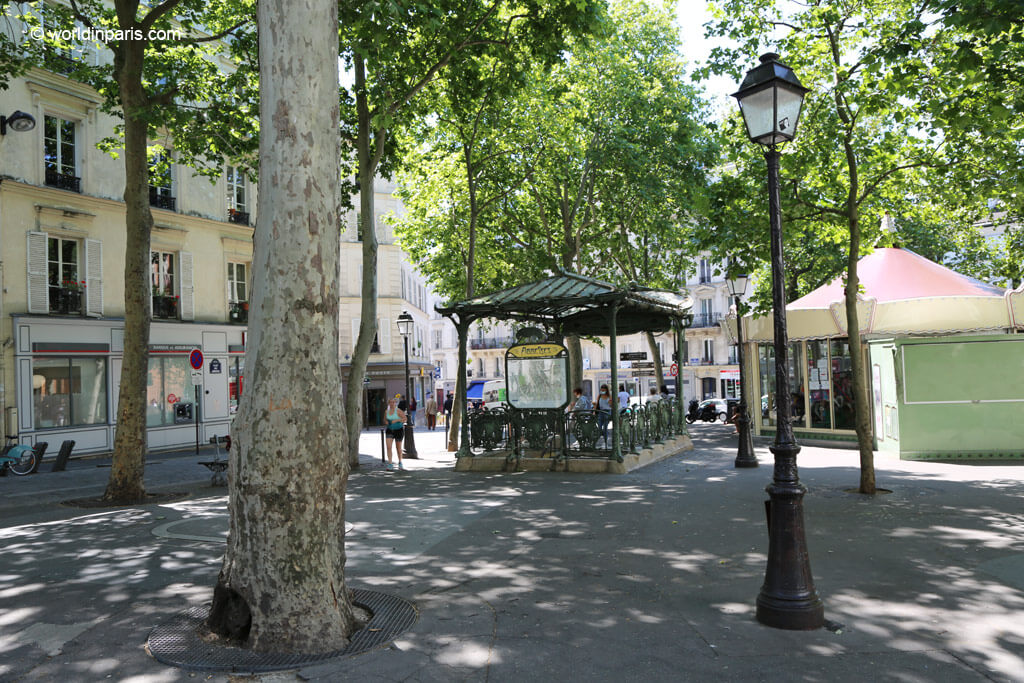
The last stop of this Montmartre walking tour is the picturesque Place des Abbesses . Take your time to explore this lively square with a carousel, some benches in the shade, and the Guimard metro entrance.
Metro Abbesses is the deepest metro station in Paris; it goes 36 m below the ground!
Also interesting is the Church of Saint-Jean de Montmartre (1894-1904), designed by Anatole de Baudot. He conceived the idea of social and economic architecture in harmony with the industrial development of the time. For this building, Anatole de Baudot dared to introduce cast iron and reinforced cement with (in my opinion) a beautiful result.
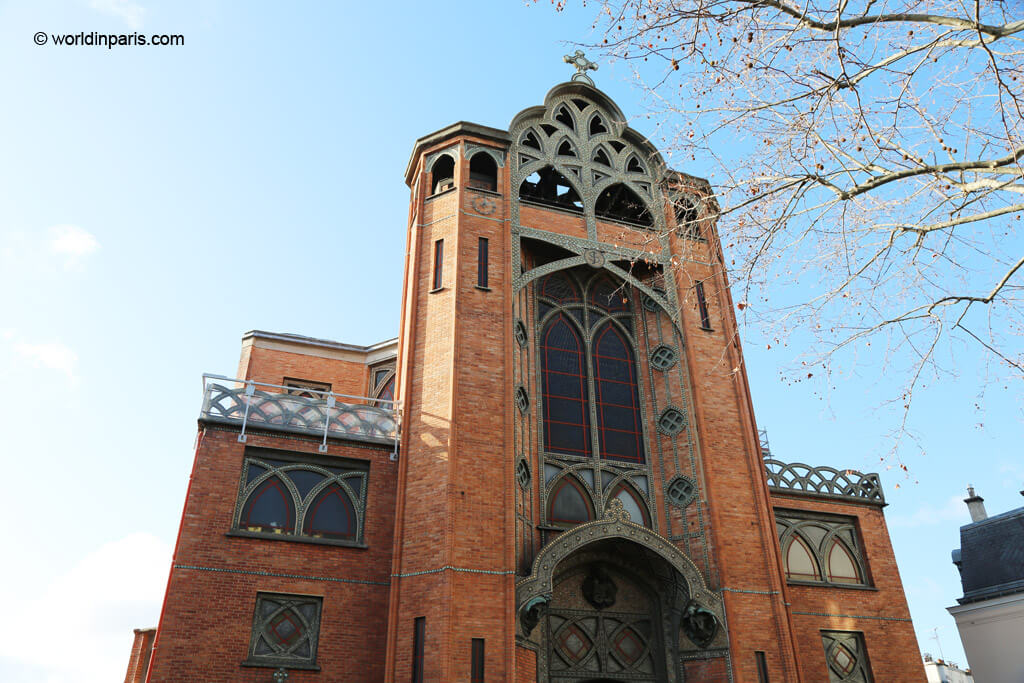
Nearby, in Square Jean Rictus (point #20 on the Montmartre walking tour map), you can see the famous Love Wall , but it is always swarming with people. Instead, make your way to its back corner to discover the hidden Jardin des Abbesses , a lovely small oasis in Montmartre.
After the Love Wall, this Montmartre walk ends at the picturesque café Le Vrai Paris at 33 Rue des Abbesses (#21) for a more than deserved drink and quick eats.
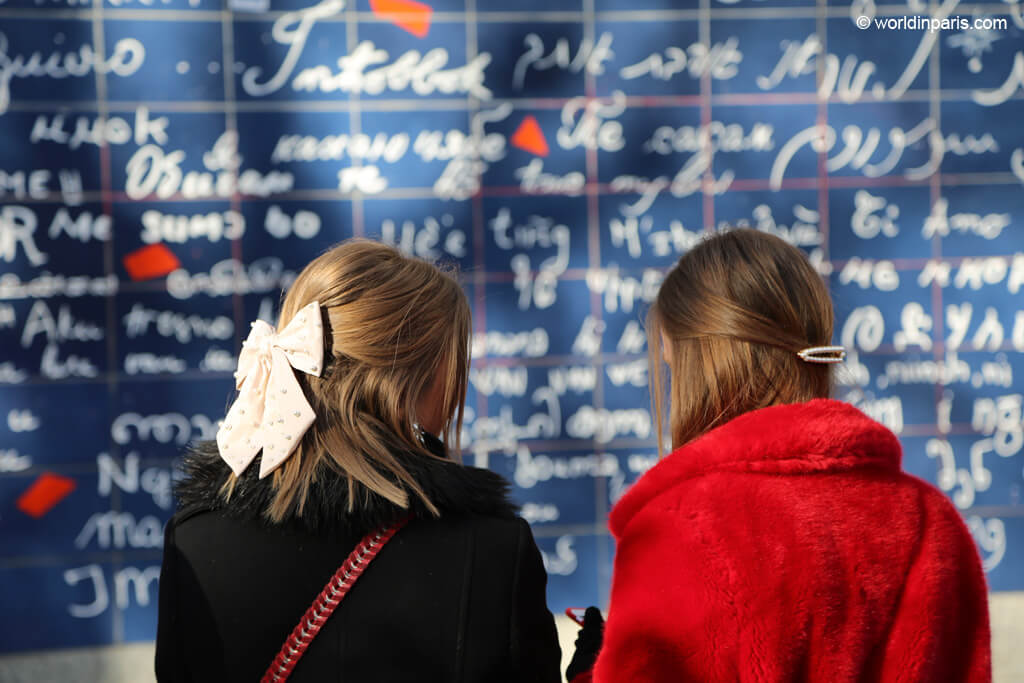
Click here to read about other Paris Attractions
Back to Homepage
Pin it now & read it later
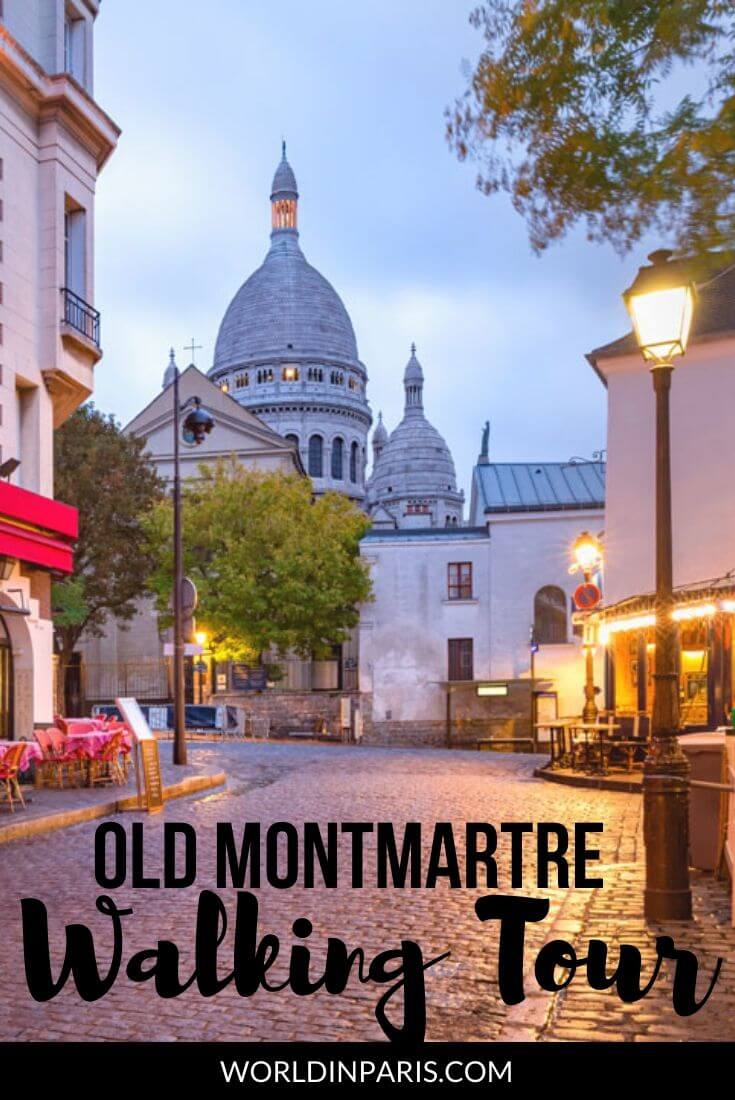
Disclaimer: This post includes affiliate links, meaning we get a small commission if you make a purchase through our links. It costs you nothing more (in fact, if anything, you’ll get a nice discount) but helps us to go on creating incredible Paris content for you. We trust all products promoted here and would never recommend a product that isn’t of value. World in Paris is a participant in the Amazon Services LLC Associates Program. As an Amazon Associate, we earn from qualifying purchases at no expense to you.

About WORLD IN PARIS
Quirky parisian explorers with a preference for lesser-known sights, we are continuously looking for new ideas and tips to bring you the best of the city of light read more about us ., we’re elisa, norbert, valérie, and cédric, four travel bloggers and friends living in paris. quirky explorers with a preference for the local side of our city and its lesser-known sights, we are continuously looking for new ideas to enjoy the best of paris & around . do you want to go beyond the louvre museum or the eiffel tower keep clicking for first-hand information & our best tips learn more about us.

IMAGES
VIDEO
COMMENTS
Montmartre Tours and Tickets. 19,125 reviews. Crowned by the Sacré-Coeur Basilica, historic Montmartre in Paris' 18th arrondissement is famed for its cobblestone streets, artsy past and present, and central hill. Visitors flock here to imagine what life was like during the Belle Epoque—when artists such as Dalí, Renoir, Van Gogh, Toulouse ...
Discover another side of Paris in Montmartre, a charming artists' enclave filled with quirky cafes and shops. Enjoy a splendid view of the city from Sacré-Coeur, watch artists at work at Place du Tertre, visit the Wall of Love, where the phrase "I love you" is scribbled in hundreds of languages, catch the famous Moulin Rouge show or visit Paris' oldest vineyard.
19. Make a Stop at Lapin Agile. Located next to the Montmartre vineyard, Lapin Agile is a colorful 19th-century building known for cabarets. While Moulin Rouge, Lido de Paris, Paradis Latin, and Crazy Horse Paris are the most famous cabaret places in Paris, Lapin Agile is one of the lesser-known ones.
Delve into Paris's bohemian history on this Montmartre walking tour! Stroll down cobblestone streets past the Moulin Rouge and other former haunts of famous artists and writers while your guide shares local lore. See where Vincent van Gogh once lived, and visit the final resting place of Edgar Degas and other artists at the Montmartre Cemetery. For an inspiring finale, take in some of the ...
From $102. Montmartre Like a Local: Paris Food Tour. Explore the culinary delights of authentic Montmartre on this tour and meet the locals whose stories - and food! - make up its past and present. 59 3.5 h 10 max. From $108. Walks Exclusive. Exclusive Montmartre Experience with Private Vineyard Tasting, Skip-the-Line Museum Tour, & Sacré-Coeur.
Get a more intimate glimpse into one of Paris' most popular districts on a walking tour that reveals the best of Montmartre's culture, art, and food, and shows you less-visible details that you may otherwise have missed. Read more. from. $39.32. per adult.
The best indoor activities in Montmartre for rainy days are: Paris: La Nouvelle Eve Cabaret Show with Champagne. Paris: Champagne at the Moulin Rouge & Seine River Cruise. Paris Museum, Tours, and Experiences Pass: 2, 4, or 6 Days. Paris: Sacré-Coeur and Montmartre Tour with Expert Guide.
Breathtaking Montmartre Paris Walking Tour. Join us for this popular walking tour as we stroll through the quintessential Parisian quarter of Montmartre. Together with an expert guide, you will discover all that this charismatic village has to offer and learn about the history that made this elevated arrondissement what it is today. Reaching ...
Montmartre's little train roundtrip tour. Get the chance to tour Paris' most charming district onboard a panoramic train! free cancellation. Available in: en, fr. 4.3 /5. (43) from: $11.00.
Stroll through Montmarte Village to discover the famous Bohemian side of Paris. Travel back through time to the 1920s as you walk along winding Parisian streets. Admire a panoramic view of the city of lights from the highest hill in the city. Learn more about the fascinating life of Picasso and other illustrious artists.
Enjoy the bohemian charm of Montmartre with our tours and experience Parisian culture! Sorted by: Musée de Montmartre : Self-guided visit. 4,9 ... Montmartre, the legendary district of Paris, is an inexhaustible source of discovery and adventure. With our Montmartre tickets, embark on a journey through the history, art and culture that make up ...
Tour Description. During this three-hour Montmartre walking tour we will look at the traditions, lifestyle, and bohemian character of this storied neighborhood over the centuries. Situated on a hill above Paris' Right Bank, Montmartre has always stood apart from the rest of the city, known for the artists, writers, and bohemians who transformed ...
Tours of Montmartre: Soak up Montmartre's Bohemian spirit and learn about the history on a two-hour Montmartre and Sacré-Coeur Walking Tour in Paris. An expert guide will lead you through the neighborhood's atmospheric cobblestone street to the essential sights, such as the Place du Tertre, the Basilique du Sacré-Coeur, and Le Lapin Agile.
Montmartre Walking Tour. Discover one of Paris' most enchanting neighborhoods, with a small-group tour of romantic Montmartre. Topped by the famous Sacré-Coeur Basilica, this hilly area in the city's north feels like a charming, old-world village. During the two-hour guided stroll you'll be transported back in time, walking in the ...
Montmartre guided tour. Discover one of the most picturesque neigborhood in Paris. The former village of Montmartre still has its old streets, windmills, cabarets, cemetaries, churches and even a vineyard ! It has been the parisian artists' neighborhood for centuries, celebrities such as Renoir, Dalida and Picasso used to live here.
Begin your self-guided walking tour of Paris at the Parvis du Sacré-Coeur, the gateway to Montmartre. You can reach the Parvis du Sacré-Coeur via a number of different routes. The nearest metro station is Anvers (line 2 blue) and you can walk up the numerous steps from the Carousel, up to the Sacré-Coeur. Just be sure to bring some water and ...
Montmartre has so many things to see and do. It's a charming old area of Paris which is perfect just to walk around and. Sacré-Cœur: The Sacré-Cœur Basilica is one of the most iconic monuments of Paris. Located right at the top of the hill, the white domed church is a must-visit. It's free to enter the main church or you can pay to ...
The Best Things to Do in Montmartre, Paris Step inside the incredible Sacré-Coeur Basilica. Standing tall at the peak of the Montmartre butte and visible from many of the best viewpoints in Paris, Montmartre's Sacré-Coeur Basilica is a must-see when in the neighborhood!. The basilica itself is free to enter, and its Romano-Byzantine interior, complete with marvelous mosaics that remind me ...
Paris Movie Tour of Montmartre. Departs daily at 10 am or 5 pm; From €85 per person; More information or to book. Free cancellation up to 24 hours before the tour. The Paris Romance Walking Tour of Montmartre visits Moulin de la Galette, the 'I Love You Wall,' Studio 28 and other famous love-struck sights, as well shares stories about ...
Montmartre is one of the most charming neighborhoods in Paris.. With its rolling hills of cobbled streets and uninhibited bohemian atmosphere, Montmartre attracted artists such as Toulouse-Lautrec, Van Gogh and Picasso during the Belle Époque. This neighborhood was a picturesque town with small farms, vineyards, and windmills, independent until 1860, when it became an arrondissement of Paris.
Self-guided Montmartre walking tour map. If you'd like to do this Montmartre walk yourself, click on the map below to access directions through Google maps. The route is just over 2.5km (1.6 miles) and takes 35 minutes to walk straight through, but allow a couple of hours to include stops.
Montmartre Self-guided Walking Tour. This Montmartre walking tour takes you through the main sights of old Montmartre and the stories and legends behind it.. The Montmartre Hill in Paris, also known as La Butte by locals, is famous for its Basilica of the Sacred Heart, the Love Wall, and its panoramic view of Paris. However, it is also a gastronomic and cultural district with authentic charm ...